
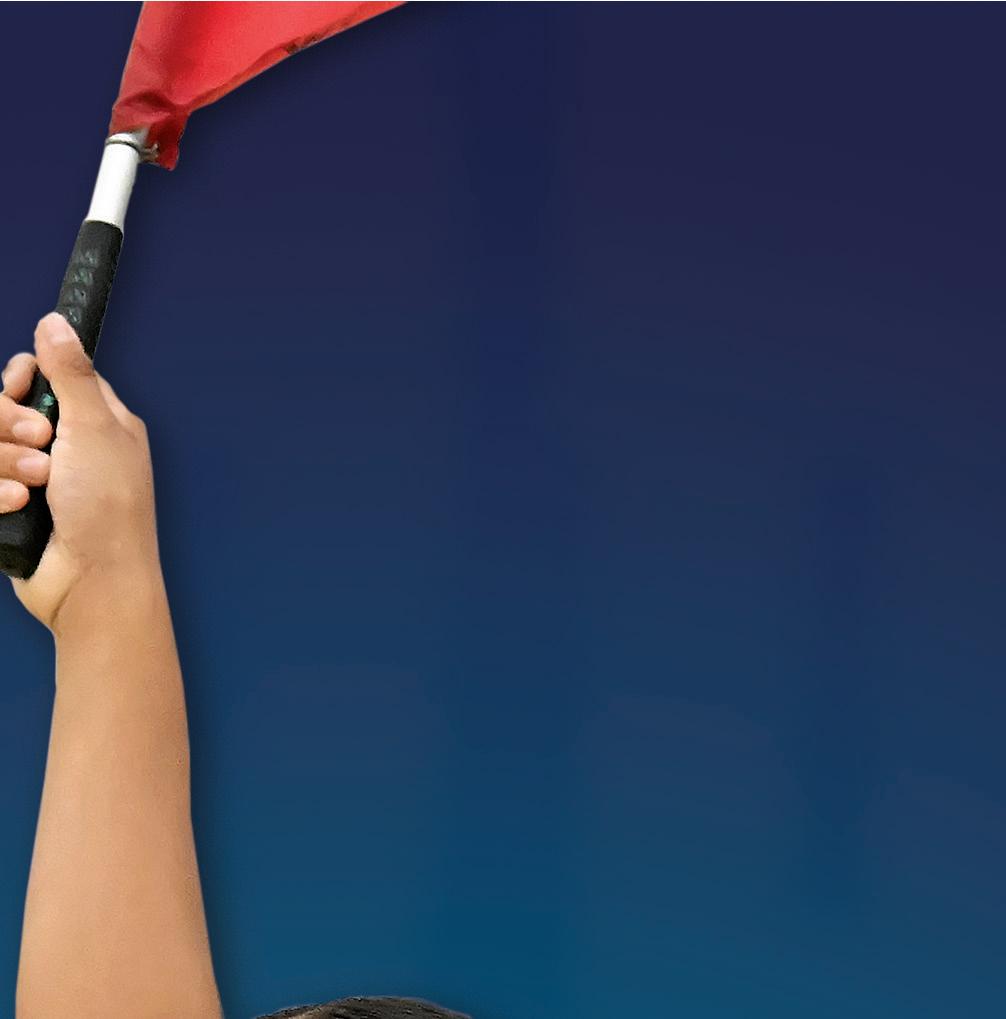

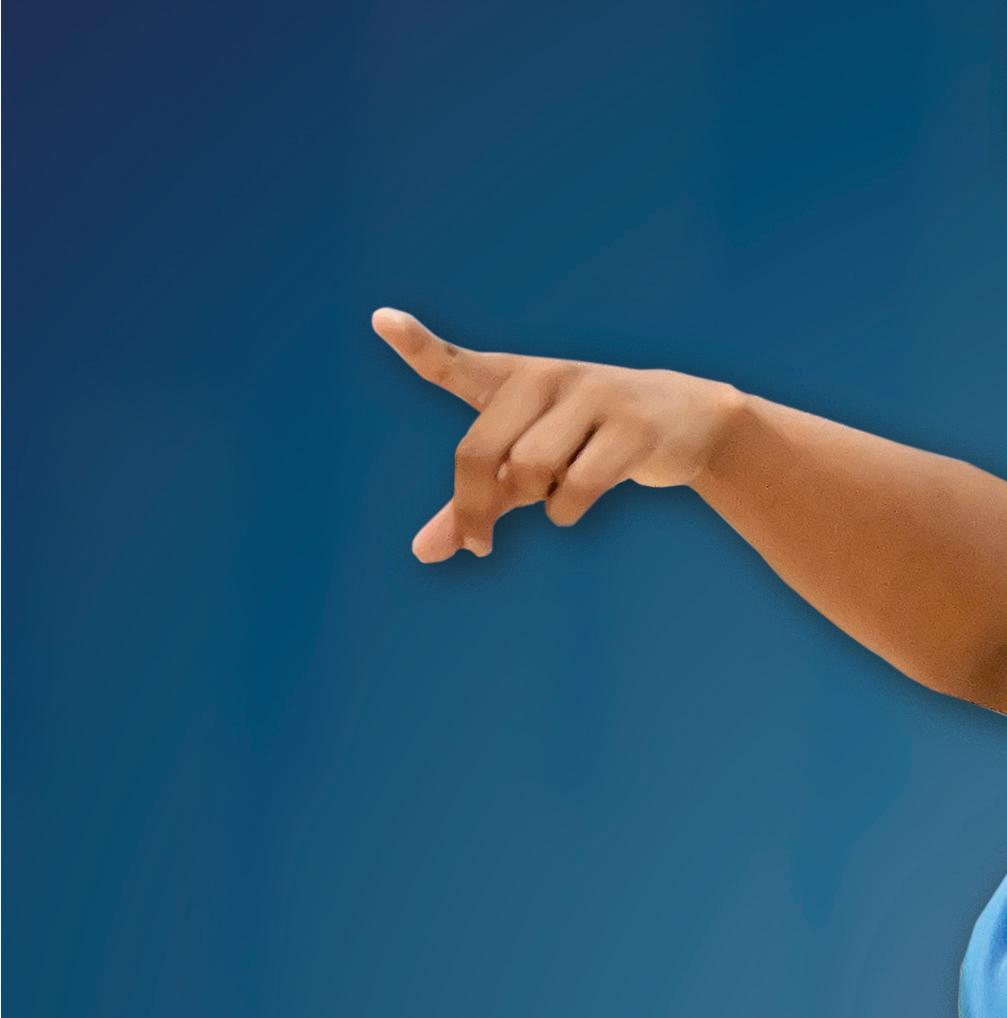
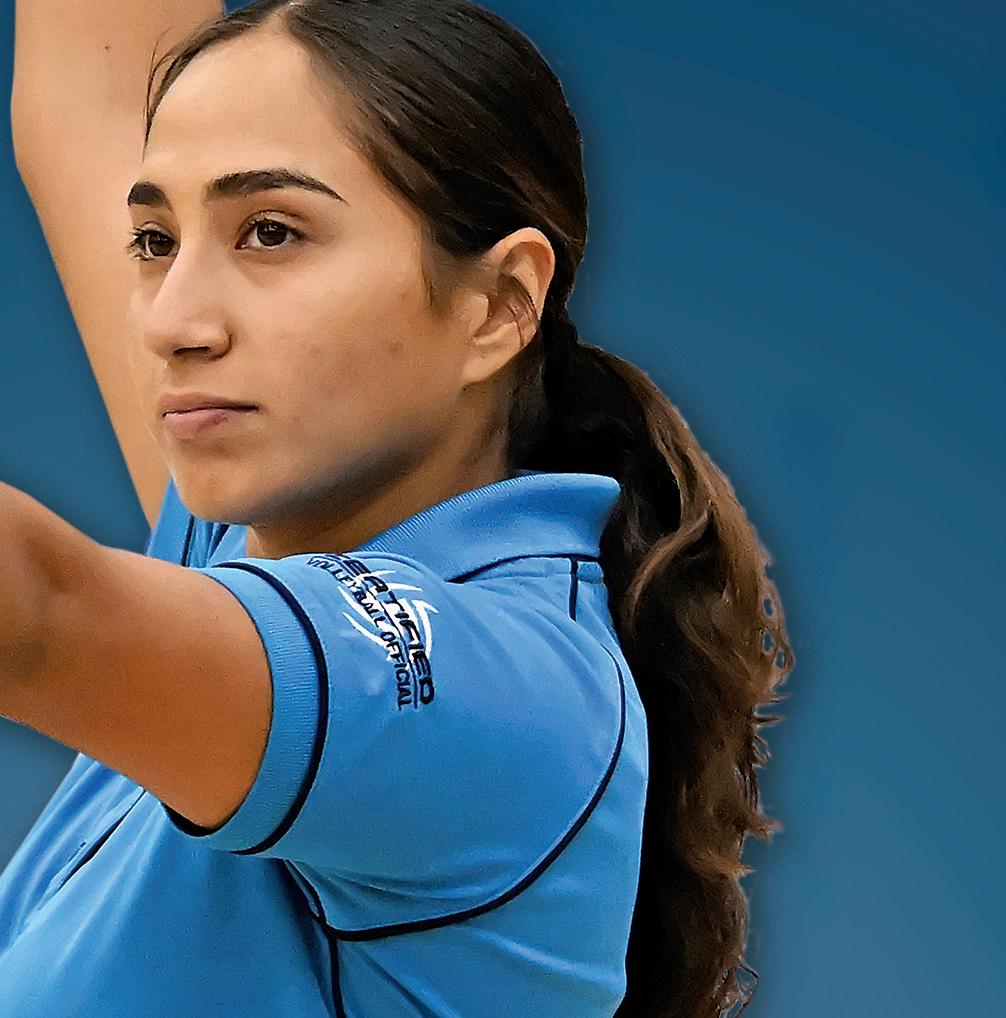

























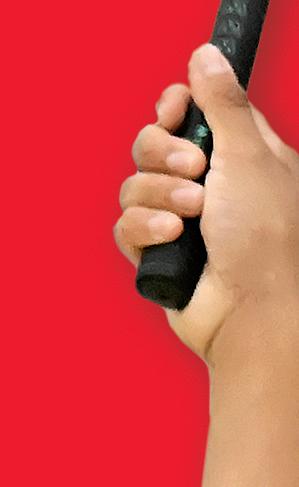
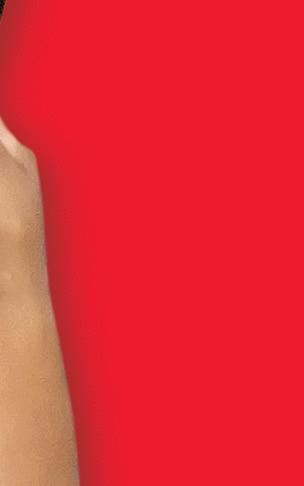






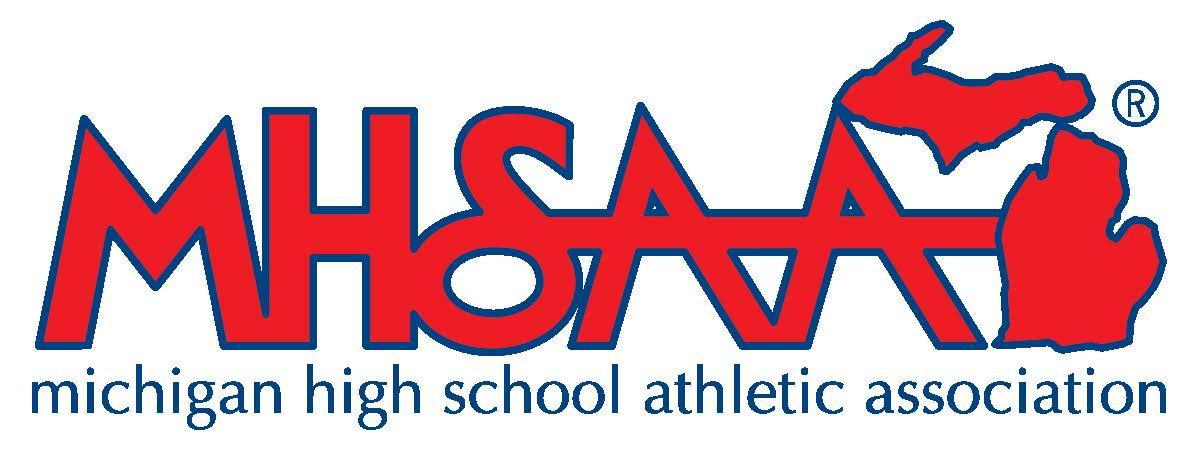
FINE 9 ALL SPORTS FLOW CHART CHANGES THE WAY ON YOU RULES your voice since 1976 $6.95 member edition FIVE STAGES WHAT’S YOUR PQ? CANADA CLAIMS REPLAY - EH? P.72 P.34 LEVEL VOLLEYBALL P.52 HEADED GOLD WHISTLEAward VIOLET PALMER AUGUST 2023 // REFEREE.COM
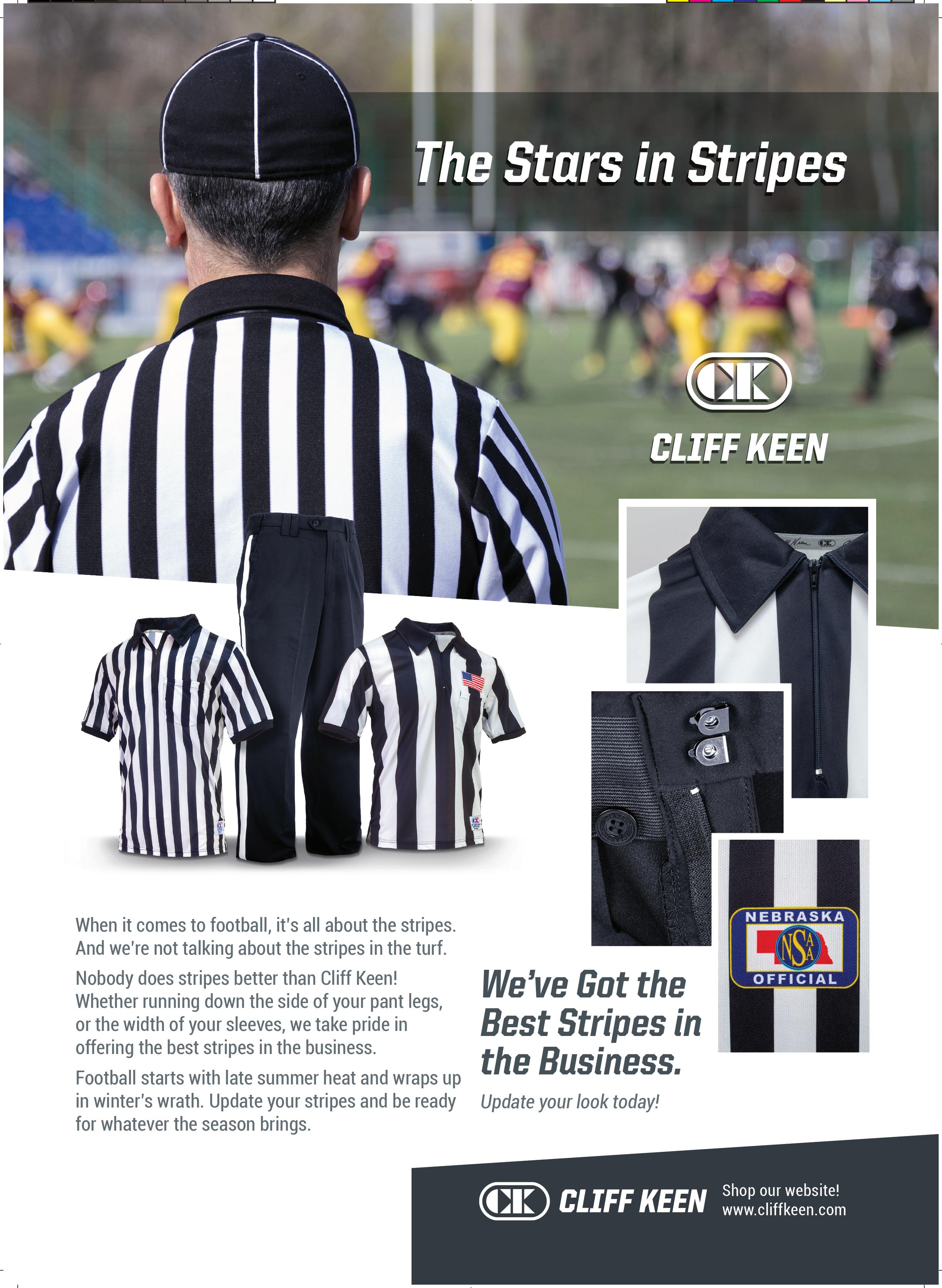
22 GOLD WHISTLE AWARD: VIOLET PALMER
Violet Palmer is a leader, mentor and trailblazer for so many in basketball officiating.
34 EH?
We’ll acknowledge poutine, Rush and egg cartons as Canadian, but not so fast on replay.
52 WHAT’S YOUR PQ?
The ability to understand yourself — and others — is critical to working as a team.
72 WHERE ARE YOU ON THE JOURNEY?
Most officiating careers navigate these five stages.
ON THE COVER
Los Angeles
Age: 23
Officiating experience: Club, high school and collegiate volleyball. Line judge for the 2022 Division 4 and Division
1 California Interscholastic Federation state finals and the 2022 California Community College Athletic Association championship semifinals.

COLUMNS
4 PUBLISHER’S MEMO Work Here, Live Here
6 THE GAG RULE
Letters: ‘I Am an Umpire’; Give Us a Break; They Get It; Snap Shot; Say What?; Survey Says

8 THE NEWS Injured High School Football Official Sues Coach, School; Former MLB Umpire Don Denkinger Dies; Higgins Leaves Court for WBOC Role; Vaughn, Former FIFA and MLS Referee, Dies
50 GETTING IT RIGHT All In (Pink) Perspective; Minnesota Says ‘Yes’; Testimony in Topeka
70 PROFILES Wise Beyond His Years; Officiating Is Better; Mat About Bob
78 FOR THE RECORD WNBA officials roster

80 LAW Circumvent Conflicts; Scrimmage Scramble; Postgame Liability
81 CLASSIFIEDS Camps/Clinics/Schools; Equipment/Apparel; Leadership Resources


82 LAST CALL
‘Let Me Be Brave’: To take courage and step up and officiate them was really cool.
SOCCER HIGHLIGHT THIS MONTH
FOR MORE, GO TO
CONTENTS Find Referee Magazine on Facebook and follow RefereeMag on Twitter Volume 48, No. 8 Issue 562 AUGUST 2023 FEATURES SPORTS
FOOTBALL Time for a Change:
Makes Major Modification to Game Clock Rule; Apropos to Go Slow Till You Know You Must Throw 28 BASKETBALL One and One? Done and Done: NFHS Changes FreeThrow Awards, Frontcourt Throw-ins; Don’t Become a Second Trail 38 SOFTBALL Fix It If You Can: Guidance and Rulings to Make a Wrong Count Right; Fumbled Interference; R1 and R2 Tag, Who’s It? 44 VOLLEYBALL Ladder Climber: Improve These Skills to Level Up Your Career; In-Tune With Injuries; 5MW: Joe Gustafson
SOCCER Well Aware: Read, Understand and Manage Challenging Situations; 5MW:
Radford;
Mandates New Uniform Beginning in 2023
BASEBALL Safe Haven? Not So Fast!: Batters Must Be Wary of Interference, Even If in the Box; The Ones Who Don’t Care;
Circus
ALL SPORTS
Fine
The Qualities
Good Mentor Must Possess; Great Anticipations
Lead to Greater Results; Pack Up Your Troubles (and Extra Gear)
12
NCAA
58
Daniel
NCAA
64
Three-Ring
74
A
Nine:
a
Can
HESTON QUAN (COVER), MATT BROWN (PALMER), HESTON QUAN (SOCCER)
22
Recognizing signals from players is just one example of how to stay on top of in-game situations. Ashbir Singh, Stanton, Calif.
PAGE 58
Diana Enriquez
PUBLISHER’S MEMO
Work Here, Live Here
It is such a narrow path we have to walk at this magazine. I first addressed this topic some 10 years ago in this space. Considering the cultural changes we are experiencing generally, I felt a need to revisit the subject this month.
At Referee, we have an obligation to be the “journal of record” for the officiating industry. Further, we live in the community we report on and that fact can present unique challenges.

Within this framework, we come to work every day with the responsibility to consider, vet and finally publish materials we believe will be important and interesting to you. We evaluate each item we intend to publish based on tenets our editorial team has agreed to uphold. In part, the 1987 book The Virtuous Journalist helped shape our thinking. In sum, here is what we believe.
1. The basic responsibility we have is to provide you the information you need (vs. want) in our judgment. The cost of a subscription pays for the following: content, production, distribution and, importantly, the judgment of our editors.
2. Our standard is not just to do what is legal but also what is moral — conscience, responsibility and fairness are key concepts for us.
3. Our reports and features do have a value basis — the support of sports officials. We do have bias, but one constrained within accepted journalistic guardrails. We are not neutral, yet we strive to be impartial whenever possible.
4. Journalistic trust will erode if it is based solely on the truthfulness in reporting. It must have the support of “good judgment,” concern, values. Truth by itself is not enough. The manner in which we formulate
stories over time plays a role in developing and keeping the trust of the officiating community.
5. Accountability does not arise uniquely from our journalistic intentions. It arises also from the nature of the relationship between the subject of the story and us. To us, journalistic accountability is a moral challenge, not just a legal liability.
6. “Fairness” provides the basis for what we do as publishers of this magazine. Our story standards are: completeness, accuracy, balance and objectivity. Our objectivity includes a clear notion of balance.
7. Editorials are most valuable when they are written to inform and advance debate, not to inflame through the use of emotionally charged language.
8. We mightily resist using “ anonymous sources” for our stories. In certain rare instances, we have no choice. But, as a general matter, if someone will not go “on the record,” then we simply will not give credence to that tip, rumor, observation or complaint by publishing details about it, without attribution.
9. As journalists, we are not obligated to report on all facets of a truth without regard for whom or how much doing so could cause harm or hurt to those included in our reporting. We do provide the context of a truth. We have to exercise judgment based upon our principles.
These principles have guided and driven us throughout these past 47 years. We relish being given the opportunity to exercise the judgment you pay us for.
Chief Strategy Officer/Publisher
Barry Mano
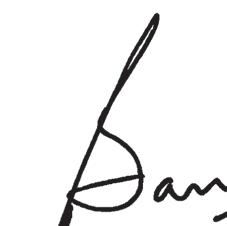
Chief Operating Officer/Executive Editor
Bill Topp
Chief Marketing Officer
Jim Arehart
Chief Business Development Officer
Ken Koester
Managing Editor
Brent Killackey
Assistant Managing Editor
Julie Sternberg
Senior Editor
Jeffrey Stern
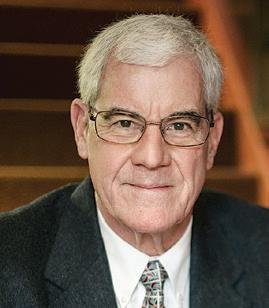
Associate Editors
Brad Tittrington
Scott Tittrington
Assistant Editor
Joe Jarosz
Copy Editor
Jean Mano
Director of Design, Digital Media and Branding

Ross Bray
Publication Design Manager
Matt Bowen
Graphic Designer
Dustin Brown
Video Coordinator
Mike Dougherty
Comptroller
Marylou Clayton
Data Analyst/Fulfillment Manager
Judy Ball
Marketing Manager
Michelle Murray
Marketing Coordinator
Ben Wirth
Director of Administration and Sales Support
Cory Ludwin
Office Administrator

Garrett Randall
Client Services Support Specialists
Lisa Burchell
Sierra Miramontes
Trina Cotton
Editorial Contributors
Jon Bible, Mark Bradley, George Demetriou, Alan Goldberger, Judson Howard, Peter Jackel, Luke Modrovsky, Tim Sloan, Steven L. Tietz
These organizations offer ongoing assistance to Referee: Collegiate Commissioners Association, MLB, MLS, NBA, NCAA, NFHS, NISOA, NFL, NHL, Minor League Baseball Umpire Development and U.S. Soccer. Their input is appreciated.
Contributing Photographers
Ralph Echtinaw, Dale Garvey, Carin Goodall-Gosnell, Bill Greenblatt, Jann Hendry, Keith Johnston, Jack Kapenstein, Ken Kassens, Bob Messina, Bill Nichols, Ted Oppegard, Heston Quan, Dean Reid, VIP
Editorial Board
Mark Baltz, Jeff Cluff, Ben Glass, Reggie Greenwood, Tony Haire, John O’Neill, George Toliver, Ellen Townsend
Advertising
the video at referee.com/pubmemo 4 | REFEREE August 2023
Watch
2017
Racine, WI
262-632-8855
REFEREE (ISSN 0733+1436) is published monthly, $49.95 per year in U.S., $84.95 in Canada, Mexico and foreign countries, by Referee Enterprises, Inc., 2017 Lathrop Ave., Racine, WI 53405. Periodical postage paid at Racine, WI and at additional mailing offices. Postmaster: Send address changes and undeliverables to REFEREE, PO Box 319 Congers, NY 10920. Direct subscription inquiries, other mail to REFEREE, PO Box 319 Congers, NY 10920. 1-800-733-6100. © 2023 Referee Enterprises, Inc. All rights reserved. (USPS Publication #107790.) Subscribers: Send address changes to REFEREE, PO Box 319 Congers, NY 10920.
Lathrop Ave.,
53405 Phone:
advertising@referee.com
FEATURING THE LATEST FOOTBALL PRODUCTS MADE BY SPORTS OFFICIALS
GOOD CALL OFFICIATING SPEAK EASY HEADSET
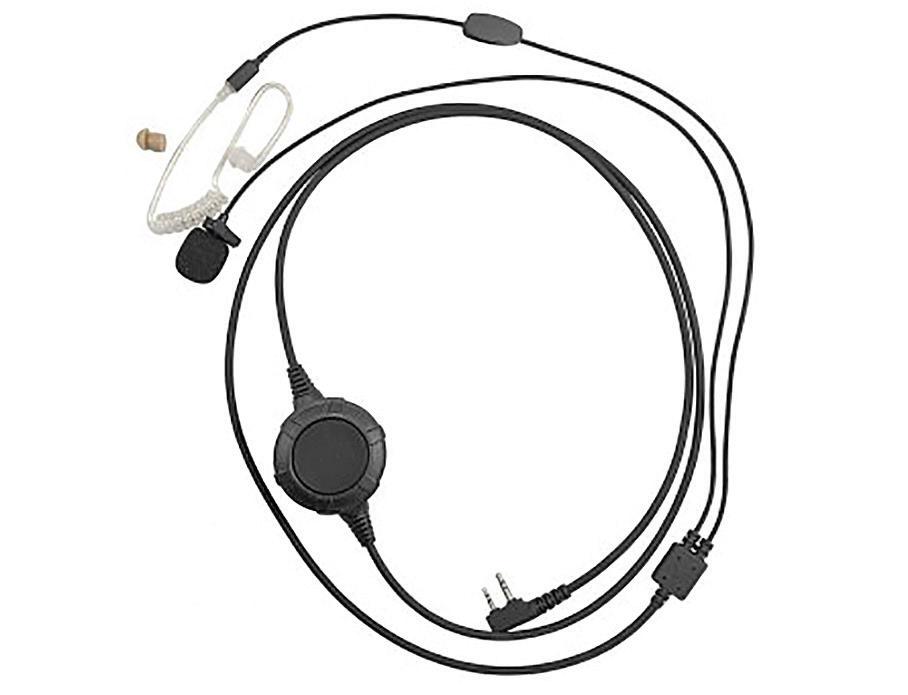
GOOD CALL OFFICIATING NFHS GAMEBOOK

Mark B. Skiatook, Oklahoma
“Great equipment addition for our crew. Very clear even over crowd noise. The push button is always there. You’re not fumbling around for a small mic with a small button.”
OFFICIAL REVIEWS
UMPLIFE PROFESSIONAL GARMENT BAG

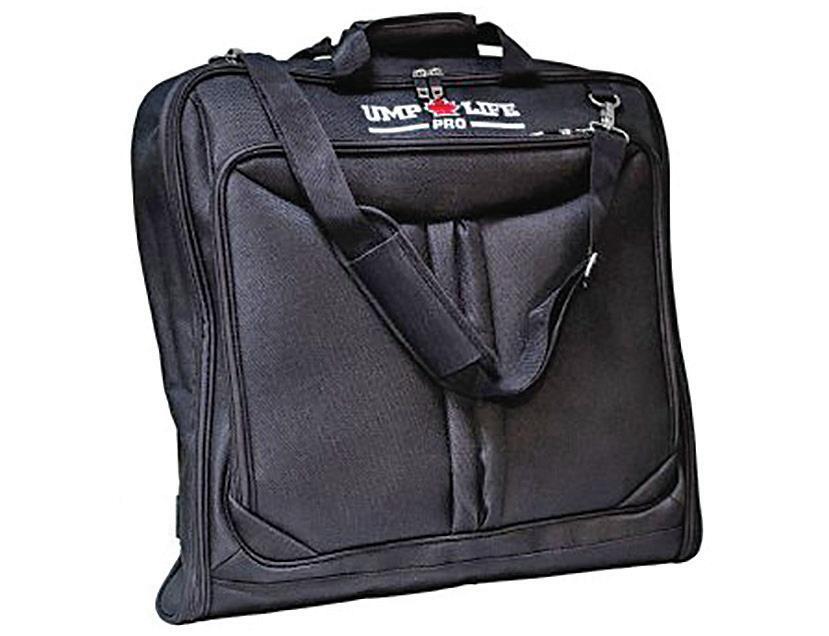

Tim T. Batesville, Arkansas
“I love this book! It has everything in it you’ll need on the football field. There’s no point in carrying anything else. It’s slick, perfect size for your shirt pocket.”
OFFICIAL REVIEWS
WILLIAMS ULTIMATE FOOTBALL REFEREE INFORMATION CARDS

Nick D. Windsor, Connecticut
“WOW! #GameChanger. The quality of this bag is beyond reproach. Ray has designed this bag with o cials in mind.”
OFFICIAL REVIEWS
Donald P. Virginia Beach, Virginia
“Finally, a game card that has everything an o cial needs to record the game. Thanks.”
OFFICIAL REVIEWS




Preferred vendor
LETTERS
‘I Am an Umpire’
I have a job that very few want. I don’t do it necessarily for the money or for affirmation from others.
I am constantly under scrutiny and yelled at every day I go to work. I am far from perfect, but I try to get as close to perfect as I can.
Long hours, high risks of injury, and at times, the environment around me is very hostile, harsh and violent.
My work uniforms and equipment are paid for out of my own pocket, without reimbursement. When I go to work, I have a great deal of responsibility. This demands integrity, knowledge, skill, patience and the ability to handle many situations that may arise.
I take a great deal of pride in what I do. The preparation I do is very intense and requires a continued effort, even when I’m not working. The community I am associated with is a bond many will never understand.
I am an umpire.
Fifty-three years at this job. I love the game and all it entails. Umpiring is rewarding and comes with a great deal of pride, every time you put that uniform on. Agree with me or disagree, but never question my integrity.
There is no need for violence.
Stuart Pfeffer Manalapan, N.J.


GIVE US A BREAK
While coaching his 8-year-old son’s basketball team at an April tournament in New Jersey, former Duke basketball star and retired NBA player JJ Redick was ejected after receiving two technical fouls. Redick used various media channels to communicate his stance that his words and actions to the referees did not warrant a technical foul or ejection.

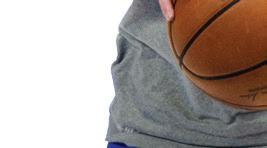
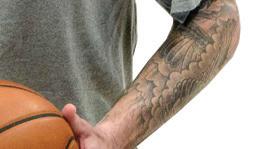
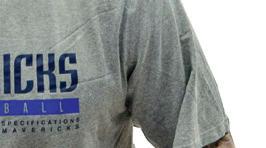


SOURCE: SI.COM
THEY GET IT
“In truth, call discrepancies mean refs are doing the job the right way. Some players and teams foul more than others! That should often be reflected in foul and free-throw totals.”
— Editorial by Ben Dowsett titled “Busting 4 Major Myths About Referees in The NBA Playoffs” on FiveThirtyEight.com

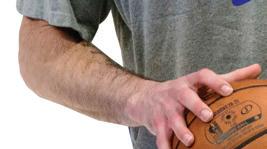
SNAP SHOT
Pickpocket
Many a sports official regularly comments while working an assignment, “Wow, I’ve never seen that before.” Such was the case for Pat Hoberg on April 5 at T-Mobile Park in Seattle when the Mariners hosted the Angels. As Hoberg was conversing between innings with Angels staff, starting pitcher Shohei Ohtani helped himself to a baseball from Hoberg’s ballbag.

SAY WHAT?
“Sports already using instant replay and goal-line technology prove to be much more reliable than humans in assessing plays on the field. Referees can also be subject to abuse by angry fans and players, whether they make the right call or not. Referee jobs will likely vanish soon with technology being better than the naked eye and unlikely to be challenged.”
— Nadia Tahir, in an article titled “The Future is Bleak for These 16 Professions”
SOURCE: WEALTHYNICKEL.COM
SURVEY SAYS

SOURCE: SURVEY OF 178 REFEREE READERS Are you ever concerned about your safety while officiating? BALLY SPORTS; © JEROME MIRON-USA TODAY SPORTS 58.4 % YES NO 41.6 %
GAG
WHAT PEOPLE ARE SAYING 6 | REFEREE August 2023 Tell Us What You Think Send email to letters@referee.com Send letters to: Editor, Referee, 2017 Lathrop Ave. Racine, Wis. 53405 Opinions expressed in “The Gag Rule” are not necessarily those of Referee. Unless otherwise stated, letters sent to Referee are intended for publication and become the property of Referee
THE
RULE
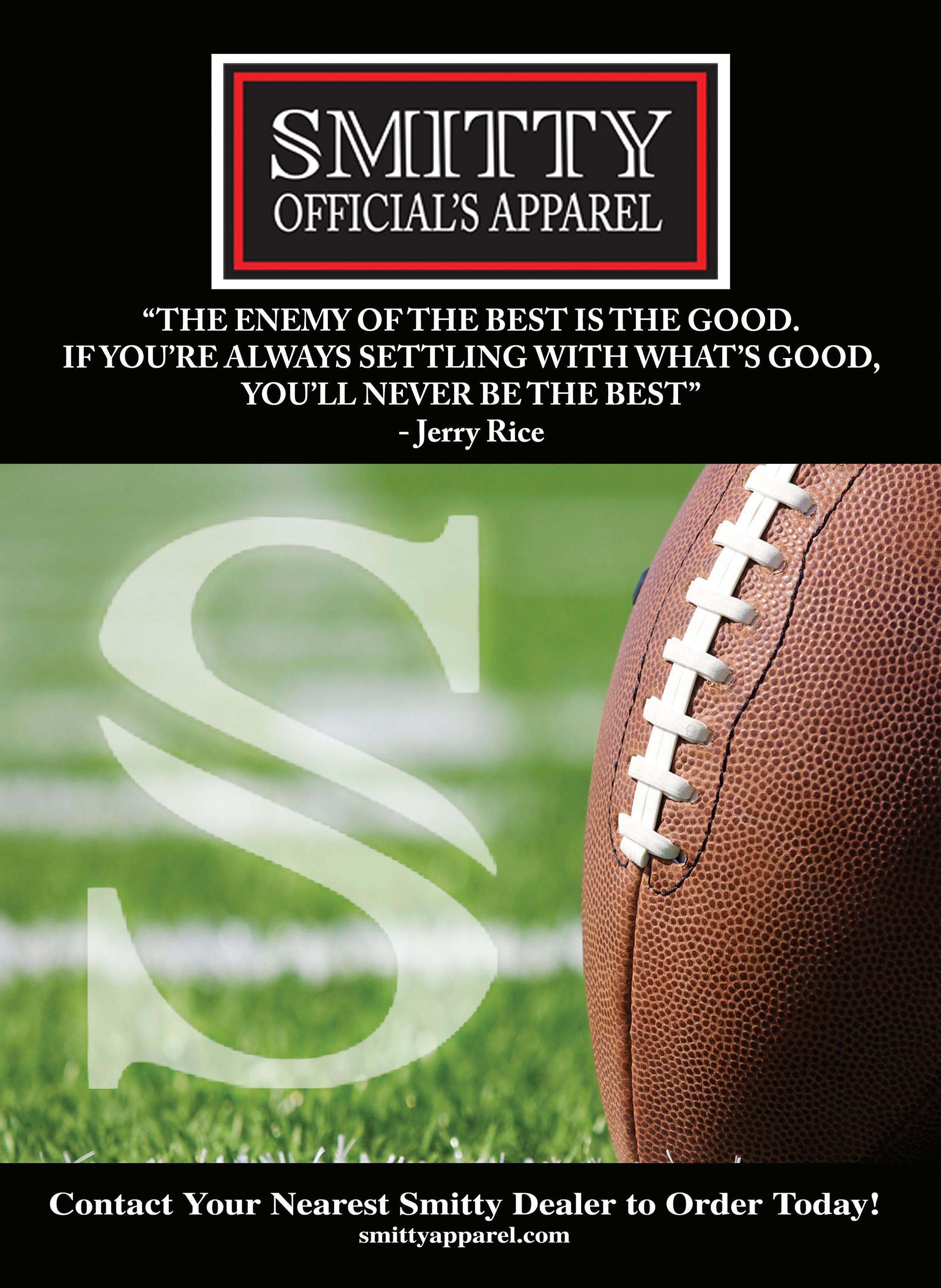
Injured High School Football Official Sues Coach, School
A Kentucky high school football official has filed suit against a coach in Tennessee for a sideline collision during a game in the fall of 2022 that led to the official being hospitalized for four days.
According to the lawsuit, Trae Cardwell of Lexington, Ky., was working as the head linesman for an Aug. 19, 2022, game between Maplewood and Hunters Lane in Nashville, Tenn., when he collided with Hunters Lane coach William Thomas while running down the sideline to cover a scrimmage kick. Video of the incident provided by the Tennessee Secondary School Athletic Association (TSSAA) shows Cardwell running down the field and colliding with Thomas as the coach is standing outside the coaches box pointing toward the field.
An official’s report filed following the game states Cardwell was given time to recover from the incident and finished the game. However, once Cardwell returned home he reportedly had trouble breathing and was transported to the University of Kentucky Medical Center’s intensive care unit, where he stayed four days and received treatment for an injured trachea.
Cardwell’s officiating crew determined the collision was an
THE WIRE
Bernhardt, Former NBA Referee, Dies
Former NBA referee Ted Bernhardt died May 21 in Isabela, Puerto Rico, where he lived since 2013. The former Indiana resident was 65. Puerto Rican news site Elnuevodia. com reported he died suddenly of respiratory failure. Bernhardt worked as an NBA official from 1998-2006. He officiated the NBA Finals between the
accident, so Thomas was not ejected, but assessed a 15-yard unsportsmanlike conduct penalty.
Fast forward to early May, when Cardwell filed a lawsuit in the U.S. District Court for the Middle District of Tennessee against Thomas and his employer, Metro Nashville Public Schools, asking for more than $75,000 in damages. In the lawsuit, Cardwell uses the word “clotheslined” to describe the contact that occurred. According to Cardwell’s attorney, Thomas Kerrick, the claim is to recover medical costs, mental suffering and lost wages since Cardwell was not able to work his normal officiating schedule following the injury.
Neither defendant immediately filed a response in court. However, Susan Kessler, executive principal at Hunters Lane, responded with a letter to the TSSAA last fall following the incident in which Thomas expressed his remorse for the accidental contact.

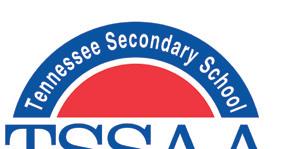
“I did not see the linesman coming in my direction and feel very remorseful about this incident as it was never my intention to harm anyone,” Thomas said. “After the game, I made sure to shake hands with our linesman and explain to him that, as a football program, we would continue to do our part to keep everyone safe.”
SOURCE: TENNESSEAN.COM
Los Angeles Lakers and New Jersey Nets in 2002. Prior to officiating, he taught sixth grade and coached basketball at Newburgh Elementary School in Newburgh, Ind.
Coach Charged for Fight at Tournament
A 32-year-old youth basketball coach from Jamaica, N.Y., faces one count of harassment in connection with an incident at a
Vaughn, Former FIFA and MLS Referee, Dies MOUNT VERNON, Iowa
— Terry Vaughn, former FIFA and MLS referee, died May 4 after a long battle with Huntington’s chorea disease. He was 50.

Vaughn became a FIFA referee in 2004 and worked 45 international matches, including the U20 World Cup Tournament in Canada in 2007 and the CONCACAF Gold Cup in 2007 and 2009.
He was a longtime U.S. Soccer referee and officiated 237 MLS matches from 1998 to 2012. He was named the 2003 Women’s United Soccer Association Referee of the Year.
“Terry was a true ambassador for the referee community,” said Mark Geiger, general manager of the Professional Referee Organization (PRO) and a former World Cup referee. “He worked every game with the utmost professionalism and integrity. He was a mentor to many referees in Iowa, the United States, North America and around the world for the way he conducted himself on and off the field.
“On a personal note, I learned See “Vaughn” p.10
tournament April 29 at Spooky Nook Sports athletic complex in Manheim, Pa. East Hempfield Township police issued a summons to appear in district court to Brian M. King. Video of the incident — which showed a heated exchange between the coach and a referee quickly escalate and the coach taking a swing — went viral. Before the coach was pulled away, the referee and coach appeared to
exchange minor blows. By the time the incident was reported to police, neither the coach nor the referee were at the complex.
Two More Officials Leave NFL Field judge Mike Weatherford and line judge Mike Dolce are leaving the NFL, bringing the total number of departing officials after the 2022-23 season to 12, according to
THE NEWS
8 | REFEREE August 2023
DALE GARVEY




OFFICIATING DEPARTMENT
LISTED IN ALPHABETICAL ORDER 2023 VOKKERO PRESENTED BY IN PARTNERSHIP WITH
THANK YOU TO the SUPPORT ORGANIZATIONS
Former MLB Umpire Don Denkinger Dies
WATERLOO, Iowa — Don Denkinger had a 29-year career as an umpire in the AL and worked four World Series. He is one of only six umpires to be on the field for two perfect games. But when Denkinger died May 12 at age 86, stories that appeared in newspapers across the country led with one missed call.
Denkinger was 16 years into his career when he was working the sixth game of the 1985 World Series. With St. Louis leading, 1-0, and needing three outs to capture the World Series, Jorge Orta led off with a dribbler to the right side. First baseman Jack Clark gloved the ball and tossed it to pitcher Todd Worrell, who hustled to cover the bag.
Denkinger, who moved into foul ground, called Orta safe. In an interview with Referee, Denkinger said because the throw was high, he was unable to see the ball and the runner’s foot at the same time.
After a single, a bunt, a passed ball and an intentional walk, pinchhitter Dane Iorg singled to give Kansas City the win.
The next night, the Royals
THE WIRE
published media reports. Weatherford, from the Chickasaw tribe in Oklahoma, has officiated for 21 years in the NFL. He previously worked as a side judge. Dolce had finished his third season. Both were reportedly not leaving willingly and both were appealing their departures.
New York Launches New Sportsmanship Rules
The New York State Public High School Athletic Association put
defeated the Cardinals, 11-0, to win the World Series.
Two St. Louis radio personalities announced Denkinger’s address and phone number on the air, leading to the umpire and his family receiving threatening calls and letters long after his gaffe. There were multiple death threats that garnered attention from the FBI.
“I consider what happened as part of my job. It comes with the territory,” Denkinger said. “It’s still a game. It’s played by human beings and it’s officiated by human beings. So you have to understand that and can’t get down on yourself because of (a missed call).”
In addition to World Series assignments in 1974, ’80, ’85 and ’91, Denkinger was the plate umpire for the 1978 Yankees-Red Sox tiebreaker game, which New York won on a homer by Bucky Dent. He was the second-base umpire for Len Barker’s perfect game in 1981 and was at first base for Kenny Rogers’ 1994 perfect game. Denkinger was the plate umpire for Nolan Ryan’s sixth no-hitter in 1990.
Denkinger broke into pro ball in 1960, working in the Alabama-Florida League. He was hired by the AL in 1969. He called his last game June 2, 1998, retiring due to an injured knee.
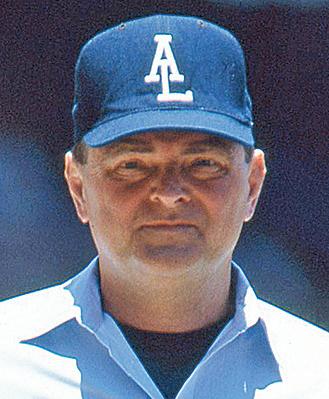
a new sportsmanship rule in place aimed at keeping rowdy parents and other spectators in check. On May 3, the executive committee approved adding a spectator sportsmanship regulation that could lead to someone being removed from the game and banned from future games. Spectators who are removed from events will be required to complete the NFHS’s Parent Credential course, or serve a one-game suspension, before being
so much from Terry on how to be a professional and an international referee. I worked hard to put into practice what I observed him doing and how he went about managing a match. He will surely be missed but his legacy and his influence on younger officials will continue to live on through those who learned so much from him.”
Vaughn founded the Iowa Referee Academy in 2002. It was renamed the Terry Vaughn Referee Academy in 2016 in his honor.
May is Huntington’s Disease Awareness Month and in recent years PRO officials have worn blue wristbands with the letters “H.D.” to support Vaughn. Huntington’s disease is a hereditary disorder that causes a breakdown of nerve cells.
Vaughn is survived by his wife, Kim, and daughter, Kyla.
“He just really enjoyed refereeing soccer and being around soccer people,” Kim Vaughn told MLSsoccer.com in 2017. “Terry would do a major league game and come home and volunteer to referee our daughter’s Under-8 game, and he had just as much fun in that U-8 game as he did the night before in the middle of an MLS game. That was Terry.”
allowed back to interscholastic activities.
NBA Referee Investigated for Tweets
NBA referee Eric Lewis was not selected to work the NBA Finals while the NBA investigates whether he violated any NBA rules on speaking about officiating in an unauthorized manner. The league opened an investigation into whether Lewis was connected to a Twitter account that responded
to numerous posts on league officiating and defended Lewis and other NBA referees, ESPN reported. The account, which has since been deleted, had a username of “Blair Cuttliff.”
“We decided that given that investigation was ongoing and it remains ongoing, that it wouldn’t be appropriate for him to work in these Finals,” NBA commissioner Adam Silver said June 1. “I don’t know what the ultimate conclusion will be. We’ll see where the facts take us.”
THE NEWS 10 | REFEREE August 2023
LEE CALKINS
Vaughn continued from p.8
Higgins Leaves Court for WBOC Role
After an illustrious career that entailed nine Final Fours and two NCAA men’s Division I National Championship games, John Higgins has retired from oncourt officiating. He has shifted to a new administrative role as he has been tabbed the new coordinator of officials for the Western Basketball Officiating Consortium (WBOC). Higgins fills the role left by Bobby Dibler, who in March announced his retirement effective this summer.
“These jobs don’t come available that often,” Higgins said. “I still could have refereed maybe two, three or four more years, but you never know how long the body is going to last.”
Higgins, 62, is charged with recruiting, selecting, developing, evaluating and assigning officials for every men’s basketball game hosted by schools in the WBOC, which comprises the Big Sky, Big West, Mountain West, Pac-12, Western Athletic and West Coast conferences.
“I am most excited about conversing with and educating those guys on my thought processes about game management,” Higgins said. “The most exciting thing is to be with those referees and be at the games. That’s what I’d miss most about not being on the court anyway. I enjoy educating and how I tried to do it. I’m looking forward to seeing the younger officials develop and get better and turn into the next
officials that I think will be Final Four officials.”
The one area in which Higgins hopes to make strides during his tenure involves bench decorum, which he says has slipped over the last few years.
“I want to get everybody on the same page and show them bench decorum and player decorum are not bad things to do,” he said. “We need to adjudicate the rules according to the rulebook in regard to coach and player behavior. I was kind of known as being a stickler for that stuff and hopefully I can get that back. It’s nothing personal, it’s just another call. One of the things I was taught by Jim ‘Boomer’ Bain when he was
still officiating was he had this saying, ‘A coach’s job is to coach, a player’s job is to play and an official’s job is to officiate, and any deviation is subject to penalty.’ I always remembered that saying.”
Higgins spent the last 35 years as an oncourt official across more than a dozen conferences, including nearly two decades working games in the western U.S. and on the roster of the WBOC since its inception. He has been on the floor for nine of the last 14 Final Fours, including working the 2013 and 2016 national title games. In 2017, he was named the Men’s College Official of the Year by the Naismith Awards and Atlanta Tipoff Club. He officiated 29 NCAA Tournaments and 17 regional rounds during his tenure.
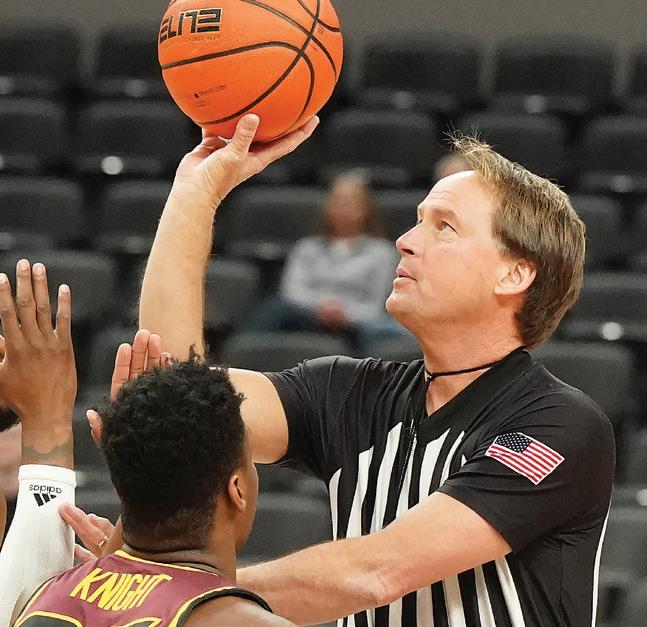
“Over the course of the last decade, John has made our consortium stronger, not only with consistent calls and effective communication on the court, but in providing leadership and mentorship to officials across our roster,” said the commissioners of the six conferences comprising the WBOC in a joint statement. “He has established and earned the respect of both colleagues and coaches alike during a more than three-decade career in college basketball, and we anticipate a smooth transition from one of the sport’s most respected officials ever in Bobby Dibler to John Higgins for the upcoming 2023-24 season and beyond.”
Lewis worked the NBA Finals each of the last four seasons.
UEFA Condemns Manager’s Behavior
UEFA charged Roma coach Jose Mourinho with using abusive language against a match official after Mourinho confronted Anthony Taylor following the Europa League final in May. UEFA condemned the harassment of Taylor and his family by Roma fans the next day. Taylor and his family
needed protection from airport security to navigate through an angry mob at the Budapest Airport.
MLB Suspends Manager Amid Ejections
MLB suspended Yankees manager Aaron Boone one game following a spate of ejections for arguing with umpires. Boone served his suspension on May 26, the day after being ejected for the fourth time this season and the second
time in four days. He was also fined an undisclosed amount. Since becoming the Yankees manager in 2018, Boone has been ejected 30 times.
Defee Named Mountain West Coordinator
Former Big 12 referee Mike Defee was named May 9 as the coordinator of football officials for the Mountain West Conference. Defee brings to the position 19 years of onfield collegiate officiating
experience, including working four Big 12 championship games, eight bowl games, one College Football Playoff semifinal and the 2017 College Football Playoff National Championship Game. The native of Beaumont, Texas, joined the NFL in 2020 as a coach/trainer, helping referees on development, leadership and game management.
REFEREE August 2023 | 11
BILL GREENBLATT/UPI
SOURCES: ESPN, ELNUEVODIA.COM, FOOTBALLZEBRAS. COM, NBC SPORTS, WPMT-TV, LANCASTERONLINE. COM, FOXNEWS.
College basketball referee John Higgins is leaving the court to become coordinator of officials for the Western Basketball Officiating Consortium.
TIME FOR A CHANGE NCAA Makes Major Modification to Game Clock Rule
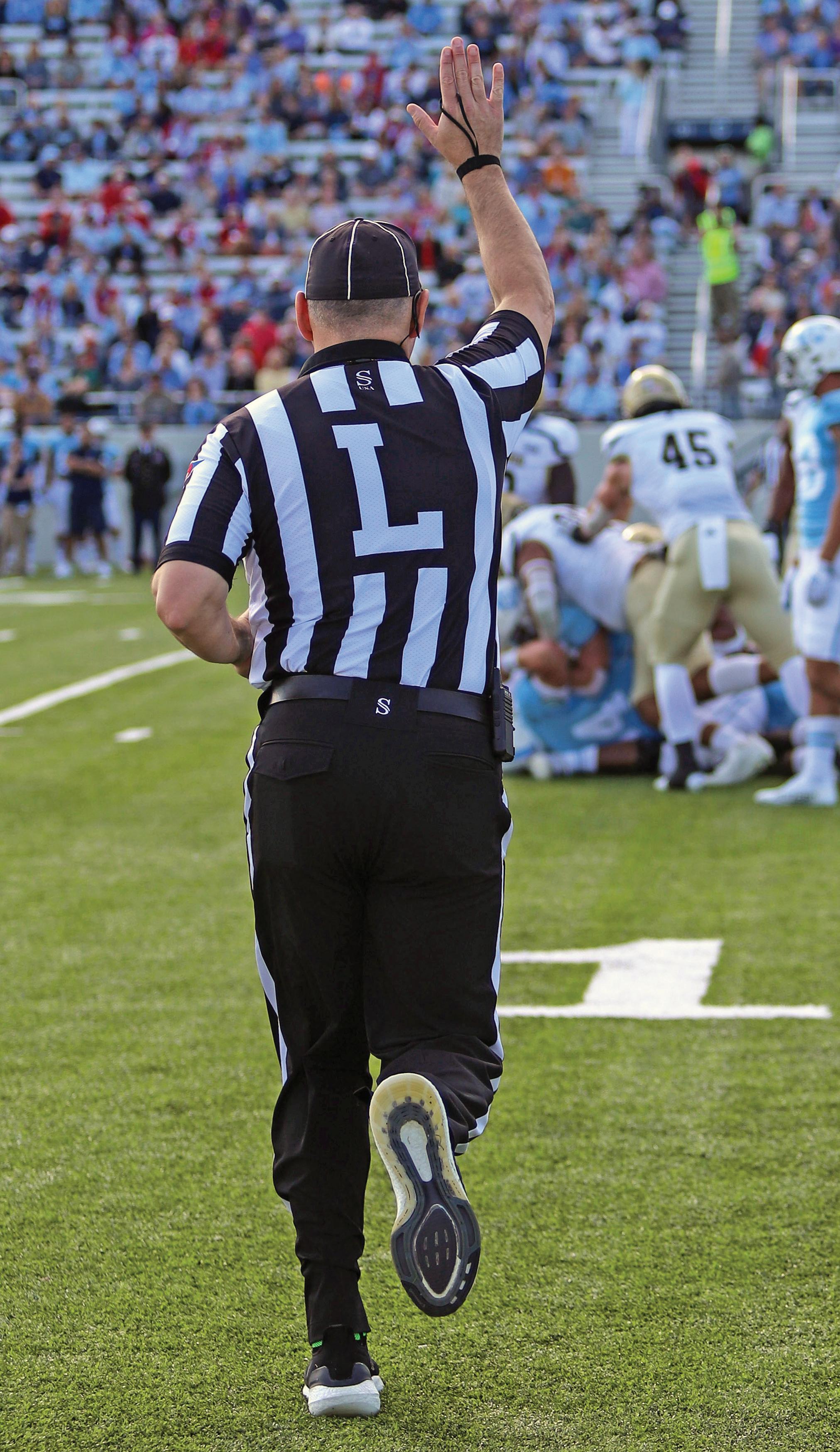 By George Demetriou
By George Demetriou
The NCAA Football Rules Committee met in Indianapolis in March and announced changes for the 2023 season. The Playing Rules Oversight Panel, which is charged with evaluating rules in terms of negative impact on the image of the game, safety concerns or financial impact on institutions, approved the changes in April.
The changes are presented in perceived order of importance. The material has been reviewed by Steve Shaw, secretary-editor of the NCAA Football Rules Committee. For official rule language and interpretations, always consult NCAA publications.
Stopping the Clock (3-3-2e1)
The clock will no longer stop for first downs inbounds, except for the last two minutes of a half. As of press time, the NCAA was considering whether the rule will apply at the Division III level. The plays that follow assume the new rule is in force.
Play 1: In the second period, A1 gains 11 yards for a first down near the left hashmark. When the play ends, the game clock shows (a) 2:02, or (b) 1:52. Ruling 1: In (a), the game clock keeps running unless either team takes a timeout or the referee has another reason for stopping the clock. In (b), the game clock is stopped for the new series and will start on the referee’s signal.
Consecutive Timeouts (3-3-4a)
A team will no longer be able to call consecutive timeouts. The strategy was mostly used as an
Brian Harless, Knoxville, Tenn., and other college officials will be using this signal more often this season due to a rule change regarding the game clock. Except for the last two minutes of each half, the game clock will not stop when a team gains a first down.
FOOTBALL RULES, MECHANICS, PHILOSOPHY EDITOR: JEFFREY STERN jstern@referee.com 12 | REFEREE August 2023
AMY CROCKETT
attempt by opposing coaches to “ice the kicker” before an attempted field goal. Opposing teams may request successive timeouts and a charged timeout may follow an injury timeout or any other official’s timeout.
Period Extension (3-2-3a)
Untimed downs as part of a period extension are now limited to the end of a half, except for a try. That applies to accepted penalties for live-ball fouls, offsetting fouls and inadvertent whistles that take place during a down in which time expires.
If that happens at the end of the first or third period, the next play will be the first play of the next quarter. If a touchdown is scored on the last play of the first or third period, the period is still extended for the try. Restricting the period extension to the end of a half has changed the dynamic of whether to accept or decline the penalty.
Play 2: The second period ends during a play in which A1 gains a first down and either A2 or B3 commits a live-ball personal foul. Ruling 2: If team A fouls, team B will decline the penalty and the half will end. If team B fouls, team A will likely accept the penalty extending the half for another play.
Play 3: In the first quarter, A1 scores a touchdown as time in the period expires. Ruling 3: The period is extended for the try.
Replay Adjustments (12-2-1c)
During games in which there is no replay official in the booth, onfield officials may use available video to review targeting fouls and after a coach’s challenge. Other than for a targeting review, the crew on the field may not initiate an instant replay review. The referee will be the sole decision-maker on any review and may include one additional crew member to consult on the review.
The video is used by the referee and must be in full compliance with Rule 12, with some exceptions. The equipment used in the review must be located outside the limit lines on the sideline or end zone and must be completely outside the team area. The referee and additional crew member must be provided a separate, secure
location away from fans and sideline personnel, with a tent or similar type shelter structure.
The referee will stop the game to review all targeting fouls called on the field. The only other method to stop a game for a replay review is through a head coach challenge, which is initiated by taking a team timeout before the ball is next legally put in play. If all the team’s timeouts have been used for that half or in that extra period, a challenge is not allowed. The head coach shall drop the replay challenge flag onto the field and inform the referee the ruling of the previous play is being challenged. Such a challenge may be for any reviewable play in rule 12-3 to include a targeting review on a no-call, including a clock adjustment.
After a review has been completed, if the onfield ruling is overturned, that team’s timeout will not be charged and the coach may have a second challenge for a total of two challenges per game. If all the team’s timeouts have been used for that half or in that extra period, a challenge is not allowed. If the ruling is not overturned, the charged team timeout counts as one of the three permitted that half or the one permitted in that extra period. The preceding also applies if the play being challenged is not reviewable.
A head coach may not challenge a ruling in which the game was stopped and a decision has already been made by the replay official. However, a head coach may challenge an aspect of the same play if that component of the play was not considered by the replay official as part of the initial review.
Drone Policy (1-4-11d)
Drones are not allowed over the field or the team area when squad members are present within the playing enclosure. Outside the limit lines, game management (or conference policy) will govern drone activity. That governance includes all FAA, state and local laws including campus policy where appropriate.
Halftime
Intermission
(3-2-1c, 11-1-3)






Game management will determine the timing of halftime activities.
DID YOU KNOW?
In February, the California Interscholastic Federation (CIF) announced it would sponsor girls’ flag football as a varsity sport. Member schools that launch programs have been told financial assistance is available from the NFL. The league is encouraging flag football for financially challenged high schools due to its low cost compared to traditional football.
DID YOU KNOW?
It was something less than a homefield advantage for the University of Northwestern − St. Paul, an NCAA Division III school in St. Paul, Minn., when it hosted Cornell (Iowa) College on Sept. 1, 2007. Northwestern scored a touchdown with 51.9 seconds left to pull within a point, 31-30. Before the Eagles could attempt the potential game-tying try, the sprinklers came on. After a 15-minute delay, the Eagles’ kick was blocked. Cornell was able to run out the clock and secure the victory.
TOOLS
Prep Football 2023
Are you a high school football official looking for a one-stop shop to improve your game?

The Prep Football 2023 book is a collection of the best Referee has to offer, providing high school officials with challenging rules reviews, detailed mechanics, bestpractice strategies and real-world quizzes and caseplays — all in one clean and easy-to-read format.
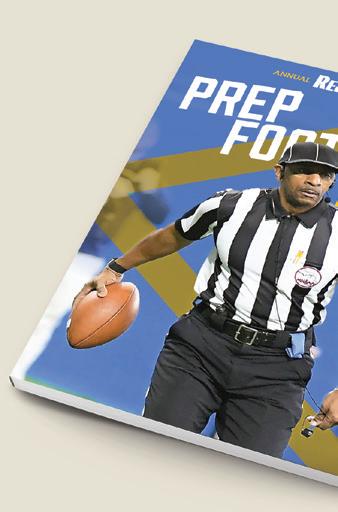
The full-color, magazine-sized, 96-page book costs $18.95 and is available at store.referee. com/football.
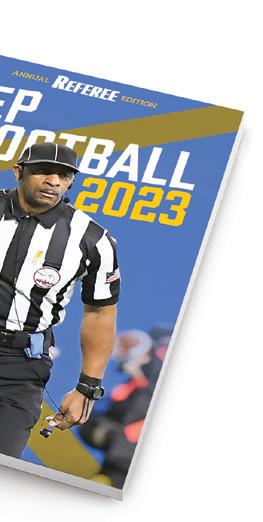
REFEREE August 2023 | 13
TEST YOURSELF
In each of the following you are given a situation and at least two possible answers. You are to decide which answer or answers are correct for NFHS and NCAA rules, which might vary. Note: In kicking situations, K is the kicking team, R the receiving team. Solutions: p. 81.
1. R1 gives a valid fair-catch signal at his 35 yardline. The ball bounces off his shoulder pad and is still in flight behind him.
a. R1 no longer has protection from contact.
b. R1 only has protection if the covering official rules he has a reasonable chance to catch the ball.
c. R1 only has protection if the covering official rules he has a reasonable chance to recover the ball.
d. If any team K player catches or recovers the ball, he may advance.
2. Second and 25 at team A’s 20 yardline. A1 throws a legal forward pass intended for A2 at team A’s 28 yardline. As A2 reaches for the pass, B3 interferes. The pass falls incomplete. After the play, A2 slugs B3.
a. The penalties cancel; the down is replayed.
b. It will be team A’s ball, second and 25 from its 20 yardline.
c. It will be team A’s ball, first and 10 from its 20 yardline.
d. It will be team A’s ball, first and 10 from its 14 yardline.
e. A2 is ejected.
3. Fourth and 10 at team K’s 30 yardline. The ball is positioned in the middle of the field. R1 makes a fair catch of K2’s punt near the sideline in front of team R’s bench. Team R desires to have the ball placed in the center of the field for the next play.
a. The request is denied.
b. The request is granted.
4. Just after K1’s punt is airborne and untouched by team R, K2 blocks R3. The contact isn’t severe but sufficient that it causes R3 to knock K1 to the ground.
a. No problem.
b. R3 has fouled if K2’s block was legal.
c. R3 has fouled if K2’s block was illegal.
d. R3 has fouled under any circumstances.
The field will be available to squad members no later than three minutes prior to the second-half kickoff. When any squad member enters the playing enclosure during the halftime intermission, a staff member from that team must be present on the field.
If kickers or other squad members come onto the playing enclosure before the field is available, their activities must be confined to the team area. All team personnel will be respectful of scheduled halftime activities, and all kicks must be into the practice kicking nets until the field is available.
When the field is available to players as determined by game management during the halftime intermission, the playing field will be divided into an “L-shaped” configuration with the 30 yardlines forming the “L” as seen in the MechaniGram.
Editorial changes. A few editorial changes were made to clarify existing rules.
Blocking Below the Waist (9-1-6b-3,
c, d)
Blocking below the waist is permitted against a runner as well as a ball carrier. Also, a stationary back may
block below the waist within the tackle box until the ball leaves the tackle box if the force of the initial contact is directed from the front. The back must have lined up with any part of the body inside the tackle box.
Play 4: B1 breaks through his blocker and tackles A2 below the knees just after A3 faked handing the ball to A2. Ruling 4: Legal because A2 simulated having possession of the ball.
Play 5: Back A1 is stationary at the snap directly behind the right tackle in a balanced line formation. Only his left shoulder is inside the tackle box. A2 hands the ball to A3 who runs straight ahead. A1 blocks B4 who moves into the offensive backfield to make a play on A3 before A3 reaches the line of scrimmage. A1’s block is below the waist and clearly from the front. Ruling 5: A legal block. A1 was partially inside the tackle box and the block was from the front (AR 9-1-6 III).
Contacting the Kicker (9-1-16a4c)
The kicker’s protection ends when he carries or possesses the ball more than five yards behind his initial position in the scrimmage kick formation before kicking.
Play 6: Fourth and 10 on team K’s
FOOTBALL 14 | REFEREE August 2023
VISITING BENCH HOME BENCH
COACHES AREA
COACHES AREA
HOME WARM-UP AREA
VISITOR WARM-UP AREA
THE BEST-SELLER IS BACK WITH AN ALL-NEW EDITION!
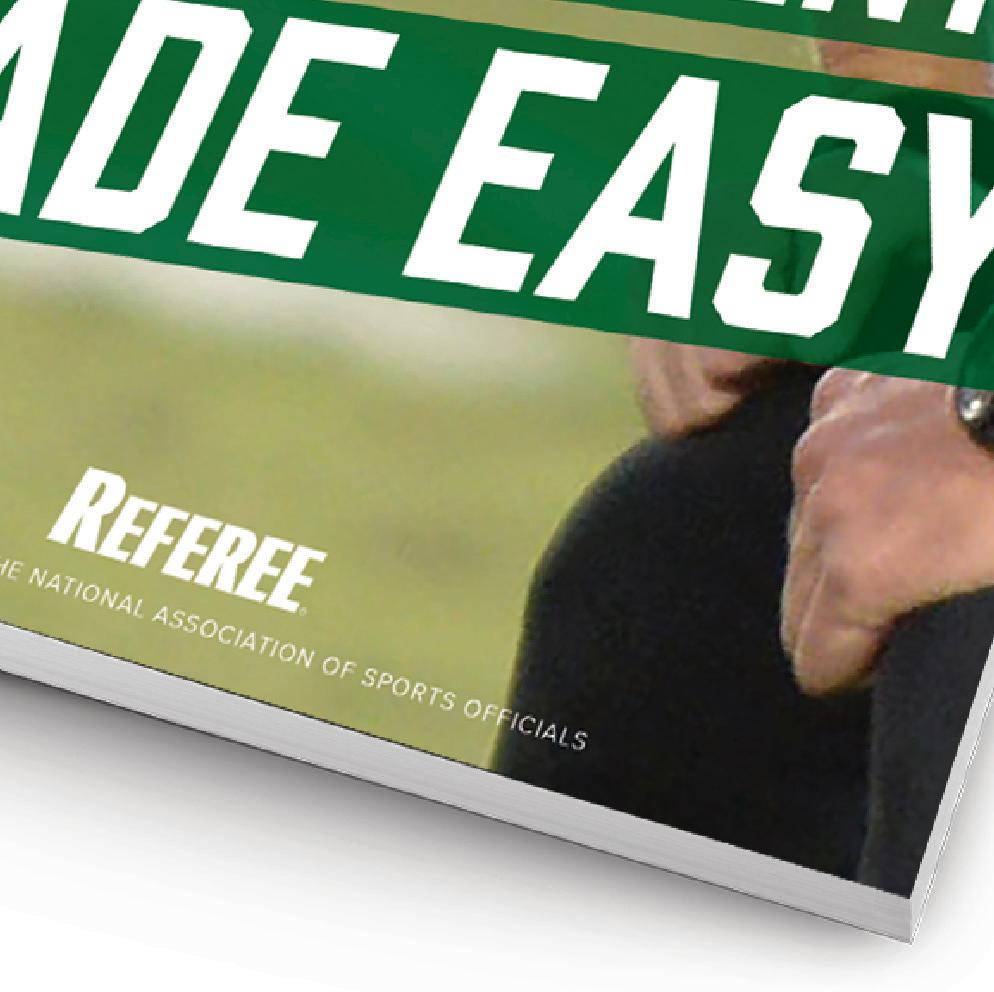
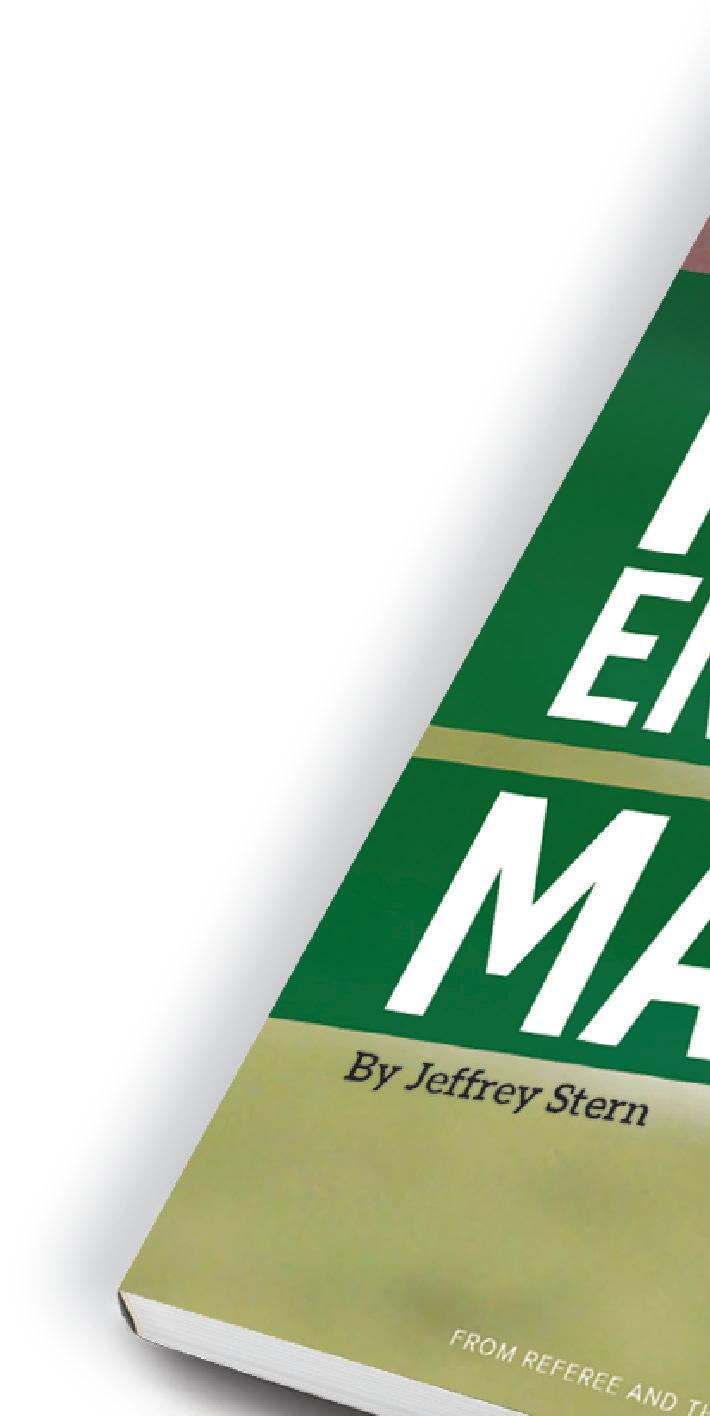

THE EVOLUTION OF ENFORCEMENTS
The best-selling penalty manual is fully updated for 2023 with all the new NFHS rule changes. Explore multiple play scenarios with a direct visual representation with Referee’s exclusive MechaniGrams® and flow charts. Handy penalty summary and signal chart also included. also
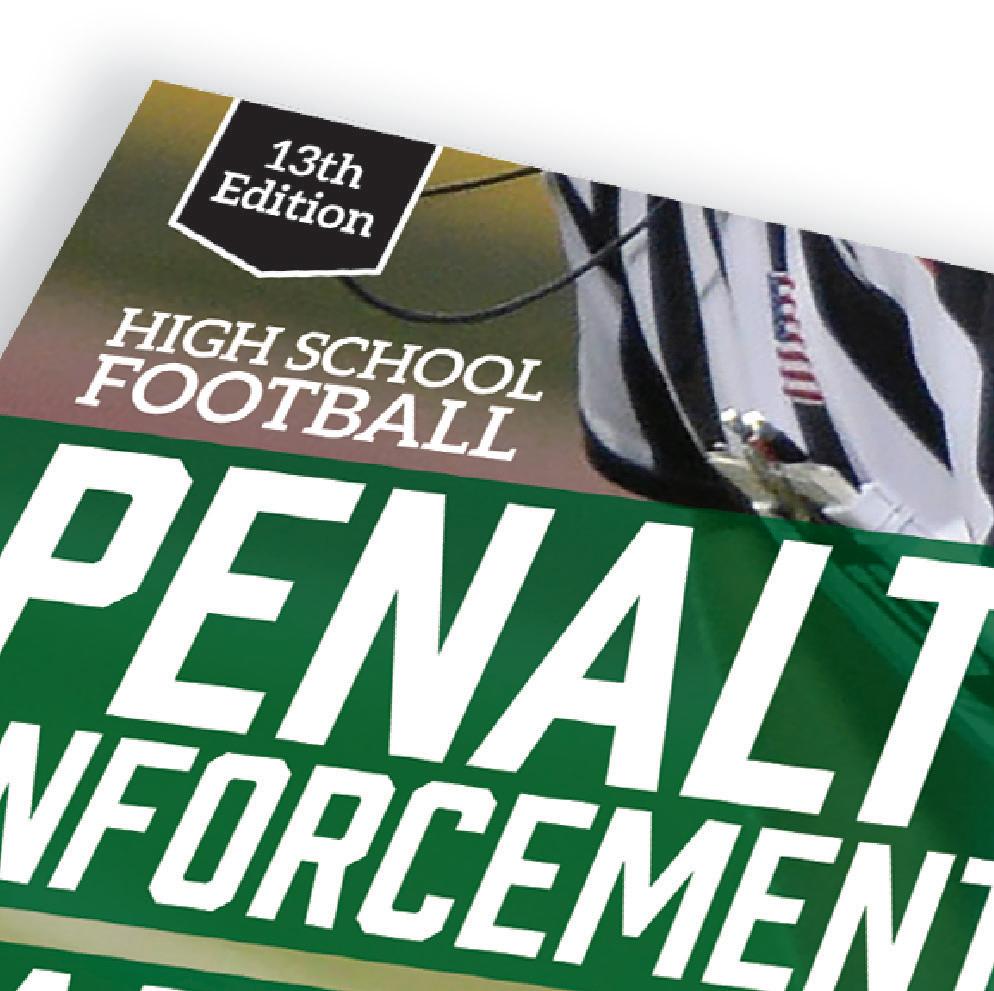
$2195

$2695























Size: 8”x9” Pages: 160
all 2023 rule changes included

ORDER YOURS TODAY! STORE /FOOTBALL *NASO Member Discount Available.
DIGITAL
* PRINT
COMBO
$1895 *
CASEPLAYS
Filling a Vacancy
Play: First and 10 on team A’s 40 yardline. B1, realizing his team is one player short, enters the field on the proper side of the ball before the ball is snapped. He is only able to get two steps onto the field as A2 runs a sweep toward team A’s sideline. B1 tackles A2 at team B’s 40 yardline. Ruling: Legal because B1 entered the field before the ball had been snapped, B1 was filling a player vacancy and was on his team’s side of the ball at the snap. Team B players are not subject to the rules requiring players to be within the nine-yard marks before the snap (NFHS 2-29, 2-31-1; NCAA 2-27-6a, 7-1-5b-1).
Muffed Free Kick
Play: K1’s free kick is at rest one yard from the goalline pylon when R2 muffs trying to recover the ball. The ball hits the goalline pylon. Ruling: Under NFHS rules, the result of the play is a touchback. Force is not a factor on kicks going into team R’s end zone. In NCAA play, the impetus for the kick being in team R’s end zone is the muff by R2 when the ball was at rest in the field of play. The result of the play is a safety (NFHS 2-13-4a, 8-5-3; NCAA 8-6-1b).
Safety on a Try?
Play: Can team B score a safety on a try? Ruling: Under NFHS rules, only team A may score on a try (8-33). In NCAA play, the offense can score a one-point safety. On Nov. 26, 2004, an attempted kick try by Texas went beyond the neutral zone. A Texas A&M player recovered the loose ball, then fumbled. Another A&M player recovered the fumble and was downed in his own end zone. The impetus that put the ball in the end zone was the fumble; when the ball became dead in the end zone in the possession of the A&M player, the result was a safety (8-1-1, 8-3-1).
Final Score
Play: An NCAA game goes to extra periods with the score tied, 10-10. On its first possession, the home team kicks a field goal to go ahead, 13-10. On the first play of the visiting team’s possession, the home team intercepts a pass and returns it for a touchdown. Does a try follow the touchdown? Ruling: No try is attempted. The final score is 19-10 (3-1-3e, 8-3-1, AR 3-1-3 I).
40 yardline. Punter K1 is positioned on his 30 yardline. K1 tips the snap, which is over his head. K1 recovers the ball at his 24 yardline. He then stops and punts the ball. He is immediately hit by a diving R2. Ruling 6: Legal play, no foul by R2. K1 loses his roughing or running-into protection by possessing the ball more than five yards behind his initial position.
Fourth Down Fumble (8-3-2d)
If team A fumbles on fourth down before a change of team possession or on the try, the fumbler is the only team A player allowed to advance the ball. The ball is dead if a teammate of the fumbler recovers or catches the ball (4-1-3j). When that happens on fourth
down (7-2-2a Exc. 2), the ball belongs to team A, if perhaps only temporarily. When it happens on a try, the try is over and there is no score (8-3-2d-5). The rule applies any time during the down; the fumble does not need to be before a change of team possession.
Illegal Kick (6-3-10c)
The rule regarding a kick beyond the neutral zone has been realigned to match the rule for a forward pass beyond the neutral zone. A scrimmage kick is now illegal if the kicker’s entire body and the ball is or has been beyond the neutral zone.
George Demetriou has been a football official since 1968. He lives in Colorado Springs, Colo.
Apropos to Go Slow Till You Know You Must Throw
By Tim Sloan
You
be the referee.
Team K punts. K1’s kick is caught in the end zone by R2, who runs to his left, is about to be tackled and throws a backward pass to R3. R3 punts the ball back toward K1, standing at team R’s 30 yardline. The ball is lying motionless at the feet of K1, who is surrounded by seven team R players. R2 has run up the field and is about to fall on the ball when K1 kicks it back toward team R’s goalline. The ball rolls out of bounds just inside the end zone. The back judge then blows the play dead, and the umpire throws a flag. Ruling?
“Baloney! That can’t happen,” you say to yourself, armed with about a half-dozen reasons.
Well, it happened to me. I was white-hatting my first-ever high school playoff game on a warm November day in 1985. In London, Ontario. In overtime.
I pulled my crew of five together and we agreed on the facts I just presented. The others were looking at me like they sure hoped I knew what to do. Under Canadian rules at
the time, I told them it was a legal play and team R should be awarded a single point. I then asked my umpire what he had, and he said, “I don’t know. With all that going on I figured something had to be illegal.” We laughed. I announced the decision and team R ended up winning by that single point, 14-13.
The play required us to string together three or four esoteric points in the Canadian rules. Each was of a sort many officials would never see in a career and never be asked about on a rules test. The fact they all came up on the same play — in overtime of a playoff game — was one for the ages, but we got through it. We even got a pat on the back for it later.
Looking back on it, though, what would have happened if someone blew a whistle somewhere in the course of the play? Never mind an article; I could write a book about how to sort that out. The most important thing the crew did on that play was nothing. Nothing saved the day.
Today we all deal with proving our rules knowledge each season through some form of testing.
FOOTBALL 16 | REFEREE August 2023
That implies to some observers the officials should know everything and are incompetent if they don’t. Unfortunately, some officials then believe they must make an instant decision on every play to prove their competence. That typically involves blowing a whistle or calling time. Both choices are final — once they occur, everyone is stuck with what happened or, often more importantly, is happening. That can result in an unfair, undesirable or flat-out wrong outcome.
Most rule codes make some allowance for a do-over for inadvertent whistles or calls, or at least for a review and correction. So as much as it might feel negligent to swallow one’s whistle, letting the play end on its own and then fixing it after some thought is often the high road to take.
Circling back to that day in London, while the crew was discussing the call, neither coach had
any idea what was the right decision (by confession afterward). That is often the case when the unexpected happens: As wide-eyed as you and your crew might be, you’re way ahead of the participants. Unless it’s some obvious question of fact, you will get more credit for taking the time to get it right than rushing to an incorrect decision for the sake of looking decisive.
The concept here is dealing with surprises and ruling appropriately doesn’t have to be a case of stoically shrugging and saying you can’t prepare for everything. A way of preparing to deal with all the complexities of the rules may be to delegate exotic parts to individual crewmembers; have “subsystem” experts to drill down on certain parts. As the umpire on my current football crew, I make a point of understanding and thinking deeply about all the aspects of line play. Our back judge understands the nuances of the
goalline inside and out. Our referee knows exactly the right questions to ask of each of us and expects us all to recognize the key facts of a situation even if we don’t know the exact penalty to apply. It’s a good system.

The objective for officials is not to stuff our heads with facts and spew them out on a crazy situation to solve it. It is to know how the rules interact and recognize how they apply to situations. Then it’s to knit together what you do know to make the right — or maybe just the best — decision. You will waste more study time trying to be ready for anything than you would by learning the rules well enough to be able explain them to someone else. The rest just comes with experience.
Enjoy the journey and welcome the challenges.
Tim Sloan, Davenport, Iowa, is a high school football, basketball and volleyball official, and former college football and soccer official.
Are You a Referee or a Crew Chief?
By Jon Bible
Are you a white hat with a regular crew? If so, are you a referee or crew chief? There’s a difference. Referees basically run the game and announce penalties. Crew chiefs, the good ones anyway, do far more. They’re tone-setters, educators, negotiators, liaisons, wrist-slappers and consolers

— Dear Abby, Mother Teresa, diplomat and drill sergeant rolled into one.
My local high school association didn’t use crews, so I didn’t start learning what being a crew chief was all about until I became a college and then an NFL side judge. Two of mine were poor and one — NFL referee Bernie Kukar — was great. I borrowed from his repertoire when I became a college
referee in 1997. Being in roughly 140 games as a replay official has contributed to my thinking about what good chiefs do.
What follows is based on my NFL and college experience but I think it applies at lower levels, perhaps with modifications.
Good chiefs will work to create a positive atmosphere. Kukar was all business but kept us loose with his sense of humor. That made us better on the field and more apt to self-motivate for rules, mechanics and film study during the week. Contrast that with the negative tone set by my two poor chiefs, who had sour personalities, a my-way-or-the-highway attitude, no sense of humor and were always griping about something. That adversely affected our crew dynamics, which spilled over into
how we worked our games.
I tried to set a positive tone on my crews. We took care of business but had fun. We learned from our critiques without whining and then turned the page and approached each game fresh. You can’t officiate well if you’re uptight or bummed about how you graded out last week or whatever else, and good chiefs will ensure this doesn’t happen.
Good chiefs will get to know all crewmembers — background, interests, goals, etc. — and their families. We must know what makes each of the diverse personalities tick if we’re to achieve the harmony and mutual trust needed to turn in a solid performance each week. That also helps us to do such things as mediate internal disputes, provide
FOOTBALL
a shoulder to lean on if someone needs it and integrate spouses, kids, etc., into crew affairs, which is essential if the crew is to be a family that performs well.
I’ve had crewmates who were unduly harsh on themselves, cocky and overbearing and everywhere in between. It takes work and knowledge of their idiosyncrasies to figure out how to approach each one and make him a betterfunctioning cog in our machinery.
Once something happened and, in midseason, I inherited a crew, none of whom I knew. Before our first week I feared how they would react to an unknown trying to lead them, but it was quickly apparent they wanted and expected me to run the show (not in a dictatorial way, of course). I’ve used that experience to counsel young referees to be diplomatic but not to be shy and to take charge of their crew from day one.
Taking charge involves establishing crew expectations and time frames and ensuring they’re met. Good organization makes everyone perform better. Good chiefs are also competent liaisons who meet deadlines imposed by assigners, boards, schools, etc.
Leading involves cracking the whip when necessary, for we’ll lose respect if we don’t. Once, someone was consistently late to meet to go to the stadium. The third time I said, with a smile, have your credit card next time because if you’re not ready at X time you’ll have to take a taxi. After that, he was early.
Good chiefs will risk incurring the wrath of their assigner or board and go to bat for someone who’s getting a raw deal in terms of performance appraisal or whatever else. On the flip side, I’ve had to tell an official if he didn’t improve he might not stick around. Then the task became figuring out what to do to fix it. Several guys have needed help with rules. That can be time-consuming and isn’t always pleasant, but it goes with the territory.
Many chiefs review their game film before the office does and
have weekly crew calls to discuss their performance and anything on people’s minds before they get together for the crew meeting before the game. It’s best to get last week behind us as soon as possible.
A good chief will put a lot of thought into his pregame. Having participated in many as a replay official, I think that aspect of preparation gets short shrift. I’ve been in some that went on forever, were monologues or wasted time on obvious points. Making people twiddle their thumbs or have glazed eyes doesn’t promote solid performance on the field. Good pregames are concise, focused, stimulating, participatory and innovative. Increasingly, they incorporate video of unusual plays and scouting of that week’s teams.
I tried to instill freshness by putting everyone in charge of a pregame. One guy pulled out his car keys and said the topic is keys (which players we’re primarily responsible for watching) because we’ll louse up the game if we’re not on the same page. Another structured a Jeopardy session, with categories for punt, pass, etc. The crew would buy the winner a postgame drink. When I happened to win, I ordered a quintuple bourbon. Hey, it was “a” drink!
I recently visited with a young referee who said he had two guys with bad attitudes and wondered what to do. It was postseason. Should he let it go? I thought he should initiate a one-on-one and share his concerns. They may resent it, but maybe they’re not aware there’s a problem and would welcome the chance to fix things. If they’re with him next year, issues can be averted from the start. If they go elsewhere, difficulties there might be avoided. Unpleasant stuff, potentially, but again it’s part of the landscape if you want to be a crew chief, not just a penalty enforcer.
Jon Bible is a replay official in the Southeastern Conference. A resident of Austin, Texas, he formerly officiated collegiate and pro football.

Touchback or Safety? It Depends

Whena loose ball goes out of bounds in the end zone, the first questions an official must answer are, “How did the ball get there?” and “Who put it there?” If the answer to the first question is “fumble,” you have two possibilities. The result of the play will either be a touchback or a safety.
If the runner in the PlayPic fumbles into the opponent’s end zone, his team provided the force (NFHS) or impetus (NCAA). The result is a touchback and the opponent will next snap from its own 20 yardline. If the runner fumbles the ball and it goes out of bounds in his own end zone, it’s a safety.
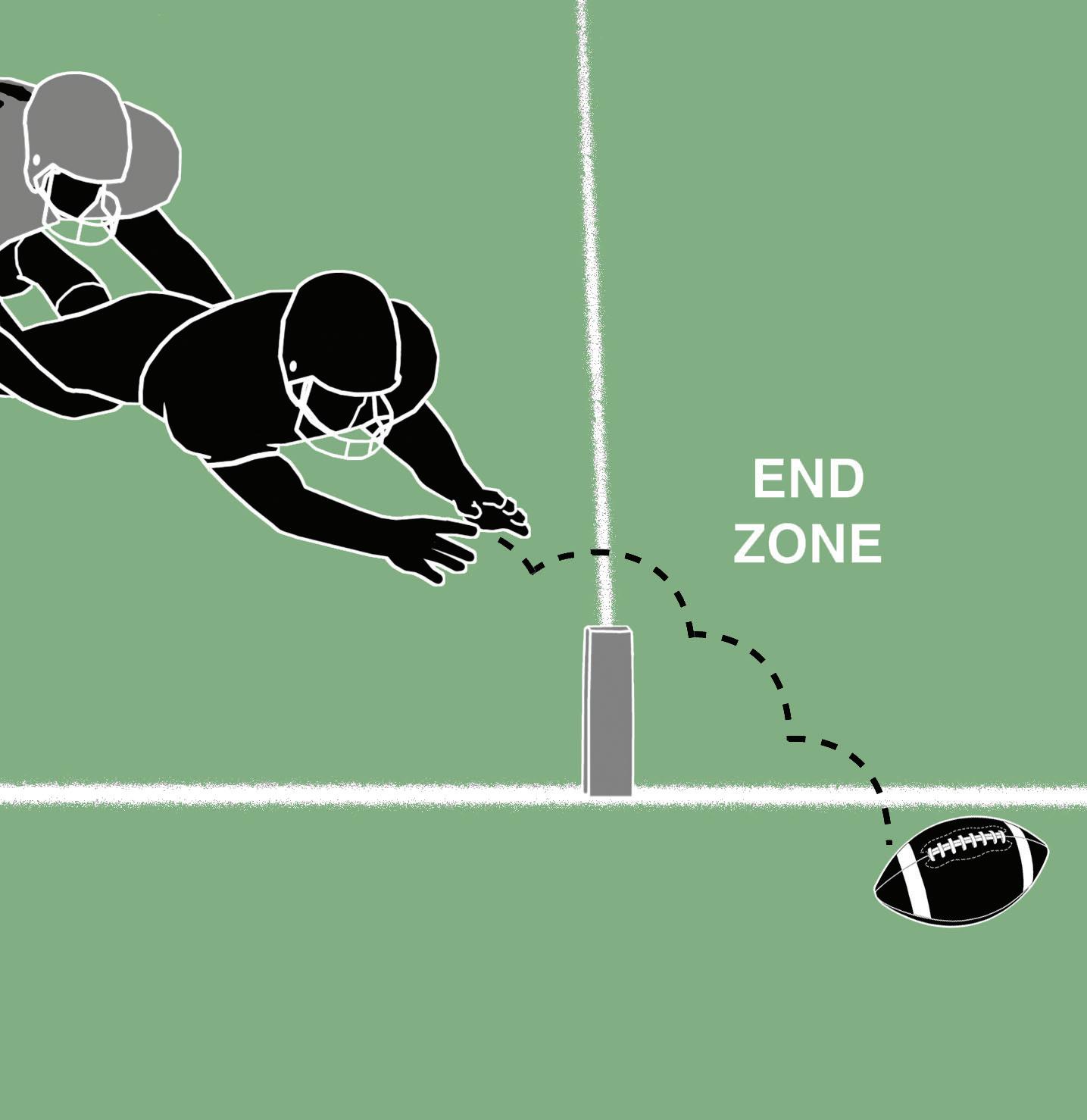
Whenever a ball is loose near a goalline, be especially alert for bats and muffs. A bat in that situation may or may not be a foul, depending on location of the ball and the direction in which the ball is batted. Muffs
are common because players are in a hurry to secure possession of an oddly shaped ball that is bouncing every which way.
In NFHS, after a fumble, kick or backward pass has been grounded, a new force may result from a bat, an illegal kick or a muff. The muffing or batting of a pass, kick or fumble in flight is not considered a new force.
In NCAA, initial impetus is considered expended and the responsibility for the ball’s progress is charged to a player if he kicks a ball not in player possession or bats a loose ball after it strikes the ground, or if the ball comes to rest and he gives it new impetus by any contact with it, other than through forced touching.
FOOTBALL 20 | REFEREE August 2023
Whenever a ball is loose near a goalline, be especially alert for bats and muffs.
AL L NEW 2023 HIGH SCHOOL RULES


CLARIFIED & EXPLAINED WITH VIDEO PLAYS

Convenient Thumb Drive

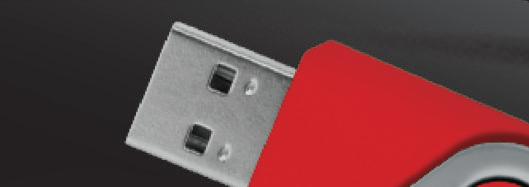
TAKE IT
ANYWHERE!
Brought to you by Tim Kiefer and MIBTonline.com, the latest edition of “High School Officiating Best Practices” focuses squarely on the 2023 high school rule changes, including all the significant changes and updates.
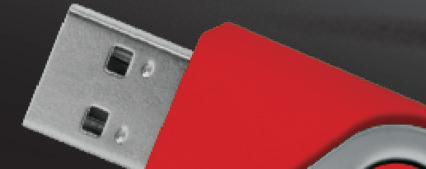



















































































Additionally, Tim takes you through all the 2023 Points of Emphasis and fully reviews last season’s critical rule changes.
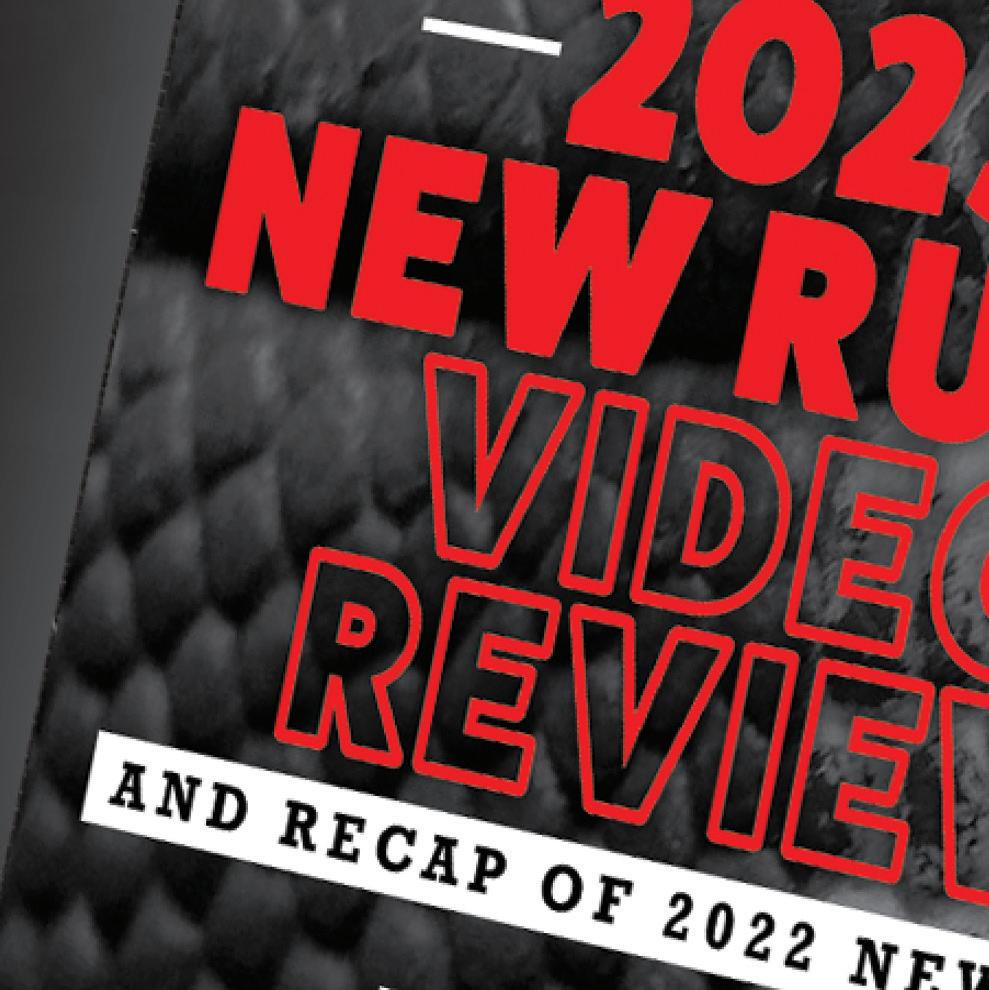
Fouls Behind the Line of Scrimmage Explained All new Enforcements & Exceptions
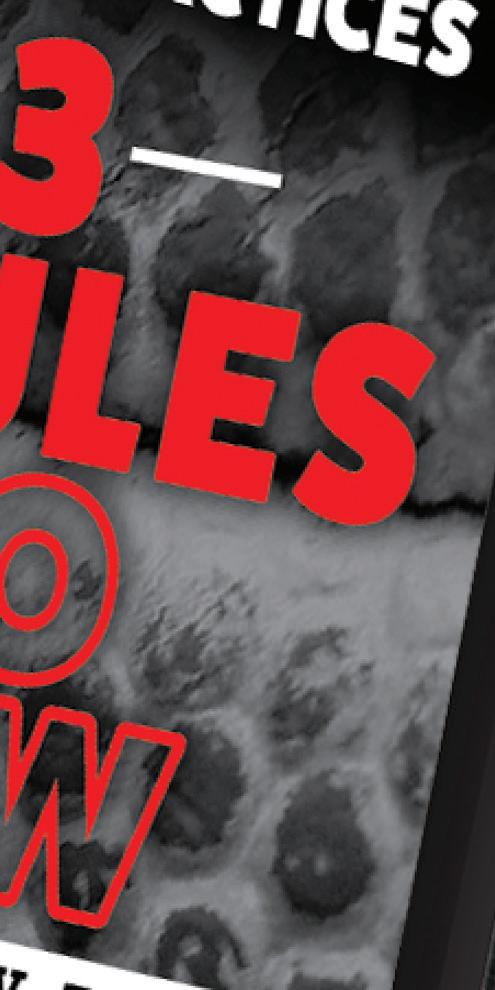
Player Out of Bounds Changes















Legal Grounding Clarifications


Intentional Pass Interference Removal And More!

$2495







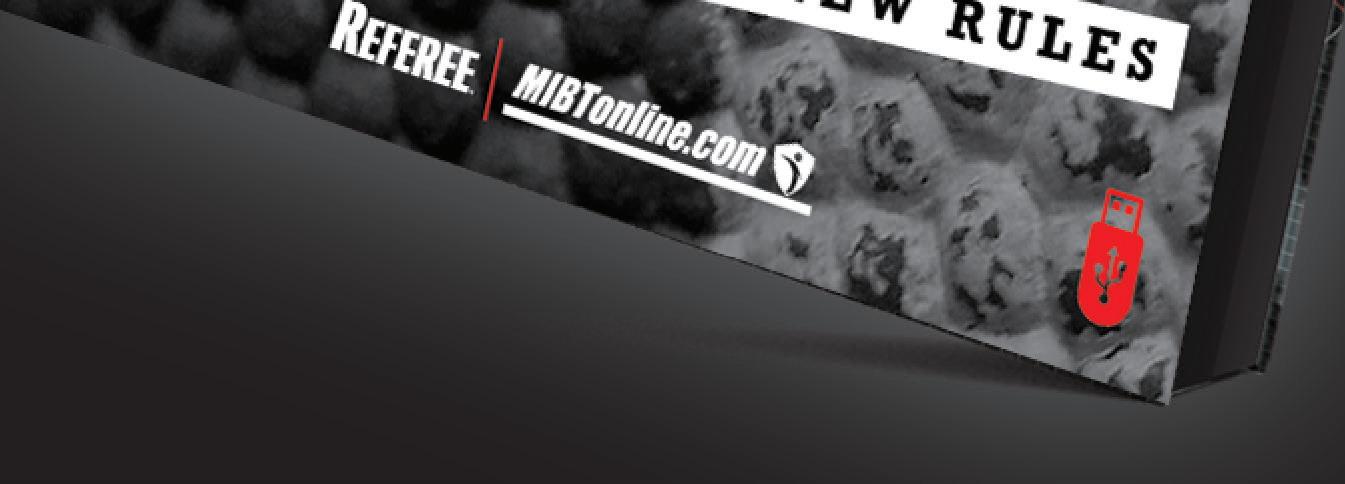


ORDER YOURS TODAY! STORE /FOOTBALL

• • • • •
•
Award





VIOLET PALMER
LEADER, MENTOR, TRAILBLAZER
BY PETER JACKEL

Just 50 miles east on California State Route 91 from the troubled area in which she was raised, Violet Palmer will walk to a podium at the NASO Sports Officiating Summit the evening of Aug. 1 in Riverside, Calif. She will accept something that has already been designated for her fireplace mantel. That’s the Gold Whistle Award — the highest honor in officiating — and when this eloquent lady puts into words what it means to her, an impressive gathering of admirers will be watching.
That includes Lisa Jones, who just worked her 11th NCAA Women’s Final Four and who owns a copy of a January 2000 issue of Referee with Palmer’s signature scrawled over an image of her and Michael Jordan on the cover. Among the numerous others planning to be in attendance that night will be Tanya Stine, Violet’s wife since 2014 (they’ve been together for 28 years), and NBA official Bennie Adams, one of her mentors.
Meaningful words always seem to come effortlessly for Palmer, who has continued to make an enormous
contribution to officiating as an NCAA Division I coordinator seven years after her knees gave out (they have both been replaced), and she will certainly command the room with her charisma once she steps up to the podium. After all, receiving awards is nothing new to her, and this is a woman who consistently set a high standard for composure on the court. She refused to let anyone or anything rattle her while officiating a total of about 1,800 games, even when she dared to be a pioneer in the NBA. But the Gold Whistle Award? That’s pretty heavy stuff. Maybe even Palmer’s composure will be tested that night, a possibility she does not dispute.
“I’ve received a lot of different recognitions for things,” said Palmer, who turns 59 one week before she receives this award. “Officiating is a very negative profession overall. To receive an honor — one of the highest honors you can receive — from your peers, is a total blessing. And it’s something that I never ever thought was possible. Talk about a total surprise of something that just came out of the blue! I just couldn’t believe
it when (NASO founder) Barry Mano called and said, ‘Hey, do you know what? You were unanimous for the Gold Whistle Award!’ I was like, ‘Are you kidding me?’


“I’m going to have a hard time holding back my emotions. First of all, when you receive an award from your peers, it’s extremely special. Secondly, with the award being presented in Riverside, that means I’m able to have all my family be there and so many officials will be able to attend.”
From her days of learning the game as a kid on the playgrounds of Compton, to leading California Polytechnic University, Pomona to NCAA Division II championships in 1985 and ’86, to becoming the first female to referee in a major professional sport, to nurturing young officials these days, Palmer has done it all in basketball. And she has done it all so well. When even the ever-opinionated Charles Barkley was moved to retract his initial observation that a female official has no business in the men’s game after seeing Palmer work, that’s saying something. When numerous

EXCEPT WHERE NOTED, PHOTOS COURTESY OF VIOLET PALMER
22 | REFEREE August 2023
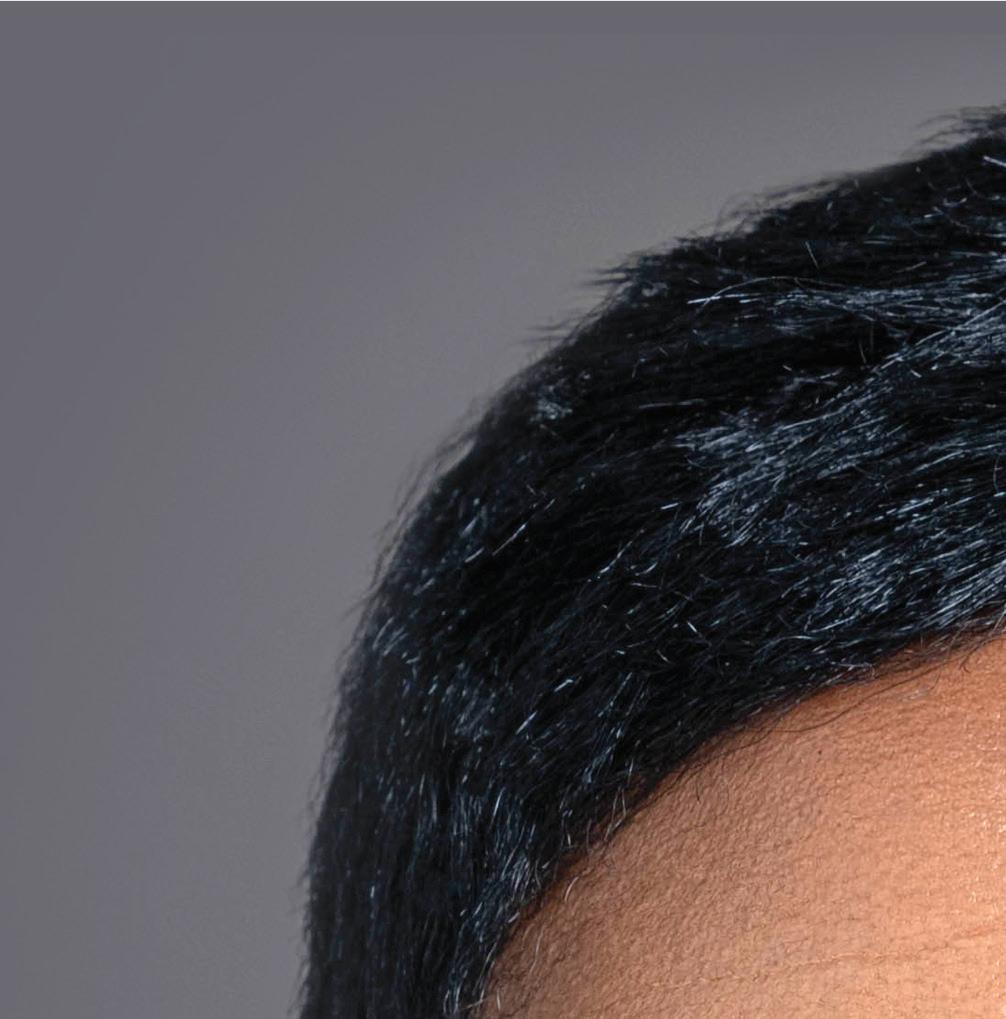
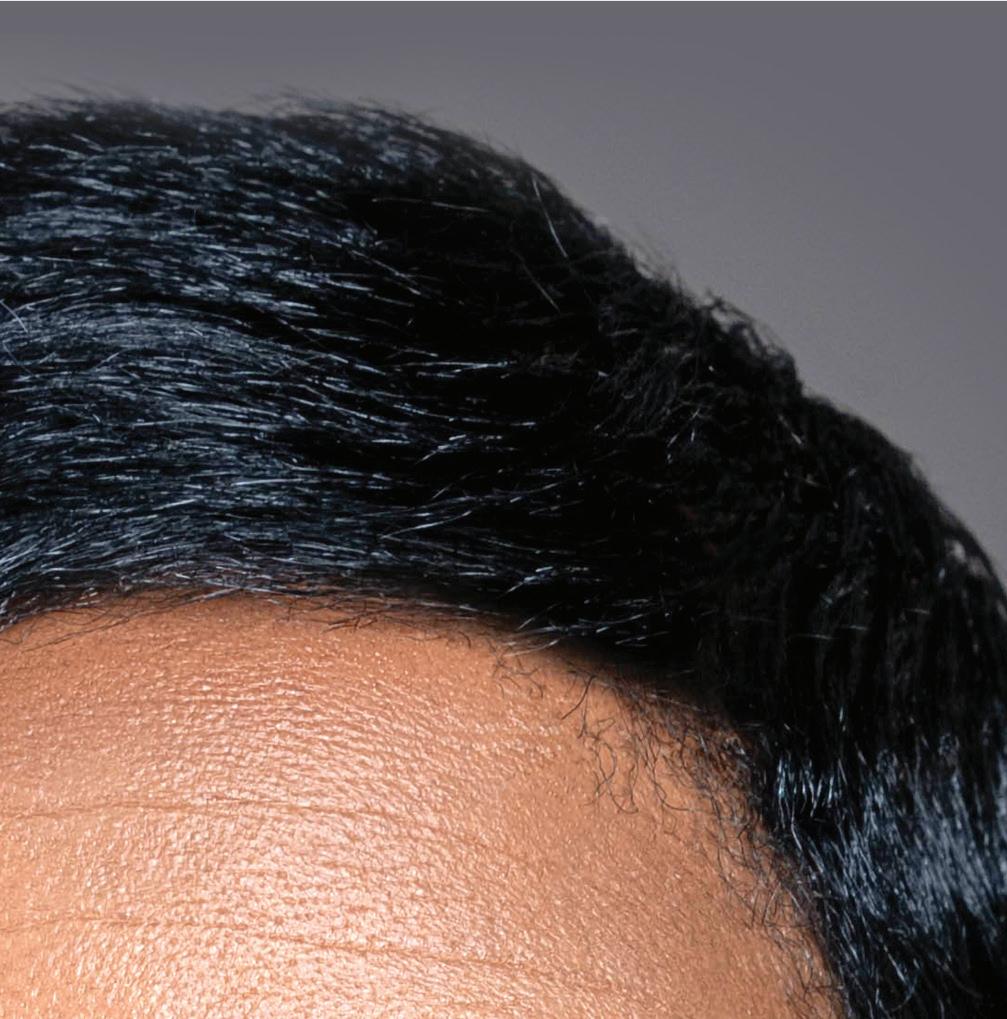



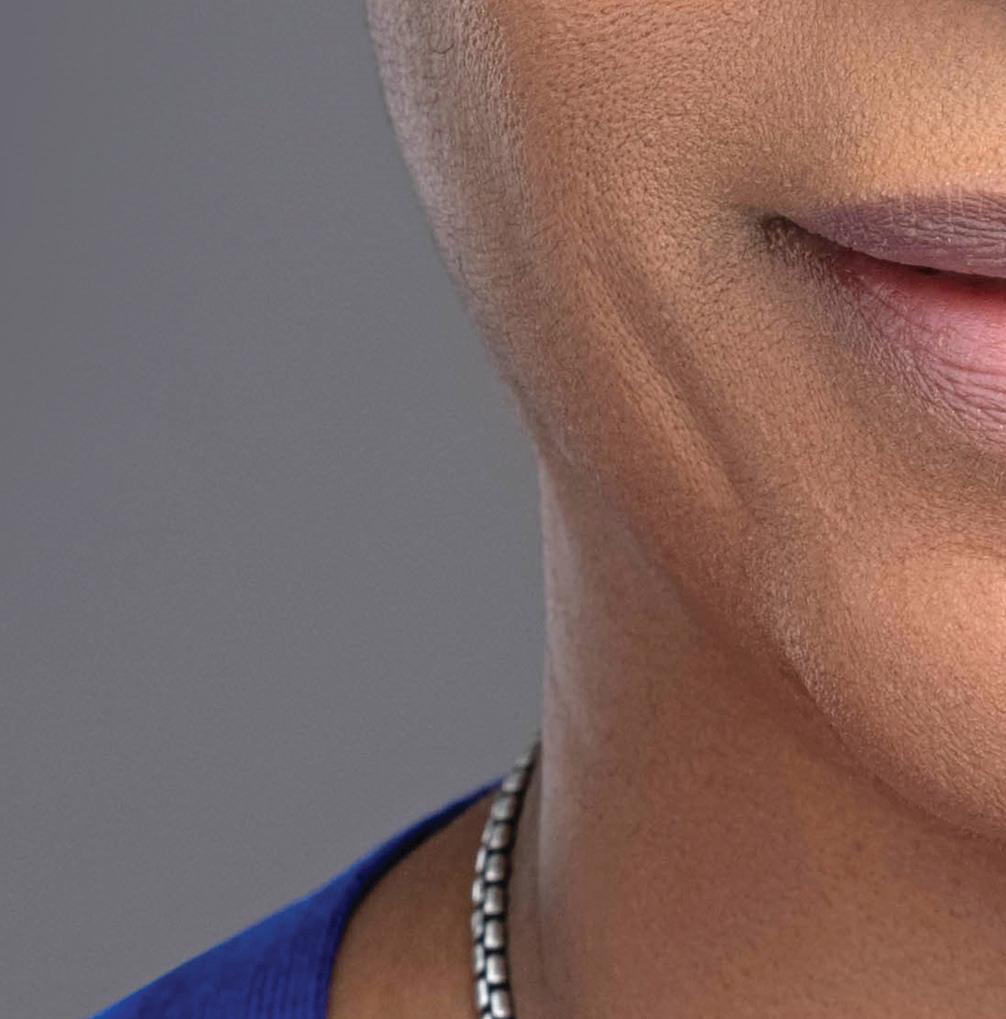

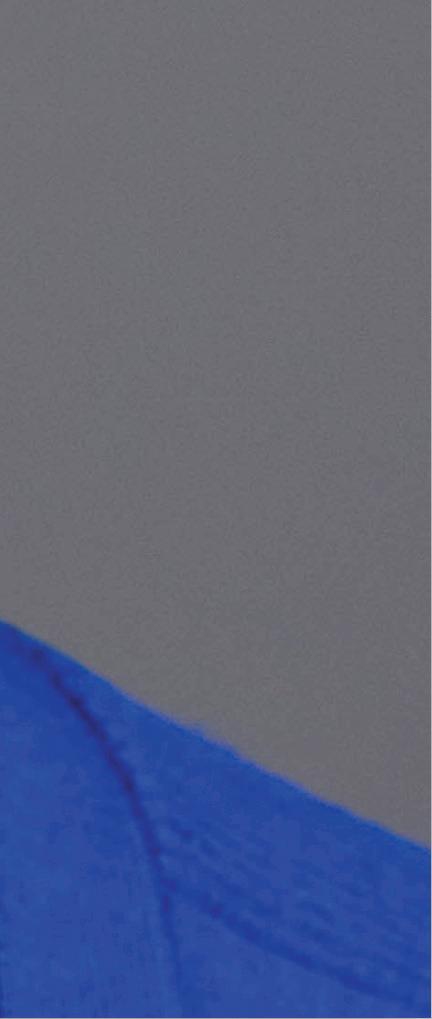

respected officials speak of her with overflowing reverence, that illuminates the life Violet Renice Palmer has led and the profession she has mastered.
“I think that Violet Palmer is arguably the greatest of all time,” Jones said. “And I say that not only because of her performance on the floor and the presence she exuded on the floor, but also her ability to get along with her partners. For her to excel in the NBA shows her social skills and her ability to connect and be supportive of her partners. I feel that she’s just the total package and the total package often is not as humble as we would like them to be. They are potentially brash and potentially standoffish and she is none of those things. So I think it’s just pretty incredible. She was raised right. She’s always talking about her mom and her dad.”
Kaye Garms, retired Western Athletic Conference supervisor of women’s basketball officials who was named the 2014 Naismith Women’s College Official of the Year, sees Palmer as a mover and shaker in the officiating field with limitless passion. Who knows? Had her knees not given out, Palmer might still be officiating today. But when those knees forced her to stop officiating, Palmer managed to reprogram herself and make an even more impactful contribution as a mentor.
“Violet has been a great inspiration and leader in her career as a women’s basketball official and coordinator,” Garms said. “She has shared not only her knowledge and her expertise about officiating, but more important, she has shown everyone what great


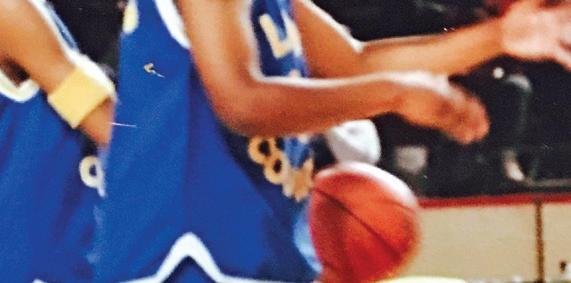
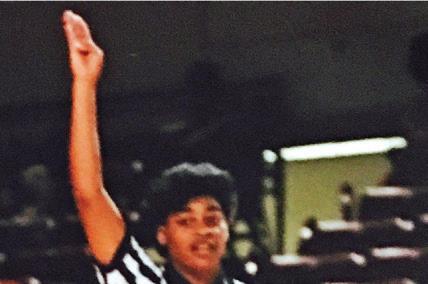
characteristics of a good person look like. Violet’s energy and attitude seem endless, her spirit is contagious and fun, and her life is a testament to perseverance, loyalty and triumph. I am so blessed to have met Violet Palmer.”
David Coleman, vice president of officiating for the Pac-12 Conference, said, “The manner in which she conducts herself in front of her officials is phenomenal. She literally has her people sitting on the edge of their chairs. It’s phenomenal how she commands the room and has their respect. Like any great leader, they follow her.”
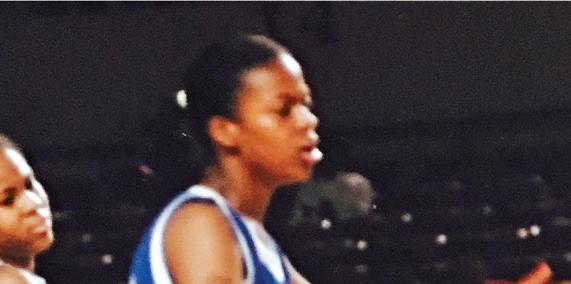
And to think her life’s journey could have swayed in

Which brings her story to James and Gussie Palmer, her parents who had so little money, yet had so much to offer their four kids, who were born between 1949 and 1971. They raised their children in a city long troubled by chronic crime and poverty. Yet Palmer has a way of filtering out the challenging memories from her childhood and focusing on something that serves as the foundation for the official she would one day become and the person she remains today. That’s just how she’s wired.
such a different direction in the simmering streets of Compton, where negative energy was such a part of the dynamic. Palmer concedes just that.
“I could have made one wrong move or been in one wrong place and anything could have happened to me,” she said. “But it never did because of those surroundings that my parents provided.”
In this instance, what she holds on to is the image of a well-maintained charming house with beige bricks on Culver Street that is surrounded by a white picket fence. That’s where James and Gussie raised their children with uncompromising love, support and discipline. They represented a symbolic eye of the hurricane with so much turmoil swirling around in that city. Palmer downplays the ugliness she saw as a child, but will speak in general terms of seeing what she suspected was an occasional drug deal going down. And she’ll volunteer that the Palmers’ TV was once stolen in broad daylight when the children were playing outside. That’s before James, who knew his neighborhood and surmised who took it, packed a pistol as a scare tactic and retrieved it
24 | REFEREE August 2023 GOLD WHISTLE AWARD
Before making her mark in the college and professional ranks, Violet Palmer honed her craft as a high school basketball official in the greater Los Angeles area.
“BEING THE GUARDIAN OF THE GAME AND CONTROLLING THE GAME — I LOVED IT I LOVED THE SCRUTINY I LOVED BEING YELLED AT AND I LOVED THAT WHEN YOU BLEW YOUR WHISTLE, EVERYTHING STOPPED ”
within hours. James died at the age of 88 in 2014, but he lives on in Palmer’s memory as a dedicated furnace operator for Ladish Pacific Division who lived paycheck to paycheck but never left his kids wanting.
The other half of this dynamic parenting duo was Gussie, who still lives in that Culver Street home as she approaches her 92nd birthday in July. It was in that welcoming home where Gussie would serve fried chicken, cornbread and rice and gravy to anyone in the neighborhood who was hungry. It was where she lovingly combed Palmer’s hair, even when her daughter was 12. Palmer’s siblings shared equally in that love and also grew into productive citizens. Joyce was a nurse for 35 years before retiring. Rod is an assistant basketball coach under Mick Cronin at national power UCLA. And Zandra, who was born in 1971 — 22 years after Joyce — is a retailer for Walmart. To this day, all four siblings and their mother live within 30
miles of each other in Southern California. Their bond is as firm as ever.
“I grew up poor, but my parents did such an amazing job of just showing us hard work, being a family and taking care of each other that I never knew I was poor until I was an adult and my father told me how much money he made,” Palmer said. “I never wanted for anything as a child. I was able to go to school. I grew up in a Baptist, God-fearing family, I did all my church activities and I was allowed to play sports as long as I maintained good grades and maintained being a nice young lady.”
That’s the environment that serves as the basis of the official Palmer would one day become. “I’ve always been a rules follower and maybe that’s why I became a referee,” Palmer said. But first came a memorable run as a player in high school and college, during which Palmer was nurtured by influential mentors who were also her coaches. At Compton
Violet Palmer spent 20 seasons as an onfloor NBA official (1997-2016), working games involving big names such as Michael Jordan, top right. NBA colleagues (bottom right, from left) Bill Kennedy, Tony Brown, Derek Richardson, Bennie Adams, Palmer, Tom Washington, Sean Corbin and Rodney Mott were on hand for her 2014 wedding to Tanya Stine.
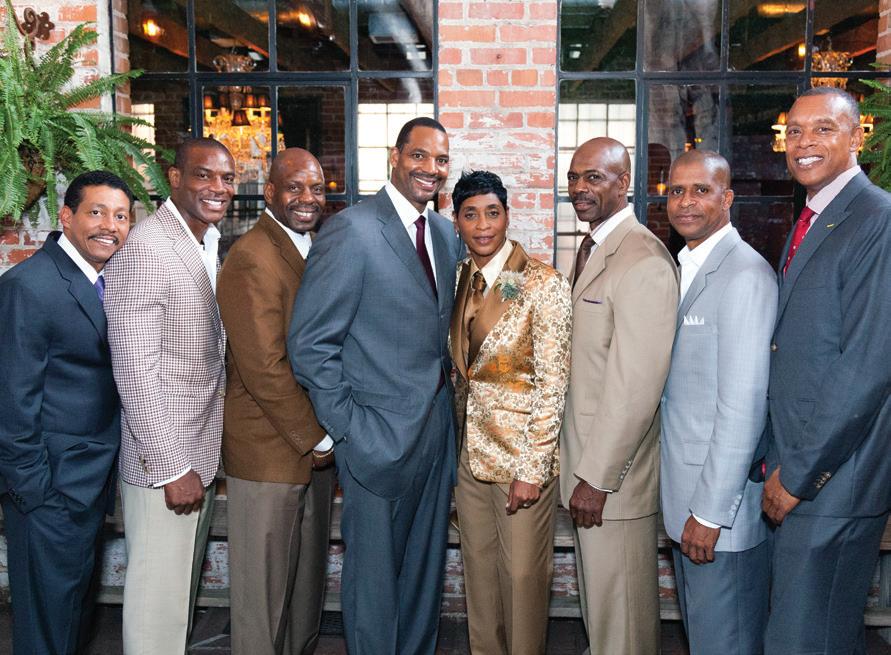
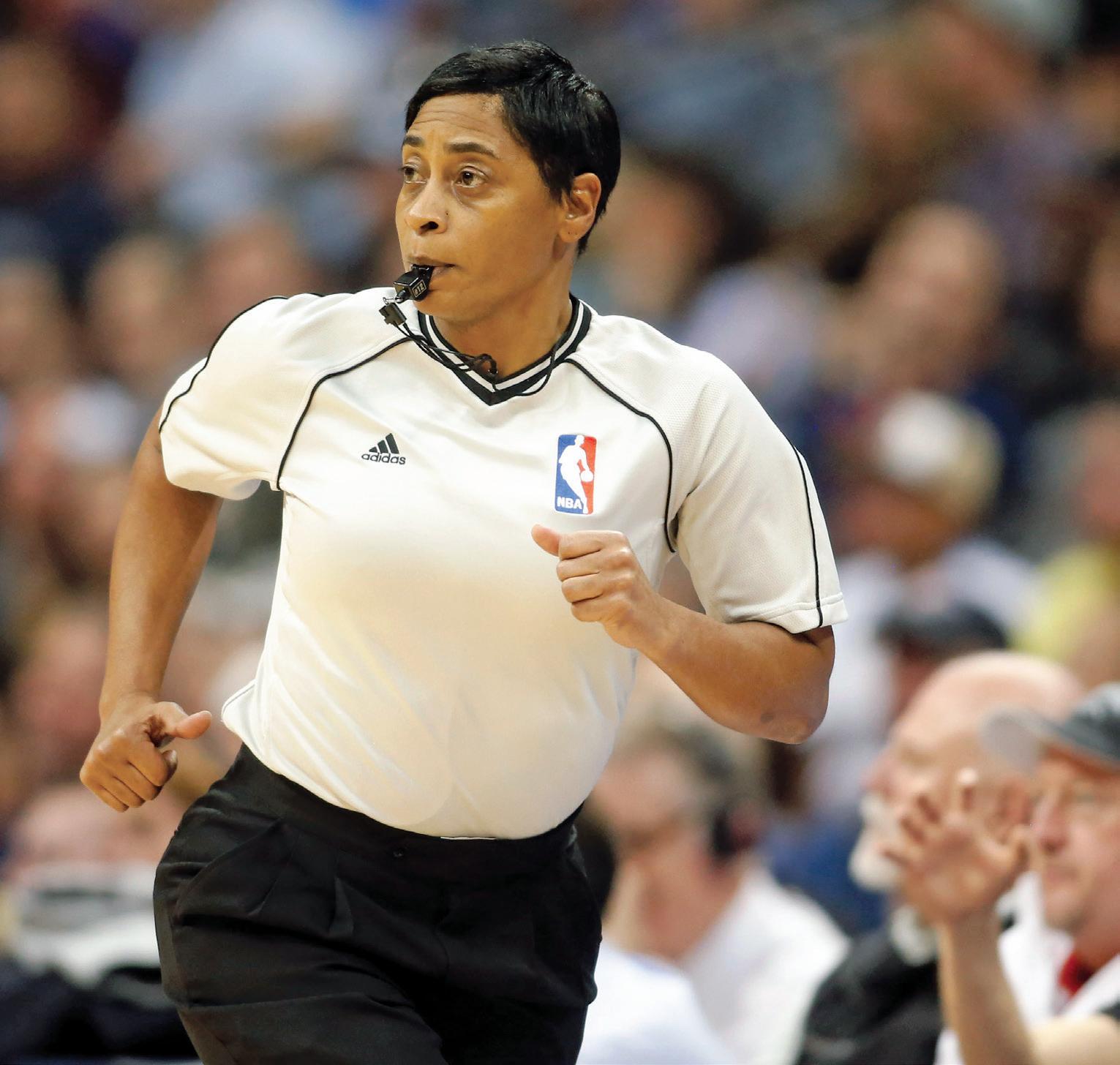
High School, it was Carolyn Montgomery, who made such an impact that Palmer has tried — unsuccessfully so far — to locate her and let Montgomery know just how much she meant to her.
“She was the first one to see that I was talented and that I could do well,” Palmer said. “To this day, I have not been able to get hold of her and it really hurts my heart. When I think about high school, I think about how incredible she was to help me. My high school coach and college coach were two women outside of my parents who were so instrumental in molding me and taking the time to give me that extra support.”
The late Darlene May, who led Cal Poly-Pomona to NCAA Division II championships in 1985 and ’86 with Palmer as her point guard, was perhaps even more influential. May, who died of breast cancer at the age of 56 in 1996, led the school to a record of 107-20 (45-2 in the California Collegiate Athletic Association) while Palmer was in the program. She also became
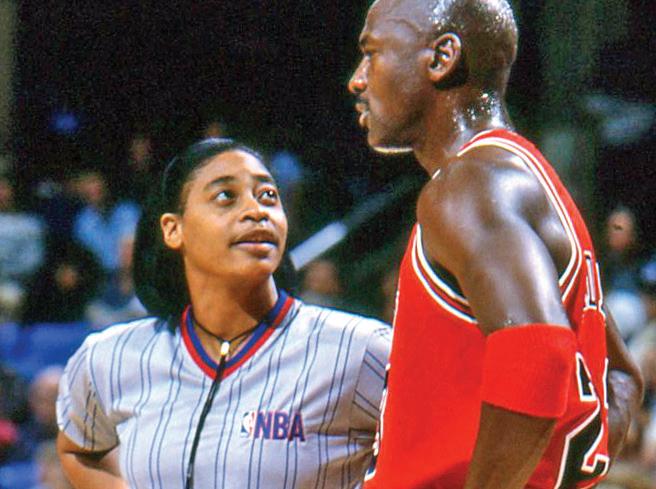 BRIAN SPURLOCK (VIOLET PALMER AND MICHAEL JORDAN); CHRIS HUMPHREYS-USA TODAY SPORTS
BRIAN SPURLOCK (VIOLET PALMER AND MICHAEL JORDAN); CHRIS HUMPHREYS-USA TODAY SPORTS
the first woman to officiate an Olympic women’s basketball game when she was a referee for the 1984 Summer Games in Los Angeles. Palmer later officiated with May and cherishes her influence more than a quartercentury after her death.

“She was the first person I saw visually — a woman who was actually officiating at a high level,” Palmer said. “With her being my coach and just her demeanor and her body language, she was a woman who exuded character and had integrity for the game. Just watching how she carried herself was such a great example for me. I’ll never forget that after I joined my high school association, I went back to Cal Poly and I went into her office. She said, ‘Well, a little tweety bird told me that you’re officiating now.’ And she said, ‘You have a lot of my characteristics when you’re out there refereeing.’”
That career started in the Placentia Recreation Department in Orange County while Palmer was still playing for May at Cal Poly-Pomona. A fortunate fluke it was. She was serving as a scorekeeper for a men’s adult basketball league and one day a referee assigned to work a game didn’t show up. “We always kept an extra shirt in the office, so I put a shirt on, went out and started refereeing,” she said. Palmer was a natural, as she was told that same night. “I called the director and told him I didn’t have a referee, so he called someone to get someone out. He showed up and he stood at the door and watched me. After the game, he said, ‘Have you ever thought about refereeing?’ And I said, ‘No! I’m still playing!’ He said, ‘Whenever you get finished playing, you might want to think about it because I think you’re a natural. You just understand it very well.’”
Palmer filed away that encouragement until after she graduated from college in
Family has always been a cornerstone in Violet Palmer’s life, including her wife, Tanya Stine, top; her mother, Gussie Palmer, left, who still lives in the family home in Compton, Calif.; and clockwise from bottom right, father, James; mother, Gussie; and siblings Joyce, Zandra and Rod.
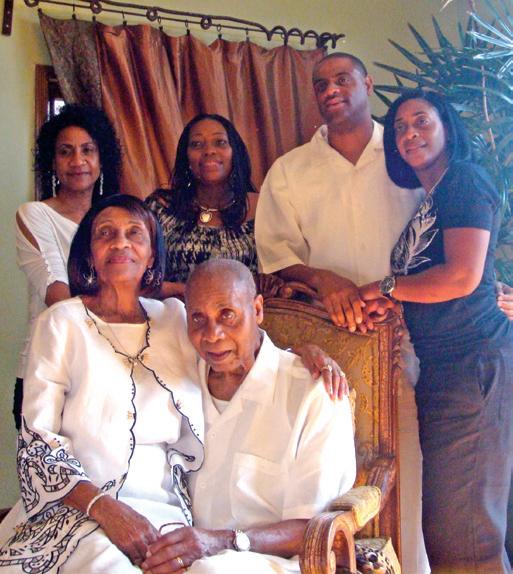
1987. She still yearned to play but had no interest in heading overseas. Furthermore, the WNBA was nine years into the future. Officiating was just the outlet Palmer needed, she was destined to discover. As a recreation director in Los Angeles, Palmer occasionally stepped in to officiate. She also took on some high school girls’ games. By 1993, she was working the first of five consecutive NCAA Women’s Final Fours, which included two championship games. What a career ascent it was, but Palmer was that good. She has a knack for officiating and the mechanics involved. What’s more, she was fearless. No way was anyone going to intimidate her. She had long ago come to understand that in the streets of Compton.
“Being the guardian of the game and controlling the game, I loved it,” she said. “I loved the scrutiny, I loved being yelled at — it didn’t bother me — and I loved that when you blew your whistle, everything stopped. I never, ever doubted myself one bit. Every goal that I set out to accomplish in officiating, I did it. But I did it with hard work.”
That’s how James and Gussie raised their daughter and the payoffs kept coming. She was named a WNBA referee starting with the league’s first season in 1997. That same season, she

was offered with Dee Kantner the opportunity to become the first female officials to work in the NBA. Women officiating in the same league as Michael Jordan and Kobe Bryant was all but unthinkable at the time. Her detractors expected her to fail, yet they were eventually muted by her skill and professionalism. That doesn’t mean she wasn’t terrified. On the evening of Oct. 31, 1997, when a 33-yearold Palmer worked her first NBA game between the thenVancouver Grizzlies and Dallas Mavericks in Vancouver, Rod Thorn, then the league’s vice president, was on hand to analyze her every move. To a similar degree, so were the 17,021 fans at General Motors Place. Just who was that woman in the striped shirt running the floor with fellow officials Bill Oakes and Mark Wunderlich?
“I was scared out of my wits and I thought I was going to pee myself,” Palmer said. “It was the nerves you have as a player when you’re playing in a big game. I was on the big stage and I knew the world was watching me. And I knew they were expecting me to fail, but I was not going to fail. It was not going to happen.”
Thorn left that game feeling the decision to bring in Palmer was the right one. While Kantner has enjoyed an illustrious career
26 | REFEREE August 2023 GOLD WHISTLE AWARD
in officiating, she was out of the NBA in 2002. Palmer stayed on until 2016, when her ailing knees forced her to retire. She actually ended up working more NBA games (about 1,000 in her estimation) than college assignments (about 800).
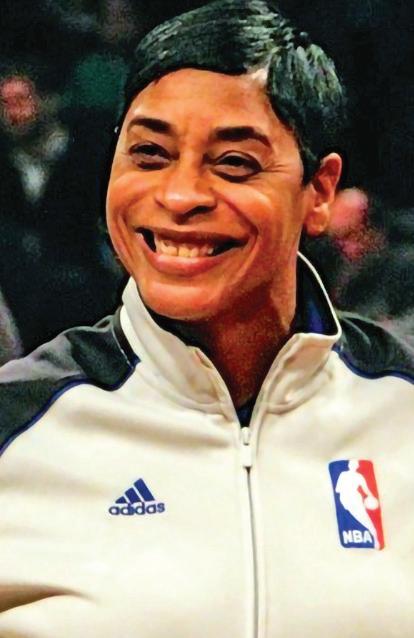
“You’ve got to prove yourself and it’s not always easy to do,” Thorn said. “There are obviously things you’ve got to learn as you go along, but I thought she was good from the start. What Violet always had was she knew how to talk to people. Whether it was players or coaches, she knew how to communicate. Even when she was earning her stripes, she always had that. Another thing about her that, to me, was extraordinary, was people respected her. They respected the way she carried herself, they respected the way she handled herself on the floor. Over the course of time, she became a very good referee.”
Trust retired NBA referee Bob Delaney when he says Palmer could hold her own with any of her male counterparts while working games. His respect for her is just as great when he speaks of Palmer off the court. An enduring example was in 2022, when she was among the officials visiting
Tony Brown, who was battling pancreatic cancer. He died Oct. 20, 2022, at the age of 55.
“She has a great smile,” Delaney said. “I saw that on display in airports, car rentals, hotel lobbies and walking into NBA arenas, yet this memory speaks volumes. It was when Violet, Rodney Mott and Bennie Adams traveled from California to visit our fellow referee Tony Brown in hospice. We happened to pull into that Atlanta parking lot at the same time and, upon entering Tony’s room, we spent time laughing and telling stories. Violet underlined her love and concern for her teammates as she sat next to Tony’s hospital bed. Teamwork and trust are two words NBA referees speak about from a professional perspective. Violet lives them in every aspect of her life.”
Palmer, who has transitioned into the role of women’s basketball officiating coordinator of the Pac-12, West Coast, Western Athletic, Big Sky and Big West conferences, uses her extraordinary people skills in her new role. Palmer is, quite simply, someone people tend to remember.
Danielle Bishop, coach of Cal Poly-Pomona, says Palmer has been a consistent source of inspiration for her team during visits to her alma mater.
“What she’s done for me and our players is she just really helps you believe in yourself,” Bishop said. “She kind of empowers you where you just thrive being around her and hearing her talk. She’s extremely busy, but she always takes time to remember where she came from.”
Ally Spooner, whose father, Bill, was a longtime NBA official, has enduring memories of Palmer that go beyond officiating.
“When I was a kid and my dad would bring me to his NBA games or referee camps where Violet was in attendance,
The Gold Whistle Award

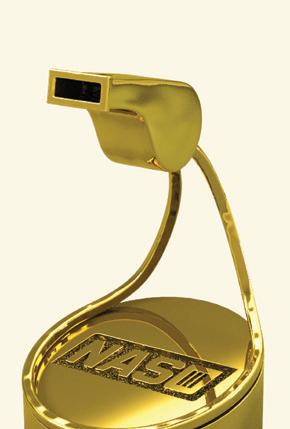


was created by the NASO board of directors to honor an individual or organization that has gone above and beyond in overall integrity and has made significant contributions to the betterment of o ciating. The Gold Whistle is among the most coveted awards in the world of sports o ciating. To be selected as the award recipient by the NASO board of directors, consideration is given for:
• Significant contributions to the betterment of o ciating.
• A high degree of integrity and ethics.
• Qualities that are held in high regard by the industry.
• Consistent record of presenting o ciating in a positive light.
• Exhibiting a “service above self” attitude. Public service to o ciating, having a motivating e ect on others and/or strong community involvement are considered.








The award can be made posthumously.
she would always make it a point to spend time with me,” Spooner said. “She would ask me questions about my sports, ask me about school and always show me a kind of ‘girl power’ type of consideration. As I grew up, she continued to support me and even my teams, always making the time for me or going out of her way to keep up with my latest endeavors and aspirations. My dad still shares with me when he connects with her that she asks him without fail, ‘And how’s my girl?’”
Spooner’s story illustrates why Palmer has so much more to give to officiating nearly eight years after she worked her final game. She genuinely cares about people. She embraces the challenge of helping them become the best they can be in officiating. And she doesn’t even want to think about not carrying on indefinitely, which bodes well for the future of officiating.
For Palmer, her journey is far from complete. She still has so much more to give.
“I was one of those straightlaced kids. I never would do anything wrong,” Palmer said. “I was the kid who always wanted to do right and help somebody. I always wanted my parents to be proud. And I think I have lived my life like that to this day. That has been instilled in me to this day and I’ve always wanted to give back.
“I was one of those who had all these wonderful things happen to them and, now, looking at my life and being a mentor and a trainer and a teacher and a developer, that’s where I find my joy. That’s why I’m a coordinator for officials. I just love the women’s Final Four and to watch my young referees get to that platform. You would have thought that I birthed those referees, because they’re like my kids. I get so much enjoyment seeing them accomplish the goals that they set for themselves.”
that
Jackel, Racine, Wis., is an award-winning sportswriter.
Peter
REFEREE August 2023 | 27
ISAIAH DOWNING
ONE AND ONE? DONE AND DONE
NFHS Changes Free-Throw Awards, Frontcourt Throw-ins
By Scott Tittrington
Aftera few offseasons of relatively small alterations to the rulebook, the NFHS Basketball Rules Committee opted for significant changes for the 2023-24 season during its annual April meeting in Indianapolis.
The committee, and subsequently the NFHS Board of Directors, approved seven rule changes, highlighted by the elimination of “one-and-one” bonus free throws and an accompanying foul reset each quarter, and the adoption of new frontcourt throw-in procedures following fouls and violations.
Referee thanks Lindsey Atkinson, NFHS director of sports and staff liaison to the rules committee, for reviewing this information, which appears in perceived order of importance.
Bonus Free Throws (4-8-1)
The traditional “one-and-one” bonus that has been a staple of high school basketball for decades is no more. The NFHS will now follow the model implemented at the NCAAW level in 2015 that awards two free throws on all common fouls, except for a player-control or team-control foul, beginning with the fifth team foul in each quarter. As such, team fouls will be reset to zero at the end of each quarter.
The committee’s rationale for the rule change is multi-faceted. It is believed the game will have a better
The one-and-one bonus free-throw situation, as illustrated here by Tisha McAfee, Long Beach, Calif., is no longer part of the NFHS rules code. The NFHS Basketball Rules Committee voted to change free-throw awards to two shots for all common fouls beginning with the fifth team foul of each quarter.
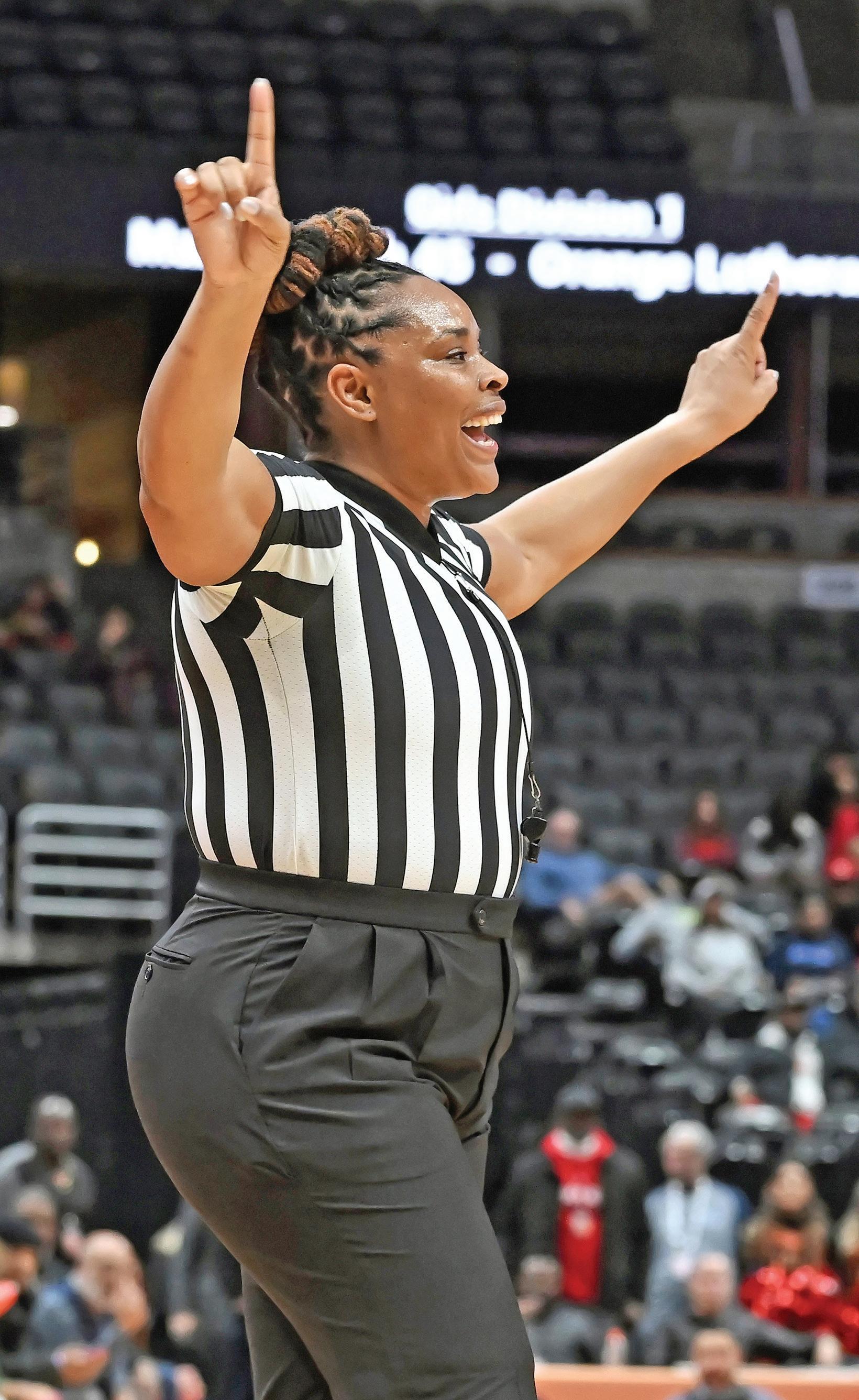
BASKETBALL RULES, MECHANICS, PHILOSOPHY 28 | REFEREE August 2023 EDITOR: SCOTT TITTRINGTON stittrington@referee.com
HESTON QUAN
flow by allowing teams that run into early foul trouble in each half the opportunity to self-correct their style of play at the outset of both the second and fourth quarters and not have the bonus immediately come into play. By eliminating the one-andone, the number of opportunities are significantly reduced for correctable errors that result from awarding an unmerited free throw or failing to award a merited free throw. Finally, the guarantee of two free throws eliminates the physical play that has often been associated with rebounding action on the first free throw.
Play 1: Late in the first quarter, A1 is dribbling the ball on the perimeter when B2 is whistled for a hand-checking foul. It is team B’s fifth foul of the first quarter. Ruling 1: A1 is awarded two free throws, with play resuming from the result of the second free throw.
Play 2: At the end of the first quarter, team A has three team fouls and team B has six. Early in the second quarter, A1 and B2 are battling for a rebound near team B’s basket, and the officials rule a pushing foul on B2. The teams begin to line up at team A’s basket to shoot free throws. Ruling 2: The team fouls reset at the end of the first quarter. This is the first team foul against team B in the second quarter. Team A is entitled to a designated-spot throw-in in the backcourt nearest the spot of the foul.
Play 3: Team A has committed six team fouls in the fourth quarter. A1 drives to the basket, makes contact with B2 and is assessed a player-control foul. Because it is the seventh team foul against team A in the quarter, B2 walks to the free-throw line in anticipation of shooting two free throws. Ruling 3: The foul committed by A1 is a player-control foul. Free throws are never awarded on player-control or team-control fouls. Team B is entitled to a designated-spot throw-in in the backcourt nearest the spot of the foul.
Play 4: Team B has committed four team fouls in the fourth quarter. A1 drives to the basket and is fouled after becoming an airborne shooter and makes the try. Ruling 4: This is team B’s fifth team foul of the quarter.
However, A1 is awarded only one free throw because the foul occurred during the act of shooting and the try was successful.

Play 5: The score is tied, 60-60, at the end of the fourth quarter. Each team has committed four team fouls. Soon after team A wins the jump ball to start overtime, A1 is dribbling the ball up the court when B2 commits a common foul. Ruling 5: The extra period is an extension of the fourth quarter; therefore, the team fouls do not reset. This is the fifth team foul by team B and A1 is awarded two free throws, with play resuming as a result of the second free throw.
Resumption of Play Procedure, Throw-ins (7-5-2, 7-5-3, 7-5-4, 7-4-5 NEW)
No longer will officials be tasked with determining the exact throw-in spot when play is going to resume in the frontcourt following a violation, common foul or the ball becoming dead. Instead, the NFHS is taking a page out of the NCAAM/W rulebook and adopting four designated spots for these throw-ins. Those spots are either the nearest 28-foot mark along each sideline or the nearest spot three feet outside the lane on the endline.
The basis for determining whether these types of throw-ins are from the sideline or the endline will not change, as they remain closest to the spot where the violation or foul occurred. The only change is each of these throw-ins will occur at one of those four designated spots. Also, when the ball simply goes out of bounds as described in rule 7-1-2 (touched by a player who is out of bounds; touches any other person, the floor or any object that is on or outside a boundary; touches the supports or back of the backboard; touches the ceiling, overhead equipment or supports), that throw-in spot remains the exact location where the ball became dead.
The rationale for the rule change is it will allow teams to develop throw-in plays both offensively and defensively from four pre-determined locations, and eliminates much of the judgment for an official about where exactly the throw-in spot should be located.
DID YOU KNOW?
The last time the NFHS tweaked its rules regarding the awarding of free throws related to team fouls prior to the newly instituted rule change eliminating one-and-one bonus free throws on the seventh team foul of the half. A rule change prior to the 1995-96 season mandated the one-and-one bonus on the seventh, eighth and ninth team fouls, and two shots on the 10th team foul and thereafter.
SIDELINE
Bodycams Come to EuroLeague
Sports fans watching the EuroLeague Final Four, Europe’s top-tier basketball competition, in May were able to get a view as close to the players in action as the referee gets.
For the first time, referees at the EuroLeague’s semifinals and finals were each wearing an AI-powered lightweight bodycam developed by Israeli sports startup MindFly. The bodycams are designed to capture a fully immersive game experience that provides video and audio streams in an effort to reproduce the feeling of a fan being on the court itself.
The clips created via the bodycams were uploaded to the EuroLeague’s official website and distributed on social networks after the games, played May 19-21 in Kaunas, Lithuania.
SOURCE: TIMESOFISRAEL.COM
THEY SAID IT
“The way he put it was quite interesting. (They’ve) selected three people out of a choice of 5,000 referees. That kind of lets you know just how difficult it is to get in that.”
– Scott Knouse, Pennsylvania Interscholastic Athletic Association basketball official, about getting the call from Pat Gebhart, PIAA director of officials, to work this year’s Class 4A girls’ state championship game
SOURCE: YORKDISPATCH.COM
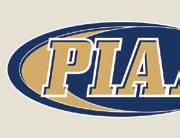
REFEREE August 2023 | 29
1995
TEST YOURSELF
In each of the following, decide which answer or answers are correct for NFHS, NCAA men’s and NCAA women’s rules, which might vary. Solutions: p. 81.
1. A school’s logo may appear on all of the following parts of a player’s clothing, except which?
a. Shorts.
b. Compression shorts.
c. Jersey.
d. Undershirt.
e. Headband.
2. All of the following is true of basket interference, except which?
a. When reaching through the basket from below, it is basket interference if the ball is touched when it is on the cylinder.
b. When reaching through the basket from below, it is basket interference if the ball is touched when it is above the cylinder.
c. When reaching through the basket from below, it is basket interference if the ball is touched before it enters the cylinder.
d. When reaching through the basket from below, it is basket interference if the ring is touched when the ball is above the cylinder.
3. Which is true of the color of the team’s shorts?
a. A perceptible majority of the game shorts must be the color of the neutral zone of the jersey.
b. The game shorts must be the same color as the torso of the jersey.
c. The shorts may be any color.
d. The shorts may be white, black, beige or the color of the torso of the jersey.
4. All of the following are true of thrower-in A1 while A1 is holding the ball, except which?
a. A1 is in player control.
b. Team A has team control.
c. A1 may be called for a traveling violation.
d. A1 may dribble, stop dribbling and dribble again.
5. An airborne shooter is considered to be in the act of shooting until which of the following?
a. The player first jumps to attempt the try.
b. The ball is no longer in the shooter’s hand(s).
c. After the first foot returns to the playing court.
d. Only after both feet return to the playing court.
Due to an NFHS rule change for 2023-24, if there is a designated-spot frontcourt throw-in caused by a foul or violation, the throw-in spot will be the nearest of the four designated spots shown in the MechaniGram: either the 28-foot line along either sideline or the threefoot spot outside the lane along the endline.
Play 6: A1 is dribbling the ball in the frontcourt outside the threepoint arc in front of her team’s bench when she is fouled by B2. It is team B’s fourth team foul of the quarter. Ruling 6: Team A is awarded a frontcourt designated-spot throw-in at the 28-foot mark on the table side of the floor.
Play 7: While holding the ball on the wing opposite the table in the frontcourt, A1 attempts to make an entry pass to teammate A2 on the low block. B3, who is standing between the lane line and the three-point arc, sticks his leg out and makes contact with the ball and is whistled for a kicking violation. Ruling 7: Team A is awarded a frontcourt designated-spot throw-in three feet outside the lane on the endline, opposite the table.
Play 8: A1 is dribbling the ball in the backcourt when B2, standing in the frontcourt opposite the table between the lane line and three-point arc, is whistled for a foul for holding A3. Ruling 8: While the ball was in
the backcourt when the foul was committed, the ensuing throw-in for team A takes place in the frontcourt because of the location of the foul. Because it is a frontcourt throw-in resulting from a foul, it must go to one of the four designated spots — in this instance, three feet outside the lane line opposite the table.
Play 9: A1 is dribbling the ball in the backcourt opposite the scorer’s table near the division line. A2 steps into the backcourt to set a screen on B3 to free up A1. The trail official rules an illegal screen on A2. Ruling 9: While the ball was in team A’s backcourt when the foul was committed, the ensuing throw-in for team B takes place in its frontcourt because of the location of the foul. Because it is a frontcourt throw-in resulting from a foul, it must go to one of the four designated spots — in this instance, the 28-foot mark opposite the scorer’s table.
Play 10: A1 is dribbling the ball in the backcourt when A2 and B3,
HOME VISITOR SCORER & TIMER
BASKETBALL 30 | REFEREE August 2023
standing in the frontcourt outside the three-point arc opposite the table, are whistled for a double foul. Ruling 10: Following double personal fouls, play resumes at the point of interruption. Team A is awarded a designated-spot throw-in the backcourt nearest the spot of the ball.
Play 11: A1 is in the backcourt and throws a long pass down the sideline toward A2. B3 steps in front of the pass and catches it with one foot on the sideline, five feet away from the endline. Ruling 11: Team A is awarded a designated-spot throw-in at the location where B3 caused the ball to go out of bounds.
Throw-in Administration (7-6-6)
When an official administers a throw-in to the wrong team, the officials may now rectify the mistake if it is recognized at any time before the first dead ball after the ball becomes live, unless there is a change
in possession. Prior to the rule change, the officials only had until the end of the throw-in to correct the mistake.
The change allows a more reasonable timeframe for the officials to make the correction. However, this correction is not, by definition, a correctable error.
Play 12: Team A has a designatedspot throw-in. Before the throw-in begins, team B requests a timeout. After the two teams return to the floor following the conclusion of the timeout, the trail official administers the throw-in to B1. The officials notice their mistake (a) while B1 is holding the ball, (b) while B1’s inbound pass is airborne but not yet caught by B2, (c) after B2 catches the inbound pass and starts to dribble toward the team B basket, (d) after the inbound pass is intercepted by A3, (e) after B2 catches the inbound pass and scores a goal, or (f) after B2 catches the inbound pass and is fouled by A3. Ruling 12: In (a),
(b) and (c), the officials may correct their mistake, stop play and award the throw-in to team A. In (c), the officials also should reset the game clock if they have definite knowledge about the time on the clock when the throwin was administered. In (d), because there was a change in possession and the correct team gained possession before there was a dead ball, the mistake is ignored. In (e) and (f), the dead ball created by the goal and/ or the foul closes the window for the mistake to be corrected and play continues from that point.
Out of Bounds (9-3-3)
Any player who steps out of bounds under the player’s own volition shall not be the first player to touch the ball after returning to the playing court. This is a violation. It is also a violation if a player intentionally steps out of bounds to avoid a violation.
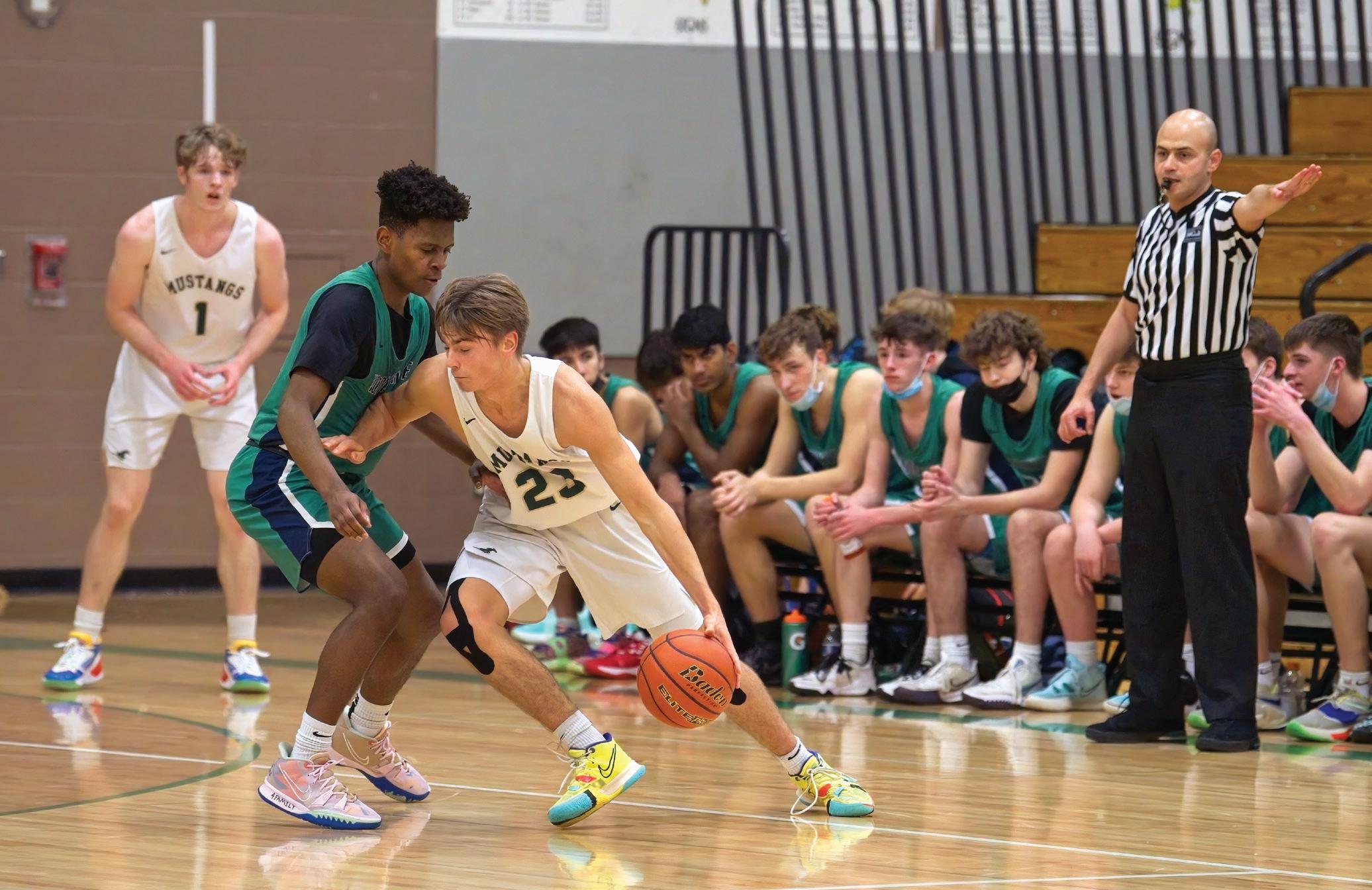
REFEREE August 2023 | 31
Amr Elebiary, Sammamish, Wash., needs to recognize starting with the 2023-24 season, NFHS rules allow players wearing the visiting team dark jerseys to wear black undershirts. All players choosing to wear undershirts must wear matching undershirts.
DALE GARVEY
CASEPLAYS
Defending Cutter Through Lane Play: Offensive player A1 is located on one side of the lane and begins to make a move to the other side of the lane as part of team A’s offensive play. Defender B2 jumps to a position in the lane a half-step in front of A1 while facing A1 with two feet on the floor. A1 then makes contact with B2, which is enough contact to cause B2 to fall to the floor. Shall a foul be assessed, and if so, to whom? Ruling: To establish legal guarding position on a moving player without the ball, the guard shall give the opponent time and distance to avoid contact, and that distance need not be more than two strides. When defender B2 jumped in front of cutter A1 that close to A1, B2 did not provide A1 time and distance to avoid contact, and a blocking foul shall be assessed to B2 (NFHS 4-23-5; NCAAM 4-17.5; NCAAW 10-4.5).
Technical Foul After Timeout Play: Team A is granted a timeout. As A1 is walking toward the bench, A1 makes a derogatory comment to an official, who assesses a technical foul to A1. What sort of technical foul is charged and to whom? Ruling: A player is one of the five team members legally on the playing court to participate. They retain player status during a timeout. Therefore, the foul is a player technical (NFHS), Class A technical charged to the player (NCAAM), or a player/substitute technical (NCAAW) and counts toward the bonus, but is not charged to the head coach (NFHS 4-34-1, 10-46a, 4.34.1; NCAAM 3-1, 10-3-1a; NCAAW 3-1, 10-12.3.a.1).
Stepping on the Semicircle Line
Play: A1 is at the free-throw line and is holding the ball for the first of two free throws. Prior to releasing the ball for the free throw, A1 takes a few steps backward and steps on the semicircle line. Does this result in a violation?
Ruling: Yes. The free-throw shooter shall not have a foot break the vertical plane of the semicircle line (NFHS) or leave the semicircle (NCAAM/W) before the try contacts the ring, flange or backboard or before the free throw ends. When A1 stepped on the semicircle line, the result is a free-throw violation (NFHS 9-1-3e; NCAAM/W 9-1.1.d).
Prior to the rule change, any player who stepped out of bounds under the player’s own volition had committed a violation. However, officials often ignored such activity because it had no effect on the play. This tweak now stops the game and takes away a possession from the offensive team only when an advantage is gained by the player intentionally going out of bounds. The change also now mirrors the NCAAM/W rule.
Play 13: Team A has the ball in the frontcourt. While A1 is dribbling, A2 sets a screen near the endline for teammate A3, who runs out of bounds to get around it. A1 passes the ball to A3, who has returned to the playing court and is standing open in the corner beyond the three-point arc. Ruling 13: This is a violation on A3 for being the first to touch the ball after returning to the playing court.
Play 14: Same scenario as play 13, however, when A1 makes the pass to A3, B4 is able to get a hand on the ball and deflect it. A3 chases down the loose ball and is the first player to touch it following B4’s deflection. Ruling 14: So long as A3 had returned to the playing court prior to the deflection, this is a legal play. If A3 was still out of bounds when B4 deflected the ball, A3 would be guilty of a violation for the first touch after returning to the playing court.
Play 15: A1 is in the lane in the frontcourt. A1, recognizing that a three-second violation is imminent, steps across the endline and out of bounds unforced in an attempt to avoid the violation. Ruling 15: This is a violation on A1 because A1 stepped out of bounds on purpose to avoid the three-second violation.
Team Members’ Equipment, Apparel (3-5-6)
Team members now have a new color option when it comes to their undershirts when they are wearing their visiting team dark jerseys. If worn, undershirts may now be solid black or a single solid color similar to the torso of the jersey. Team members may wear either color, but everyone must match.
The rationale for the change is undershirts matching certain dark
jersey colors like maroon and purple are not easy to find or are expensive, while black is consistent with other apparel requirements such as headbands, sleeves and tights.
Play 16: A1, A2, A3 and A4 are all wearing black undershirts under their purple jerseys. A5 is wearing a purple undershirt. Ruling 16: Upon discovery, the officials shall inform the head coach the players may wear either black or purple, but not both.
Play 17: Team A is the visiting team and is wearing maroon jerseys. Team B is the home team and is wearing white jerseys. A1 is wearing a black undershirt and no other team members are wearing undershirts. The entire team B roster is wearing black undershirts as well. Ruling 17: A1 is wearing a legal undershirt. All team B players are wearing illegal undershirts as team B is the home team and is wearing the designated white jerseys.
Uniforms (3-4-5)
Teammates may wear multiple styles of uniform bottoms including shorts, skirts or pants, so long as they are like-colored. Not all team members need to wear the same style. However, all styles must meet uniform legalities related to visible manufacturer logos and trademarks.
Play 18: A1, A2 and A3 are wearing shorts. A4 is wearing a pleated skirt. A5 is wearing pants. All five are wearing the same shade of green. Ruling 18: All of these uniform bottoms are legal.
Game and Table Officials (2-1-3 NOTE)
In states where a shot clock is used, the shot clock operator shall be located at the scorer’s and timer’s table.
The rationale is this allows the officiating crew to quickly identify the person who is operating the shot clock should there be a timing error compared to if the operator is located somewhere else in the gym. Scott Tittrington is an associate editor at Referee. He officiates women’s college and high school basketball, college and high school baseball and high school football.
BASKETBALL 32 | REFEREE August 2023
Don’t Become a Second Trail
One of the toughest things for officials new to three-person mechanics to learn is proper court positioning as the center or “C” official.
Think about it: You spend all of your formative years working two-person mechanics where the trail official has a wide swath of real estate and responsibility to worry about. In order to keep the ball and players boxed in and try to develop the best angles possible, you spend the majority of your time between the three-point arc and the division line.
Not so as a center official. The base starting point should always be along the sideline at the freethrow line extended, as shown in the MechaniGram. This puts the center official in the perfect position to look through plays developing in the free-throw lane, to be able to
make a one-step position adjustment toward either the division line or endline should the ball swing to an offensive player in your immediate proximity, and to take a strong closed-down position once a try goes up and the need develops to officiate rebounding action.
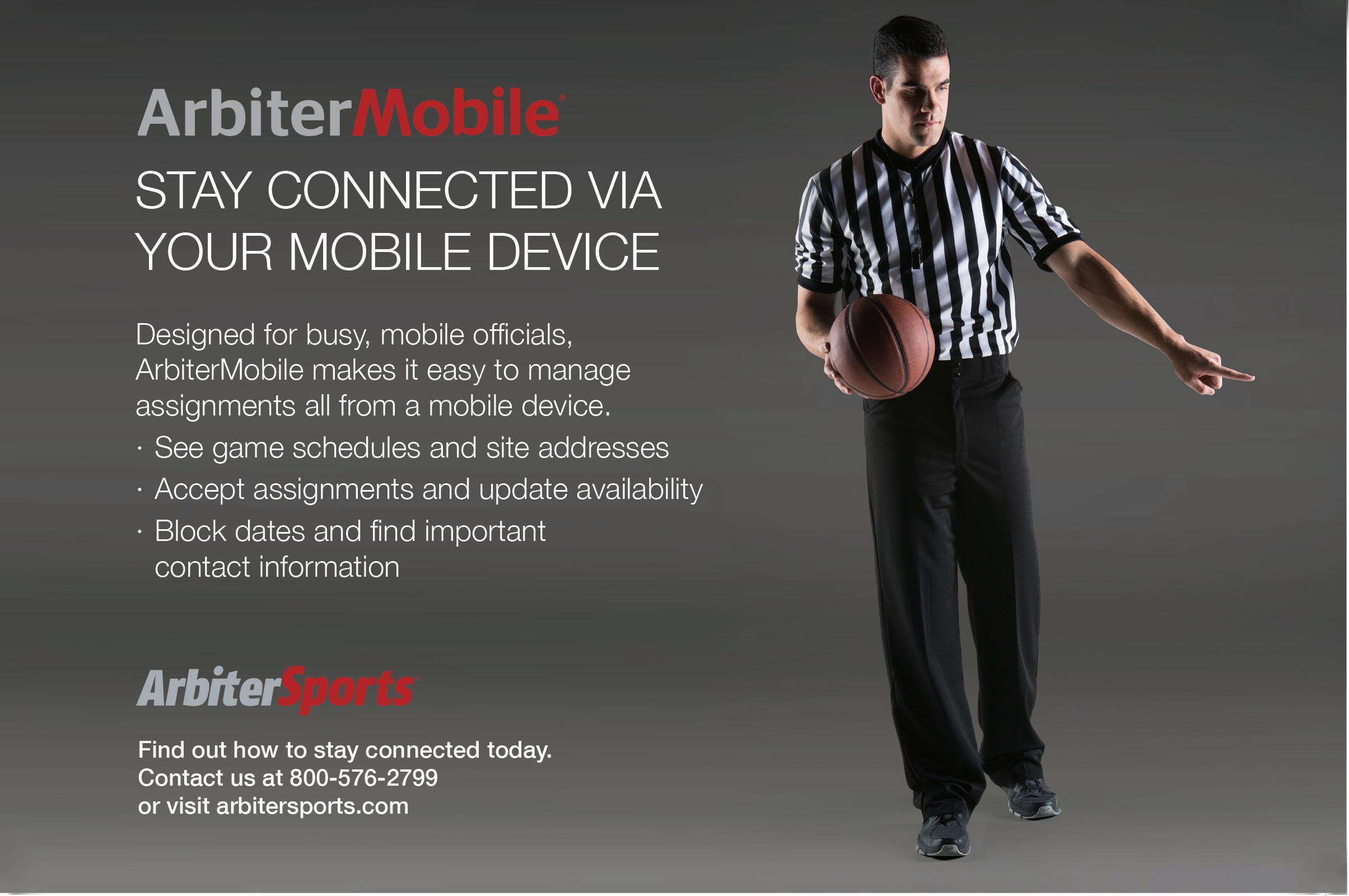
The benefits of a threeperson officiating crew are lost if two officials are too high in the frontcourt, creating a two-trail situation. The angles for viewing plays near the free-throw line are not as good and added stress is placed on the lead official to help monitor activity that should be in the center official’s primary coverage area.
The only time a center official should be in the “not here” position in the MechaniGram is if the ball settles in the primary coverage area on the center’s side of the floor,
necessitating the C to initiate a rotation and become the new trail official, at which point the lead official will rotate to that side of the floor and the old trail official will then drop down into the appropriate center position.
HOME
& TIMER C T L HERE NOT HERE C
VISITOR SCORER
Eh?
POUTINE RUSH

Alright Canada, we’ll let you have credit for poutine, paint rollers and the whoopie cushion — but we’re throwing the red challenge flag on claims involving replay.
If you’ll recall, a commercial by Canadian whisky brand Crown Royal debuted during the Super Bowl and made numerous claims about things for which we can “thank Canada.”
By Brent Killackey
The Foo Fighters’ Dave Grohl, a musician who is not Canadian but apparently has an appreciation for our neighbor to the north and starred in the ad, opened our eyes to many products, well-known celebrities and other things that have Canadian origins. Grohl outlined Canadian contributions such as peanut butter, Hawaiian pizza, Walkie Talkies, football (which owes some of its early rules
development to a Canadian university) and, the one that most caught our eye, replay.
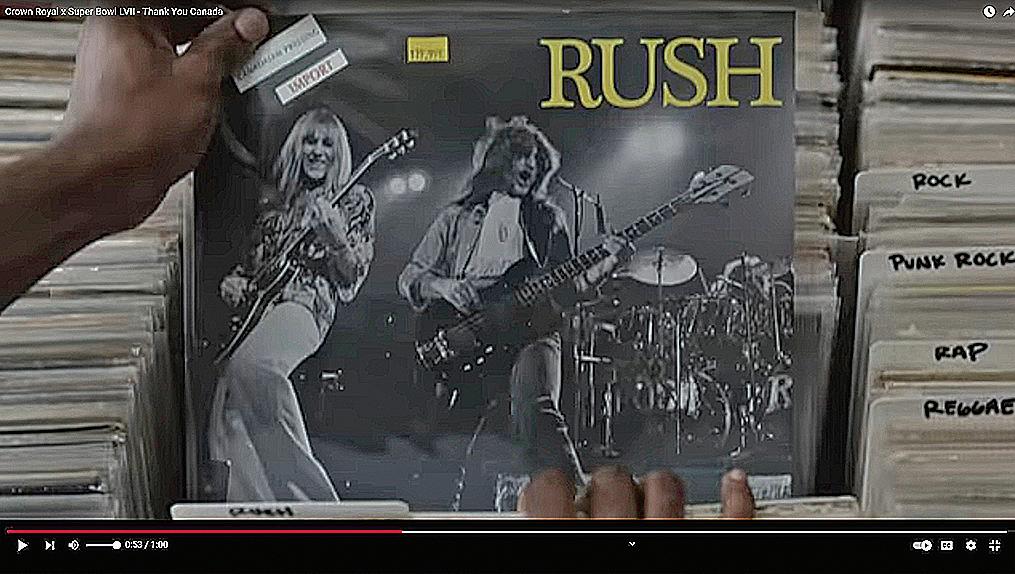
The ad showed an official in a black-and-white striped shirt with a headset (and an adjustable hat … ugh) going “under the hood” for an instant replay review. The voiceover stated: “Thank you for creating the replay.”
Hold on a sec! Isn’t Art McNally, who was born in
34 | REFEREE August 2023
We’ll acknowledge poutine, Rush and egg cartons as Canadian, but not so fast on replay.
EGG CARTONS REPLAY
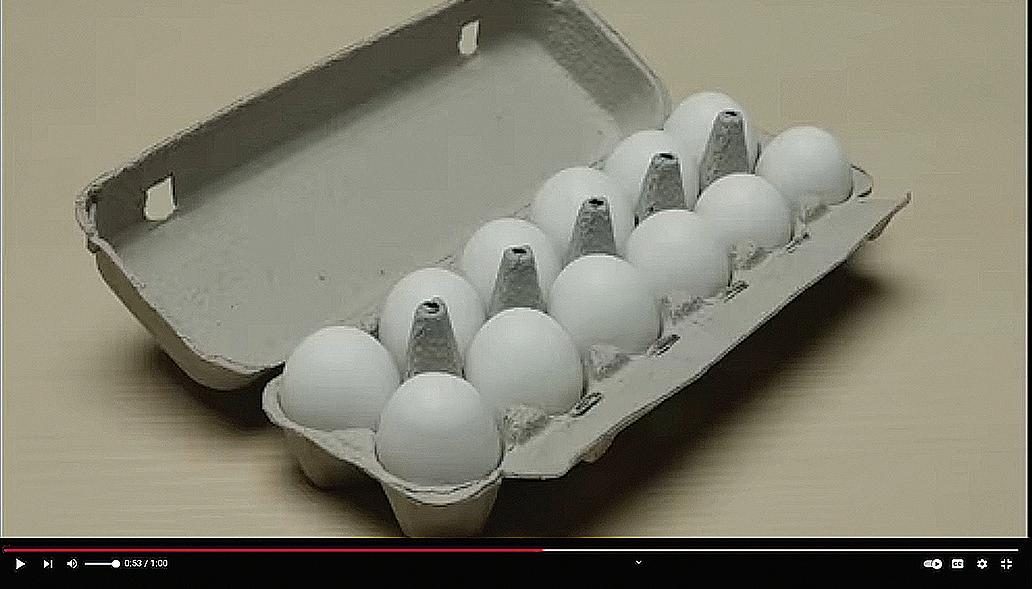
Philadelphia, the father of instant replay in officiating?
The answer: Yes.
So what exactly was the ad trying to claim? We’ll accept Canadian origins to peanut butter and trash bags, but replay?
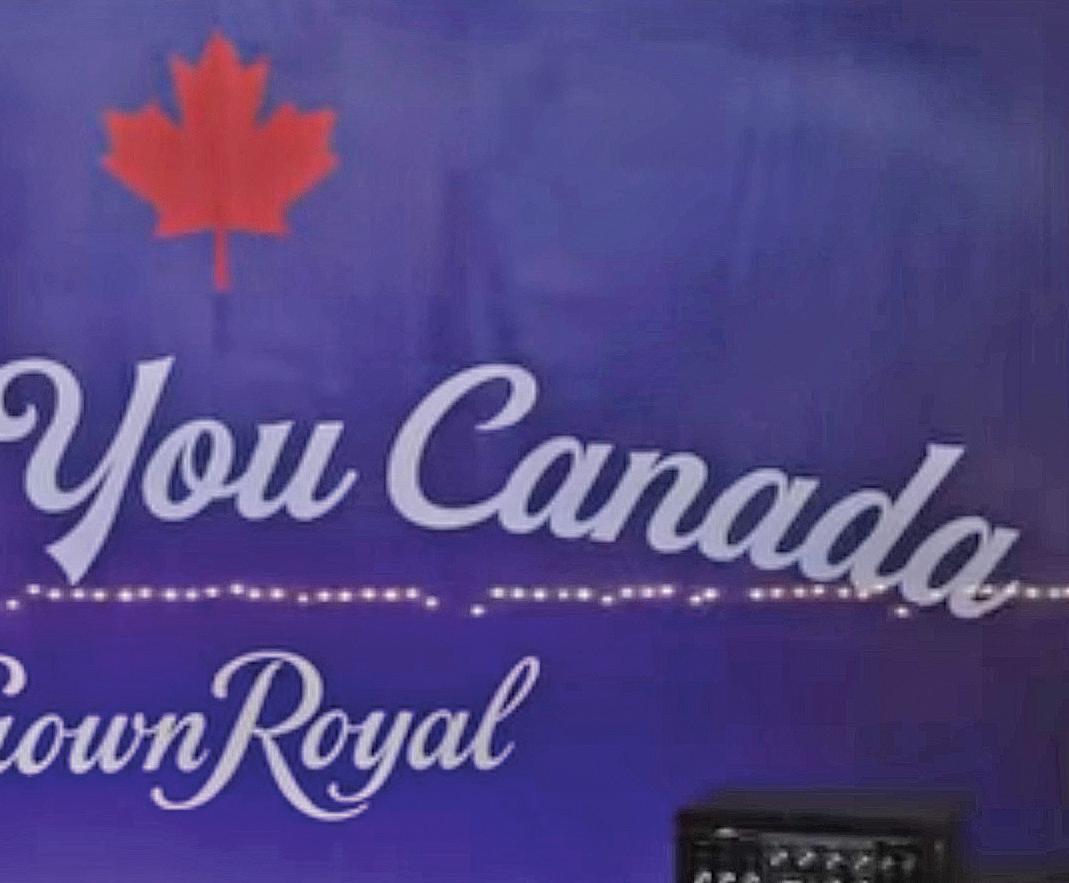

It turns out, at least in terms of television broadcasts, replay did first emerge in Canada.
In 1955, Toronto-based producer George Retzlaff
introduced replay on the CBC’s “Hockey Night in Canada” by reshowing a goal. The replay was far from instant, however, relying on a “wet-film” process that effectively filmed a TV monitor from the live broadcast feed. It was several minutes before the film could be developed and reshown.
It was a one-and-done use of the technology for replay partly because the advertising agency

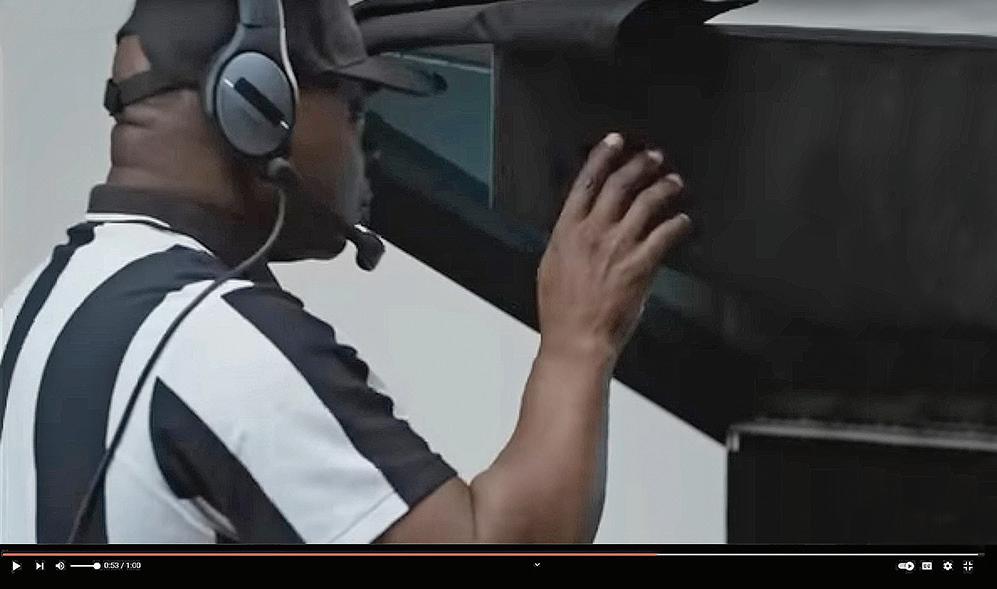
that sponsored the show wasn’t thrilled it hadn’t been given advance notice the technology was going to be deployed and, more significantly, because the program’s main production studio in Montreal didn’t have the equipment to replicate it, according to Mentalfloss.com.
Ultimately, it wasn’t until videotape-based replay came on the scene that a broadcast featured a truly “instant” replay.
REFEREE August 2023 | 35
Foo Fighters frontman Dave Grohl starred in a Crown Royal commercial that enlightened us on the many people and popular items with Canadian origins. There was one claim, however, that gave us pause.
That happened during a CBS broadcast of the Army-Navy football game on Dec. 7, 1963, using a technique developed by Philadelphia-born Tony Verna.
As for replay in officiating, McNally has that claim firmly in hand. The NFL first started experimenting with the use of video replay in the late 1970s. McNally, then-NFL director of officiating, saw the potential, but the technology wasn’t quite ready or affordable. It reemerged in 1985 with a preseason test. Owners narrowly rejected deploying it for the playoffs that season. The USFL, however, rolled out replay for regular season games for the 1985 season. The next year, the NFL adopted use of replay in officiating for the following limited situations:
• Plays of possession or touching (fumbles, interceptions, receptions, muffs or an ineligible player touching a forward pass);
• Most plays governed by the sidelines, goallines, end lines and line of scrimmage (whether a player is out of bounds, forward or backward passes or breaking the plane of the goalline);
• Easily detectable infractions on replay (too many men on the field).
Most reviews were initiated by an “upstairs” official,
Eh?
although a game official could request a review after conferring on the field.
A replay system was used in the NFL for six seasons, but dumped by the owners in 1991 based on the belief it delayed games too much and failed to get enough calls correct. But replay in NFL officiating wasn’t dead. It reemerged in 1999 and has remained in use in the NFL since then, evolving and growing to include many more plays and situations than the original iterations.
So that brings us back to assess the claim made in the commercial. After further review, we’re ruling this one overturned. While the commercial was careful in its wording, claiming only “the replay,” the visual of an official going under the hood implied a connection to replay in officiating. And that fumbles the truth.
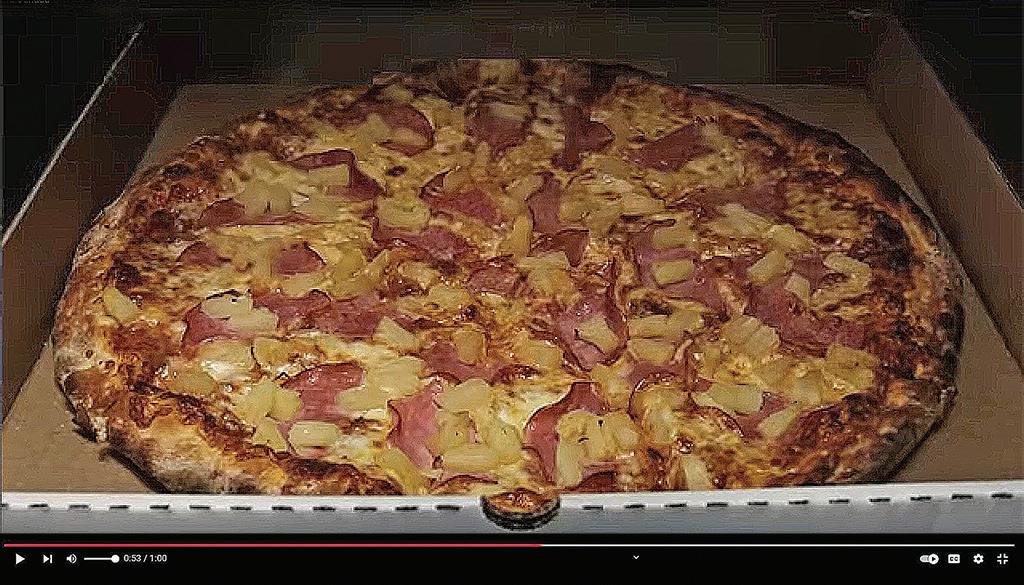
Sure, there's a legitimate claim to the first use of replay in broadcasting thanks to Retzlaff, but not to replay in officiating. Just because the Romans developed concrete doesn’t mean they can claim credit for the Hoover Dam. Interestingly, we probably owe more to instant replay’s ultimate regular emergence in broadcasts to Bing Crosby than
Retzlaff, whose process didn’t catch on.
Crosby, a renowned radio, TV and film actor, had interest in developing high fidelity audio playback in the 1940s so radio actors didn’t have to do both a live broadcast for the East Coast and another a few hours later for the West Coast. He invested in a company called Ampex, which then reverse-engineered a magnetic recording device brought back to the U.S. from Germany after World War II. When TV emerged, Crosby encouraged engineers to find a similar rebroadcasting solution for videotape. Ampex’s VR-1000 emerged. At first, it took time to get to the images for rebroadcast.
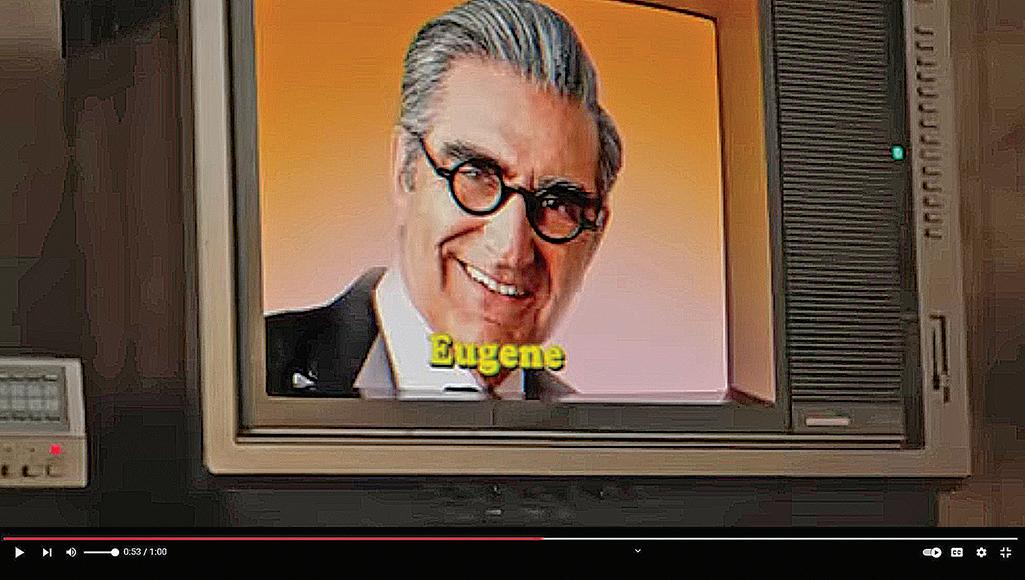
Verna figured out a way using a VR-1000 machine to provide the first “instant” replay in a live broadcast. A couple decades later, McNally saw potential to use video for officiating purposes. The rest is history we don’t need to replay. But we do want to thank Crown Royal for their commercial's lessons. Now we know Canada deserves credit for more than just poutine and hockey.
Brent Killackey umpires high school baseball. He is Referee’s managing editor.
36 | REFEREE August 2023
HAWAIIAN PIZZA
EUGENE LEVY
Officiating Contributions
If the Crown Royal commercial had decided to note Canadian contributions to o ciating in the U.S., it could have mentioned:


Fox 40 Whistle. Developed by NCAA and international basketball referee Ron Foxcroft.
Football overtime rules. The CFL was the first to use overtime rules that gave each team the ball and a set of downs to attempt to score. Similar rules are now used in NCAA football.
People:
– Ron Foxcroft (noted above)
– MLB umpire Stu Scheurwater


– NBA referee Matthew Kallio
– NFL side judge Dave Hawkshaw
– Most of the NHL o ciating sta (For the most recent season, 35 of the 44 referees and 31 of the 40 linesmen hail from Canada)

Historic:
MLB umpires Bob Emslie, Jim McKean and Paul Runge.
Pro Sports — Replay in Officiating
It was the NFL that laid the foundation on which all other replay rules and protocols have been built. Instant replay was given a try during seven preseason games in 1978. But it didn’t get rolled out for regular season games until 1986. (In fact, the USFL beat the NFL out of the gate by adopting instant replay for o ciating during the 1985 season.)
The NFL abandoned replay after the 1991 season but it was re-introduced for 1999 — and it’s been an important part of NFL football o ciating ever since.
Instant replay was first introduced in the NBA for the 200203 season to assist o cials on last-second shots.
The NHL began utilizing replay for goal/no goal decisions during the 1991-92 season.
MLB introduced video review in August 2008 to assist umpires with home run calls. Although the first use of video replay in baseball actually came on May 31, 1999, when umpire Frank Pulli took a look at a video feed from the monitor on a dugout camera to change a call to a home run.
In 2016, MLS became the first soccer league to use video reviews in a live match, checking for clear errors in four reviewable categories: goals, penalty kicks, direct red cards and mistaken identity. FIFA formally added video review to the Laws of the Game in 2018, paving the way for its use at the World Cup that year.

REFEREE Auguat 2023 | 37
PEANUT BUTTER THE PAINT ROLLER
FIX IT IF YOU CAN Guidance and Rulings to Make a Wrong Count Right
By John Bennett
One of the most important jobs for softball umpires is game management. And one of the most overlooked aspects of game management is giving the proper count.
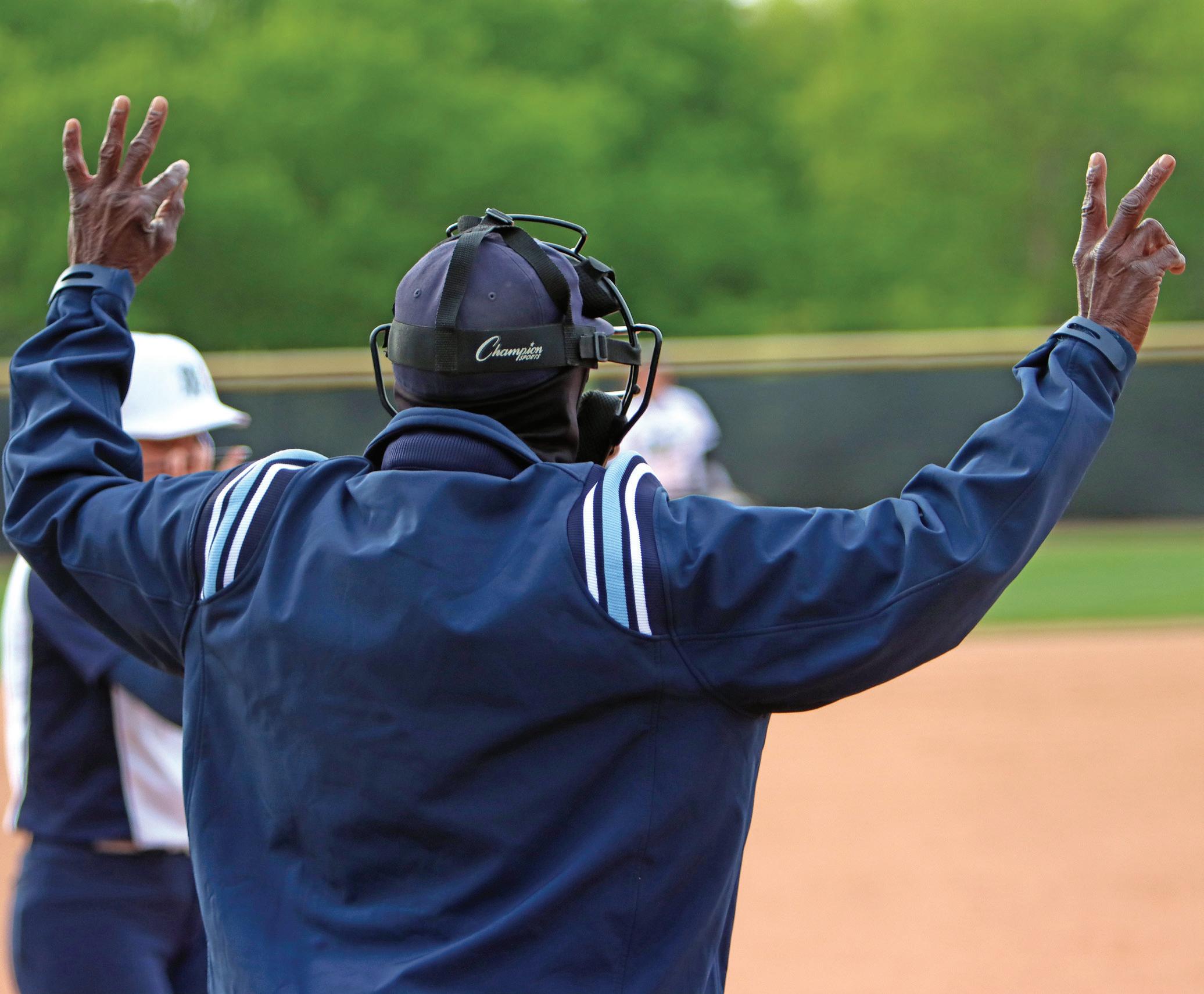
Most likely, the plate umpire will give an accurate count 99 percent of
the time. But we have all had that lapse of focus at least once in our umpire career — wrong count, not sure of the count, the count is being questioned by a team or a partner has a different count.
What do we do when those things happen?
Most mechanics manuals direct the umpires thusly:
Plate umpire: When in doubt, go to partners immediately.
Base umpire(s): If the plate umpire gives an incorrect count, the base umpire should call time and correct the count; do not wait until someone asks you.
A general philosophy, and one stated explicitly in the NCAA mechanics manual, is umpires have
SOFTBALL RULES, MECHANICS, PHILOSOPHY 38 | REFEREE August 2023 EDITOR: BRAD TITTRINGTON btittrington@referee.com
Alvin Selmon, Arlington, Texas, gives the count before a pitch. In situations where the count may be in doubt, especially after a steal, it is important to make sure the count is accurate to avoid potential headaches.
KEITH JOHNSTON
until the at-bat is completed to correct the count. Here are some plays which demonstrate how and when to fix an incorrect count and when it is too late. Referee would like to thank Sandy Searcy, NFHS softball editor; Vickie Van Kleeck, NCAA softball secretary rules editor; and David Chandler, USA Softball deputy director, for their interpretations of the following caseplays.
Play 1: The batter has a 3-1 count and although the next pitch is called a ball, no one acknowledges the base on balls. The next pitch is a foul ball. Before the seventh pitch, the offensive coach asks the plate umpire for the count and it is confirmed to be 4-2. Ruling 1: In NFHS, NCAA and USA Softball, as long as the batter has not completed the turn at bat, the umpire may correct the count. In this case, the batter would be awarded first base because the rules say when a batter receives a fourth ball, they are awarded first base without liability to be put out.
Play 2: The batter has a 3-1 count and although the next pitch is called a ball, no one acknowledges the base on balls. The next pitch is a foul ball. During the discussion about the correct count, it is discovered that earlier in the at-bat the batter took a full swing but the plate umpire called the pitch a ball. Can the umpire change one of the balls to a strike and rule the batter out on strikes? Ruling 2: In NFHS, NCAA and USA Softball, if there is a checked swing or full swing that is not ruled a strike, that must be appealed prior to the next pitch (legal or illegal). Once a pitch has been thrown, the call cannot be changed.
Play 3: The batter leaves the batter’s box headed for the dugout thinking she struck out (but has not) or heads to first base thinking she walked (but has not). Ruling 3: In NFHS, NCAA and USA Softball, the umpire shall direct the batter to return to the batter’s box to complete her turn at-bat. Although this play does not involve the umpire changing the count, it is an example of the duties the umpire has to ensure the count is correct.
Play 4: The batter has a 3-1 count and although the next pitch is called a ball, no one acknowledges the base on balls. The next pitch is a foul ball. Following the foul ball, the seventh pitch is called a strike for strike three. The offensive coach immediately requests the plate umpire award the batter the base on balls the batter had previously earned, thus negating the strike out. Ruling 4: In NFHS and USA Softball, if the umpires can verify they should have awarded a walk on a previous pitch, they should award the walk and negate the strikeout. In NCAA, it is too late to correct the count because the batter completed the turn at-bat. The result of the play remains the action from the last delivered pitch — strikeout. Play 5: The batter has a 3-1 count and although the next pitch is called a ball, no one acknowledges the base on balls. The next pitch is a foul ball. On the following pitch after this foul ball, the batter hits an out-of-thepark home run and the defensive coach immediately requests the plate umpire award the batter the base on balls the batter had previously earned, thus negating the home run. Ruling 5: In NFHS and USA Softball, if the umpires can verify they should have awarded a walk on a previous pitch, they should award the walk and negate the home run. In NCAA, it is too late to correct the count because the batter completed the turn at-bat. The result of the play remains the action from the last delivered pitch — home run. Note: Rule 7.3.5 does not apply as this is not a case of a delayed call or a reversed decision putting a player in undue jeopardy. It is important for umpires to note how and when to correct the count. As a rule of thumb, if there is any doubt, stop and ask your partners or get together and figure out the correct count to avoid some of the scenarios above. Taking those few extra seconds to get the count correct can save a lot of headaches.
John Bennett, Anaheim, Calif., works NCAA, high school and travel ball, and is involved with training umpires at all levels. He worked the 2014 NCAA Division II championships and multiple other championship series.
BY THE NUMBERS
2 States that offer boys’ slowpitch softball.
5 States that offer boys’ fastpitch softball.
5 States that offer girls’ slowpitch softball.
51 States offering girls’ fastpitch softball in ’23-’24.*
7,087 Slowpitch participants.
341,459 Fastpitch participants.
SOURCE:
DID YOU KNOW?
The NCAA adopted the eight-run mercy rule in the Women’s College World Series (WCWS) Championship Series for 2023. In the past, the mercy rule has been used in all games leading up to the best-of-three Championship Series, but it had never been used during those games since the WCWS went to that format in 2005. In 1997, Arizona beat UCLA, 10-2, in five innings, the last and only time a championship game ended via the mercy rule.
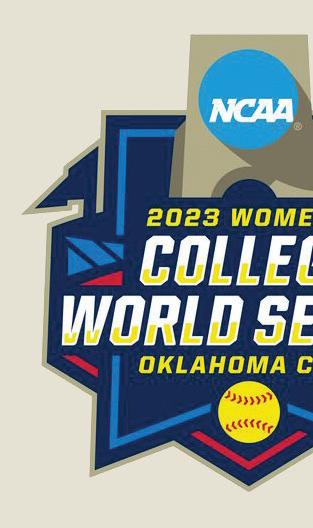
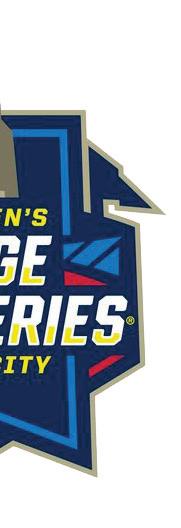
THEY SAID IT
“I’ve had a lot of people saying, ‘Oh, don’t you miss being out on the field?’ And I can honestly say that when I stepped away, I knew it was time. One of the most rewarding things is just seeing people grow up through the years, if you will, and then seeing them being able to accomplish their goals of working a Big Ten championship, of getting to a World Series and then watching them out on the field ... that’s pretty cool.”
— Big Ten, Big 12, Missouri Valley, American Athletic and Summit conferences softball umpire coordinator Sally Walker.
SOURCE: THE NEWS-GAZETTE (CHAMPAIGN, ILL.)

REFEREE August 2023 | 39
NFHS 2021-22 ACADEMIC YEAR PARTICIPATION
* INCLUDES THE DISTRICT OF COLUMBIA
DATA;
TEST YOURSELF Fumbled Interference
Each of the following includes a situation and possible answer(s). Decide which are correct for USA, NFHS, NCAA or USSSA rules and which might vary. Solutions: p. 81
1. With R1 on first, R2 on second and one out, B4 hits a ground ball between third and short. The third baseman fields the ball and tries to throw to first base. As F5 throws the ball, she is bumped by R2 and the ball sails over the first baseman’s head and out of play. R1 had not reached second base at the time of the throw.
a. No interference since R2 did not interfere with a batted ball. The ball is dead when it goes out of play and all runners are awarded two bases from the release of the throw.
b. Interference on R2, the ball is dead, R2 is ruled out, B4 is awarded first base and R1 is awarded second.
c. Interference on R2, the ball is dead, B4 is ruled out, R2 is returned to second and R1 is returned to first.
d. Interference on R2, the ball is dead, R2 is ruled out and B4 is ruled out, inning over.
2. With R1 on first, R2 on second and one out, B4 hits a ground ball between third and short. Both the third baseman and shortstop go for the ball, but F5 ends up cutting in front of F6 and fielding the ball. Just before F5 fields the ball, F6 stops in the baseline, roughly four feet behind where F5 fields the ball, and bumps R2. R2 falls to the ground, F5 fields the ball and runs over and tags R2. B4 and R1 both reach base safely without a throw. In the umpire’s judgment, F5 was the only fielder who could have made an out.
a. Interference by R2 as both F5 and F6 are protected on the initial play. The ball is dead, R2 is out, R1 is awarded second and B4 is awarded first.
b. Legal play. Both F6 and R2 are doing what they were supposed to do. The ball remains live, R2 is ruled out, R1 stays at second and B4 remains at first.
c. Obstruction by F6 and a delayed dead ball. If more than one fielder attempts to field the ball, umpires may only protect one of them. Once R2 is tagged out, the ball becomes dead. R2 is awarded third, R1 is awarded second and B4 is awarded first.
By Brad Tittrington
When working on a small diamond, collisions are likely to occur. And when they do, it is important for umpires to know if those collisions elevate to the status of interference.
One specific instance is when a batted ball is misplayed by a fielder and there is contact between the fielder and the runner (as shown in the PlayPic on the next page). The answer to whether this is interference is, it depends. The answer depends on where the ball ends up and what code you are working.
NFHS and USSSA rules are in agreement on this play in that the fielder is still making an initial play on the ball, despite the bobble, as long as the ball is within a step and a reach of the spot of initial contact, in any direction (NFHS 2-47-3c; USSSA 3-Initial Play).
NCAA rules state it is still interference if the batted ball is misplayed and remains in front of the fielder such that the fielder still has an opportunity to make a play (12.17.2.1.5.3). The key words here are ”in front of” as a ball that ricochets behind or off to the side of the fielder would not give the fielder protection, provided any contact by the runner is unintentional.
USA Softball rules allow for judgment in this scenario. On these types of plays, the umpires must judge if the fielder is still in the act of fielding a ball once the ball is mishandled, but does not have a blanket statement that covers “within a step and reach” like NFHS and USSSA have (8-7J).
Another example of the differences is when the ball is deflected by the pitcher and another fielder has an opportunity to make a play on the ball. NFHS and USSSA rules still provide protection after the pitcher deflects the ball and another fielder has a reasonable opportunity to make a play (NFHS 2-47-3a; USSSA-Initial Play). NCAA and USA Softball codes agree that once the pitcher deflects
the ball, contact with a fielder must be intentional in order for the runner to be called out for interference (NCAA 12.17.2.1.5.5; USA Softball 8-7J-4).
Let’s dissect some plays that frequently occur and how to handle them.
Play 1: With R2 on second and R1 on first, B3 hits a ground ball between second and third. The shortstop moves to her right to field the ball. The ball hits the heel of her glove and bounces (a) just in front of her, (b) just to her right, or (c) just behind her. As she bends down to pick up the ball, R2 clips her feet unintentionally and
both R2 and the shortstop fall to the ground. Ruling 1: In (a), this would be interference in all four codes. The ball is within a step and a reach in front of the fielder to meet the requirements of NFHS, NCAA and USSSA and is a reasonable play to meet the requirements in USA Softball, and R2 would need to avoid contact with the fielder who is still protected to make the play. R2 is guilty of interference, the ball is dead and R2 is ruled out. R1 would be awarded second base and B3 would be awarded first. In (b) and (c), this would be interference in NFHS, USSSA and USA Softball and the ruling would be the same as in (a). In NCAA, this would not be interference as the ball is not in front of the fielder and the fielder is no longer protected. It would only be interference in NCAA if the contact was ruled intentional. On this play, the umpire must judge if the contact
SOFTBALL 40 | REFEREE August 2023
The most important thing is to allow the play to develop, let your mind digest what you’ve seen and then make a ruling.
is inadvertent (ball remains live and play continues) or if this is obstruction on the shortstop (delayed dead ball and R2 is protected to third base).
Play 2: With R1 on first, B2 hits a sharp ground ball to second base. The ball takes a bad hop and hits F4 in the arm, then ricochets about 10 feet behind her. R1, who is trying to avoid contact, runs behind the initial setup of F4. After misplaying the ball, F4 turns to go after the ball and collides with R1 and both fall to the ground. Ruling 2: In all codes, this would be obstruction on F4. She is no longer protected as she has touched the ball and is no longer making an initial play. She is now at fault for obstructing R1’s advance to second base. The umpire should give the delayed dead ball signal and allow play to continue. If R1 reaches the base she would have reached had obstruction not occurred (second in this case), the obstruction is ignored. If she is put out before reaching second, the ball would become dead and she would be awarded second base.
Play 3: With R1 on first, B2 hits a line drive that deflects off F1’s glove and ricochets toward second base. F4 was shaded up the middle and on contact, made a step toward second base. After seeing the ball hit F1’s glove and ricochet, F4 races toward first to try to field the ball. R1, seeing the ball hit the ground, starts running toward second and doesn’t notice F4. The two of them collide. R1 continues on to second and B2 reaches first safely. Ruling 3: In NFHS and USSSA, F4 is still protected as a deflection by the pitcher does not eliminate the interference protection. If the umpires rule F4 had a reasonable play on the ball, R1 is guilty of interference, the ball is dead, R1 is out and B2 is awarded first base. If the umpires judge F4 did not have a reasonable play, allowing the ball to remain live would be the correct ruling. In NCAA and USA Softball, this is not interference. Once the ball touched F1, F4 is not protected, unless contact is deemed intentional by R1. If the umpire judges the fielder and runner did what they were supposed to do,


the ball remains live and all play stands.
If you’ve umpired long enough, you have seen each of these scenarios play out. If you are relatively new, you may not have witnessed them yet, but you will. The most important thing is to allow the play to develop, let your mind digest what you’ve seen and then make a ruling. This is not a call you have to rush, so take your time


and make sure you know what you have before making the call. Then make the call with confidence and explain, using rulebook language, why you made the call you did to a potentially upset coach.
Brad Tittrington is an associate editor for Referee . He umpires D-I softball and officiates women’s college and high school basketball, college and high school volleyball and high school football.


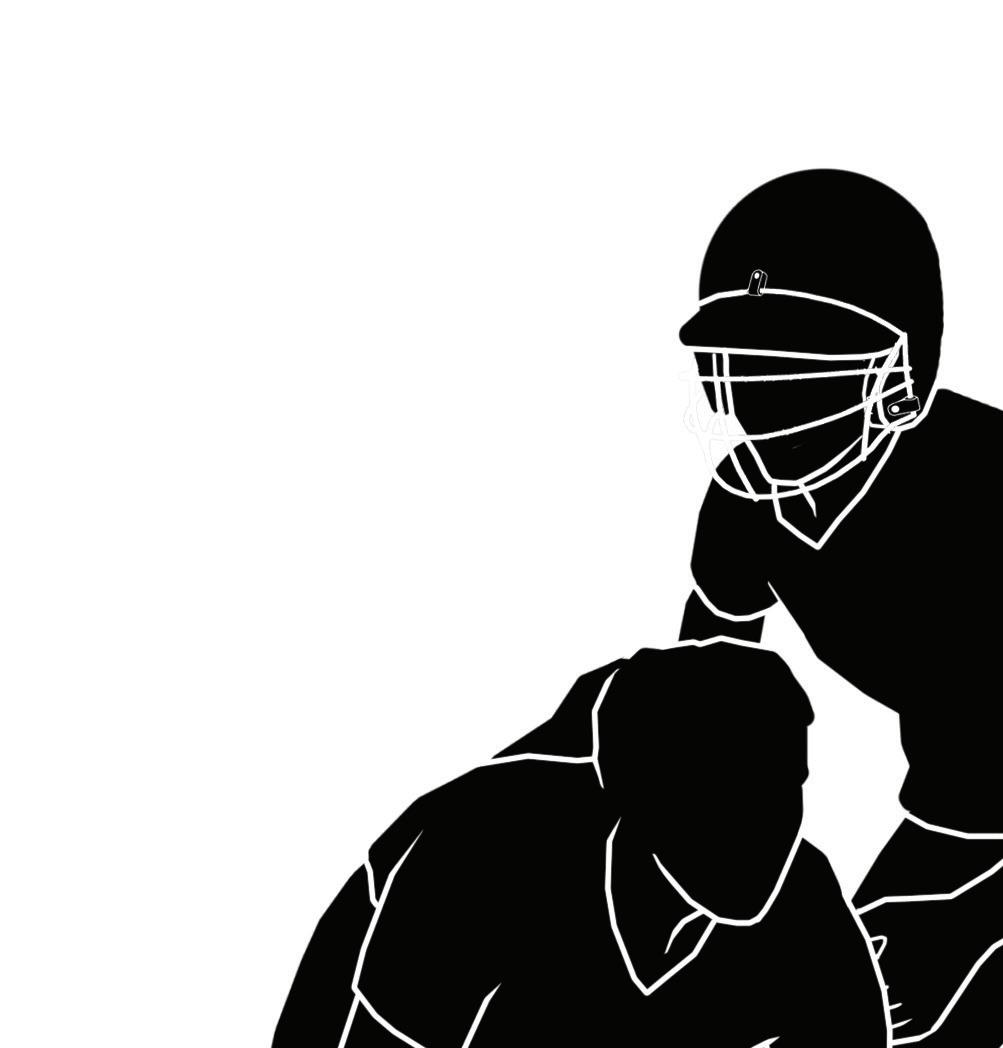
|
CASEPLAYS
Non-Pivot (Stride) Foot Placement
Play: F1 steps on the pitcher’s plate and prepares to take a signal from the catcher. F1 has the pivot foot in contact with and completely within the width of the 24-inch length of the pitcher’s plate and has the nonpivot (stride) foot in contact with and partially within the 24-inch length of the pitcher’s plate. F1, after taking the signal, begins her windup. The plate umpire signals illegal pitch. Ruling: Incorrect ruling in NFHS, NCAA and USSSA. In these codes, the nonpivot (stride) foot must be within or partially within the 24-inch length of the pitcher’s plate. In these three codes, the pitcher’s position is legal (NFHS 6-1-1; NCAA 10.1.1d; USSSA 6-1A). In USA Softball, the non-pivot (stride) foot must be within the 24-inch length of the pitcher’s plate before starting the pitch and the umpire’s ruling of an illegal pitch is correct (6A-1C).
Pivot Foot Placement
Play: F1 steps on the pitcher’s plate and prepares to take a signal from the catcher. F1 has the pivot foot in contact with and only partially within the 24-inch length of the pitcher’s plate, and has the non-pivot (stride) foot in contact with and completely within the 24-inch length of the pitcher’s plate. F1, after taking the signal, begins her windup. The plate umpire signals illegal pitch. Ruling: Incorrect ruling in NFHS and USSSA. In these two codes, the pivot foot only needs to be partially within the 24-inch length of the pitcher’s plate. Therefore, this setup would be legal (NFHS 6-1-1; USSSA 6-1A). In NCAA and USA Softball, the pivot foot must be completely within the 24-inch length of the pitcher’s plate when taking the pitching position. The ruling of an illegal pitch in this instance is correct in these two codes (NCAA 10.1.1c; USA Softball 6A-1C).
R1 and R2 Tag, Who’s It?
In the two-umpire system, both umpires have responsibilities when it comes to watching runners tag up. And all codes don’t always handle situations alike, which makes it extremely important to pregame tag-up responsibilities to make sure umpires are on the same page.
One scenario where the codes differ is tag situations with runners on first and second base. NFHS and USA Softball mechanics dictate the base umpire takes the tag on R1 at first base and the plate umpire is responsible for R2 tagging up at second base.
In these two codes — once the ball is in the air and the base umpire chooses to remain on the infield and not chase — the base umpire should move inside the diamond, making sure to avoid R2, and get in position to see R1’s tag from first base (as shown in the MechaniGram). The base umpire is then responsible for all plays at first and second base, and all plays at third base on R1.
The plate umpire has a little more responsibility on this play as the plate umpire must get in position to not only see the catch in the outfield (and possibly rule fair/ foul on plays near a line) but also get a position to see R2’s tag from
second base. After that, the plate umpire is responsible for all plays on R2 at third base and home plate and all plays at home plate on R1.
NCAA and USSSA mechanics differ in the responsibilities in this instance. In both of those codes, the base umpire is responsible for both tags at first and second base. In these two codes, the base umpire should move to a position to be able to see both tags. Once the ball is caught, the base umpire is responsible for all plays at first and second base and should be prepared to take a play at third base on R1 if the plate umpire has a call on R2 at the plate.
The plate umpire has no tag responsibilities in these two codes in this scenario. The plate umpire should move initially in the direction of the fly ball in order to rule on the catch and potential fair/ foul if the ball is near a line.
The plate umpire is then responsible for all calls on R2 at third base and the plate. It is important for the two umpires to communicate on plays at third base to make sure only one umpire is there to make a call to avoid multiple calls and potentially ending up with different calls.
SOFTBALL 42 | REFEREE August 2023
R1 R2 P P B B P
VISIONINACTION






Where Does Your State Stand? E orts to Protect O cials Nationwide
Our role as sports officials is to enforce the rules during emotionally charged athletic competitions. Laws often provide special protections for teachers or police officers. NASO believes similar legislation should also recognize the men and women who referee, umpire and judge athletic competitions as a special class.

NASO collaborates directly with officials and state legislatures around the country to enact such laws. While the scope of state legislation varies, sports officials should be able to perform their duties without the threat of personal injury, administrative hearings or litigation because of their game calls. State legislators can show support for those who officiate by passing laws to protect them.















NASO publishes a “Legislative Scorecard” every year. This online interactive map displays the states that have passed laws dealing with liability issues, independent contractor status, and assault protection. Officiating assault and harassment laws are currently in 22 states including 20 with criminal laws and two with civil statutes. Seventeen states have limited liability legislation, and 15 states have independent contractor laws. In addition, three states – Idaho, Washington, and Missouri – have passed resolutions that support officials.
NASO has worked with dozens of state legislatures over
WE’RE ALL IN THIS TOGETHER!
the years to help them realize the importance of passing these laws that protect sports officials. Since 1984 when NASO first submitted model legislation regarding assaults against officials, and legislators have used such models to construct their own legislative bills. Each state handles legislation differently, and it is up to the local constituency to manage the process effectively.
See how your state compares. Consider getting involved in pushing for legislation if there is work to be done by following these steps:
1. Contact your local association. Inform each other what other states have done and move forward together.
2. Circulate a petition.

3. Gather and present information about incidents in your state that apply, such as officiating assaults.
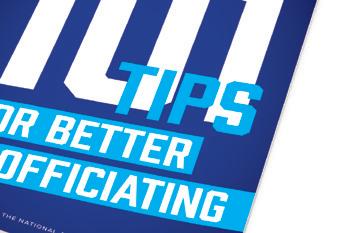
4. Contact and meet your legislators to present information that may help pass legislation.
5. Maintain focus on the topic and follow up. Take time to gather more support and pursue legislation at the next opportunity.
Research where your state stands with NASO’s Legislative scorecard. Go to naso.org/ scorecard to view legislation status. It is complete through 2022 and new information is added regularly.


THESE ORGANIZATIONS SUPPORT OFFICIALS
ATTENTION REFEREE MAGAZINE SUBSCRIBERS

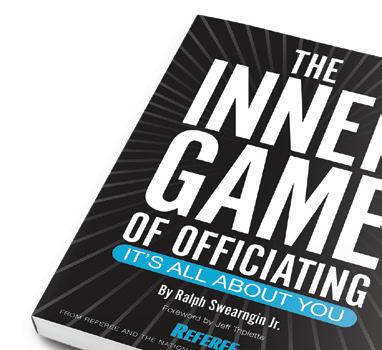
It’s time to join the rest of us in the National Association of Sports O cials. Not only will you continue to receive the world’s #1 o ciating publication, you’ll enjoy all of the additional benefits NASO members enjoy.
Go to naso.org/upgrade2023 to join NASO for the special introductory price of $114 and receive these two FREE books!

NATIONAL
OF SPORTS OFFICIALS
ASSOCIATION
FOR NASO
INFORMATION OR TO
UP, GO TO NASO.ORG, CALL 262-632-5448 OR EMAIL CSERVICE@NASO.ORG
MEMBERSHIP
SIGN
$ 114 JOIN TODAY
LADDER CLIMBER Improve These Skills to Level Up Your Career
By Jim Momsen
Soyou’ve tested out the waters of volleyball officiating and have decided you want to continue, and you want to get better. Your reason(s) for wanting to improve may be one or many — to get assigned to higher level matches, to open you up to more opportunities, to find out how good of an official you can be, to get higher-paying matches, to give back by training others, self-discovery or you want to learn new techniques. These are all valid, and very good, reasons.
First, what levels are available and how are they awarded within each of the three governing bodies?
In NFHS, it depends on your state association. Referees advance from level to level based upon their attendance at the annual rules clinic, completing the annual exam, participating in oncourt training sessions and the number of varsity matches worked. In some states, your level is based on the number of years you’ve worked, in others it is based on actual performance.

In USAV, there are five levels of referees. From bottom to top, they are In-Training, Provisional, Regional, Junior National and National. The latter four are awarded patches to signify the level referees have achieved. The Provisional and Regional ratings are awarded and maintained by the USAV region in which the member is registered, typically after observation of a referee’s performance by highly experienced referees within the USAV region. There are currently 40 regions under the USAV umbrella. The Junior National and National ratings are awarded by a National Rating Team consisting of highly experienced officials at national championship tournament locations.
In NCAA, there are four levels of referees. From bottom to top, they are Apprentice, Local, State and National. PAVO handles the observations and evaluations and awards the
VOLLEYBALL RULES, MECHANICS, PHILOSOPHY 44 | REFEREE August 2023 EDITORS: BRAD TITTRINGTON btittrington@referee.com
HESTON QUAN
Experience and proper mechanics can lead an official to working higher levels, such as a state tournament. It is important to continually grow as a referee in order to reach higher levels. Bishoy Bestawros, Glendora, Calif.
patches for Local, State and National referees. PAVO also awards line judge certifications at two levels — Basic and National. Similar to USAV, Local and State referee ratings, as well as Basic line judge certifications, are administered and maintained by the local Board of Officials in which the member is registered, and National referee and National line judge ratings are awarded by a National Rating Team consisting of highly experienced officials at select ratings sites of NCAA Division I tournaments.

Second, what are evaluators and raters looking for in officials?
Ability to be quiet, listen and learn from others. Don’t make excuses or defend why you did something (unless a mentor asks what was your thought process) or if your mentor suggests you change something.
Ability to read, understand and memorize. You will need to read the rulebook(s) and remember the rules and mechanics for each rule set. You will also need to remember who the floor captains are, who the setter(s) are and the positions (front/back row and alignment) of the players on the court.
Ability to manage time effectively. You need to maintain a calendar of your matches and their start times, as well as managing travel time to events. You will also need to maintain your availability in any assigning systems used by your assigners. Nothing is more frustrating to an assigner than assigning individuals to matches and then having an individual turn back an assignment because they are (a) assigned somewhere else, (b) have an appointment, or (c) are on vacation or have a family function and they forgot to block their availability. In the words of one of my NCAA assigners, “Don’t make me do my job twice because you didn’t do your job once.”
Ability to learn how to learn. Having been involved in corporate training for my former day job, I know that different individuals learn in different ways. Some can read something and learn it. Others learn better if they see it. Most learn by performing the skill. Knowing it is different than applying/demonstrating it. Be able to demonstrate and apply what you have learned.
Ability to break down a process. Officiating volleyball and adhering to protocols and officiating mechanics is a process that is made up of many sub-processes and discrete steps. Keep learning and internalizing these subprocesses and discrete steps.
Accept assignments that benefit others. One of the aspects of a great official is to sometimes accept a “lesser” assignment, or travel a little farther than you would like, to benefit the officiating team. It may give you a chance to observe a newer official and provide feedback. It may help out your assigner cover an open spot.
Focus on making the team look better. We all look like a better officiating unit when we support each other. As an R2, think of what information your R1 might need (and has asked for you to provide during your prematch conference). As a line judge, think about what information your R1 might need in the situation, and then provide it. As an R1, ask yourself, “How can I support my R2 and line judges?”
Keep accepted assignments. If you have something come up — a family situation, medical emergency, a plum assignment or opportunity — talk to your assigner and be honest about why you need or would like to turn back the assignment. Never lie to an assigner, because that assigner will eventually find out. Then you have broken that trust and it will take a long time to get it back, if you ever do regain it.
Ability to self-analyze. If you understand the steps in the process, you can self-analyze and identify where you might be deficient. Signal mechanics are very basic and very important to master early in your career. Also, always call and signal the fault that stopped play. For example, if there are four contacts by the team before the ball hits the floor, signal four-hits, not ball in.

Ability to remain consistent. It doesn’t matter if you are officiating 13-year-olds, NCAA D-I or any level in between, you should always look your best and give it your best effort. Signal crisply and accurately. Look like you care about the match. The players are trying their best, so should you.
SIDELINE
Missouri Adds Boys’ Volleyball
In May, the Missouri State High School Activities Association announced it is recognizing boys’ volleyball as an official sport beginning spring 2024. Boys’ volleyball has been a club sport in Missouri since crowning its first champion in 1997. Missouri becomes the 26th state association to sanction boys’ volleyball.
QUICKTIP
Whether a completed attack is executed with an open or closed hand, fingertips, forearm, dump or even with a foot or head, your standards for ruling on that attack should not change. If there is no prolonged contact or illegal multiple contacts, play should be allowed to continue.

TOOLS
Volleyball Rules Challenge
Sharpen your rulebook knowledge with the 2023 Volleyball Rules Challenge.
Engage in this fun, free challenging approach to studying the rules for the new season. Take a measure of your skills. The new Referee Rules Challenge is powered by the “Rules R” quiz platform, a state-of-the-art sports officiating testing program developed by Guy Bradbury, legendary international volleyball official and administrator.
Get started today! Go to referee.com/ruleschallenge.
REFEREE August 2023 | 45
Copyright © 2023 by Referee Enterprises, Inc. All rights reserved. Copy these quizzes for handout but not for resale or publication without the expressed written permission of Referee Enterprises, Inc. 1 During play, team A’s beyond the endline and four feet off the sideline extended to provide a. Legal. Beyond the endline, there is no requirement to be b. Illegal. The head coach must be minimum of six during play. c. Illegal. The head coach feet off the sideline extended during play. 2 After the first point, stand up to give instruction to the team. As the first referee authorizes service, both coaches return to their seats. After the next rally completed, the head coach and a different assistant coach stand to give a. Legal. b. Illegal. Only the head coach may stand and give instruction during a dead ball. c. Illegal. The head coach assistant coach per match who is allowed to stand during dead-ball situations to give instruction. 3 During warmups, the referees notice one team A player wearing post earrings, another wearing hoop earrings and a third wrist. and the referees should warming up. b. All jewelry is illegal and jewelry must be removed. c. The referees should notify the team A coach that the hoop earrings and commemorative bracelet are illegal and shall be removed, but they should allow the post earrings as those are legal. When a back-row player participates in a block attempt, but the ball is not touched by any blockers and ends up sailing out of bounds, is it an illegal back-row block or a legal play? See question 4. Sponsored by the National Association of Sports Officials and prepared by the editors of Referee magazine. volle yBALL RULES CHALLENGE Each of the following includes a situation and possible answers. (Answers on last page.)
TEST YOURSELF
In each of the following, you are given a situation and possible answer(s). You are to decide which answer(s) are correct for NFHS, NCAA or USAV rules, which might vary. Solutions: p. 81.
1. A1, an injured libero, has been replaced by re-designation. A1 may not return to play in that match.
a. True.
b. False.
2. Which of the following is not a duty of the second referee?
a. Whistling net contact by a player.
b. Whistling attack-hit faults by a back-row player.
c. Whistling a ballhandling fault when the first referee is screened from seeing the contact.
d. Whistling center line/ penetration faults.
3. An exceptional substitution never counts as one of the team’s allowable substitutions.
a. True.
b. False.
4. The first server of the receiving team is in which position when the set begins?
a. Right back position.
b. Left front position.
c. Right front position
d. Left back position.
5. Team A’s center front, left front and left back are all very close to each other at the net, and all three are reaching higher than the top of the net. The ball is attacked by the opponent, and contacts team A’s left front’s hands. Which of the following statements is true?
a. As described, team A’s center front, left front and left back meet the definition of a collective block.
b. Team A’s center front and left back are also considered to have blocked the ball, since the ball contacted the left front’s hands.
c. An illegal block has occurred because team A’s left back has participated in a completed block.
d. All of the above statements are true.
6. Who has the authority to establish non-playing areas and define any additional ground rules that might be necessary?
a. Second referee.
b. Host administration.
c. First referee.
d. Home head coach.
Ability to adapt, improvise and overcome obstacles. You walk into a familiar gym, but the layout has changed. Perhaps there is a new overhead obstruction, one scoreboard isn’t working, there is not enough seating for all the players or something crazy happens during play. During an NJCAA National Championship match, I once had a player collapse on the court after the completion of a rally. She wasn’t moving. A woman came out of the stands and walked up to the edge of the court, looked at me and said, “I’m the assistant AD for the school. It’s OK, she has narcolepsy. She’ll wake up in 30 seconds and be ready to play.” My partner and I treated it as an injury situation and everything was fine. Ability to make decisions based on facts, not emotions. Volleyball is an emotional game. What did you see? What did you not see? What information is your work crew giving you? Those are the facts. Decide based on those.
Ability to understand how others feel. Put yourself in the other person’s shoes. How would you feel? Can you relate to their feelings?
Ability to do things irrespective of the situation. Would you make the same call at 0-0 that you did at 23-24?
Ability to communicate in a concise manner. If someone asks a question or needs an explanation, give a concise and to-the-point answer. If it’s a question about a rule, be short and sweet. If it’s a question about
player positioning, identify the players at fault and how they were out of position.
Ability to ask for help. This is where your mentor comes in. Once you admit you need help to improve your officiating, ask your mentor what you need to work on and how to change it for the better.
Ability to determine and accept your strengths and weaknesses. Once you and your mentor determine your strengths and weaknesses, maintain and leverage your strengths (perhaps communication skills or signal mechanics) and focus on improving and alleviating your weaknesses.
Ability to stay positive and optimistic. You are not going to grasp everything right away and have a perfect match (there is always something you could have done better). It’s OK to strive for perfection and it’s OK to accept excellence.
Ability to keep trying after failure. Everyone is going to have “one of those matches” that doesn’t live up to the expectations of you or others. That is OK. Keep positive, understand what didn’t go as you would like and understand how you can change your actions for the better if the situation ever comes up again.
Jim Momsen, Hartland, Wis., is a USAV and PAVO National Referee and has been officiating volleyball for over 20 years. He has officiated many USAV and collegiate national tournaments and is the president of Badger Region Volleyball.
In-Tune With Injuries
By Rick Brown
injuries and keep your matches flowing.
The
NFHS made injury procedures a point of emphasis (POE) for the 2022-23 season and for good reason. Injuries, unfortunately, are a part of volleyball and it is the responsibility of the referees to handle these situations delicately, with tact and in a timely manner. If you officiate long enough, you will see plenty of injuries during your career and it is imperative you handle them correctly. Here are some tips to help handle
Awareness of Possible Injury
The primary responsibility of referees is player safety. The referee who first spots the injury uses a loud/ urgent whistle to halt the rally to try to prevent further injury. Either a sharp double whistle or an urgent tweet-tweet-tweet-tweet whistle sound should be used — whichever sound the referee believes works best to stop player movement on the court.
46 | REFEREE August 2023
VOLLEYBALL
When in Doubt
Sometimes it’s clear a player is injured during play. Sometimes a player goes down and scrambles back up to get into the rally. Observe for further clues and, when in doubt, whistle to kill the play, erring on the side of safety.
Authorizing Help







The R2’s next action is to quickly authorize help from the bench to go to the player to offer comfort and care, begin an assessment of the injury and identify medical attention as needed. Strongly directing help from the bench helps to overcome hesitancy to go onto the court; certified athletic trainers will instinctively go to the player from either bench.
Assessing Injury
Medical personnel attends to the athlete and advises the coaching staff after assessing the nature of the injury, identifying needed treatment, evaluating a possible concussion and
determining whether, when and how the injured player is moved.
Outcome Determines Options
Referees handle a seemingly minor injury differently than a clearly severe injury in terms of the timing of approaching an available coach about the injured player. This is part of the new emphasis on injury response: greater compassion, common sense and flexibility rather than the one-sizefits-all approach of, “Coach, you have 30 seconds to make a decision about your player,” which is insensitive and counter-intuitive.
Maintaining a Respectful Distance
Regardless of what you observe, show sensitivity. This includes inconspicuously timing the injury for choosing the best time to approach one of the injured player’s coaches who isn’t attending to the athlete and conferring about the result of the rally based on whether the whistle interfered with play or the outcome

wasn’t affected. This information is needed because replay options are limited compared to a completed rally.
Timing of Approaching Coach

Apparent extent of the injury sets the timing for approaching a coach. For a clearly severe injury, there is no rush for the R2 to approach a coach about a decision about a player who will not be able to remain in the set. For a minor injury, rule 11-4-1 offers guidance since the athlete might possibly recover within about 30 seconds, allowing play to continue relatively quickly; this “30 seconds” is from when the R2 asks a coach for a decision about the player being able to remain in the set with the option of an available timeout or replacing the injured athlete.
Information Needed From Table Staff
The options the R2 will present to coaches are contingent on whether a replay will be issued or a point awarded when play resumes. The R2 See “Injuries” p.49
LEARN VOLLEYBALL RULES FAST & EASY

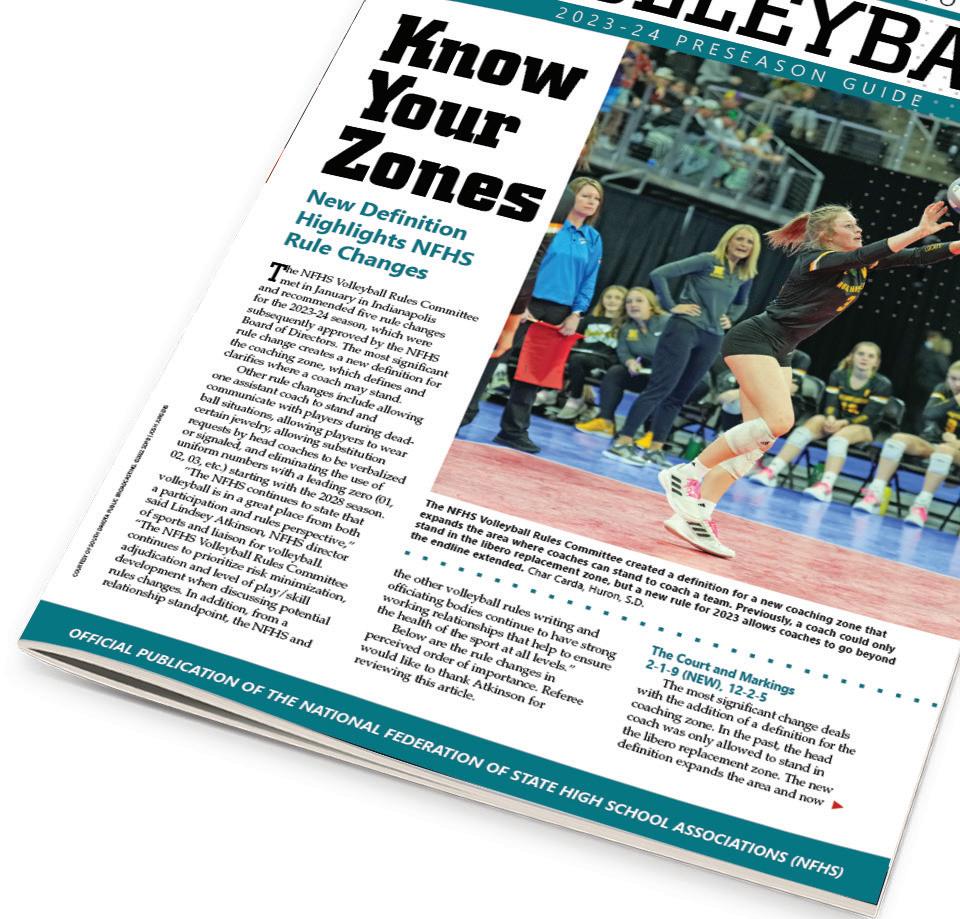
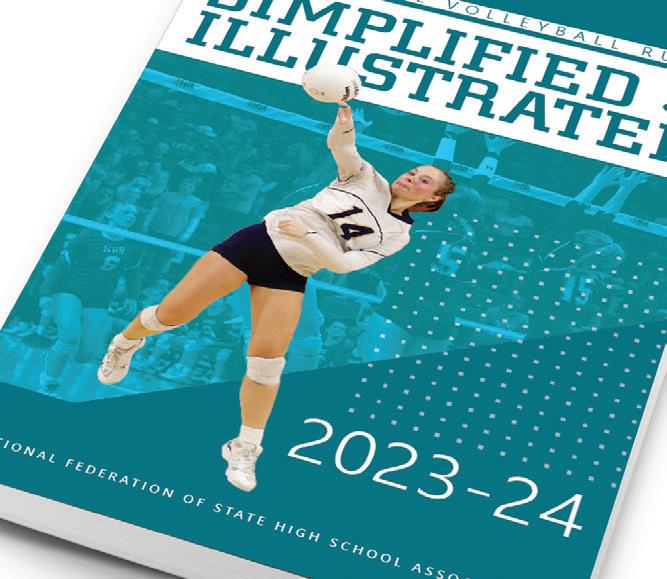
Volleyball’s most complicated rules are explained in everyday language and reinforced with 100s of illustrations.
STORE /VOLLEYBALL
$1595
$350
CASEPLAYS


















Libero Set
Play: A1 passes the ball to the libero, who is standing with one foot in front of the attack line and one foot behind it. Just before setting the ball (using overhand finger action), the libero lifts the foot that is touching the court in front of the attack line. A2, a front-row player, then attacks the ball while it is entirely above the height of the net. Ruling: Legal in all codes. When the libero lifted the foot that was touching the court in front of the attack line, the libero was no longer considered to be in the front zone. For a fault to occur in this situation, the libero must be touching the court on or in front of the attack line at the moment the libero sets the ball (NFHS 9-5-6-b; NCAA 12.1.2.4; USAV 19.3.1.4).
Illegal Attack?
Play: During a rally, team A’s libero moves to a position behind her blockers in the front zone. B1 attacks the ball, which rebounds from the arm of a team A blocker, directly toward the team A libero’s face. To protect herself, the libero places both open hands above her head to try to deflect the ball. The ball hits the team A libero’s hands and rebounds into the air. A team A front-row player completes an attack-hit while the ball is entirely above the top of the net. The first referee whistles and signals an illegal attack on team A and indicates the libero’s playing action made the attack illegal. Ruling: The first referee’s decision is incorrect in all codes. While it is a fault for the libero to use an overhand finger pass (“setting action”) to pass the ball to a teammate, this play does not fall under that rule (NFHS 9-5-6b; NCAA 12.1.2.4; USAV 19.3.1.4). Even though the ball hit the libero’s hands while she was in the front zone, the libero’s contact was a reaction and defensive in nature. The fact the libero’s hands were open does not automatically result in an overhand finger pass.
NCAA
Residence: Lockport, Ill.






Experience: Referee for 16 years, PAVO and USAV National referee, Illinois High School Association referee, works multiple D-I conferences including Big Ten and Southeastern, worked first Final Four in 2022, former D-I volleyball player.
REFEREE: What do you do prematch with coaches to start off on the right foot?

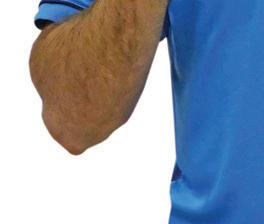
GUSTAFSON: It depends on where we’re going here. Every situation is different. The reason I say that is because it depends if you know the coaches or not. If I know the coaches, I know what coaches like to chit chat and what coaches say very little, if anything at all. And there’s even a couple out there that just want to know if they are serving or receiving, and that is it. They don’t want to talk at all. That’s the part of it that comes with experience as an official. If I am talking USAV or club volleyball, I don’t have to talk to coaches too much unless they want to talk to me. If we are talking high school coaches, that conversation is usually pretty short and chill. It kind of depends. It really helps to know your audience.
REFEREE: If during a match, you have a difficult coach, what do you do?


5 MINUTES WITH JOE GUSTAFSON that’s
GUSTAFSON: It’s situational depending on how they are being in the moment. Sometimes I try not to engage, especially if it’s judgment. If it’s judgment things, I don’t even want to look at a coach. If they just want to stick their hand up for a moment to be like two, that’s a double, or that’s a caught or thrown ball, and it’s not aggressive across the court at my partner or they’re not trying to have a conversation with my partner, I’m just going to let them have that emotional outburst for a moment and not engage, because, why open a can of worms if we don’t need to? That’s like Situation A. If you start moving on down the line to Situations B or C or D or whatever, now they are at the sideline at the 10 foot line in that little corner screaming across the court at my partner or really trying to make an
issue, that’s a moment where I have to engage.

REFEREE: NFHS is now allowing an assistant coach to stand during dead ball situations. Do you have any words of advice for officials on dealing with this new dynamic?
GUSTAFSON: It’s not a bad thing necessarily, because it hopefully gives the assistant coaches some things to do that don’t involve officials. There is a chance as far as NFHS goes where you could have a situation where something happens, whatever it may be, and you get that emotional outburst in the moment from both coaches. I think emotional outbursts are OK. It’s sports. As officials I think sometimes we have to remind ourselves that reacting emotionally is not something that we just need to necessarily squelch or curb stomp super quick. If I have a coach that’s getting super emotional for a moment, that’s OK. I get it. It’s sports.
REFEREE: Coaches now have a new coaching zone in NFHS. How do you see that impacting the R2?



GUSTAFSON: The only thing we would have to be aware of is the distance. Keep on our radar, after a run of a couple points, they might want a timeout or a substitution. We’re not necessarily staring at the coach, but we’re keeping them in our field of vision in case they want that timeout or substitution, we are ready for them. Especially when they’re farther away from us, we may not be able to hear them say timeout, or if they motion it with their hands. I think it is more of just a radar thing — being prepared if they are farther way from us. I still put that on the coach. If you want that substitution request or timeout and you are going to stand past the end of your bench, it is on you to make sure that you are audible enough or visual enough or whatever the case may be. I am one of those people where if I get a request maybe at the moment my R1 is beckoning, I say let’s make this timeout or substitution happen. Let’s let the kids play versus no, no they already beckoned. Most R1’s should be good with that. At the end of the day, that’s what we’re there for. Kids are playing and coaches are coaching. If they want those things, if we can accommodate them, we should accommodate them.
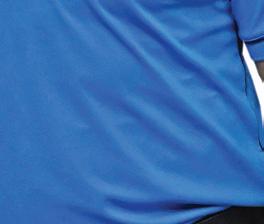
48 | REFEREE August 2023
COURTESY PAVO PROFESSIONAL PHOTOGRAPHER, DAN HOUSER
Division I women’s volleyball semifinal referee discusses communication with coaches.
VOLLEYBALL
needs to know the timeout status for both teams, even if the other team isn’t allowed to request a timeout or substitution, or to make a libero replacement due to a replay. Knowing whether regular substitution is possible for the injured player or priority options for exceptional substitution comes from working with the scorer.












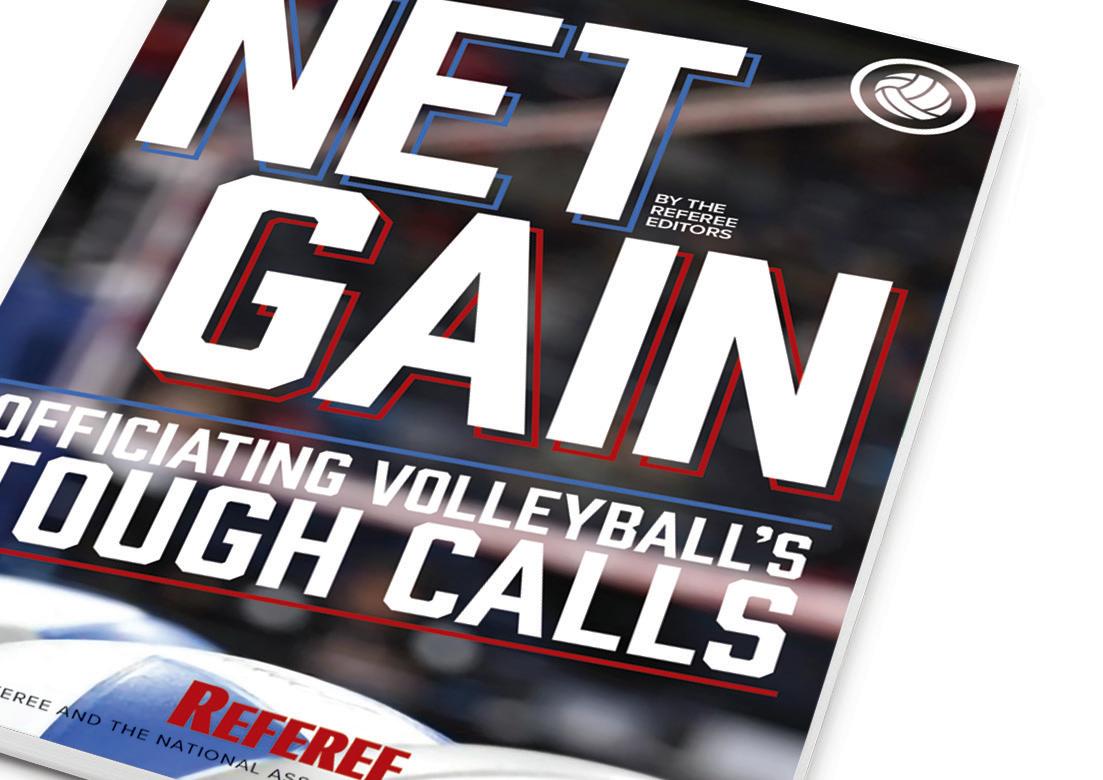


Approaching Injured Player’s Coach

Approach an available coach if a head coach is tending to the athlete. This is done sensitively as any injury is inherently upsetting. With appropriate options and information in hand, the R2 gently asks about the player considering the severity of the injury. If it’s clear an injured player can’t continue, the R2 might say, “Do you want a timeout, or who will sub in?” If there’s a chance of resuming play shortly, it’s reasonable to say, “Will
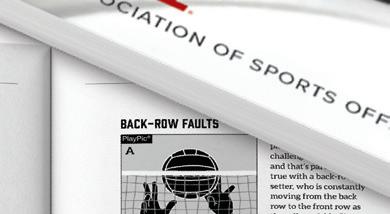
your player be able to stay in,” or “Do you want a timeout?” The R2 then chooses the way to present the need for a decision in 30 seconds for the player to remain in the set. Late in a set, with no timeouts available, the issue is deciding how much time to allow for play to resume or requiring the injured player to be replaced.

Correct Players on the Court

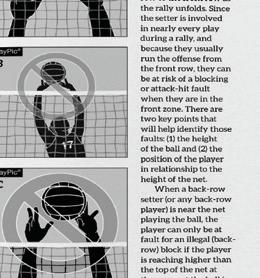
An injury is inherently upsetting. Once the injury situation has been resolved and players are back on the court, the R2 should conduct his or her own lineup check without a request being made. The R2 does this to avoid a team having made a libero replacement at the end of the rally that was not viewed by the libero tracker or was not allowed because the replay rule prohibited a replacement. This negates the R2 deciding whether to do a lineup check based on how long it took to resolve the injury or how upset the teams might be. The R2 partners
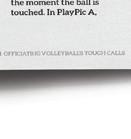
with table staff to ensure the players legally in the set are on the court and in proper positions so an alignment fault isn’t whistled because the table staff or coaches made a mistake. When a replay will be issued, neither team can request a lineup check, but common sense guides the R2 to provide an unrequested lineup check for teams.





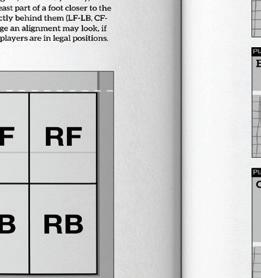
Before Resuming Play
The R2 ensures everything is properly recorded at the table and the visible score is accurate before turning the court back over to the R1. Even if the result of the rally was signaled after the injury was identified, the R1 will whistle and show the result of the rally. Rick Brown, Westerville, Ohio, is a longtime girls’ and boys’ high school referee, working 22 state tournaments. He is a state and local rules interpreter, USAV Regional Referee and formerly a PAVO National Line Judge, working multiple D-I postseason matches.
See why Net Gain is the best selling volleyball training book of all time. Improve your judgments around ball-handling, overlaps/ alignment, net play, and line calls. Mastering these areas will instantly help you be a better referee and help you make great calls with consistency and confidence.
Volleyball’s
STORE /VOLLEYBALL *NASO member discount available. 1395 * DIGITAL PRINT $2095 COMBO $1595 * SIZE: 5.5” X 8.5” PAGES: 80 judgments around ball-handling, overlaps/ Injuries continued from p.47
Master
Toughest Calls
GETTING IT RIGHT INSPIRATION, MOTIVATION, ELEVATION
All In (Pink) Perspective
By Joe Jarosz
College basketball conference tournament time is something special for everyone involved. The 2023 edition is one that will stick out in the career memories of four-time NCAA D-I men’s Final Four referee Roger Ayers.
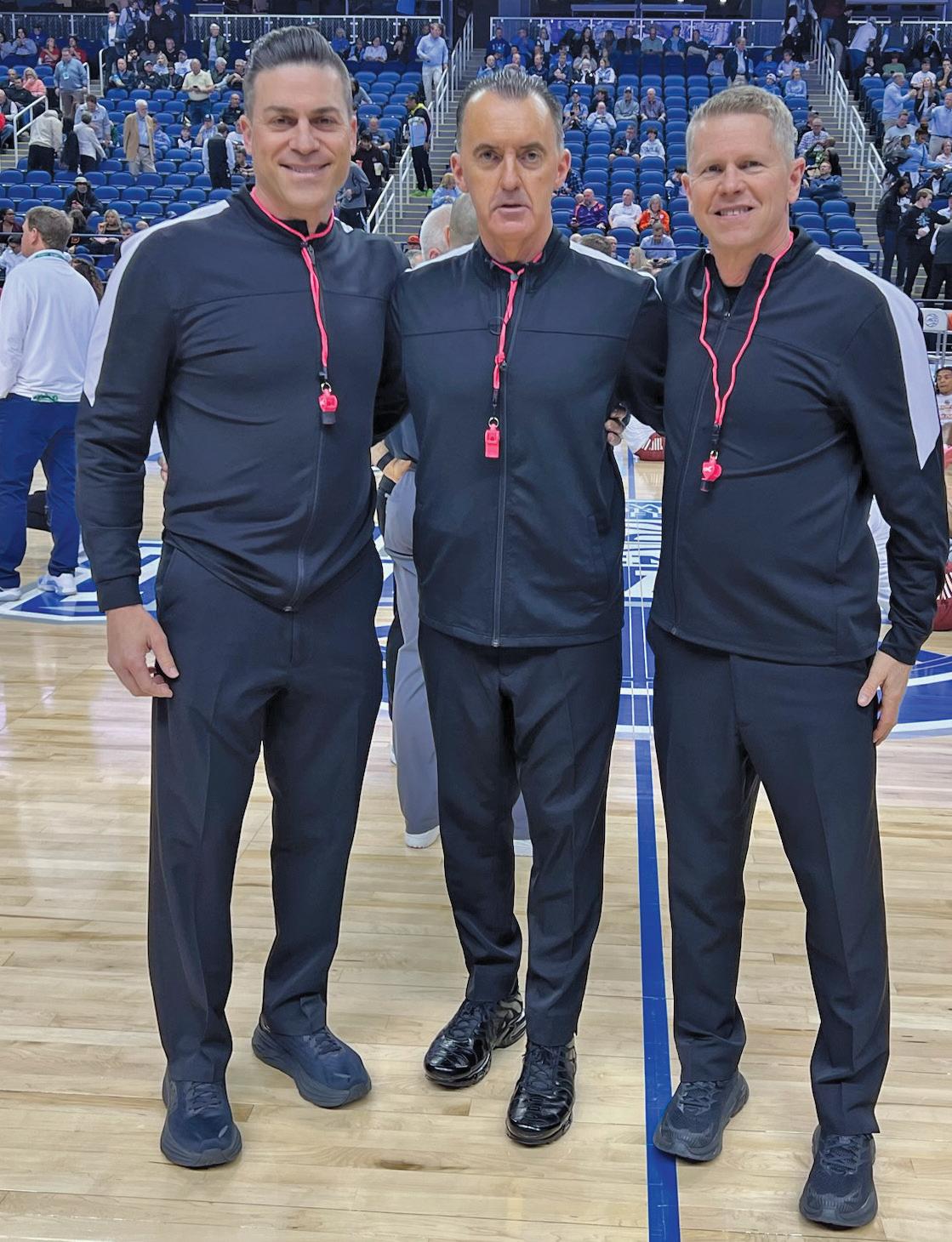
After a Feb. 16 game, while still in the officials’ locker room at XFINITY Center on the campus of
instead took the phone call from his daughter, wished the crew well and hit the road to attend to the issues of “real life.” A successful April surgery and ongoing treatment gives the family a positive outlook for Laken’s future.
Although he will never forget the memory of receiving that news on a cold, rainy February night and the accompanying tears rolling down his face that evening in College Park, Md., the deeply religious Ayers asserts, “God has a plan. I trust Him and I pray every day for her.”
Fast forward a couple weeks, and the tears Ayers would shed were regarding the same topic but surrounding an outpouring of support, instead of devastation. At a March 6 meeting of ACC men’s basketball tournament officials in Greensboro, N.C., supervisor Bryan Kersey announced officials working second-round games on March 8 would use pink whistles and pink lanyards in support of Ayers’ daughter and cancer awareness in general. ACC commissioner Jim Phillips signed off on the idea and Ayers recalls, “I just started crying.”
The next few days were flooded with supportive text messages and phone calls from various individuals throughout the officiating community and beyond. Laken’s phone was blowing up with text messages during the slew of tournament games on March 8.
The journey of the past few months has put basketball in perspective for Ayers.
Minnesota Says ‘Yes’
The Minnesota State High School League partnered with the Minnesota Vikings to host a football officiating clinic on May 6. The afternoon was tailored for individuals who have never officiated before and for those who are new to football officiating. Over 60 individuals participated in the event held at the Twin Cities Orthopedics Performance Center in Eagan, Minn. The afternoon was filled with presentations from experts in the football officiating community, networking opportunities, prize giveaways and more.
The state association provides extracurricular opportunities to more than 500 member institutions and 240,000 high school students. It oversees more than 8,000 registered contest officials and is committed to recruitment efforts like the May clinic.
SOURCE: MSHSL
Testimony in Topeka
Various stakeholders in Kansas appeared in front of the Kansas House Education Committee in January to demonstrate support for House Bill 2139, which would “create the crime of abuse of a sports official and provide criminal penalties therefor.”
Local officiating association leaders, assigners and active officials in uniform showed up in support of the legislative action.
the University of Maryland, Ayers got a devastating phone call from his 22-year-old daughter, Laken, who had been diagnosed with thyroid cancer. Ayers had just finished working a Big Ten men’s basketball game that saw the unranked Maryland Terrapins upset the nation’s No. 3-ranked Purdue Boilermakers.
Fully prepared for an extensive postgame breakdown with partners Doug Sirmons and Paul Szelc, Ayers
He was able to honor Laken at the ACC men’s basketball tournament by wearing the whole ensemble during the Boston College-North Carolina second-round matchup. Ayers summed up the experience, saying, “To hear her laugh and not cry — she was so happy that somebody was doing something for her and bringing awareness to this terrible disease. She is an amazing young woman and I am lucky to be her dad.”
Joe Jarosz is an assistant editor for Referee
Kansas State High School Activities Association Executive Director Bill Faflick communicated the state association’s support of the bill. He said, “The educational benefit of recess is not the same as the educational benefit of interscholastic activities. We need men and women to stand in the gap to officiate for the students in our school and in our communities.”
The bill remains in the house chamber and the committee is adjourned until January 2024.
SOURCE: KSLEGISLATURE.ORG
Have you heard an inspirational or motivational officiating story? Send your ideas to GettingItRight@referee.com
COURTESY OF ROGER AYERS
Roger Ayers, sporting his pink whistle and lanyard in support of his daughter’s cancer battle, is flanked by partners Lee Cassell, left, and Jerry Heater on March 8 at the Greensboro Coliseum.
50 | REFEREE August 2023

WHAT’S YOURPO?


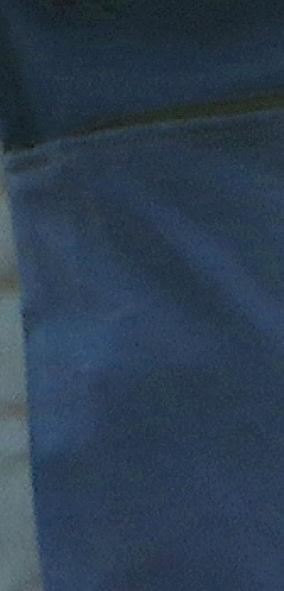









 BY DR. MAGGIE TIEMAN
BY DR. MAGGIE TIEMAN


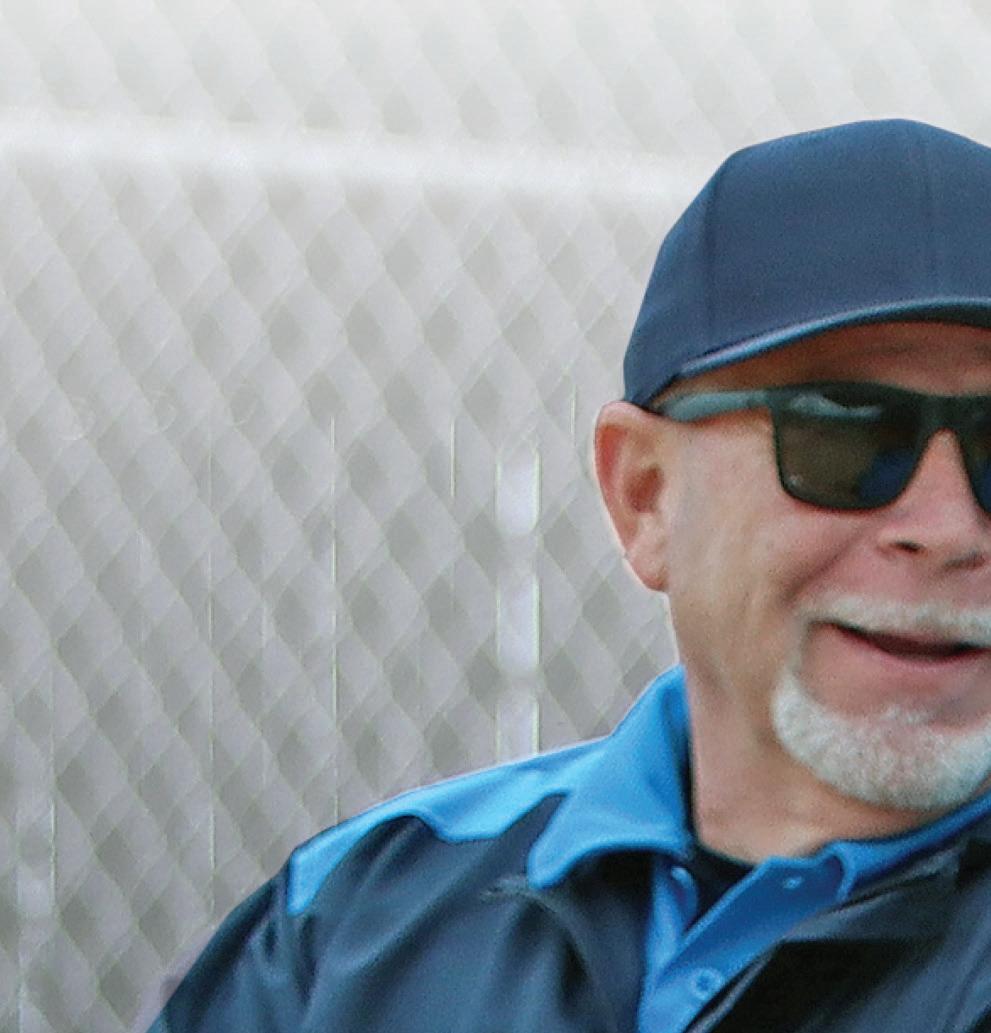 KEITH JOHNSTON (MATT PRUITT, GRAHAM, TEXAS; AMBER MILLER, ARLINGTON, TEXAS)
KEITH JOHNSTON (MATT PRUITT, GRAHAM, TEXAS; AMBER MILLER, ARLINGTON, TEXAS)
THE ABILITY TO UNDERSTAND YOURSELF — AND OTHERS — IS CRITICAL TO WORKING AS A TEAM AND FINDING SUCCESS ON THE FIELD OR COURT.
There are many Q’s in life. There’s IQ: intelligence quotient, a measure of reasoning and problem-solving abilties. Then there’s EQ: emotional intelligence quotient, the ability to understand and manage emotions.
But what about your PQ?
PQ refers to your personality intelligence quotient. It’s the ability to understand yourself and others for more effective partnerships and teamwork. If we only understand life from our own perspective, which is the most natural way to view things, we will often fail to communicate and work effectively with others. By knowing your PQ, you’ll be in a better position to lead others and empower officiating teams.
Answering the following two questions will start you on the path to discovering more about your basic style, what drives you, your natural perspective and real passion:
1. Are you more of an outgoing- or reserved-style person?
Outgoing: fast-paced, optimistic, energetic, involved, positive, enthusiastic. Their focus is on talking things out.
Reserved: slower-paced, cautious, more concerned, reluctant, critical thinking, discerning. Their focus is on thinking things through.
2. Are you more task-oriented or people-oriented?
Task-Oriented: function, form,
STEP 1: Are you more ...
programs, plans, projects, processoriented. Their focus is on getting things done.
People-Oriented: relationships, caring, sharing, emotions, feelings, friendships. Their focus is on other people and how they feel.
The answers to these two questions provide an extremely general idea related to the DISC Model of Human Behavior. Each letter (D, I, S and C) represents a main personality style. The DISC model is based on the fact most people have predictable patterns of behavior. The first pattern reflects whether a person is more outgoing or reserved. The second pattern reflects whether a person is more task-oriented or people-oriented. The two patterns can be visualized in two circular diagrams with opposing traits and then combined into one diagram as shown below. (Fig. 1)
Using the two general questions above, an individual can place him or herself in one of the four personality categories.
1. Outgoing and Task-Oriented: Dominant (D)
2. Outgoing and People-Oriented: Inspiring (I)
3. Reserved and People-Oriented: Supportive (S)
4. Reserved and Task-Oriented: Cautious (C)
It is important to note each person is a unique blend of these four styles
STEP 2: Are you more ...
RESERVED?
and these two questions do not provide a full and accurate report of one’s complete behavioral style. Full DISC reports can be obtained by working with a certified DISC trainer. Leadership must encompass all aspects of what is important to those who are leading, but also to those who are being led. Whether you are the R leading a pregame or an umpire who must bring the crew together during a timeout, no one ever tries to alienate or miscommunicate to his or her fellow partners. However, every leader will fall short in meeting the needs and expectations of the officiating team if all four leadership styles are not fully understood. It must become the goal for each of us to become aware of our own natural leadership style, the other three leadership styles and learn how to adapt in order to help the entire officiating team be the most productive each game day.
Learning and understanding these concepts will help officials create true crew dynamics. Encompassing every sport and every position, a person’s innate personality influences everything he or she does. If a partner tends to be more outgoing or reserved, it influences whether he or she is inclined to act or proceed more slowly. A person’s internal compass, whether they are more task-oriented or peopleoriented, influences his or her focus. The following section will describe each personality/leadership style and provide real-life responses from officials who work with the DISC.
STEP 3: Combine the traits
OUTGOING?
RESERVED?
D C I S (Fig. 1)
REFEREE August 2023 | 53
TASK ORIENTATED? PEOPLE ORIENTATED? OUTGOING?
TASK ORIENTATED? PEOPLE ORIENTATED?
Leadership Styles Revealed
D-Style Personalities/Leaders: FIRM
Whoever said, “When the going gets tough, the tough get going!” was really describing a high dominant personality. D-style individuals are self-starters who know how to make things happen. They will start the ball rolling in a straightforward manner and will exert control to get things done. A dominant leader adds value to a group by being a great motivator, organized and extremely focused on the end goal. Those who work with high-dominant-style individuals can remember not to take everything personally. D-style people want you to be quick, confident, productive, specific and driven.
Since they speak bluntly, they may seem harsh, but they simply want to get to the bottom line as quickly as possible. Don’t be surprised when the pregame begins exactly 60 minutes before game time and the tenor of the conversation is direct and decisive. This style of leadership simply means he or she takes initiative to move into action and directs others to move into action as well. Dominant-style leaders must remember not to push others, give time to process and think (when applicable) and use softer voice tones.
I-Style Personalities/Leaders: FUN
Inspiring personalities tend to be more open-minded, with a focus on relationships and influencing or persuading others. I-style individuals are outgoing, persuasive and optimistic. They interact well with others because they are flexible and energetic. An inspiring leader adds value to a group through encouragement, having a sense of humor and creative problem-solving.
This style of referee has a desire to engage with others and go where the excitement is. An I-style referee is ready to initiate interaction and involvement with others. A
locker room pregame led by an inspiring-style referee is filled with enthusiasm and a positive feeling. A contagious brand of optimism can rally others to become involved. The power of an I-style referee to influence and persuade is highly effective in situations of conflict and a great tool to deescalate certain situations. Inspiring-style leaders must remember to be organized, stay focused and be credible.
S-Style Personalities/Leaders: FRIENDLY
Supportive personalities tend to be dependable, with a focus on cooperation and sincerity. They prefer routine activities, are understanding, patient, easy-going and great at following through on projects. Supportive-style individuals can be
the desire to preserve harmony for his or her team. A supportive-style official can often be “the glue” that holds a crew together because he or she offers a genuine sense of warmth and caring. When you have the opportunity, take a seat, visit and see how they’re doing. Supportive-style leaders must remember challenges are OK, be confident and do not be controlled by FEAR (false evidence appearing real).
C-Style Leaders: FACTUAL
quiet, soft-spoken and have a gentler approach to high-stress situations. Supportive-style individuals add a measure of harmony that helps maintain a peaceful environment. Perhaps more than any other type, high Ss like supportive roles that are out of the spotlight but appreciate affirmation of their good work.
The value of a supportive-style leader to a group includes being a great listener, a team player and highly dependable. Given the supportive-style referee’s cooperative nature, pregame discussions are friendly and everyone’s feelings and opinions will be honored. He or she is motivated by a sense of loyalty and
Whoever said, “Measure twice and cut once!” must have been a high C-style person. Carefully exploring all options and studying all related information is highly valuable to the cautious-style individual. They will validate the quality of information and develop a procedure which will prevent mistakes. Careful attention to details and rigorous adherence to rules make the high C type enjoy detailed work. Cautiousstyle leaders add value to a group by providing objective analysis of a situation; however, this analysis usually will not allow for the feelings of the people involved in the situation. A cautious-style person who keeps to him or herself and neatly unpacks his or her bag in the locker room will be the same person who when presented with an atypical situation on the court will go to any length to achieve excellence.
A pregame led by this style referee is always thorough, logical and precise as he or she has a natural procedural approach and is more comfortable doing things in a step-by-step fashion. Cautiousstyle leaders must remember there is a person behind the task at hand, limit the number of details (when applicable) and smile.
54 | REFEREE August 2023 WHAT’S YOUR PO?
The value of a supportive style leader to a group includes being a great listener, a team player and highly dependable.
– S-Style Personalities/Leaders: FRIENDLY
Lead Like a Referee
Remember, everyone is a blend of these four styles. Dependent upon the environment, one personality may present itself more so than another. Each of us has a specific combination of these styles that can be discovered with the help of a trained behavioral specialist and/or sport and performance psychology professional. Knowing one’s personal leadership combination and using that specific information along with the benefits of all four styles is a recipe for crew success. Each style below has a description accompanied by real-life examples from referees who work with the author
D-Style Q&A:
We’ve all seen a directive leader/ referee in the locker room. He or she takes initiative to move into action, starts the pregame, finds someone if the locker room needs additional towels, or has no issues asking others to move into action. If you are working with a directive leader, you can expect some of the following traits: decisive, direct, dominant, determined, demanding and a doer.
D-Style Referee strengths:
• Ability to take control of various situations
• Intervene in difficult situations and make decisions that are sometimes not popular.
• Explain in a concise manner.
• Do not attach emotion to a situation.
What situations have you found yourself in because you acted or spoke “like you”?
• Tackling confrontation head on with an “I want to win” mentality, even when it wasn’t necessary.
• I tended to interrupt or add a comment because of my generally enthusiastic and upbeat demeanor and this was misinterpreted as being “too big for my britches.”
• When I tried to maintain sole control over a situation to speed up the process, it actually took longer. Micromanaging a contentious moment like a video review or a technical/intentional foul upgrade situation doesn’t lend well to the process and it actually makes the situation at hand take more time than it would if everyone were involved.
How have you seen yourself stretch or adjust beyond what is naturally comfortable during game situations?
• Ignoring comments/statements from coaches and players and listening more is how I have learned to adjust my D-style in officiating.
• Listening to partners during timeout/halftime/postgame situations without interrupting.

• Limiting body language and reducing large gesturing.
• Allowing others to have control during games, especially in situations that help others grow
• Involving others in conversations with the table/atypical situations and not trying to do it all myself.
When you failed to adjust your style, what situations/pitfalls did you find yourself in?
• Not being well-received by peers. In this profession, reputation
is important. Take time to create relationships, not everything is a task that needs completion.
• I knew the rule and knew I was right and after a little back and forth, I chose to say to the coach, “It’s the rule. Look it up.” I had the “I’m going to win this argument and show you I’m right” mentality. This is never an appropriate comment and I learned I needed to be humbler.
• As a younger official, I was quite bubbly and talkative. This, at times, was not received well by other D- and I-style referees. I needed to learn to lower my internal motor and listen more.
What actionable advice would you give someone working with you who is (1) your referee style, or (2) who is not your style?
• We must realize that we like to be in charge, so when one of us is not (crew chief), listening becomes the key to our success. On the floor, try not to get defensive if a partner asks for an explanation.
• Listen first, speak second. And listen with the intent to hear, not answer.
• Let things go I won’t always be right and don’t always need to have the last word.
• For a crew member working with me as a D, please know that I mean no disrespect, I just may be
REFEREE August 2023 | 55
DALE GARVEY
When working to build good crew chemistry, it’s important to understand not only your own personality style, but also the style of others. From left, Jeremy Lazowska, Seattle; Courtney Potter, Bellingham, Wash.
WHAT’S YOUR PO?
straight-forward and direct. If you need more time to process, just let me know. If I don’t know this about you, I will assume (wrongly) that you like to “talk things out” like I do
I-Style Q&A:
The inspirational leader/referee inevitably brings a positive feeling to the locker room and generates laughter and enthusiasm among the group. A natural sales person, this style referee can talk to anyone about almost anything. You can expect to see these traits if you work with someone who is an inspirational leader: interactive, involved, impressive, inspiring, influencing and impressionable.
I-Style Referee strengths:
• Confident but not arrogant.
• Using humor and positive motivation to engage partners.
• Optimistic approach to the crew’s success every night.
• Engaging officiating team starting from the pregame discussion.
• Inviting atmosphere where everyone feels a part of the team.
What situations have you found yourself in because you acted or spoke “like you?”
• I speak before listening and with officiating, it needs to be the other way around.
• Humor can be a great tool but tricky as sometimes it is misinterpreted. My humor was seen as being dismissive and arrogant.
• The need for validation/ recognition caused me to seek out conversations when they were not necessary (either with coaches or partners).
How have you seen yourself stretch or adjust beyond what is naturally comfortable during game situations?
• I have learned to answer questions not statements.
• I am a chatterbox and want everyone to like me, so I talk too much and people think I’m too laid back, which is interpreted sometimes as not caring or taking the situation serious enough.
• I have learned that I cannot just
start talking/explaining to a coach why I am right. I need to pause and listen first.
• Considering the coach’s perspective, rather than trying to convince him or her of mine.
When you failed to adjust your style, what situations/pitfalls did you find yourself in?
• When a coach was nasty to me, I chose to be nasty back and that was not the correct decision to de-escalate the situation.
• I like to talk things out and am very people oriented, so I have shared feedback or thoughts without thinking first and partners have gotten offended.
What actionable advice would you give someone working with you who is (1) your referee style, or (2) who is not your style?
• Less talk, more listen!
• I like to talk. Please know I am not trying to be annoying; I just really want to get to know you.
• I sometimes lose track of time so if we need to start the pregame or do something that is more taskoriented, just let me know, I won’t be offended.
• Let’s be sure to have some fun
• I will most definitely ask the crew for input, so be prepared to participate in the pregame discussion and in-game communications.
S-Style Q&A:
The supportive leader/referee is always ready to (not surprisingly) help others whenever called upon. It is important to reread that sentence as it says, “when called upon.” This is an important distinction within the referee environment. Always be sure to take the time to ask a supportive-style colleague what his or her opinion is and provide them the time to answer (this may not always be possible during competition). The main motivation for a supportive leader is to create peace and harmony within the environment. Often difficult in a profession that is adversarial, but this style leader can be the glue that holds groups together because he or she offers a genuine sense of caring for
those involved. Traits of a supportive leader include: steady, stable, statusquo, shy and sweet.
S-Style Referee strengths:
• Supporting fellow referees both in action and words.
• Listening to the whole situation before speaking.
• Helping to create a calm, fair and balanced environment.
• Ability to de-escalate coaches and players because of composed demeanor.
What situations have you found yourself in because you acted or spoke “like you”?
• I tend to avoid confrontation and uncomfortable situations with coaches.
• I don’t feel the need to talk a lot so sometimes people see me as shy/meek and wrongly label that as incompetent.
• When I do not address coaches’ concerns due to my dislike of conflicts, coaches get increasingly frustrated which makes me even more uncomfortable.
How have you seen yourself stretch or adjust beyond what is naturally comfortable during game situations?
• Being more vocal about primary coverage area issues during timeouts.
• Initiating conversations and expectations with the crew, even though it may be personally uncomfortable to bring up a negative.
• Making the tough decisions confidently, being clear and concise with expectations
• When I am not the referee on the crew, I still know I need to make my opinion heard, especially when I know something isn’t accurate.
When you failed to adjust your style, what situations/pitfalls did you find yourself in?
• When I don’t speak up, I feel my partners don’t trust me and wouldn’t try to get to know me more.
• In a close game, we had a layered play with several technical and intentional fouls. We got together as a crew and the R, who was a dominant-style person, was going over the procedures and what we
56 | REFEREE
2023
August
were going to do and at the end says, “We’re going to give the ball to white.” I was fairly confident the ball should have gone to black, but because I didn’t want to rock the boat or ruffle any feathers, I didn’t speak. So the wrong team got the ball, scored at the buzzer and won the game.
What actionable advice would you give someone working with you who is (1) your referee style, or (2) who is not your style?
• To my fellow S, don’t be so passive, be more assertive and vocal. It’s always better to say something at the time then reflect after and say, “I wish I would have been more. …”
• When working with an S style, create a sense of unity as this creates trust. Provide positive reinforcement no matter how big or small because it gives security to an S and makes him or her comfortable and confident to perform well.
• I would kindly ask them to think about how much they are talking. Can they be more encouraging, less intimidating by creating a more team atmosphere?
• Get comfortable being uncomfortable as this game is never steady.
C-Style Q&A:
The cautious-style leader/ referee always makes sure everyone is following the right procedures and protocols. Wouldn’t it be great to have a cautious-style referee on every crew as it is a pretty good assumption, he or she knows the rulebooks inside and out! Driven by logic and what makes the most sense (to him or her), the cautious-style leader will use a procedural approach to problem-solving and carry out the task correctly and with precision. The traits most often associated with this style of referee are competent, conscientious, careful, cautious, calculating and contemplative.
C-Style Referee strengths:
• Knowing the rules and mechanics.
• Following directions
• Controlling emotions
• Having no desire to be noticed, just do a solid job.
What situations have you found yourself in because you acted or spoke “like you?”
• I have trouble bringing up a crew issue or a game aspect that needs addressing because I stay too quiet.
• I “stay in my head” too much versus talking it out with the crew.
• Because of my quiet nature, I appear to be unapproachable at times. I stand during pregames going through a checklist in my head and miss opportunities to connect with partners, players or coaches.
How have you seen yourself stretch or adjust beyond what is naturally comfortable during game situations?
• I have learned to address coaches sooner rather than listening for so long. Listening is important, but earlier in my career I didn’t answer the question (even though I knew the answer).
• Getting beyond the uncomfortable feeling of engaging in discussion with coaches.
• I have to force myself to be more vocal even though it’s not comfortable for me.
When you failed to adjust your style, what situations/pitfalls did you find yourself in?
• I was overthinking and overanalyzing, and as a result I was not reacting to plays and making
calls. This led to an appearance of uncertainty on the court.
• Taking too much from a coach throughout the game so by the end, we had quite a situation.
• A coach, player or partner thinking I am shy, rude, dismissive, arrogant, because I do not initiate conversation.
• Not being prepared during a pregame when the (crew chief) asks for input. I normally wouldn’t say anything unless a rule or interpretation was stated inaccurately.
What actionable advice would you give someone working with you who is (1) your referee style, or (2) who is not your style?
• For my fellow C’s who like order, steps and procedures, don’t be afraid to speak up if the crew is not doing something correctly, even if you are the U2. Bring up what doesn’t feel right and what you think the crew should do.
• For the D and I referees, I would like you to know that I enjoy you taking control and/or talking, but that doesn’t mean I don’t know what is going on. Allow some time for us C’s and S’s to process and contribute.
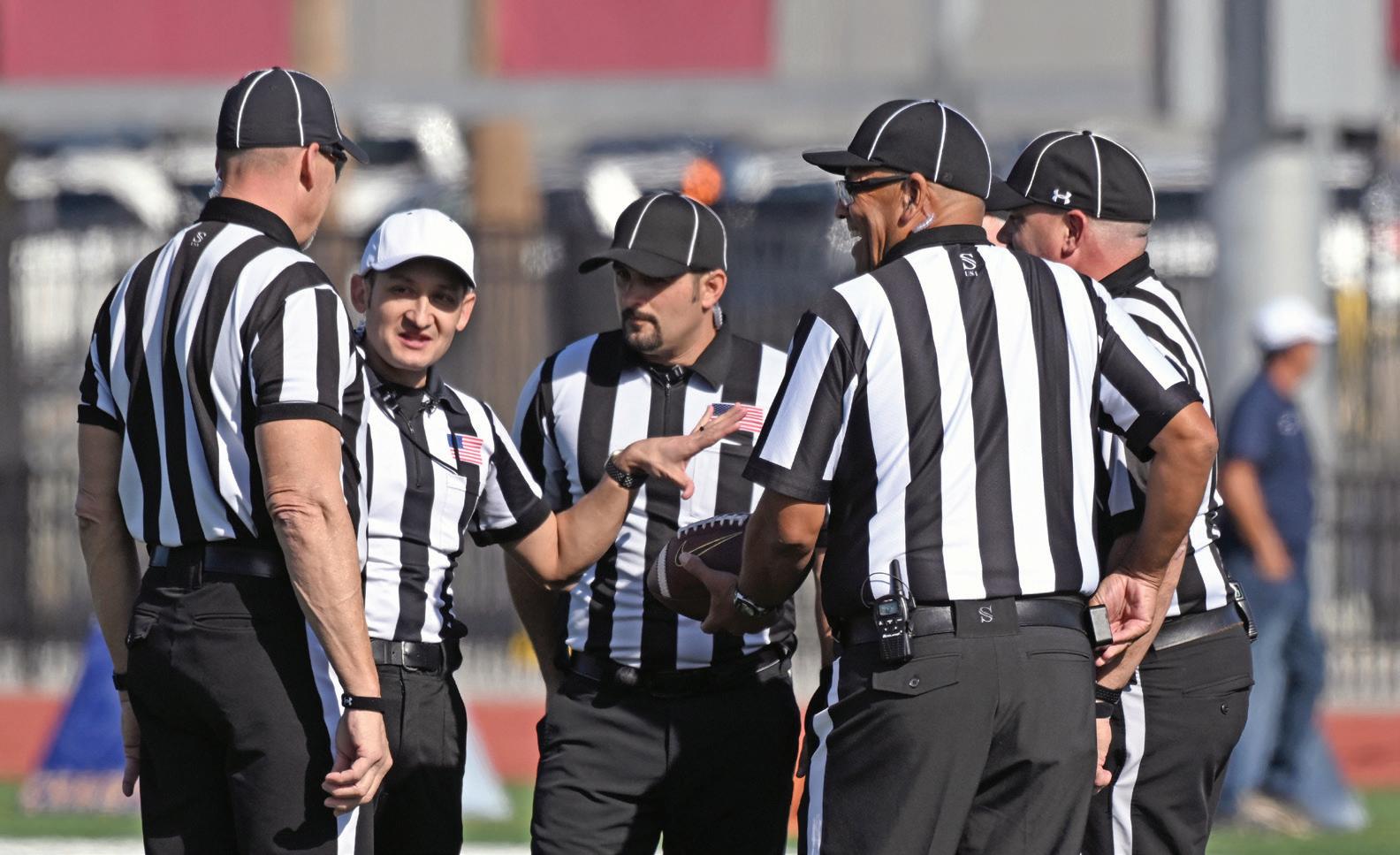
• If I don’t have much to say in a pregame, don’t take it as disengagement or lack of knowledge. I don’t feel the need to add on if it’s already been covered.
Dr. Maggie Tieman is a sports and performance psychology professional, founder and owner of Mindset Matters, LLC, who resides in Rochester, N.Y. She officiates NCAA D-I women’s basketball.
REFEREE August 2023 | 57
HESTON QUAN
Inspiring a crew to perform at its best requires an approach that takes into account how each member of the crew operates. From left, Richard Rosette, San Fernando Valley, Calif.; Matt Arellano, Riverside, Calif.; Joseph Renner, Nipomo, Calif.; Kent Bukaru, Kailua, Hawaii; Dana Furman, Antelope Valley, Calif.
WELL AWARE Read, Understand and Manage Challenging Situations
By Karen Swanner
Soccer matches and life have some uncanny similarities. The world as we know it constantly evolves. There is continuous change and new “situations” that present themselves. The same is true for a soccer game, which evolves from start to finish, with new challenges and new situations to manage as the game progresses.
The question is, why can some referees recognize, read, adapt and manage these changes better than
others? Why do some officials have keen situational awareness and can understand, cope and manage the game as it continues to evolve? Why can some officials adapt their style and the way they are managing the game versus staying status quo, while dealing with change? Why do some officials thrive on change, while others decompose when there is a lack of consistency? Do officials react to new “situations” the same way they react to change in their everyday lives? Are these skills innate or learned? Is
it based on experience, knowledge, confidence, problem-solving ability or something else?
Lindsay Kennedy-Eversmeyer, the head men’s coach at Southwestern Illinois Community College and one of the few females to ever play men’s professional indoor soccer, believes these skills are innate.
“I think how officials, players and even coaches perform in changing situations is indicative of how they were raised, and the level of soccer and environment they have been
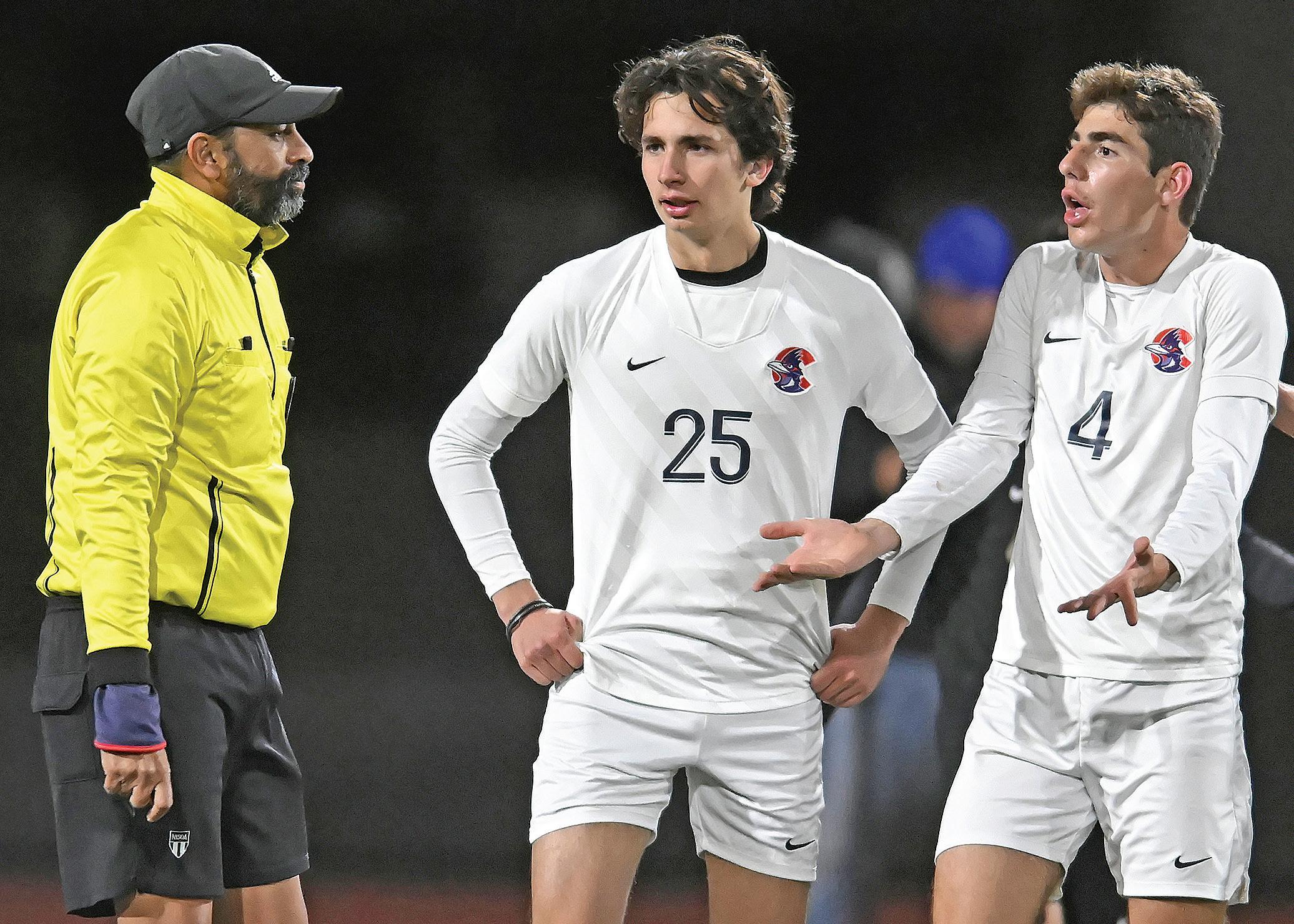
58 | REFEREE August 2023 COORDINATOR: JOHN VAN DE VAARST jvandevaarst@referee.com SOCCER RULES, MECHANICS, PHILOSOPHY
HESTON QUAN
Recognizing signals from players is just one example of how to stay on top of in-game situations. Ashbir Singh, Stanton, Calif.
exposed to,” she said. “I believe that I am more comfortable because I grew up playing soccer with guys, so I have already been put in high stress situations, therefore I understand how to better deal with them.”
But is it really that easy for all of us? The concept of situational awareness was first derived from the aviation industry, where pilots, air traffic controllers and other key aviation personnel have to make split-second decisions in highpressure situations with significant consequences. Sound familiar? While the outcome of a soccer referee’s decisions may not be as impactful as an airline pilot’s, the significance of soccer referees making split-second decisions in high-pressure situations is essentially the same.
The concept of situational awareness is simply one’s perception of the elements in the environment, comprehension of what they mean, how they relate to each other and prediction of the future outcome. For soccer officials, in order to maintain an adequate awareness of what is happening, we need to be able to track the development of events as they gradually unfold, adapt to these developments, understand why they are changing and manage the game based on that evolution. If referees cannot manage that changing situation, it can easily be exacerbated. The classic example is a player fouling someone in the second minute of the match and at the 70th minute the player who got fouled now commits serious foul play “out of the blue,” or the striker who has gotten kicked in the ankles numerous times while you awarded advantage now turns around and pushes a player who commits a simple foul against him. Understanding these cues are great examples of situational awareness.
As referees we are exposed to different environments, challenges, pressure and situations during every match, which can ultimately change the way we make decisions. There are situational factors that can influence officials even before we arrive at the game. Things like running late because of traffic,
having a bad day at work, forgetting some equipment, lack of sleep, personal injury or having a falling out with a friend or family member. Then there are other factors like weather, venue, level of the match, size of the crowd, familiarity with teams, consequences of outcome, crew, experience, knowledge of the rules, fitness level, personality of coaches and players, your communication skills, lopsided scores, overtime versus regulation or player’s gender, which can all influence the “situation.”
“I think the success and failures of some officials in certain situations stems from a power dynamic,” said Principia College women’s head coach Samuel Thomas, who believes officials need to understand and embrace their roles. “When training officials, especially younger ones, they need to be comfortable knowing that they are decision makers, in a position of authority and stand confident when making their calls regardless of any dissent.
“While I don’t believe any official is thinking ‘power dynamic’ when making a crucial decision in any evolving situation, I think it is based more on an intuitive process of recognizing and understanding the process,” he said. “Every interaction is a reflection of the interactions and relationships that have preceded it. Hopefully by the second half of every game, the referees have a clear understanding of how the situation is evolving and what their role is in managing that change.”
Several tools can help officials have better situational awareness and the skill set to more successfully adapt and manage every situation they face. These include reaction/ response, cognitive recollection, practicing naturalistic decisionmaking, experience, game reviews, information sorting, feedback/peer reviews and journaling.
As human beings we react every time we experience change. It is innate based on how we feel about something at the moment. Every reaction is followed by a response. How we respond after that initial reaction determines the choices we
SIDELINE
MASL Names Referee Award Recipients
The Major Arena Soccer League (MASL) announced Kyle Trimble as the recipient of the Gino D’Ippolito Referee of the Year Award and Lorenzo Hernandez as the Ron Cory Newcomer Referee of the Year Award.

Trimble was voted the award recipient by his peers. He is a former goalkeeper in the league and shortly after his playing career ended, he started refereeing in the MASL during the 2010-11 season. A former U.S. Soccer National Referee, Trimble still does high-level collegiate games and local games in Wisconsin. He has over 150 games on the floor in the MASL. Hernandez is a current National Referee for U.S. Soccer and is experienced at the professional and international outdoor levels.
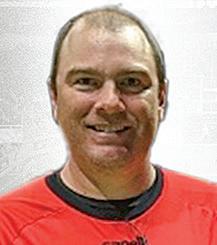
DID YOU KNOW?
A field player may exchange places with the goalkeeper. This must be done during a stoppage and the field player must change into a jersey of a distinct color. The goalkeeper must put on a jersey that matches the rest of the team and has its own number.
THEY SAID IT
“We will have referees at the World Cup in Australia and New Zealand, from Mali, from Togo, from Kyrgyzstan, from Palestine, who have been selected based on their qualities. While their teams have not qualified, their referees have, and so offering even more opportunities for women in football.”
— FIFA Head of Refereeing Kari Seitz, while discussing the diverse nature of FIFA Women’s World Cup referee pool at the World Trade Organization meeting in Geneva, Switzerland, in May.

REFEREE August 2023 | 59
Trimble
COURTESY
(TRIMBLER AND
COURTESY OF FIFA (SEITZ)
Hernandez
OF MAJOR ARENA SOCCER LEAGUE
HERNANDEZ)
TEST YOURSELF
In each of the following, decide which answer or answers are correct for NFHS, NCAA or IFAB rules/Laws. Solutions: p. 81.
1. A3 takes a penalty kick and kicks it over the crossbar. B2 encroached so the referee awards a rekick. A2 takes the ball and identifies as the kicker.
a. Illegal; A3 must take the rekick.
b. Legal since this is a new kick.
c. Legal provided the referee is advised by the coach this is going to occur.
2. Team A is awarded a direct free kick close to the opponents’ penalty area. While the referee is setting the required distance between the ball and the wall, an attacker takes the free kick and passes the ball to a teammate who scores a goal.
a. Goal.
b. No goal. Indirect free kick for the defense.
c. No goal. Retake the kick.
3. The referee awards a direct free kick for team A near the touchline. B2 runs from the far side to near the center of the field and yells there was no foul.
a. Warn B2 not to interfere with the match.
b. Ignore the comment.
c. Caution B3 for dissent.
4. A2 is in an offside position at the moment A3 kicked the ball toward the penalty area. A2 moves and deliberately holds B2. A4, who was onside, receives the ball and scores a goal.
a. Goal.
b. No goal. Offside.
c. No goal. Direct free kick for team B for holding infraction.
5. A defensive wall of four players is established. Attacker A2 lines up a yard from the wall. Just prior to the kick, B3 joins the wall and now A2 is no longer a yard from the ball.
a. Allow the kick since B3 caused the infraction.
b. Stop play and move A2.
c. Caution B3 for creating the situation.
make and therefore the outcome. Responding is the path we choose to move forward. It’s a conscious decision that we can control.
Our friends in the aviation industry learn to perfect their responses through cognitive recollection: Simply put, remembering the “how to” handle the situation from their past experience. Things like driving a car, raising your children, responding to direction from your boss, tying your shoes or even deciding what equipment to pack in your referee bag. These are all simple examples of things you have learned and have now become innate with practice, because these memories or responses are stored in your brain. Over time that initial reaction leads you to the path of a proper response.
Officials can use naturalistic decision-making to help them achieve better reasoning ability. This practice allows officials to access knowledge from their long-term memory, so they can more readily recognize relevant cues, which leads them to the correct response when facing a “situation” in a game.
Naturalistic decision-making is based on practicing in a real game or natural setting where referees will face challenges that are familiar and some that are not. Too often officials read a book, take an online test, attend a class and run on to a field to referee with no onfield experience. Through this naturalistic decision-making process, officials will practice how it feels to succeed and how it feels to fail, in a real game environment, where they get the chance to “practice” their decisionmaking skills, based on their previous knowledge and cognitive recollection.
The key is to experience these changing situations and learn from them. Officials need to reflect on what choices they made and the outcome of their decisions. Before their next match, referees should understand what changes they made, how they handled the situation the next time and whether or not the outcome changed or remained the same.
Experiencing many situations as a referee is key for understanding how to sort through the information presented to them to make those decisions. Referees need to be able to search for “cues” that will prompt our cognition on what is brewing and how we are going to manage it. Novice decision-makers often overlook or don’t understand the important information players and coaches are presenting to them on the field. Experienced referees have a better ability to discern important versus irrelevant information in their decision-making processes.
One of the best things officials can do to increase their situational awareness is to become a “student of the game.” Watch games either by yourself or with other referees and see what decisions the officials make. Talk to your peers and ask them what decisions they would have made in the same situation. Understand they may have more or less experience than you and may have a different level of cognitive recollection that brought them to their decision. Ask them why. One of the best ways to learn about the game is from a jury of your peers.
Journaling is also important. Take a notebook to the field with you or have one at home where you can write down your reflections from the game. When facing a specific situation, note how you reacted, how you felt about it, how you responded and the outcome. Do it for games you felt were successful and for games you thought you may have failed. Learn from it, remember how you felt through the process and how those feelings dictated your response on the field and when you went home. Learn from your failures and your successes and always remember to use the tools in your toolbox to bring the best of who you are to the field every game.
Karen M. Swanner, Maryville, Ill., officiated men’s professional soccer. She is a NISOA National Referee Emeritus. Swanner has master’s degrees in journalism and kinesiology, specializing in sports psychology and is a member of the Association of Applied Sports Psychologists.
60 | REFEREE August 2023 SOCCER
5 MINUTES WITH DANIEL RADFORD
Officiating Experience:
Joined USSF as a teen and quickly advanced to working high school and college matches. Officiated seven NCAA Final Four tournaments, three NAIA National Tournaments and the 2021 NCAA D-I men’s College Cup final. Officiated in many pro leagues, including the United Soccer League, North American Soccer League and Women’s Professional Soccer, and currently with MLS as a video assistant referee. He is the referee representative to the NCAA Soccer Rules Committee.

REFEREE: What do you think are the reasons for referees not continuing year after year?
RADFORD: The main reason is the relationship between referees and the sidelines at a game. Our newer referees are often younger in age and are still working to mature their communication skills and be confident on the field, while still trying to call a good game and learn the rules. Everyone is trying to learn, players and referees alike. However, the commentary and behavior coming from spectators and coaches, especially in these youth games, is getting in the way of all of that. It often rises to the level of verbal harassment and abuse and no reasonable person is going to want to remain a target of the inappropriate behavior. We will never have enough referees, not even close, if officials continue to be treated so poorly. And with no officials, the kids suffer the ultimate price no games. We also need to make sure we aren’t burning out the officials we already have in the system. Officials
of every age have demands, whether it’s school, friends, family or their other occupations. While we appreciate the extra miles officials go to cover so many games, being overworked isn’t a good balance for anyone.
REFEREE: What are some of your ideas on a revised curriculum?
RADFORD: I think we start with something that is shorter and specifically targeted at a newer officials’ most likely point of entry. Right now, I think the lowest level curriculum available is endless PowerPoint slides with a long rules test. I would like to see a more plugand-play format with built-in checks for understanding. Then I think we get officials on the field with dedicated supervision where immediate feedback can be provided. These advocates can also support the games by making sure problems don’t get out of control with the sidelines. If we put proper presence and guardrails in place around an official’s early experience on the field, we stand our best chance for growth, development, and satisfaction.
... Many of our newest officials are teenagers and individuals in their 20s, a generation that I believe has grown up with more communication occurring through technology than in person. You can’t officiate a game via text, Facetime, or Zoom, therefore, our ongoing curriculum should focus on proper and effective and professional people and personality management.
REFEREE: What are some of your ideas on recruiting new officials?

RADFORD: We need to better amplify everything that is great about officiating. Nearly all officials who invest in their craft have many great experiences like traveling the country and meeting new people while making money on a flexible schedule. If we can make it easier to sign up and become trained, and use technology and marketing in the right spaces to get the word out to a broader audience, then we can see our numbers grow and the games better served. There is also more opportunity now at every level than ever before for officials to take advantage of whether it’s high school and youth games or college and professional games. Let’s tell more positive and humanizing stories about referees in the foreground, of which there are many, and diligently tackle the barriers facing officials, especially our newest ones, at the same time.
ASSOCIATION SOCCER LAWS SIMPLIFIED

Take a look at nine aspects of the IFAB Laws that are often a source of confusion for fans, players, coaches and officials at the amateur level.

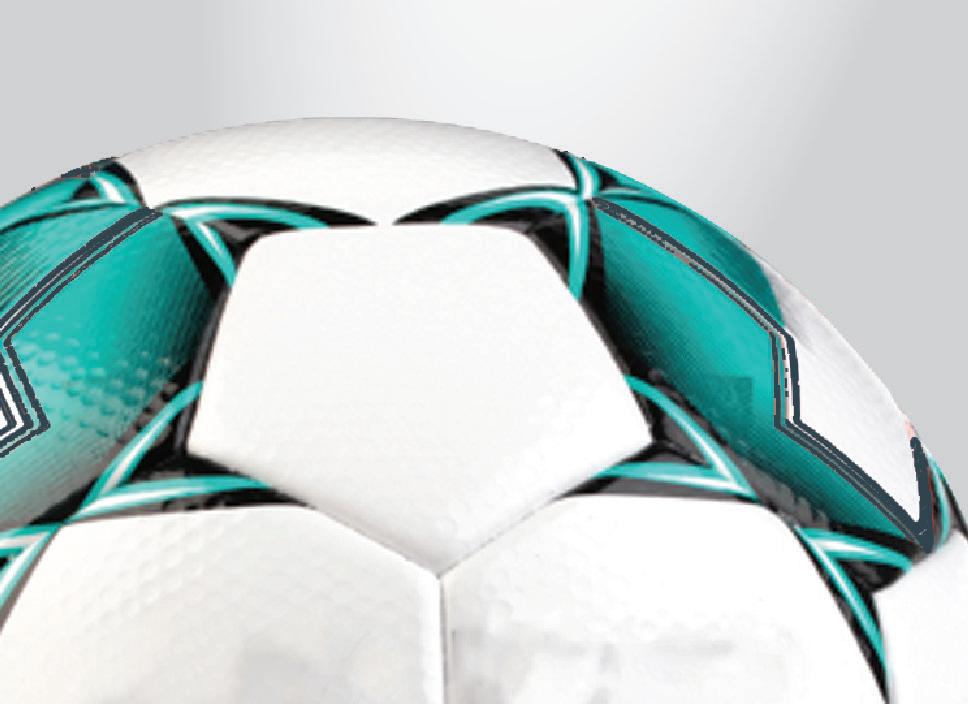 United States Youth Soccer Association Senior Manager of Referees discusses recruiting and retention.
United States Youth Soccer Association Senior Manager of Referees discusses recruiting and retention.
SOCCER
TODAY! Store /SOCCER
5.5”X8.5”
*NASO member discount available. $395 * DIGITAL PRINT $795* COMBO $595 * COURTESY OF PRO
ORDER
SIZE:
PAGES: 20
CASEPLAYS
Stop the Violence
Play: A4 is on the attack and is tripped by B2. A4 retains possession and the referee clearly indicates advantage. A4, out of frustration, picks up the ball and punts it into B2’s face. Ruling: A4 is to be ejected for the violent play. The match is restarted with a direct free kick for team B. The referee must take complete charge during this incident to prevent retaliation or other situations developing prior to the restart (NFHS 12-8-2a; NCAA 12.7.4.1; IFAB 12.3).
Arm Barred Play: A2 takes a position between B2 and the ball that is close to the corner area, within playing distance of A2. B2 approaches the attacker (without pushing the opponent) and A2 uses an arm to hold off B2. There is contact between the players. Ruling: The referee stops play and awards a direct free kick for team B. A player may not hold off an opponent with the hands or arms (NFHS 12-3-1; NCAA 12.1.9; IFAB 12.1).
Ready, Not Ready
Play: Team A scores a goal. The ball is brought to the center spot for team B to kick off. All team A players are in their half of the field and outside the center circle. Team A players are still celebrating the goal. The referee sounds the whistle for the kickoff. B2 takes the kick, shoots on goal and scores since the goalkeeper was busy celebrating and not paying attention. Ruling: All players were in a proper position so a goal is scored. The referee should have delayed the whistle until all defensive players were ready for play (NFHS 8-1; NCAA 8.2; IFAB 8.1).
Heels Play: During a throw-in, the feet of A2 are on the field of play. Only the heels are barely on the edge of the touchline. Ruling: This is a legal throw-in provided the heels do not leave the ground. It is a legal throw-in if any part of both feet are touching or behind the touchline (NFHS 15-2; NCAA 15.2.1; IFAB 15.1).
NCAA Mandates New Uniform Beginning in 2023
By John Van de Vaarst
TheNCAA Soccer Rules Committee recommended a standard uniform at its 2022 meeting. In April 2022, the Playing Rules Oversight Panel approved the concept and implementation of a consistent uniform for college soccer officials.
Beginning with the 2023 regular season, officials shall wear the NCAAestablished uniform, which is outlined below. This will be the official and required uniform for college soccer.

The NCAA recognizes a mandated uniform places a financial burden on officials. However, they have put considerable thought into this first-time mandate to modernize and distinguish the intercollegiate uniform. Further, the NCAA is committed to this design being a long-term solution that will not change in the near future. The official uniform offers three color options (orange, purple and yellow) in short and long sleeves in both men’s and women’s cuts. Black socks, black shorts and shoes that are predominantly black also must be worn. These uniforms became available for ordering on May 15 through three manufacturers.
Each manufacturer allowed for orders beginning May 15 and notified customers the estimated delivery times upon ordering, which could be more than six weeks. Orders should be placed with sufficient amount of time to allow for delivery in time for the start of the 2023 regular season. The 2023 Regular Season/Postseason Uniform: NCAA-approved orange, purple or yellow uniform shirt (no variation in the color or style of this uniform is permitted); black socks; black shorts; shoes that are predominantly black.
Several uniform suppliers placed the order information on their websites. It is up to the individual official to decide which supplier they wish to purchase from.
It is important that all referees look professional when entering the field of play. First impressions are lasting. That includes shoes that are polished and do not have dirt or mud on them from a previous match. Socks are to be pulled up and the team should have an appearance they are ready to begin the game. Also, prior to entering the field, referees should take a final check to make sure they have all the required equipment (whistle, watch, coin, paper, pencil, yellow and red card). If audio equipment is being used, the batteries should be checked to ensure everything is working properly.
Over the past several years referee uniforms for intercollegiate matches have been created and modified by referee organizations. National Intercollegiate Soccer Official Association and the Elite College Soccer Referees each had their own uniform options. Some conferences also have their own uniform requirement.
Multiple uniforms created a situation where at almost every game the referees looked different and there was no consistency with the uniform worn. On some occasions, referees even wore uniforms that were established for matches played under the IFAB Laws of the Game. This required the officials to bring multiple uniforms to every game to ensure the referee team assigned would look alike.
John Van de Vaarst, Ellicott City, Md., is a NISOA National Clinician, National Assessor and former State Level USSF Referee and Assessor. He is Referee's soccer coordinator.
62 | REFEREE August 2023 SOCCER
THE FAQ FOR NEW OFFICIALS

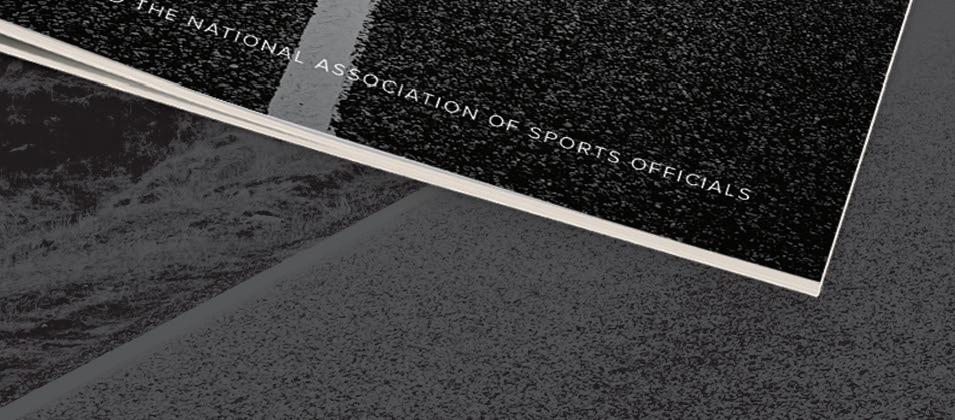


Year One guides new officials through their first year of officiating so they have a positive experience and keep coming back for more.
We can get new officials. The struggle is getting them to stick with it.



We need to prepare new officials better and Year One is vital to that effort.
It tells them what to expect and it guides them through what they’ll face in their first year.
learn more at STORE /year-one


– mark uyl executive director






LARGE GROUP BUYING DISCOUNTS AVAILABLE STARTING AT JUST 10 COPIES

OR FOR MORE INFORMATION CALL 1-800-733-6100
Size: 5.5” x 8.5” Pages: 32 *NASO member discount available. $395 * DIGITAL $595 * PRINT $795 COMBO
SAFE HAVEN? NOT SO FAST! Batters Must Be Wary of Interference, Even If in the Box
By George Demetriou
In a recent high school game, with a runner on first who was stealing, the batter swung at a pitch, missed and stepped over the plate, unintentionally blocking the catcher from making his throw to second base. The umpire immediately called the batter out and returned the runner to first. At that point, the batter looked at the umpire with his jaw wide open, a look of total disbelief on his face, while the coach shouted, “I told you to stay in your box. You own the batter’s box.”
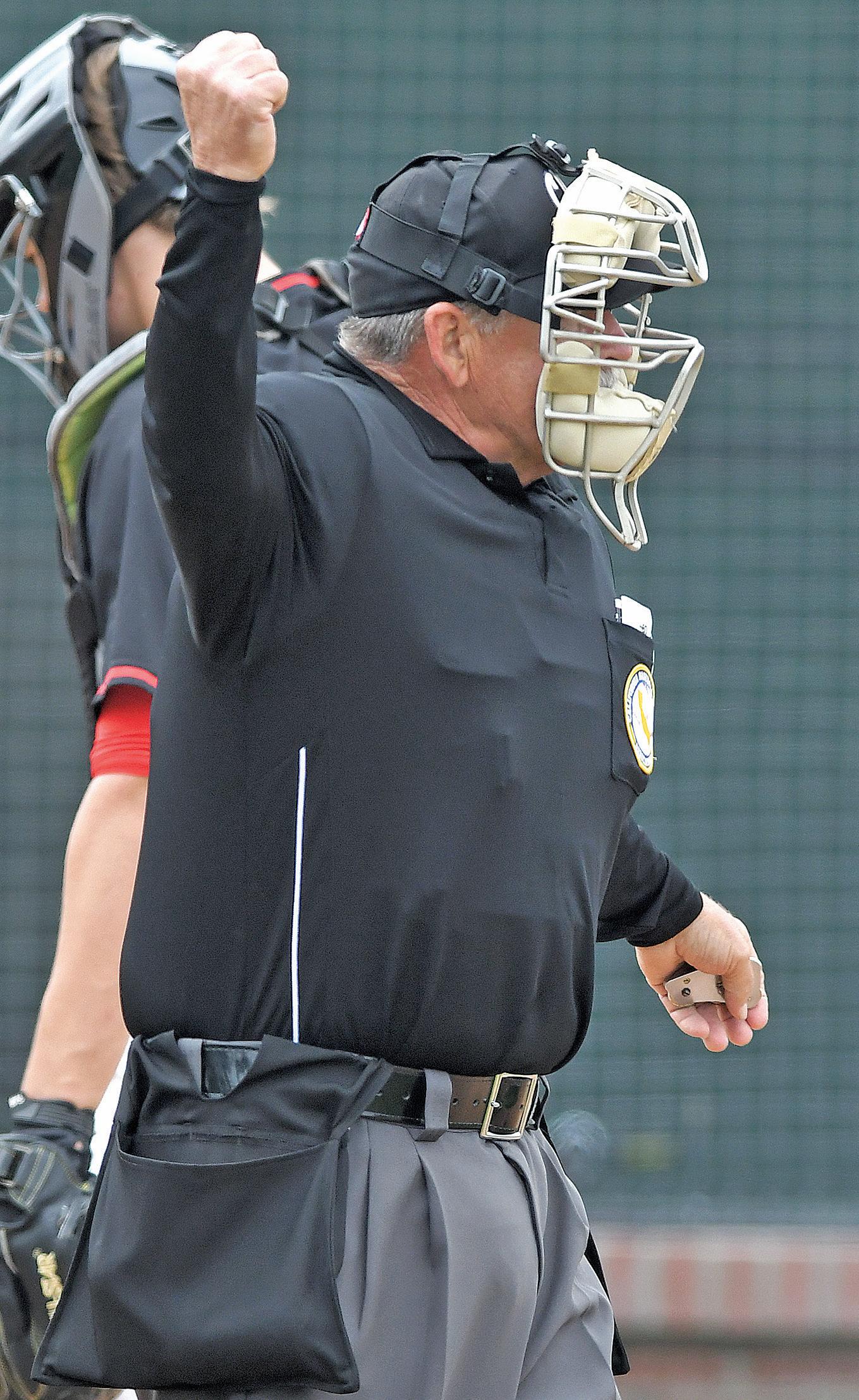
The coach was half right. He was correct in teaching his players to stay in the box while batting, but they don’t “own” the batter’s box. We can interpret the coach’s message as the batter can do no wrong while in the batter’s box and that, of course, is not true. While the box provides a degree of protection for its occupants, it is not an absolute safe haven, and there are multiple ways a batter can interfere with play while remaining on his “property.”
The subject of batter interference is very broad and there are many ways a batter can interfere as he comes out of the box, so we’ll limit this column to events that occur while the batter is still on his land. Except where noted, the material applies equally to NFHS, NCAA and pro rules.
Double Contact
The box provides the batter absolute protection if his bat hits the ball twice or the ball hits him after he has batted it. In either case, it is simply a foul ball (NFHS 2-16-1g, 5-11b, 8-4-1d2; NCAA 7-7e; pro 5.09a7).
After hitting or bunting a fair ball, if the bat, still held by the batter, hits the ball a second time in fair territory with the batter outside the batter’s box, it is interference (NFHS 8-4-1d; NCAA 7-11m; pro 5.09a8). Also, when
64 | REFEREE August 2023
HESTON QUAN
RULES,
EDITOR: SCOTT TITTRINGTON stittrington@referee.com
If plate umpire Robert Glamuzina, Yorba Linda, Calif., rules an out on this play due to interference by the batter, he must know which player is out — the batter, a baserunner or both.
BASEBALL
MECHANICS, PHILOSOPHY
a ball is batted and subsequently hits the batter-runner or he runs into the ball (it doesn’t matter which way it happens), if he was out of the box, the batter-runner is out for interference. The ball is immediately dead and any runners must return to the base occupied at the time of the pitch (NFHS 5-1-1f1, 8-4k; NCAA 7-11l; pro 5.09a7).
Thus, the key question becomes — was he in or out of the batter’s box when any of the preceding events occur? The NFHS rule is more favorable to the batter. If the batter has a foot on the ground in the box (including the line or where the line should be), he is clearly in the box. Once both feet have touched the ground outside the box, he is clearly out of the box. NCAA and pro rules require a legal position in the box. Thus, if the contact occurs with an entire foot totally out of the box, interference is called.
Play 1: B1 swings at a pitch and the batted ball hits (a) B1 on the top of his foot, or (b) the ground in front of B1 and spins back into his leg while he is still in the batter’s box. Ruling 1: A foul ball in either case.
Steals and Pickoffs
When a runner is attempting to steal a base, or the catcher is attempting a pickoff, the batter cannot interfere with the throw and it

does not matter if the batter remains in his box. While most infractions occur when the batter gets a body part outside the plane of the box, he can interfere by making movement in the box. The batter’s best option on a steal attempt is to freeze (he knows the runner is on the move). On pickoff attempts, the batter gets the benefit of any doubt and should only be called out if his act is intentional as he has no way of knowing the catcher is going to throw to a base.
Any contact within the plane of the batter’s box should be considered incidental.


If the batter interferes and any runner attempting to advance is put out, the contact is ignored. The out must be made on the initial throw. Otherwise, the ball is dead, the batter is out and all runners either remain or return to the base occupied at the time of the pitch (NFHS 5-1-2a1, 7-35; NCAA 6-3b Pen. 1 and 3, 7-11f Pen.; pro 6.03a3 Cmt.).
Play 2: R2 is stealing on a 1-1 count. B2 takes a backward step after taking the pitch and F2 bumps into him as he is throwing to third. Ruling 2: Interference should be called the moment B2 interferes. The ball is immediately dead if F2 does not complete the throw. However, the ball remains live if F2 completes the throw. Unless F2’s initial throw retires R2, B2 is declared out and R2 is returned to second base.
If the batter is out on strike three and there were less than two outs, the runner being played on is also out in NCAA and pro, resulting in a double play. In NFHS, the runner is only out if the umpire judges he could have been retired without the interference. The umpire should give the benefit of any doubt to the defense and call the runner out for the double play (NFHS 7-3-5 Pen., 8.4.2K; NCAA 6-3b Pen. 2, 7-11f Exc. 3; pro 6.03a3).
This is a perfect example of a batter not being protected just because he is in the batter’s box. On this play, the batter leans over the plate and into the catcher’s throwing path, which is interference. The batter should be ruled out on the play, and if this interference is because of a swinging strike three and there are less than two outs, a double play may be ruled.
BY THE NUMBERS
Since 2017, the number of baseball and softball umpires in Babe Ruth youth baseball and softball has declined from 6,229 in 2017 to 4,995 in 2022, according to the National Umpire Association.
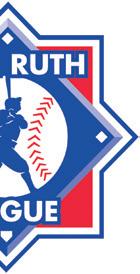
SOURCE: CNN.COM
SURVEY SAYS ...
A recent Referee Twitter poll asked baseball umpires, “Which MLB rule change do you think will have the most significant impact on the game?”


Of the 65 respondents, 70.8 percent said they believe it will be the pitch clock, 27.7 percent voted in favor of the new infield shift limits and 1.5 percent opted for bigger bases.
THEY SAID IT
“I liked going out there and kind of being the boss … just being out there and everybody’s hanging on my every word, my every call. I enjoyed that challenge of going out there and trying to be the best — better than the teams, better than everyone else.”
— MLB umpire Laz Diaz, about his mentality when he first started his umpiring career
SOURCE: UNITED UMPIRES
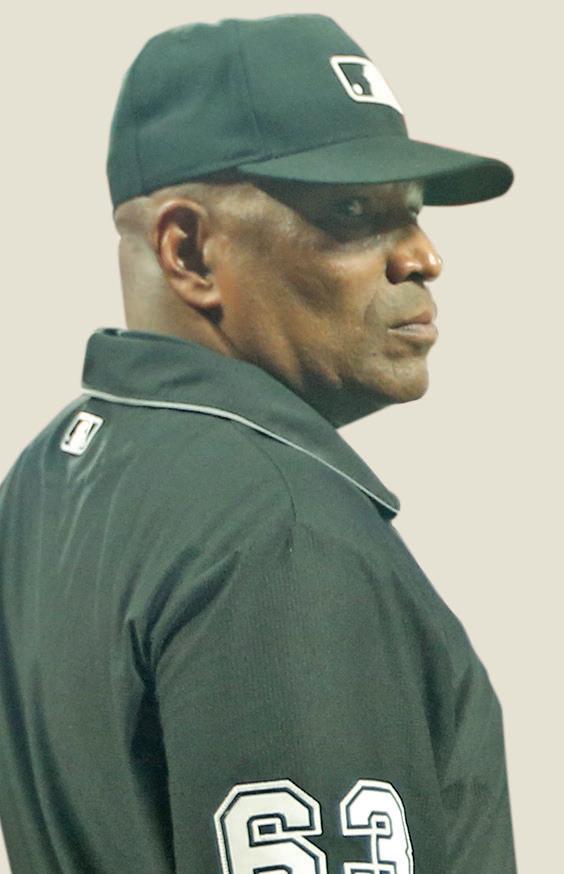
BILL GREENBLATT/UPI
TEST YOURSELF
In each question, decide which answer is correct for NFHS, NCAA or pro rules. Solutions: p. 81.
1. With R3 on third and one out, B3 hits a pop up foul down the thirdbase line. F5 makes the catch near his dugout and then steps inside with both feet.
a. The batter is out and R3 scores.
b. The batter is out and R3 stays at third.
c. The ball is live if it was stated in the ground rules “catch and carry” into the dugout was legal if the fielder doesn’t fall down.
2. After coming to a stop in the set position with his hands together, F1 would like to change to the windup position. What is required for this to be legal while the ball is live?
a. Step backward off the back edge of the pitcher’s plate with his pivot foot.
b. Separate his hands and request time.
c. Turn his body so his shoulders are facing the hitter, as long as he does not step forward.
3. With R1 stealing and one out, B3 hits a ground ball to F5. He fields the ball and immediately errantly throws the ball out of play beyond first base in an attempt to put out B3 running to first base. At the time of the throw, R1 was past second base.
a. R1 is awarded home and B3 is awarded second base.
b. R1 is awarded third base and B3 is awarded second base.
c. R1 is awarded third base and B3 is awarded first base.
4. With R1 stealing and one out, B3 hits a ground ball to F4, who fields the ball and swipes in an attempt to tag R1 but misses him. He then errantly throws the ball out of play beyond first base in an attempt to put out B3 running to first base. At the time of the throw, R1 was past second base.
a. R1 is awarded home and B3 is awarded second base.
b. R1 is awarded third base and B3 is awarded second base.
c. R1 is awarded third base and B3 is awarded first base.
Plays at the Plate
The most contentious situation is when a runner is trying to score and the batter is still at bat. That could be because of a wild pitch, a passed ball, a rare attempted steal of home or a squeeze play. If the batter has bunted the ball, he is expected to make a normal effort to get to first. If he has taken the pitch or otherwise swung and missed, he must vacate the area if he has time to do so. In this situation, many batters believe they can do no wrong by staying in their batter’s box.
If the batter remains in the area of home plate and interferes with the pitcher covering or any other player making a play on a runner, interference may be ruled if the umpire judges the batter’s action or lack of action was contrived to interfere. In other words, if the batter had sufficient time to get out of the way and could have gotten out of the way but doesn’t, interference could be ruled. Also, the burden is on the batter to avoid interfering with the play. Any movement must be an effort to get out of as opposed to into the play (NFHS 7-3-5d; NCAA 7-11f; pro 6.03a3).
When there are two outs, the batter is the third out and the run does not count. When there are less
than two outs, the runner is out and the batter remains at bat (NFHS 8-4-2l; NCAA 7-11f Exc. 1, 8-5l; pro 5.09b8).
Play 3: B2 takes the pitch as R3 attempts to steal home. B2 bumps into F2 while he is moving out of the box and interferes with F2’s attempt to tag R3 sliding into home plate. Ruling 3: With two outs, B1 is declared out for his interference. With less than two outs, R3 would be declared out.
Play 4: With a runner on third, B2 at bat and no outs, R3 attempts to score on a passed ball. F1 covers the plate as F2 retrieves the ball. B2, who is still standing in the right-handed batter’s box, is struck with the throw, preventing the pitcher from making the play. Ruling 4: B2 clearly had enough time to get out of the way. Thus, he interfered with the play by remaining in the box. Since there are less than two outs, R3 is out for B1’s interference.
When there is a play at the plate, it is also possible for the pitcher to step off the rubber and throw to the plate in an attempt to retire the runner from third. The batter is expected to recognize the difference between a pitch and a throw. If the batter swings at such a throw, it is interference. George Demetriou, Colorado Springs, Colo., is the state’s rules interpreter.
The Ones Who Don’t Care
By Jon Bible
Anumpire, “Bill,” wrote me to express his frustration with the huge paradigm shift (his words) he’s seen since he started working 13 years ago. When he began he attended varsity games, sat in on pregames and in other ways sought to be the best he could be and then get better. Now, he’s increasingly being paired with less-experienced umpires who don’t approach things that way. They spend as little time as possible at a game site, so there’s limited pregame and postgame interaction. They don’t seem to care what kind of job they do, don’t ask for feedback and turn a deaf ear if he offers it. Many think
they know it all even though they’re brand new. He’s reached the point if someone doesn’t show any interest, he’s not going to waste time trying to help them because he’s tired of being rebuffed.
I know the shortage of officials in all sports has caused some associations to seek any warm body available to work games, but I wondered if things are as bleak as Bill portrayed. I asked my friend, “Tom,” whose job involves working with amateur officials. To my dismay, he said he agreed with Bill 100 percent.
I’ve long bemoaned the fact that in the last quarter-century or so, far fewer umpires see the value of taking things a step at a time like we did
66 | REFEREE August 2023 BASEBALL
COURTESY OF MHSAA
Three-Ring Circus
Multiple fielders converging on a fly ball near a foul line can create a moment of chaos. This batted ball is the plate umpire’s responsibility whether working in a crew of two, three or four umpires.


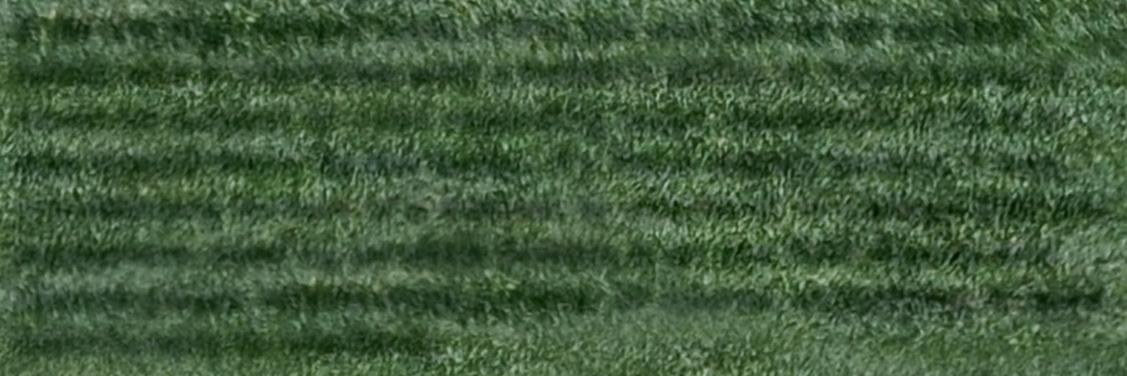
1 Umpires must remember the order of priorities: A. Fair/foul. B. Catch/no catch. Many a new umpire (and an occasional veteran) has become so concerned about ruling on a catch/no catch amid the chaos of converging fielders, they forget the equally important ruling on fair/foul — critically important if the fielders fail to catch the ball and everyone needs to know if it’s play on or a foul ball.
1 2 3
2 While it doesn’t appear to be a factor in this particular case, when multiple fielders converge on a batted ball, only one is protected from interference. The other fielders are at risk of obstruction if they impede the batter-runner. If the batter-runner advances through this area (in this case it appears the batter-runner has already passed these fielders), No. 25 probably isn’t the protected fielder — it’s a judgment for the umpire between the catcher and the other fielder, who is likely the pitcher (NFHS 8-4-2g1; NCAA 8-5d Note 1; pro 6.01a10).

3 At the high school level, if this bat was left by an on-deck batter and it interferes with a fielder’s ability to make a play, it could be subject to rules regarding loose equipment (1-7). If it was tossed there by the batter, it’s there legally (unless it was intentionally thrown in a manner to interfere). In college and pro, equipment used by on-deck batters is on the field legally and cannot create interference (unless, of course, something is done intentionally to interfere).
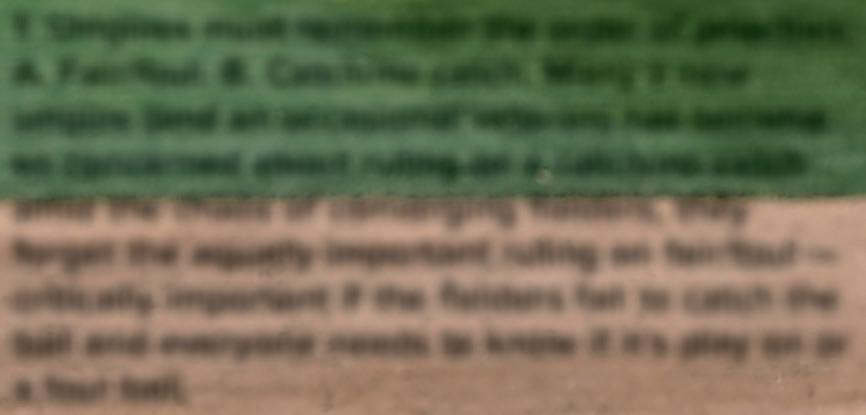
REFEREE August 2023 | 67
CASEPLAYS
Legal Retreat
Play: On a potential tag play between home and first, B1 retreats toward home to evade a tag. Ruling: Legal and the ball remains live. B1 would be declared out if he touches or passes home or if he leaves the base line (NFHS 8.1.1A; NCAA 7-11p Note 3; pro PBUC 7.30 Play 1 Note).
No Value
Play: The head coach is upset with the plate umpire’s performance and has made repeated comments from the dugout. The umpire has stayed calm, responded to a question, given an official warning and the coach is finally ejected. The ejecting umpire has walked away from the coach’s location, but the coach charges out of the dugout to “get his money’s worth.” Ruling: In NFHS and pro, additional penalties depend on governing authority policy. In NCAA, a two-game suspension is added to the ejection (NFHS 3-3-1f6 Pen.; NCAA 5-15a4 Pen.; pro 8.04c).
Lots of Visits
Play: The first batter in the bottom of the sixth inning draws a walk. There have been no previous trips/conferences. The pitching coach makes a trip to that pitcher. After the trip, a pinch hitter is announced. The head coach comes out of the dugout to make a second trip and replace the pitcher. Ruling: Both the trip and the substitution are legal (NFHS 3-4-1; NCAA 9-4c; pro 5.10L).
How
Many Score?
Play: With the bases loaded and two outs, B6 hits a home run over the fence. R1 misses third on his way to the plate. A proper appeal on R1 at third is made after B6 crosses the plate. Ruling: Two runs score. Because R1’s out is the third out, only the preceding runners score (NFHS 9-1-1 Exc. c; NCAA 5-6c Exc. 3; pro 5.08a Exc. 3).
Brushing Allowed
Play: With R2 on second moving on the pitch, B2 hits a grounder into the hole at short. F5 comes over to field the ball, but it passes through his legs. As F6 is about to make the play, R2 inadvertently brushes into him. Both runners are safe. Ruling: The play stands. The only fielder protected on the play is F5 (NFHS 8-4-2g; NCAA 8-5d Note 1; pro 6.01a10).
when I started in the 1960s. Somewhat jokingly I’ve said people now want to work high school ball in year two and the College World Series in year three and often quit if that doesn’t happen. But I assumed while some may be too eager to advance without getting the seasoning (not just balls/strikes and safes/outs) needed to become wellrounded, most umpires want to do the best they can. If Bill and Tom are right, we’re at a point where this isn’t so, at least in a disturbing number of cases. Is there anything umpires in Bill’s position can do to rectify this?
In my mind, there are four givens. First, umpires can be put in one of two groups: those who are in it for the money and want to do the bare minimum needed to get by, and those who are invested in doing the best job possible. It was that way when I started, it’s that way today, and it will always be that way. Second, given the umpire shortage, which is getting worse, and the need to virtually take all comers to staff games, the number
of unmotivated umpires will increase.
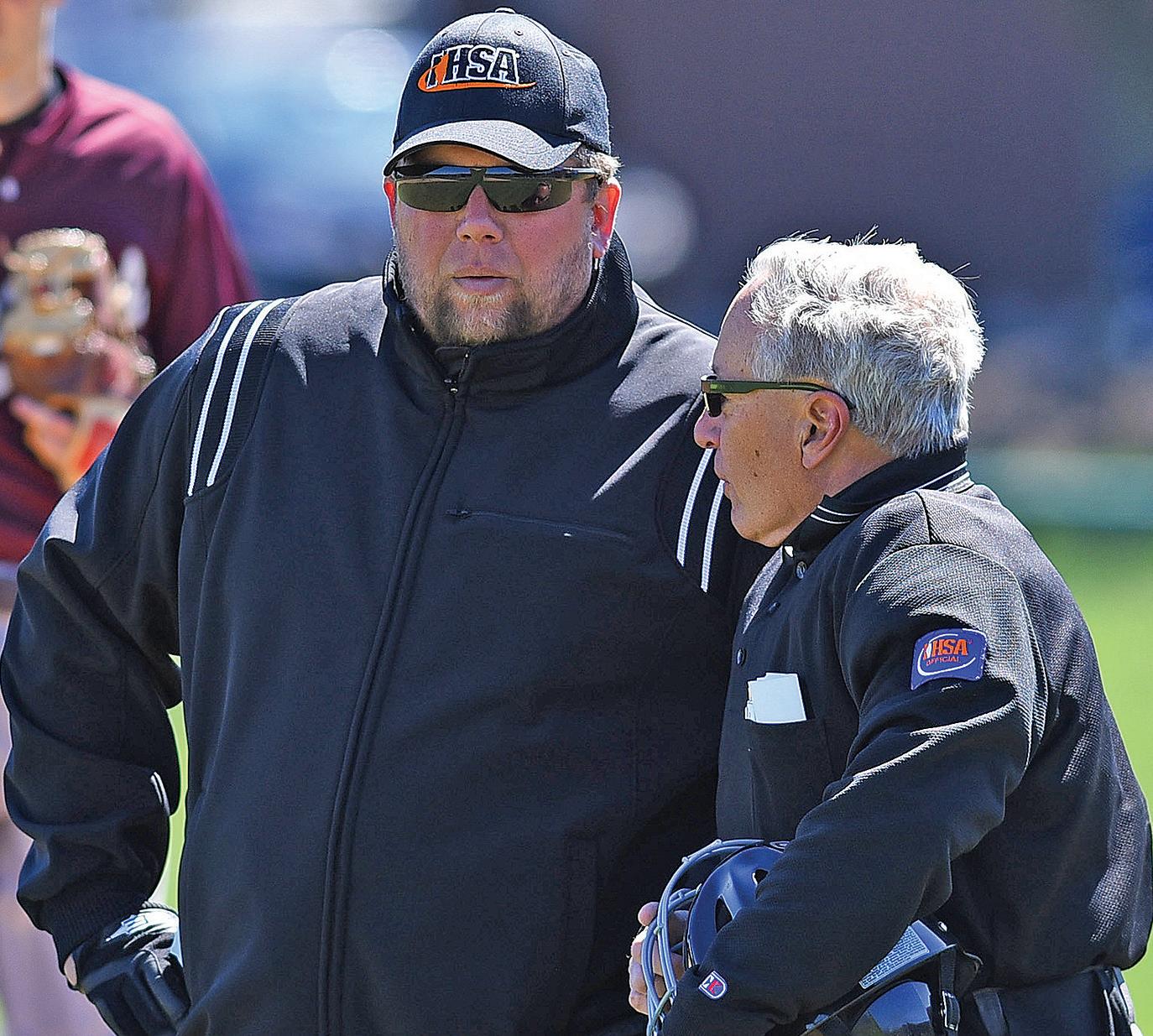
Third, a certain percentage of umpires in that group will be unreachable no matter what is done to get them to change. Fourth, however, and I know this from experience, some umpires who come across as not giving a flip may shift gears with some encouragement. It’s a matter of approach. Because we’re all different, what I say might work with Sam but not Joe, and given Joe’s makeup he might be receptive to what Dick says although he blew me off.
Two statements often produced good results when I dealt with an umpire who seemed not to care. One was, “You appear to have some talent, but I don’t think you’re taking advantage of it.” That often led to, “What do you mean?” With the door ajar, I could talk about such things as the myriad training aids now available and the value of trying to find a mentor. New umpires in particular may not even know such things exist. Some are insecure about their ability
68 | REFEREE August 2023 BASEBALL
DEAN REID
Ryan Verver, right, and Jim Urbanek, both of Chicago Heights, Ill., need to be able to trust one another that each wants to be the best umpire he can be and know how to communicate effectively so they can get everything correct on the field.
A college friend told me about working with an ex-pro (they’re increasingly going into college ball when released from pro ball) who, before the first inning, yelled at the pitcher, “Don’t start anything or you’ll regret it!” This didn’t make that player’s coach happy. My friend waited a few hours after the game, called the guy and used the “may I offer” line. That approach disarmed him and waiting a few hours took the emotion out of the situation. Although after the game he had bragged in the locker room about how he took control, he sheepishly admitted on the
phone he was the one who looked like a jerk.
Given all of this, I’d suggest to Bill that he should keep trying because if one person responds positively that’s one more in the motivated group who otherwise wouldn’t be there. He may run up against a brick wall on occasion, maybe even most of the time, but he won’t always. He might also reassess the approach he’s taking and the words he’s using because, unwittingly, he may come across as off-putting, condescending or a knowit-all himself. Refer to my earlier observation about all of us being different.
As for what to do if you have an unmotivated partner — and I assume because you’re reading this you’re not the unmotiviated one — I don’t have a magic remedy because, as I’ve noted, some people won’t change no matter what. Try to have a pregame, no matter how rudimentary. If a








mechanics breakdown occurs, address it between innings in a way that ensures he knows you mean business. Even the worst partner will usually respond because they won’t want to be confronted again. If a rule is kicked, fix it; if your partner is embarrassed, good — maybe that will be healthy. After the game, try one of the statements above, maybe after some time has passed.
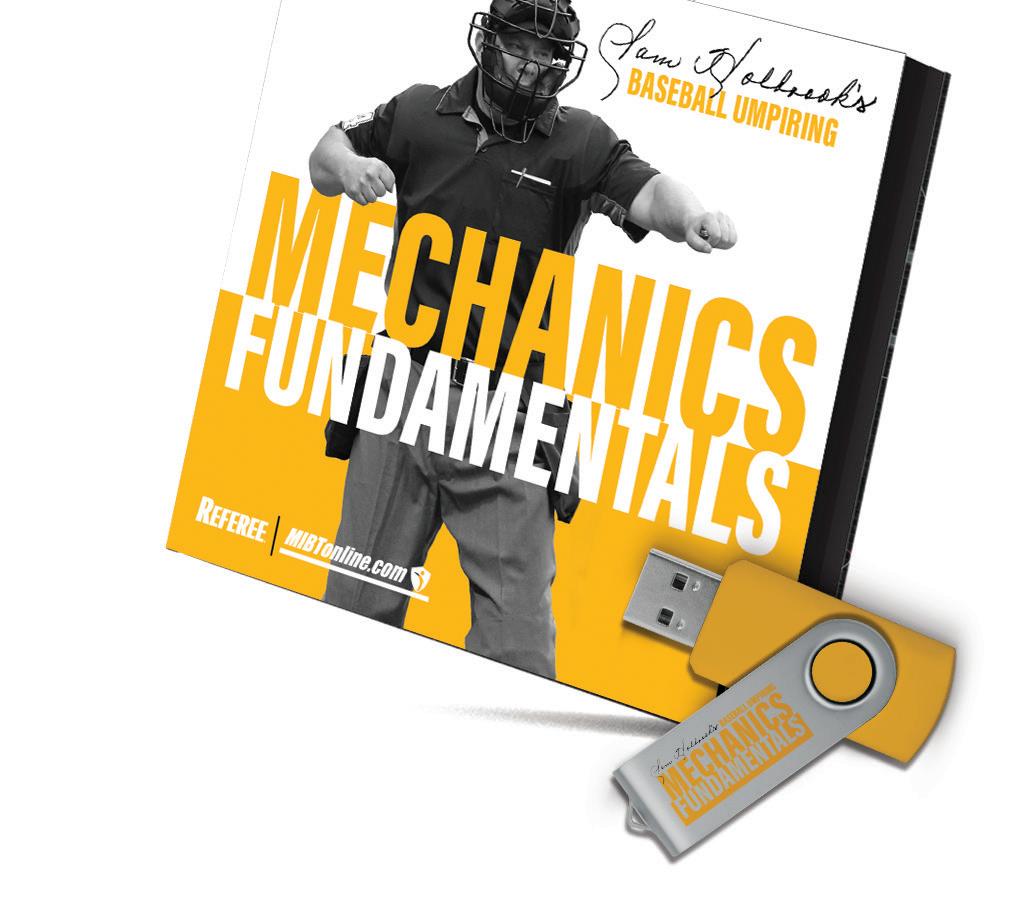
If things are bad enough, contact your assigner. Most groups have some evaluation system. If an umpire is bad and doesn’t want to improve, he’ll eventually be exposed. Although the need for anyone with a pulse will mean that some of these folks are retained, some won’t be, and to the extent they’re not that’s a plus for those of us who care.
Jon Bible, Austin, Texas, worked seven NCAA Division I College World Series. In 2019, he was inducted into the National College Baseball Hall of Fame in Lubbock, Texas.
Longtime MLB umpire Sam Holbrook brings his years of onfield and umpire school experience to this new video focusing on the mechanics that will take you to the next level in your umpiring career. LEARN MORE STORE /baseball
the mechanics that $2495
and may think asking for help will make them seem weak or cause others to question their skill level.
The second statement was, “May I offer you something?” Not once was I rebuffed when I said this. I usually followed up with, “Do with this what you want, but I noticed X and I have a suggestion.”
Wise Beyond His Years
By Brad Tittrington
Most college students are trying to figure out what they want to do with the rest of their lives. Many are thinking about what to major in, where to go for spring break and what party to attend on the weekend. However, there is one student in Toledo, Ohio, who breaks the mold.
Drake Furey, 19, has been fascinated with officiating since he first became interested in sports. The Bowling Green student, who just finished his first year

to work varsity games early on. The only problem — he was still in high school and wasn’t eligible to work varsity-level games. In 2022, Furey got the chance to join his first varsity crew and he quickly made an impression.
“What a kid,” said Thom Dart, who works across the line of scrimmage from Furey on Friday nights. “I’m telling you, that’s going to be a guy you look back on in, I don’t know, 15 years, whatever it takes. I just really, truly believe that he’s going to be at a very high level of football, basketball. He’s really sharp. I think you’re going to see him on TV in both sports. He’s really good.”
Furey’s goal is to one day make it to football’s biggest stage.
“If I can get to the NFL one day, that is what I want to pursue,” he said. “I’ve talked to Big Ten and Mid-American Conference officials and gone to a couple of clinics, obviously knowing right now I’m not going to get any college assignments, but maybe after I’m out of college a year or two. There is no better feeling than officiating on a Saturday or Sunday. Watching on TV is cool, but being in that atmosphere, it’s like nothing else. That would be a dream to officiate in the NFL one day.”
The back judge on his crew, Lee Durham, agrees the sky is the limit for his future.
Officiating Is Better
Susan Chue Miami
Coming out of high school, Susan Chue wanted to be a basketball player. “My aunt lived in Miami and I said, ‘Hey, can I live in your house and go to (Florida International University)? I’m going to try and walk on,’” she told CBS 4 in Miami. A bigger opportunity arose when she began officiating intramural games. A few years later, she ascended to the NCAA ranks and had a tryout with the WNBA. Now she isn’t the least disappointed she didn’t succeed as a player. She gets more joy out of officiating, especially at the lower levels. “I enjoy giving back to the game in that way … helping teach the game, the rules. The fun part of it is watching the kids develop. That’s amazing.”
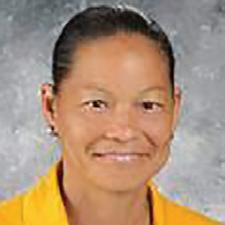
Mat About Bob
Bob Colgan Clarion, Pa.
in college, has been officiating football for the past four years and basketball for two. And while most people his age are interested in sports for those playing the game, Furey has always had a fascination with those arbitrating it.
“I was always interested in the rules,” Furey said. “And then I started to watch, especially football, and wondered, ‘What is the holding signal? What are all the signals?’”
One of his dad’s friends is Big Ten football center judge Ron Kay. Furey asked his father to call Kay and ask how he could become an official. That led him to take a course to become certified licensed to work high school games.
Furey was a natural and was ready
“If that kid wants to, he can move up and up,” Durham said. “He can make it a career because he’s that good. He knows more than a lot of older officials. He enjoys it, he’s a good person. He can go a long way with this.”
And while the future looks extremely bright, Furey is strictly taking it one day at a time. He is focused on earning his teaching certificate from Bowling Green and looks forward to getting on the gridiron each Friday night with the rest of the crew.
“I wake up on a Monday morning here at Bowling Green and what really gets me through my week is, ‘Hey, I have that Friday night game to look forward to,’” he said.
Brad Tittrington is an associate editor for Referee
Veteran wrestling referee Bob Colgan enjoyed a moment in the spotlight in February when he was honored for his 50 years on the mat. Fittingly, he received the honor at the District 9 Class AA championships. He has officiated everything from the junior wrestling level to high school and college. He has officiated four generations of families involved in the sport. He has officiated 35 district championships, seven district team tournament championships, 32 Class AA and AAA Northwest Regionals, eight Pennsylvania Interscholastic Athletic Association (PIAA) individual championships and six PIAA team championships.
Colgan has also held leadership positions for the Northcentral Chapter of the PIAA Wrestling Officials Association. He was inducted into the District 9 Wrestling Hall of Fame in 2019.

Do you know a person or group who should be profiled?
Send info to us at profiles@referee.com
COURTESY DOUG HISE PHOTOGRAPHY; ROCKWAY MIDDLE SCHOOL/CLARION (PA.) COURIER EXPRESS
PERSONALITIES PLUS 70 | REFEREE August 2023
PROFILES
Drake Furey’s interest in officiating began when he started watching sports. Now 19, his career is on the rise.
GREAT TRAINING RIGHT OUT OF THE BOX
• Pre-Built Meeting Lesson Plans




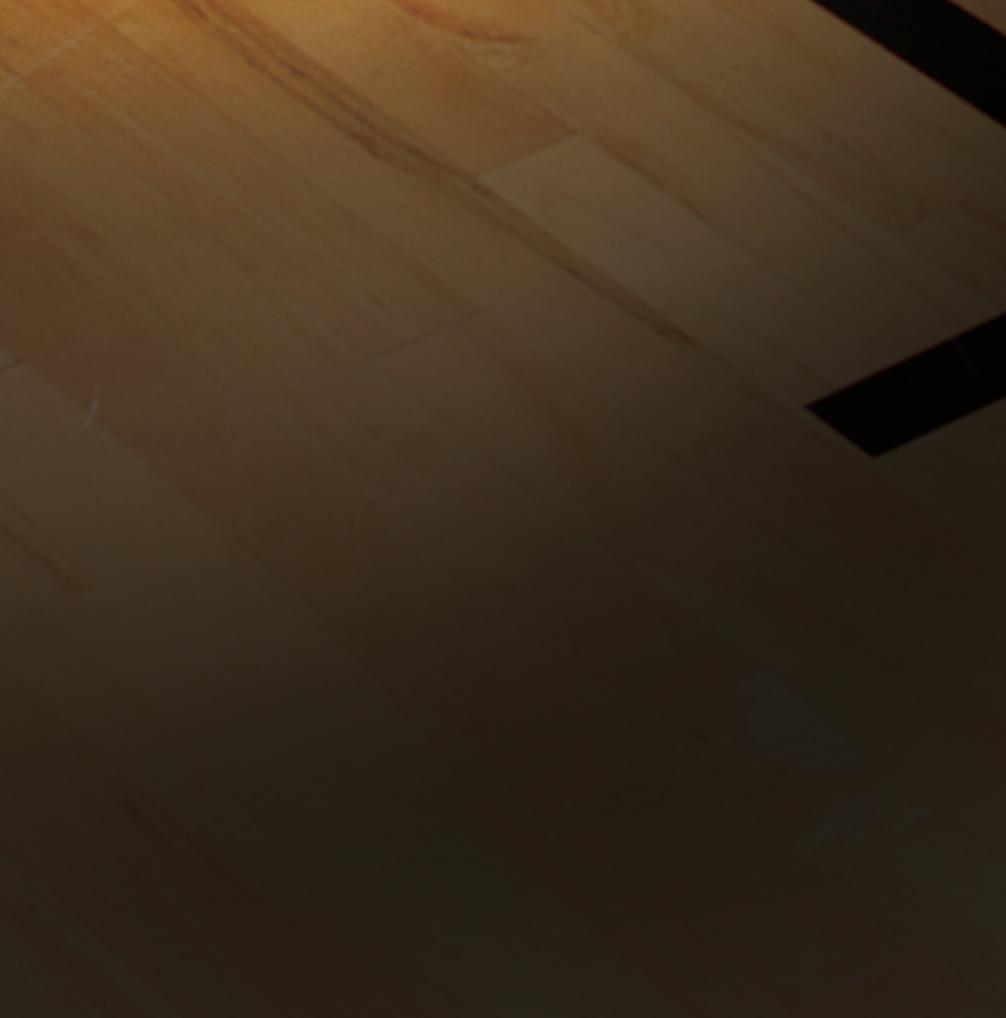
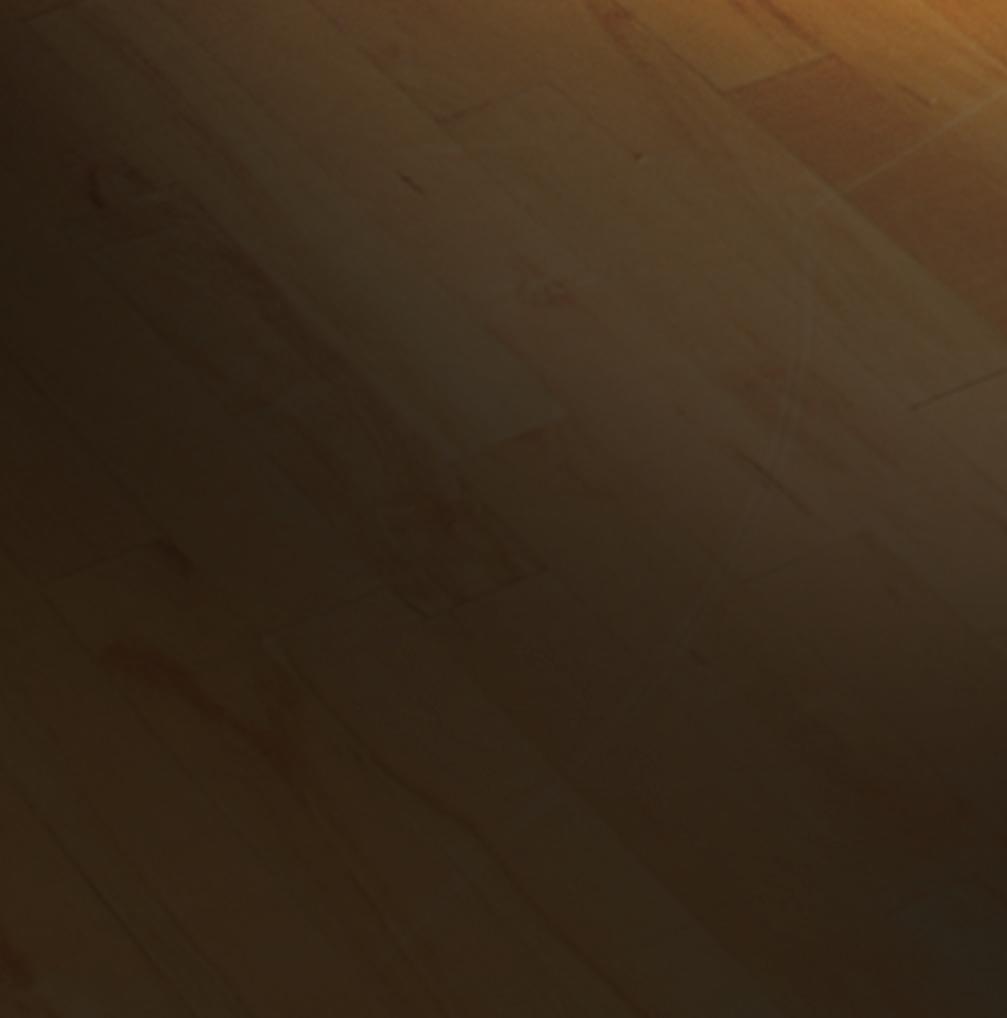
• Industry-leading Mechanics Illustrated Manuals
• Online & Traditional Testing For Every Lesson
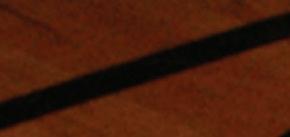

• Rules & Caseplays Together in Rules by Topic




• Step-by-Step Instructor Guides
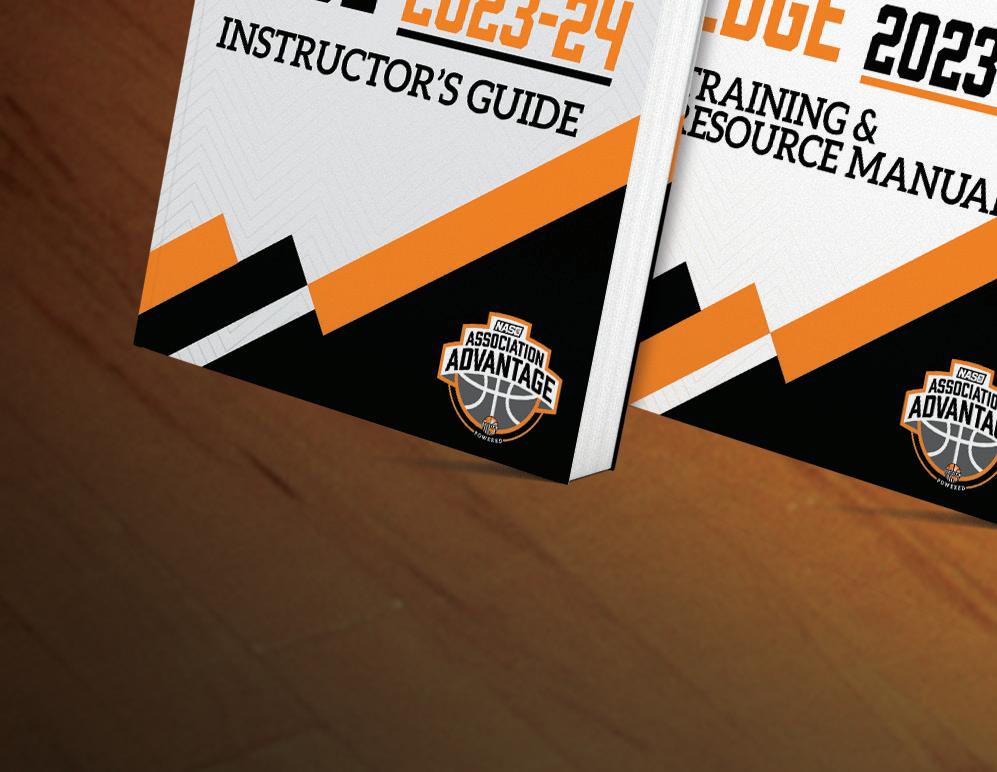
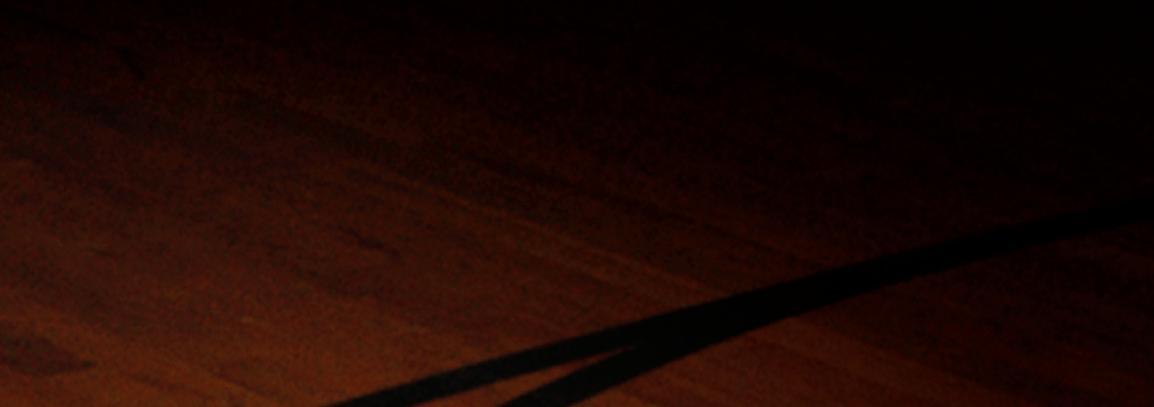

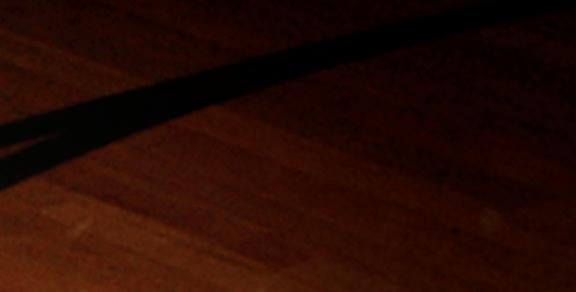
• Video Breakdowns With Voice-Over & Graphic Enhancements


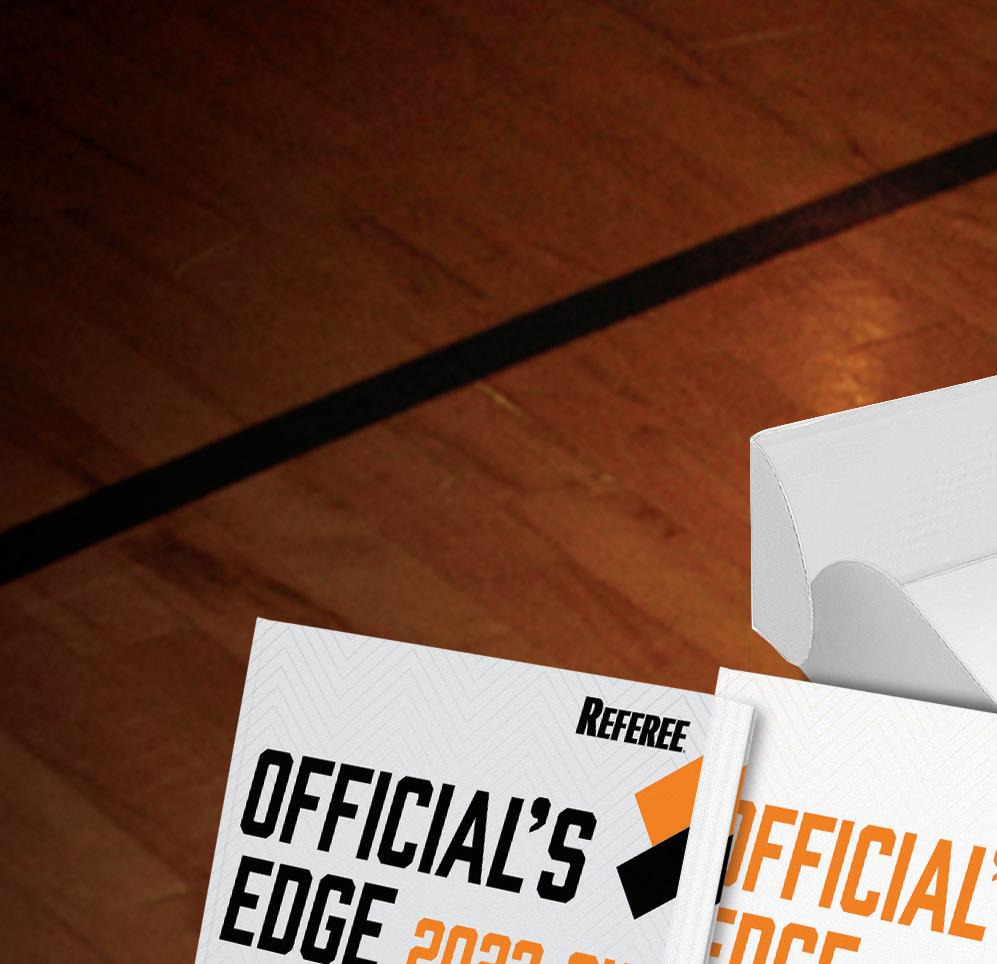

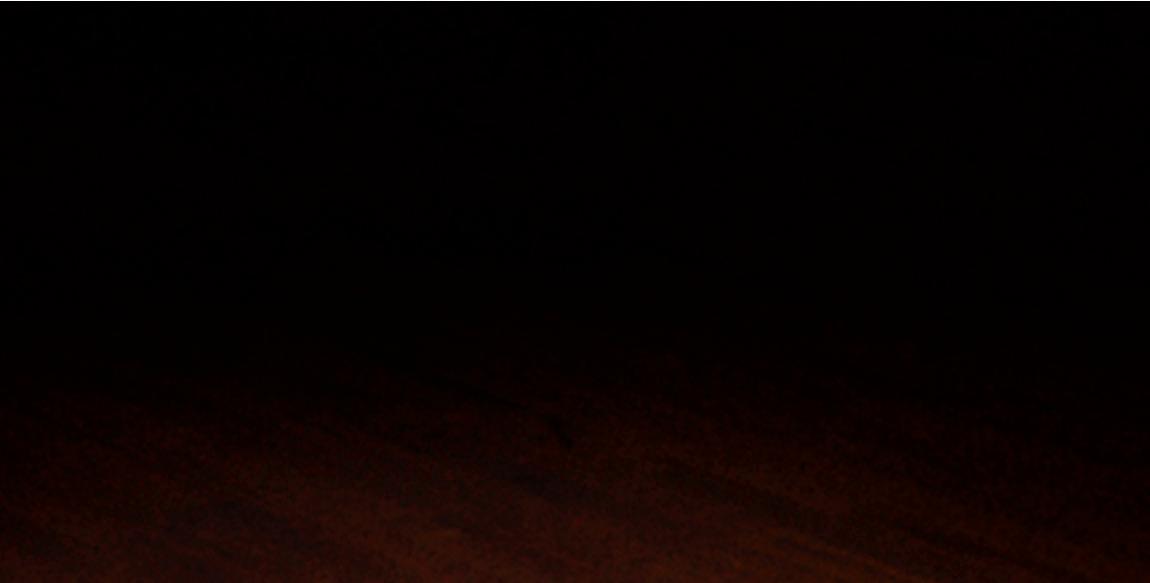
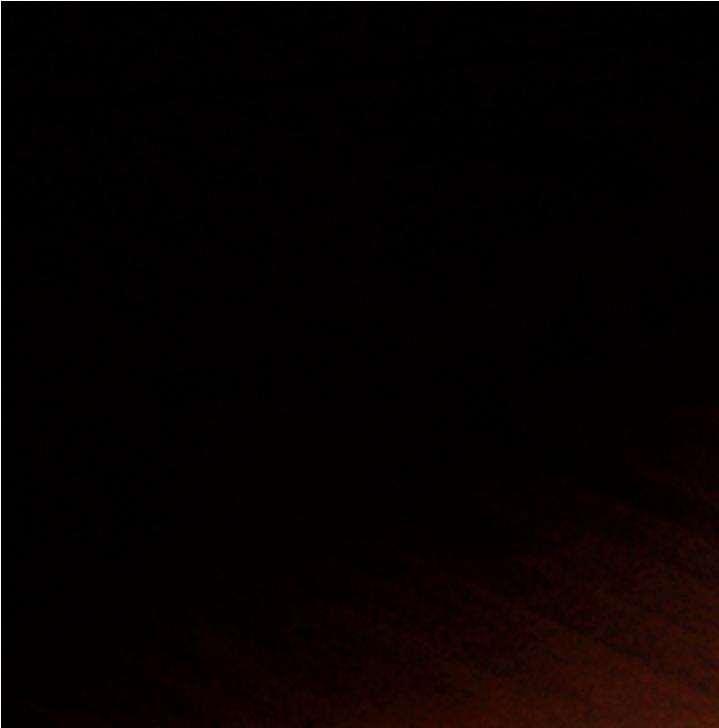
program
in one box LEARN MORE AT NASOADVANTAGE COM/diamond
Your entire association training
all
WHERE ARE YOU ON
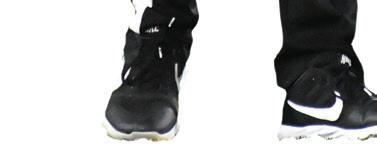

MOST OFFICIATING CAREERS NAVIGATE THESE FIVE STAGES
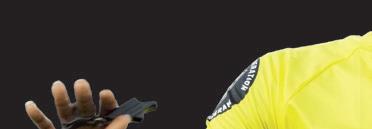
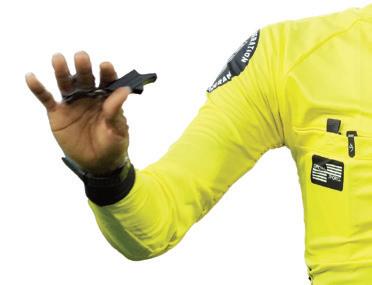
Officiating and climbing a mountain share much in common. The ascent isn’t always easy.
Both endeavors require preparation and training. The attempt to climb in each brings twists and turns, setbacks and challenges. There are moments of exhilaration, but moments of frustration and disappointment, too. The journey — whether ascending a mountain peak or the ranks within your given sport — can be an adventure.
In officiating, we start as “newbies,” progress to survival mode, climb to a point of being comfortable, followed by a desire to work “big” games and postseason contests to finally wanting to give back to officiating. Those are the five stages of officiating, and while it’s not the same journey for everyone, most officials traverse through this territory.

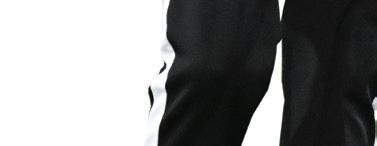
STAGE 1 HAPPY TO BE HERE
When you’re new to officiating, it’s scary and exhilarating at the same time. There’s so much to learn about this new craft — and you do so eagerly at clinics, camps and by gaining insights from each game you work. You might not fully realize what you’ve gotten yourself into, particularly when it comes to dealing with unhappy coaches and irate fans.
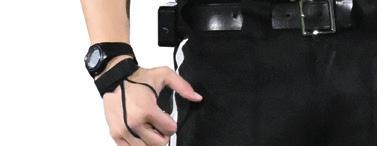
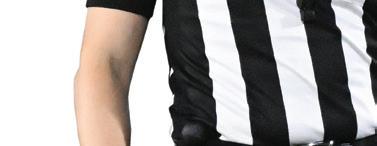


But you can’t expect to learn everything overnight. It’s going to take a lot of studying, clinics, camps, and raw effort to learn what you’re supposed to do. But the more games you officiate, the more comfortable you become with this new avocation.







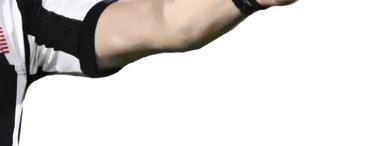




STAGE 2 I WANT TO STAY HERE
Now that you’re over the initial stage fright, you’re ready to stick with this new avocation. It’s survival mode. Sometimes officials at this stage are afraid to make mistakes.




This is a good stage to do some serious book work. Master those rules so you’re ready for those tricky situations. You ultimately need to develop a good feel for the game. Without that feel, survivor mode can kick in, which can lead to overthinking and a focus on avoiding errors. If you’re focused on avoiding mistakes, your decision-making process can become too slow and you’ll end up stagnating.
Consider finding a mentor. Find a veteran official who can answer questions and provide feedback, especially on some of the important intangibles that aren’t outlined in the rulebook and casebook. Someone who has already “been there and done that” can help you avoid repeating similar mistakes.







72 | REFEREE August 2023
HESTON QUAN(FOOTBALL); BILL GREENBLATT/UPI (SOCCER); DALE GARVEY (BASEBALL)
Here’s what most can expect and how to keep advancing through the stages:
THE










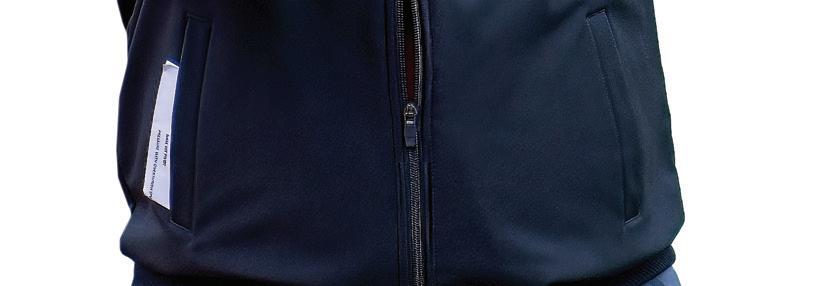














STAGE 4 I WANT TO WORK ‘BIG’
GAMES
At this stage, you might want to work playoff games, but wanting and getting an opportunity don’t always mesh. You may think you're ready and prepared for such assignments, but your assigners or supervisors might not see it that way.
STAGE 5 I WANT TO GIVE BACK
When you’ve reached this stage, you’ve accomplished what you’ve wanted in officiating. You’ve climbed the summit and officiating has left you fulfilled. And while you may not be interested in the “climb” anymore, you’re not ready to walk away completely.
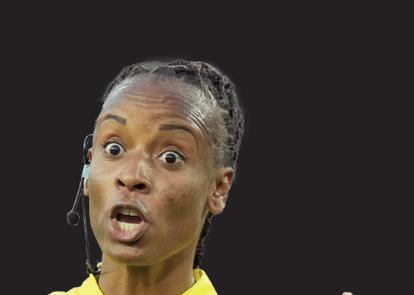
STAGE 3 I BELONG HERE
At this juncture, you start to think about where you would like to go in officiating. You often feel confident in your abilities and comfortable at your particular level. Reaching this stage is different for everyone.
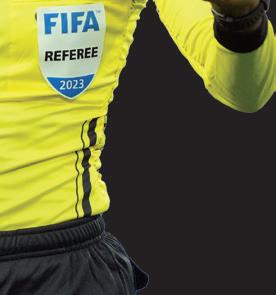

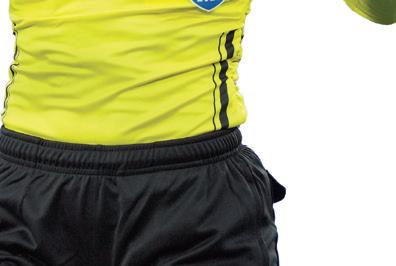
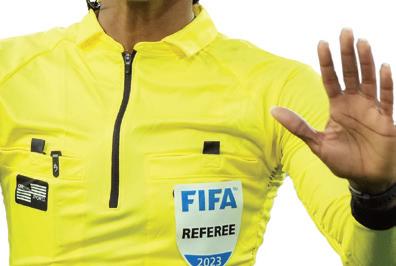
What can you do at this stage to continue to improve? Find officials at a higher level and look for little things you can emulate. At this stage, the intangibles allow the best officials to stand out.
Develop an inner circle of officials who can give you an honest assessment of your work. Learn from each other.
Hone your communication skills. Good officials who get selected for the playoffs and championships know how to defuse tense situations. You can help develop communication skills by asking for advice from other officials who you know are good in this area. What are the buzz words they use with coaches? How do they stay calm when things heat up?
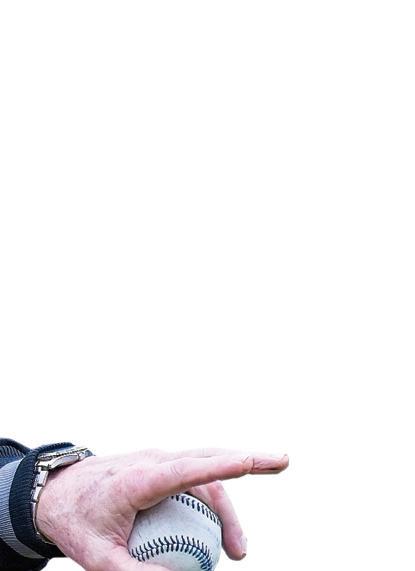

That can lead to frustration. In some cases, officials choose to end their careers at this stage. The waiting game can be difficult. But there are two ways to approach this stage: 1) be patient and 2) view each one of your assignments as if it is a championship game. That kind of approach keeps you on the path toward those “big” games, even if it ends up taking longer than you hoped. In effect, control what you can control.
What if you’re stuck at the plateau? The best officials use adversity to do a really solid, inclusive self-assessment. Look at yourself and ask if you’re doing enough, training enough and studying the rules hard enough? There’s always more a person can do. It takes work to punch through the barriers.
You want to stay involved. You want to stay connected with all the great people you have met along the way. But perhaps age and physical limitations make it impossible to remain on the field or court.
Officiating has been such a big part of your life, and you don’t want that connection to end — and it doesn’t have to. This is the stage where older or more experienced officials help mentor younger ones.

Just don’t forget you’re never too old to learn. In fact, the rules, mechanics and philosophies of officiating change. If you’re going to instruct or evaluate, it’s important to stay current.

This is your chance to offer your wisdom to younger officials who might otherwise not get the feedback needed to improve their skills. This is the opportunity to give back to officiating, an endeavor which has given you so much.
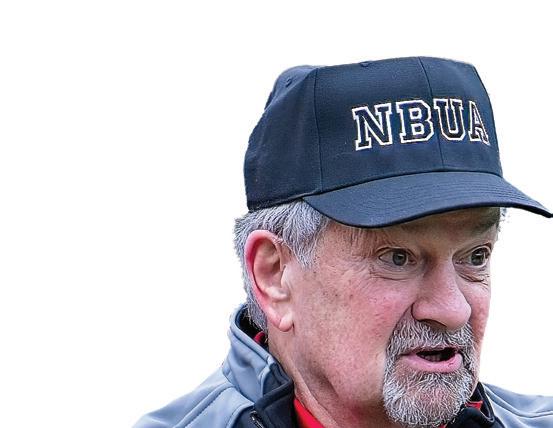 Adapted from “5 Stages of Officiating” by George Hammond published in the
For most officials, work in officiating involves moving through five stages. At left, Parker Anderson, San Diego; Crystal Sobers of Trinidad and Tobago.
Adapted from “5 Stages of Officiating” by George Hammond published in the
For most officials, work in officiating involves moving through five stages. At left, Parker Anderson, San Diego; Crystal Sobers of Trinidad and Tobago.
|
The giving-back stage often comes when officiating has left an official Bill Lewis, Sammamish, Wash.
A FINE NINE
The Qualities a Good Mentor Must Possess
By the Referee editors
A
sk anyone who has “made it” in officiating about the people who helped them along the way and they will without a doubt have a list of those who have influenced them. Whether it was a veteran official who took a fledgling official under his or her wing, an assigner who saw potential in an official and rewarded him or her with important assignments, or a trainer whose film breakdowns and educational
programs proved especially helpful, it’s important to have someone in your corner to help you grow as an official.
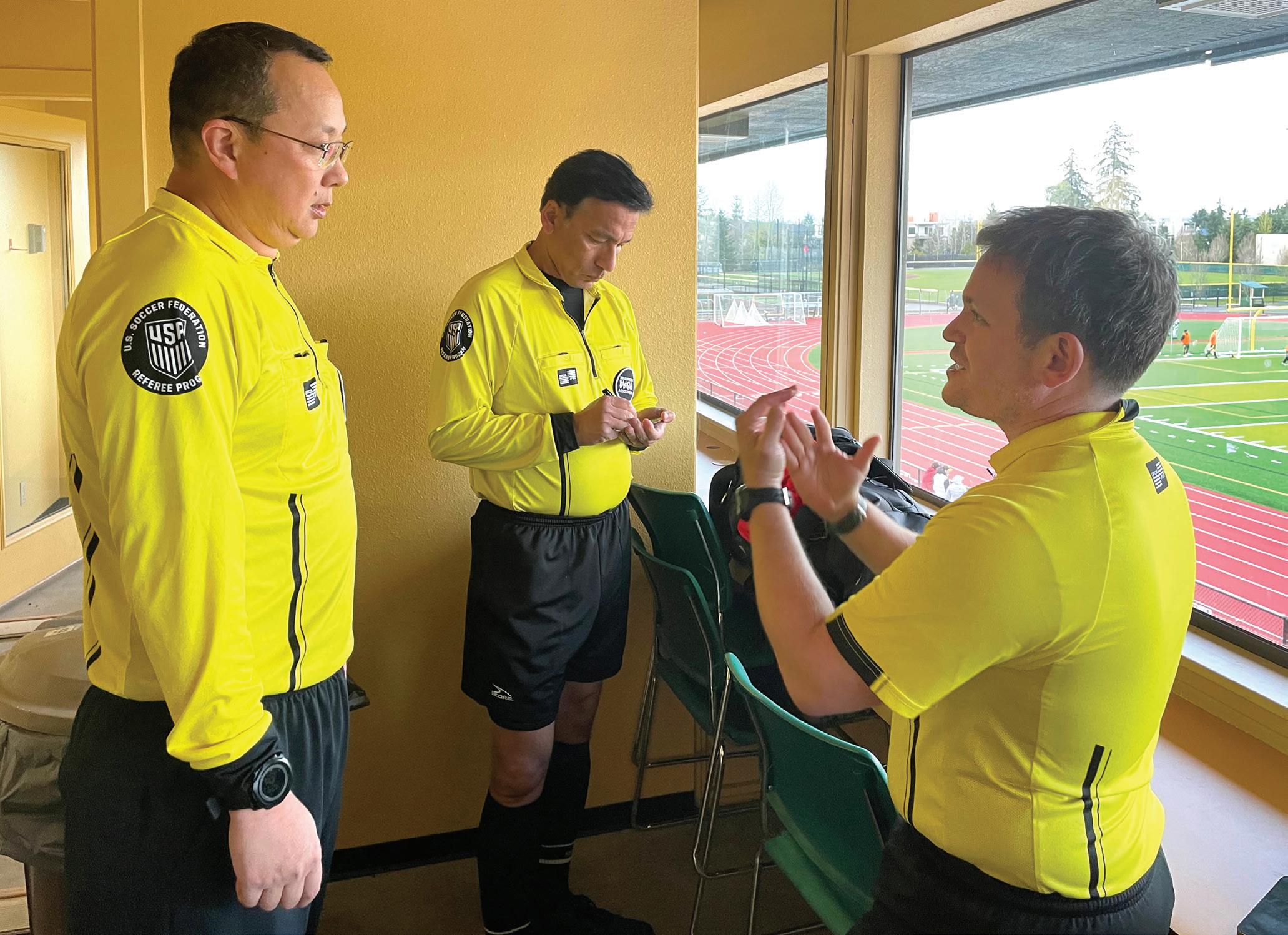
And if you’ve been lucky enough to have had that helpful push, maybe you want to pay it forward by giving a boost to someone who was in your shoes way back when.
Mentoring is a great way to give back to the game, but it’s not for everyone. So what does it take to be the ideal mentor?
1. Adaptability
Times have officially changed. Technology has become an important educational tool in all sports at all levels. Whether it’s using an app in your pregame, setting up an online study group or clipping and sharing game video, mentors have the ability to change with the times. They look for ways to incorporate technology and use it to their advantage. As games change, so do rules, mechanics and philosophies that go along with them. Mentors stay on top of those changes
ALL SPORTS FOR ALL SPORTS, ALL LEVELS 74 | REFEREE August 2023 EDITOR: JEFFREY STERN jstern@referee.com
DALE GARVEY
Washington soccer official Scott Ruthfield, Mercer Island, right, passes on words of wisdom to Lawrence Luo, Kirkland, left, and Masud Mazumder, Bothell. Mentoring can take on many forms, including brief chats at halftime or after matches.
(and at times even influence the change). As one mentor put it, “If you aren’t keeping up, you’ll constantly be catching up.”
2. Approachability
Mentees have to feel comfortable talking to their mentors. A mentoring relationship is not just about the business, it’s personal. Mentors build trust early on in order to establish confidence in the relationship. They know they need to initiate conversation that makes a potential mentee feel comfortable. Sometimes it’s as simple as recognizing and reaching out to officials who have recently been added to a league they work to say, “Congratulations,” or, “I’m here for you!”
3. Availability
Mentors pick up their phones and return text messages and emails. They may not always have the time to talk the moment they are contacted, but they always make time sooner rather than later. It’s important for those they mentor not to feel like a nuisance. Mentors make the effort to foster the relationship.
4. Communication
Mentors know how to manage the uncomfortable conversations that will inevitably take place. They may need to tell an official to lose weight or they messed up a rule. Mentors handle those situations with a tough love approach. They are honest, fair and always keep the best interest of the ones they mentor at the forefront of their interactions with them.
5. Character
Mentors are good people. They carry themselves in a way that makes others excited to work with them. They tend to be like O negative blood, which works well with everyone. They do not engage in gossip. Mentors have a way of putting the best face on even the toughest situations.
6. Consistency
The best mentors are “do as I do” kind of people. They practice what they preach and believe in what they are doing. Their actions are a direct
reflection of the lessons they teach. If a mentor tells a mentee to update his or her availability daily, the mentor is constantly making sure his or her own is up to date. If a mentor tells the mentee to lose 10 pounds, he or she has worked hard to maintain his or her own physique.
7. Credibility
Mentors are able to help others achieve their goals because they have experienced successes of their own. They’ve put in the time to master their craft and have somewhat of a resume to show for it. That doesn’t mean that mentors have to be at the end of their careers. However, the more games, tournaments and experiences they have, the more knowledge they have to pass down.
8. Humility
Former NFL coach Tony Dungy said it so eloquently in his book, The Mentor Leader. Dungy wrote, “If you do it right — if you really mentor others — more often than not, people will notice what a remarkably talented team, staff or child you have rather than what a great coach, employer or parent you are.”
Mentors aren’t in it for the glory. They don’t make it about themselves. They find deep satisfaction in helping others succeed.
9. Positivity True mentors make a positive impact in the lives of those they mentor. They have an uplifting attitude. When mentees are dealing with tough situations, a mentor puts a positive spin on it rather than engaging in talk that brings themselves or others down. A mentor’s job is to help develop the next generation — of great officials as well as great mentors, too. Mentors know they may very well end up working a game or two with their mentees. If they have helped their mentees and given them keys for success, they know their game is going to go a lot more smoothly. Their example keeps the game on a positive trajectory and ultimately creates the mentors of tomorrow. Are you up to the challenge?
SURVEY SAYS …
Have you ever used small claims court to secure payment of officiating services?
QUICKTIP
Put together a set of index cards with various topics on one side and numbers on the other. Spread them out on a table and have each official involved in the pregame choose one. The official then has to discuss the topic on the back of the card. Topics can include such subjects as when post-scrimmage kick penalty enforcement applies, how the assistant referee will communicate with the referee, the elements of a legal catch, the difference between goaltending and basket interference, etc.
THEY SAID IT
“We have reached a tipping point with youth sports in this coarsening country. Major-league expectations and 2023 arrogance have convinced arbiters the chump change they earn for their civic duty is not worth the abuse from lunatics in the bleachers and cowards on social media.”
— Columnist Brian Murphy,
writing for si.com/fannation
DID YOU KNOW?
The National High School Sports Hall of Fame was created by the NFHS in 1982 and includes 470 members, including 66 officials. High school athletes, coaches, administrators and those in performing arts are also eligible for induction.
The class of 2023 was inducted July 1 at the NFHS summer meeting. A listing of all members of the Hall of Fame is displayed in the foyer of the NFHS building, along with plaques of the current class. Plaques of previous Hall of Fame members are on display in the various state association offices.
REFEREE August 2023 | 75
Yes 2
98% SOURCE: SURVEY OF 49 REFEREE READERS
% No
Great Anticipations Can Lead to Greater Results
Sports officials must understand the game they are working or they’re in for a heap of headaches, right? An official must know everything possible about the rules involved, the tendencies of both teams and his or her partner’s capabilities in order to do the best job possible, right?
That’s all true, but that’s not all. With each play it is important for you to know what may likely happen, use the accepted mechanics and always try to be in the best position for the best angle and wait for the play or action to end. And then make the call.
That may seem like a lengthy process, but it happens in a flash. To be ready is to mentally prepare or anticipate an action before making a final decision — call or no-call, foul or no foul, violation or no violation.
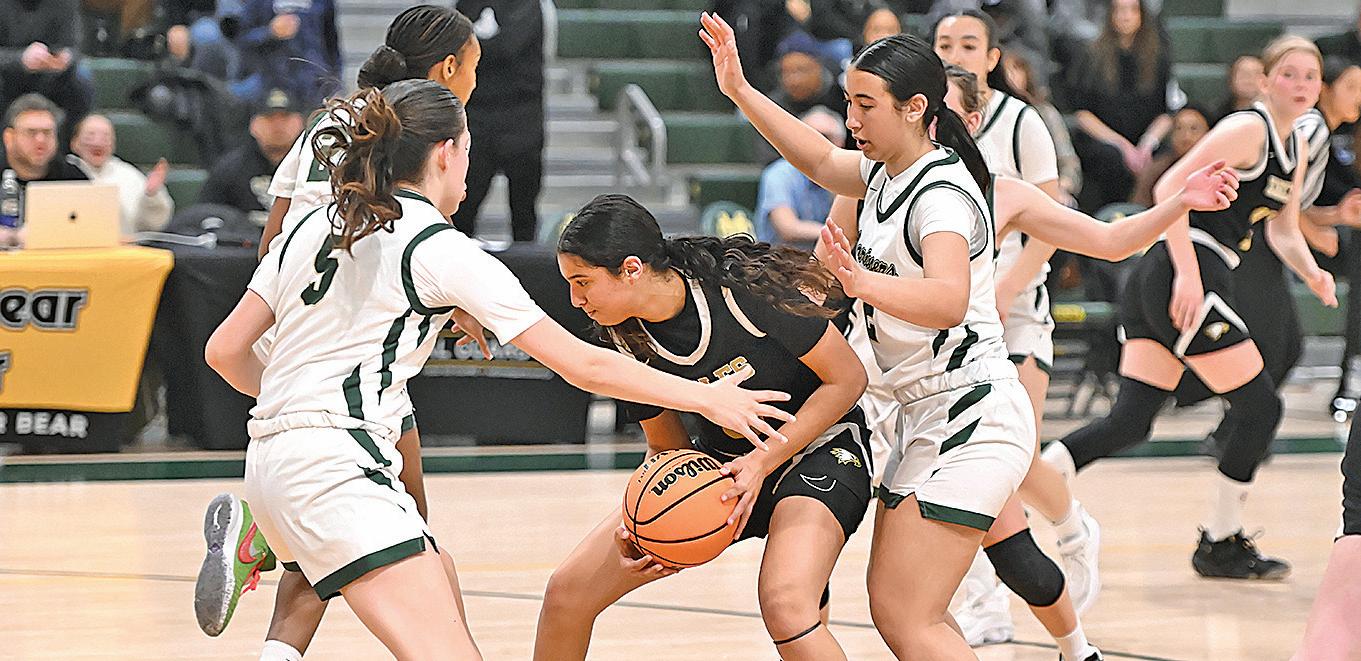
Anticipating the play before making the call is one of the best officiating mindsets to remember.
If you can “feel” what’s coming and adjust your position or your visual focus to the right area, you’ll see the play better and have a great opportunity to make the right call. If you decide what you’re going to see before you see it happen, you will get burned.
Good baseball and softball umpires quickly recognize when a team is in a bunt or steal situation. Football officials can sense a running or passing play for a first down or touchdown. Top basketball referees know when a team will probably use full-court pressure or change defenses to attack an opponent. Alert soccer officials know who will likely receive the ball on a corner kick when a player runs from the other end of the field into the mixer, and they can anticipate screening and pushing from the opponent. All of that helps officials to anticipate the play, not the call. In that process, apply timing, one attribute that separates average officials from very good ones, and withhold your call until the play is over or the time is right.
In baseball or softball, a runner will be no more or less out or safe if you wait until all action is over. If the shortstop throws the ball to the first baseman, who catches it long before the batter-runner arrives at the base, wait a fraction of a second.
There is always a chance the first baseman will drop the ball or pull his or her foot off of the bag, which may be just enough time for the batterrunner to be safe. In basketball, observe a player attempting a shot and the defender attempting to block the shot before calling a foul. Quick whistles by officials have often negated some great blocked shots, only to ignite players, coaches and fans with anger and frustration. Stay with the play until it’s over and get it right.
Former players turned officials often have an advantage in anticipating a play. As long as you have a feel for what play is coming and adjust your positioning accordingly, you will see the play better. As a result, you’ll get it right more often.
One area of anticipation that can prevent a game from disintegrating fast is when something unsportsmanlike has happened that might lead to
retaliation by the offended team. For example, if a player hits a home run and taunts the opposing team while running the bases, be aware of that team retaliating in some way. That could be a knockdown pitch to the next batter or intentionally throwing at the player who taunted them the next time he or she is up to bat. In some other sports, if a player is fouled hard, he or she may retaliate quickly with a hard foul out of frustration.
By anticipating any type of retaliation, an official can sometimes nip an ugly situation in the bud by warning the other team or player not to engage in that kind of behavior, if there is time. If that doesn’t forestall the expected retaliation, at least you will be in a state of mind to issue warnings immediately in an attempt to calm down what, unchecked, could become an ugly situation.
Whether it’s anticipating a play or situation or just knowing a team’s tendencies, the game will slow down for you that much more. In turn, that kind of officiating mindset will improve your ability to be in position at the right time and ready to make the right call.
ALL SPORTS 76 | REFEREE August 2023
HESTON QUAN
A basketball official seeing this play develop might have to make a ruling in the next split second. Will one of the defenders get a grip on the ball causing a held ball? Would that attempt be unsuccessful, leading to a foul? Will the defensive pressure cause the ballhandler to panic and travel? Anticipating what could happen but waiting until it does is a key element in officiating.
Pack Up Your Troubles (and Extra Gear)
By Ralph Carey

There are a few legendary stories of people being forgetful. Like when Detroit second baseman “Sweet Lou” Whitaker forgot to bring his Tigers jersey to the MLB All-Star Game. By the time he discovered jerseys weren’t provided, there was no time for the Tigers to ship him one.
Whitaker bought a replica jersey from a stadium gift shop. He finished the save by drawing his number on the fake top in magic marker.
Officials aren’t immune to that sort of thing. We have forgotten to pack something we really needed in order to work an assignment. It might have been a belt, socks, extra underwear or something more visible like a hat. I’ve been a part of football crews when crewmates appear without whistles, penalty flags and uniform pants. As
a crew chief, I started carrying extras of everything critical to officiating a football contest, just in case.
If you officiate long enough, you can accrue a fantastic collection of extra gear. Some of it never leaves your bag, yet you tote it around season after season. Many officials wing it each week, while others keep a precise tab on what they need using a checklist.

An informal survey of officials did find some unusual items. Among those were WD-40 to lubricate a starter’s pistol for track and field, a list of crew member emergency contact numbers, hand and foot warmers, furniture polish or Vaseline to shine shoes, playing cards for rain delays and double-seated plate pants (to avoid a compromising rear view when something rips).
Technology was also listed. iPads and other tablets for video review,

voice recording devices and charging cables made the cut.
Then there’s the case of the crew chief known as Waffle House. Reputed for his thorough pregame discussions that always seemed to run long, a crew member began bringing a picture of his wife and son into the locker room. When asked why, the official responded, “Given how much talking you do, I don’t want to forget what my family looks like.”
Having the proper equipment, including extra conveniences and backup gear, is no less important than being mentally prepared to officiate your contest. Whether it’s drawing up a checklist or creating adequate think time to properly assemble officiating essentials, being prepared is essential for success.





Ralph Carey was a longtime football official. He lives in Glen Ellyn, Ill.
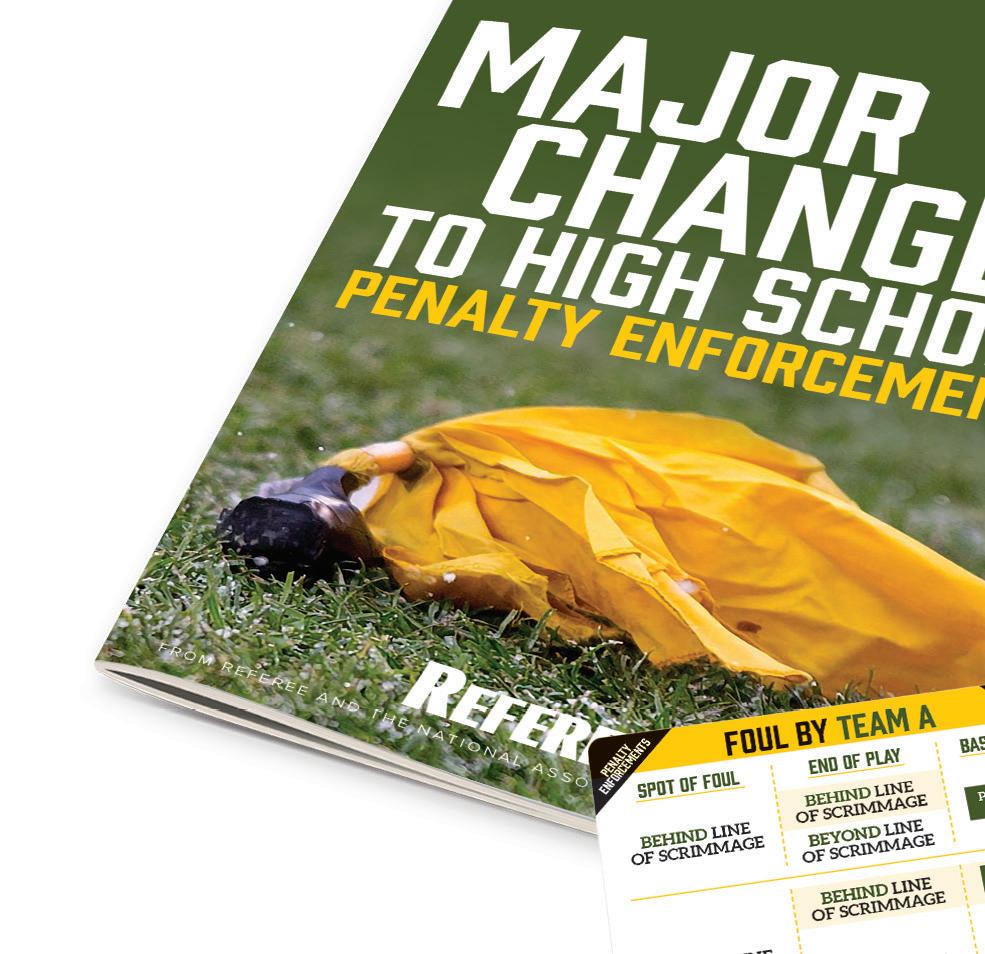
2023 rule
learn more at STORE /football
ENFORCEMENTS Everything you need to know about the penalty enforcement rule change on running plays. Easy to understand language and Referee’s exclusive MechaniGrams® with descriptions and caseplays scenarios. reference card included 5.5x8.5” 12 pages *NASO Member & Bulk Discounts Available. $495 * DIGITAL $695 * PRINT $895 COMBO
change
What You Need to Know PENALTY
PROFESSIONAL POSTSEASON ASSIGNMENTS
• The Arlington Renegades defeated the D.C. Defenders, 35-26, to win the 2023 XFL championship. Officials were referee Mike Vandervelde, umpire Krystle Appellaniz, down judge Rod Ammari, line judge Darren Deckard, field judge Conor Clougherty, side judge Raymond Tate, back judge David Ross, replay official Brian Jones, ball spotter Austin Wright, play clock Bill Smith, game clock Brad Marcum, supervisor Marvel July
COLLEGE

• Ashland (Ohio) defeated Minnesota-Duluth, 78-67, to win the NCAA Division II women’s basketball championship.
Officials were Michelle Kramer, Stacey Thomas and Amy Krommenhoek. Other officials assigned to the tournament: Katelyn Adams, Sam Allen, Carlos Alvarez, Randall Arbuckle, David Arden, Matt Balster, Joshua Batin, Amanda Bender, Josh Beutell, Ty Bills, Brandon Breese, Kina Brown, Taacha BrownDrummond, Allegra Butler, Chris Collins, Jake Coody, Kimberly Crabtree, Kelsey Curry, Kalee Davidson, Darryl Dawkins, Jarra Dennis, Maggie DeWall, Heather Durbrow, Rich Fetter, Kevin George, Timothy Gilbertson, Kayl Hamre, Matt Head, Andy Heo, Heather Herr, Laura Isabelle, Danielle Johnson, Chris Jones, Desiree Jones, Jeff Klaus, Angie Leite, Denise Lopez, Mark Majewski, Chet Martin, Jess Martinez, Quinn Mathlin, Ken McClain,

FOR THE RECORD AWARDS, ROSTERS, NOTABLES
Jeremy McHugh, Robert Miles, Gabrielle Mortis, Kiara Negron, Laney Nelms, Whitney Niles, Kamal Pasha, Eric Pethtel, Simon Petronyt-Sandoval, Kyle Pottkotter, Jocelyn Price, Jillian Quinn, Gary Reed, Hannah Reynolds, Drew Roberts, Carla Roberts-Jeter, Lajwan Renee Robinson, Amy Sanchez, Annie Kate Sapp, Rachael Schienbien Van Duyne, Alex Sheffield, Dustin Smith, Jessica Smith, Quaniece Spearman, Chastity Taylor, Lauren Thomas, Colleen Thompson, Katlyn Tortorice, Renee Tourigny, Terri Tubbs, Jessica Walter and Jared Wilson.
• Nova Southeastern (Fla.) defeated West Liberty (W.Va.), 111-101, to win the NCAA Division II men’s basketball championship. Officials were Ryan Corbett, Sparky Hamilton and Tucson Grigg Other officials assigned to the tournament: Damon Allen, Kelly Anlauf, John Atanassova, Fred Babajanians, John Barley, Derrick Barnes, Justin Bass, Cedric Bennett, Bryant Berry, Chad Bjornson, Carl Bleich, Kyle Bowen, Jason Bradwell, Aaron Broadway, Joe Brogan, Chris Brown, Damon Bruland, Josh Burton, Luke Chittum, Ryan Christian, Isaiah Conrad, Keith Cooper, Doug Costain, Brian Crocker, Cody Crum, Greg Deverson, Aaron Dickerson, Ray Downs, James Duke, KC Ely, Owen Farist, Bob Franklin, Chase Furlough, Glen Gist, Darren Griffin, Kirk Grothaus, Wesley Harper, Pat Harwood, Marcus Hawkins, Martin Herrick, Ryan Huber, John Jenkins, Chris King, Reece King, Eric Kronebusch, Shane Land, Greg Landers, Alex Landis, Alex Langley, Pete Larson, Kyle LeRoy, Alex Manuel, Troy Mathis, James McClure, Charles McCoy, Jay McMichael, Nate Melson,
Nick Meyer, CJ Middlebrook, Jim Miller, Erwin Molina, Andrew Murray, Lars Murray, Daniel Nguyen, Devyn Page, Luke Payne, Vince Pease, Conner Penn, Zach Perine, Steve Ploetz, Austin Reeves, Armando Rivas, Jeff Roberson, Jermaine Rogers, Byron Rosier, Dave Schauttauer, Sutton Simon, Scott Siville, Ryan Snyder, Jason Stallworth, Allen Sutton, Corey Taylor, Shane Thurston, Greg Tolson, Mark Tortorella, Grant Tyler, Curtis Vigil, Chance Walleson, Justin Wieberg, Kent Wilkinson, Richard Wolter, Jerome Yancey and Brad Yorkovich.
• Christopher Newport (Va.) defeated Mt. Union (Ohio), 74-72, to win the NCAA Division III men’s basketball championship. Officials were Ben Wolfe, Justin St. Pierre and Darren Drake
• Transylvania (Ky.) defeated Christopher Newport (Va.), 57-52, to win the NCAA Division III women’s basketball championship. Officials were Kate Burrell, Erin Frias and Amy Sanchez.
• The following umpires were assigned to the NCAA Division II baseball postseason. (CC) indicates crew chiefs.
Regionals: Jon Jordan (CC), East Longmeadow, Mass.; Joe LaBella (CC), Allentown, Pa.; Tyler Bullock, Swansea, Mass.; Thomas Clare, Ramsey, N.J.; Frank Endl, Kenilworth, N.J.; David Gonzalez, Clifton, N.J.; Michael Hinojosa, Revere, Mass.; Nick Thul, Basking Ridge, N.J.; Jeff Arthur (CC), Carbondale, Pa.; Pat Atkins (CC), Charleston, W.Va.; Austin Adam, Hamburg, Pa.; Albert Jones, Mill Hall, Pa.; Bobby Lynn, Montoursville, Pa.; Bill Reuter, Mount Joy, Pa.; Ben Smith, Winfield, W.Va.; Tony Veltri, Fairmont, W.Va.; Bobby Dunnigan (CC), Boone, N.C.; Gary Keller (CC), Rock Hill, S.C.; Don Andrews, Ludowici, Ga.; Danny Everett, Buford, Ga.; Pat Gentry, Grayson, Ga.; Julius Green, Charlotte, N.C.; Kirk Lundell, Waxhaw, N.C.; Kevin Spivey, Lilburn, Ga.; Ryan McCraney (CC), Pensacola, Fla.; Kevin Flay (CC), Lake Mary, Fla.; John Bennett, Sarasota, Fla.; Daniel Glidewell, Daviston, Ala.; Casey Sanchez, Orlando, Fla.; Nate Starr, Panama City, Fla.; Paul Taylor, Edgefield,
S.C.; Kedrin Wright, Ellenwood, Ga.; John Hastings (CC), O’Fallon, Ill.; Steve Miller (CC), Toledo, Ohio; Jason Dreier, Troy, Ohio; Zo Evans, Morton, Ill.; Todd Odell, Eastlake, Ohio; Brad Polk, Bolivar, Tenn.; Chris Silvestri, Sioux City, Iowa; Tom Swoboda, St. Louis; Ryan Karle (CC), Topeka, Kan.; Nate Foley (CC), Lincoln, Neb.; Kenny Akin, Havana, Ark.; Jeff Kopecky, Gretna, Neb.; Derek Roberts, Prior Lake, Minn.; Nate Simmons, Hideaway, Texas; Connan Strobel, Andover, Kan.; Lance Vaughn, Topeka, Kan.; Brooks O’Hearn (CC), Aurora, Colo.; Courtney Lowrance (CC), Van Alstyne, Texas; Cody Allenbrand, Denver; Steven Fuller, Harker Heights, Texas; Matt Herrera, Katy, Texas; Mark Moffett, Thornton, Colo.; Dominic Toledo, Bernalillo, N.M.; Cody Whitehead, Bullard, Texas; Tyler Schmidt (CC), Cheney, Wash.; Jim LeBeau (CC), Waipahu, Hawaii; Ron Adams, Baypoint, Calif.; Stu Bertrand, Billings, Mont.; Denver Dubreuil, Thousand Oaks, Calif.; Dale Gardner, Rancho Cucamonga, Calif.; Scott Jones, Ventura, Calif.; Harrison Silverman, Roseville, Calif.
Super Regionals — LaBella (CC), Hinojosa, Jordan, Endl, Atkins (CC), Lynn, Arthur, Veltri, Keller (CC), Everett, Dunnigan, Spivey, Flay (CC), Bennett, McCraney, Starr, Miller (CC), Polk, Hastings, Swoboda, Foley (CC), Strobel, Karle, Simmons, Moffett (CC), Lowrance, O’Hearn, Whitehead, LeBeau (CC), Gardner, Schmidt, Jones World Series — Arthur (CC), Hastings (CC), Jordan, Dunnigan, McCraney, Karle, O’Hearn, Schmidt
HIGH SCHOOL
• Officials working winter state tournament assignments for the Minnesota State High School League:
Girls’ basketball — Tim Andring, Dover; Todd Armstrong, Windom; Rick Aulie, Breezy Point; Curt Barker, Maple Grove; Timothy Bass, Springfield; Karen Beckmann, Rice; David Bendix, New Ulm; Jason Berg, Farmington; Mark Blonigen, Fargo; Ben Boldt, Rochester; Joe Bollant, Buffalo;
78 | REFEREE August 2023
Designate NASO as a beneficiary of your retirement plan or life insurance policy.
800-733-6100
LEARN
MORE
AT NASO ORG/LEGACY OR CALL
Tom Bromeland, Blue Earth; Jared Butson, St. Charles; Erik Christensen, Dundas; Andrew Cook, Norwood Young America; Anthony Dahl, Shoreview; Danny DuChene, Dundas; Andrew Dumas, Moorhead; Matt Endreson, Moorhead; Rick Erickson, Northfield; James Erzar, Grand Rapids; William Floersheim, Coleraine; Wayne Folkers, Crookston; Brian Fredrick, Spicer; Zach Freeman, Hermantown; Leonard Gabbert, St. Cloud; Ryan Grams, Norwood Young America; Eric Hamm, Morris; Mallory Harber, Austin; Tristan Hardt, Rogers; Maddy Helget, Minnetonka; Terry Helget, Sleepy Eye; Timothy Holmstrom, Duluth; Scott Hughes, Brooklyn Center; Doug Inman, Kasson; Azzairia Jackson, St. Paul; Leah Johnson, Minneapolis; Matt Johnson, Morris; Zack Johnson, Bloomington; Joshua Junker, Sioux Falls; April Kabes, Shakopee; Christina Katke, Blaine; Justin Kaus, North Mankato; Jesse Kralewski, Pine Island; David Krzmarzick, Saint Peter; Kevin Kuznia, Stephen; Damon Laliberte, Burnsville; Nick Litfin, Eden Prairie; Tim Litfin, Waconia; Tyler Livingston, North St. Paul; Anthony Malwitz, Lake Crystal; Dan Matejka, Winona; Lee Meyer, Kasson; Charles Moore, Maple Grove; Anne Nehring, Minneapolis; Tim Nicometo, Rochester; Badaso Osman, Minneapolis; James Patterson, Saint Paul; Koby Pennick, Fargo; Timothy Prahl, Morton; Eric Rain, Chatfield; Katie Ressie, Shakopee; Dayna Rethlake, Minneapolis; Terry

ROSTERS
Reynolds, North Mankato; Kevin Ruen, Brainerd; Toby Sackett, Otsego; David Schmeichel, Golden Valley; Jon Schmitz, Shakopee; Jim Schneider, Hackensack; Scott Schoaf, Rosemount; Tony Schrepfer, Brooklyn Center; Brian Schultz, Bemidji; Tad Schwartzhoff, LaCrescent; Patrick Sobiech, Robbinsdale; Paul Storsveen, St. Charles; Terri Strom, Brandon; Greg Thiesse, Fairmont; Paul Thomas, Ramsey; David Timmons, Buffalo City; Adam Utsch, Monticello; Travis Vake, Chisholm; Jordan Voss, Fairmont; M.J. Wagenson, Pine Island; Jason Weber, Minneapolis; Jay Wetzel, Hibbing; Brent Wherry, Marshall; Jeff Wiechman, New Ulm; Randy W Wiener, Sauk Centre; John Yorkovich, Stillwater; Gina Zech, Minneapolis; Dan Zetah, Grey Eagle; Nedda Zetah, Grey Eagle.
Boys’ basketball — Brad Amundson, Brainerd; Kevvan Anderson, Burnsville; Phil Ayeni, Minneapolis; Cole Boehmer, Thief River Falls; Rob Boraas, Monticello; Kevin Britt, Rosemount; DJ Buck, Goodhue; Teron Buford, Minneapolis; Marc Craigmile, Marshall; Matt Dalle, Golden Valley; Roger Day, Hanover; Adam Dehnicke, Andover; Micheal Delgado, Robbinsdale; Andy DeMorett, Brooklyn Park; David Drexler, Alexandria; Chris Ellingson, Hawley; James Erzar, Grand Rapids; Tyler Erzar, Duluth; Duncan Faris, Hopkins; Zach Freeman, Hermantown; Jered Freudenberg, Alexandria; Travis Gardner, Blaine;
Michael Gearman, Chaska; Jeffery Gladis, Marshall; Brian Guler, Pelican Rapids; Mike Gullingsrud, Red Lake Falls; Mark Gulseth, Frazee; Thomas Henke, Waite Park; Ivan Hirst, Fergus Falls; James Holt, Richfield; Todd Holtz, Chaska; Seth Hoscheit, Byron; Bruce Jean, Otsego; Brady Johnsrud, Glenwood; Keswic Joiner, Woodbury; Luke Karlgaard, Detroit Lakes; Rick Kehoe, Bemidji; Stephen Kent, Lake Elmo; Scott Kimman, Baxter; Todd Klingsporn, Oakdale; Duane Kockelman, Canby; Ray Kosey, Superior; Austin Lagesse, Apple Valley; Craig Laird, Apple Valley; Davis Lamppa, Virginia; Darren Larson, Baxter; Ryan Luessenheide, St Paul; Nate Meissner, Alexandria; Ryan Mogard, Morris; Patrick Molan, St. Paul; John Mulder, Minnetonka; Lance Nelson, Crosby; Craig Norland, Cottonwood; Rob Nudell, Twin Valley; Eric Okstad, Pine Island; Chris Olson, New Prague; Mike Paulus, Brainerd; Jonathan Pearson, Karlstad; Tanner Pearson, Lakeville; Jason Perkins, Woodbury; Daniel Persons, Bovey; Paul Raj, Duluth; Perry Reinertson, Fergus Falls; Mark Ricker, Clear Lake; Logan Riedel, Detroit Lakes; Paul Risdall, Delano; Tony Rodriguez, Inver Grove Heights; Glenn Roll, Glyndon; Chuck Ross, Battle Lake; Anthony Safranski, Argyle; Craig Samuelson, Barnesville; Tim Sanborn, St. Cloud; Dylan Savary, Detroit Lakes; John Schmidgall, Morris; Justin
Schmidt, Plymouth; Steve Schneider, Little Canada; Bob Selz, Minneapolis; Darren Sheldon, Cloquet; Brad Solberg, Detroit Lakes; Brady Solum, Barnesville; Landon Stanfield, Brainerd; Kevin Swan, Minneapolis; Brad Sylliaasen, Dilworth; Nicolas Thompson, Argyle; Blaine Turnbull, Delano; Tyler Vrieze, St. Paul; Aaron Walton, St. Paul; Robert Washington, Minneapolis; Ryan Weinzierl, Dilworth; Josh Weise, Cannon Falls; Ryan Weiser, Dilworth; Kevin White, Hermantown; John Yorkovich, Stillwater; Jeremy Zacher, Byron.
AWARDS & HONORS
• Steve Pineda was among five people inducted into the Pueblo (Colo.) Softball Hall of Fame during ceremonies May 26. Pineda umpired more than 52 postseason Colorado High School Activities Association girls’ fastpitch softball tournaments, including seven state finals assignments.
OBITUARIES
• Gary Dancewicz, Melrose, Mass., died April 28, due to cancer. He was 74. He was a 40-year college football official.
• Ike Moore, Milwaukee, died May 11. He was 65. He was a longtime high school basketball, football and softball official.
Do you have any rosters, assignments or awards that warrant mention?
Send info to us at ForTheRecord@referee.com
REFEREE August 2023 | 79
WNBA The 2023 WNBA officiating staff. Each official is listed with his or her uniform number. 5 Tiara Cruse 8 Blanca Burns 9 Tim Greene 10 Ashley Gloss 11 Randy Richardson 12 Karleena Tobin 15 Fatou Cissoko-Stephens 16 Isaac Barnett 23 Jeff Wooten 25 Kelly Broomfield 26 Angel Kent 27 Ryan Sassano 28 Clare Aubry 29 Charles Watson 30 Sha’Rae Mitchell 31 Amy Bonner 32 Agon Abazi 33 Catherine Chang 34 Maj Forsberg 35 Gina Cross 36 Biniam Maru 37 Tyler Ricks 38 Teresa Stuck 39 Michael Price 40 Marcelyn Williams 41 Intae Hwang 42 Roy Gulbeyan 43 Kevin Fahy 53 Jeffrey Smith 55 Eric Brewton 76 Toni Patillo 77 Jenna Reneau 86 Angelica Suffren
Circumvent Conflicts
By Scott Aronowitz
As officials, we understand the microscope under which we perform, regardless of the level we work. When we walk onto a field or into a gym — whether at the Big House in Ann Arbor, Mich., or the YMCA in Jacksonville, Fla. — the scrutiny begins immediately. It often seems participants and spectators alike live solely to pick us apart or to amplify our shortcomings, however big or small they might be. Admittedly, we can be our own worst enemies, giving people fodder for their criticism. As I like to say, control what you can control, and one of the major components of officiating within our dominion is avoiding conflicts of interest.
Much like in the legal world, there is an interrelated triad that instructs our actions: integrity, loyalty and public confidence. For that reason, officials are often compared
Moreover, public confidence in the profession is eroded by improper conduct and conduct that creates the appearance of impropriety.
As for loyalty, we should take a moment to address spectators, also known as fans, short for fanatics. Fans, blinded by loyalty for their teams, can be ruthless in their scrutiny and abuse, exacerbated by the advent of social media, where our most personal details become public knowledge. While it is obvious we should not appear in any photo wearing the logos of teams we service, even more damaging are our relationships.
For example, if your neighbor is the offensive coordinator at one of the high schools in town, you should avoid working that school’s games. Why? If spectators, coaches or players are unhappy with your judgment in a particular contest, they might want to delve into your background. At some point, they could look in public records and find that you live at 123 Main Street and the coach lives at 125 Main Street. Even assuming you are the most pristinely impartial official in sports history, the appearance of impropriety of working your neighbor’s game can tarnish a reputation. Essentially, it does not take much to connect the dots nowadays.
Scrimmage Scramble
When officials agree to work a scrimmage, there are some key issues that need to be addressed: whether or not the official is being paid; how many teams are involved; the scrimmage format; any special scrimmage rules; the timing rules; how many officials will be working; and whether there will be any scorers, timers, medics or other game support staff.
Unfortunately, the nature of scrimmages means many of these questions have to be raised on the spot. This is not a contract problem as a verbal agreement made on the spot is still a legal contract. However, it is best to set up scrimmages in advance and get one’s questions answered in writing.
Officials should note there are some non-negotiables. These include safety equipment, unsafe field/ gym conditions and scrimmages the official determines need athletic trainers or other medical personnel. Officials simply should not work if there are safety issues. The liability risks outweigh the benefits of working the scrimmage in such cases.
SOURCE: ADAPTED FROM A COLUMN BY DONALD C. COLLINS
Postgame Liability
Officials can reduce their risk of liability exposure after a game by doing the following:
• Follow specific end-of-game procedures as outlined in the officials’ manual.
to judges, and rightly so. In fact, one might harken back to 2005 when John Roberts, in his Supreme Court confirmation hearing, equated judges to umpires. Consequently, since codes of judicial conduct require judges to not only avoid impropriety but also the appearance of impropriety, it would hold that officials should be held to the same standard.
In the legal profession, avoiding conflicts of interest is vital for, among other things, demonstrating loyalty to our clients. In officiating, the teams and clubs we serve are our clients, and our duty is to be loyal to them. The mere scintilla of affiliation with a client’s adversary will jeopardize our fundamental tenet of integrity.
With an eye toward avoiding liability, any allegation of a conflict or bias if a player gets injured could play a role in the outcome of a lawsuit. A jury would have to consider evidence proving that your judgment and rules application were applied in an inequitable manner. When we undertake this noble task of officiating, we fully understand the inevitable scrutiny that accompanies it. While the criticism will never completely vanish, it can be reduced by taking certain steps within our control. Avoiding conflicts is a great start.
Scott Aronowitz is an educator and attorney and lives in Middleburg, Fla. He has officiated high school football for 24 years and was a college referee for seven years and currently works replay in the Collegiate Officiating Consortium. This column is for informational purposes and is not intended as legal advice.
• Locate partners, leave together as a crew, don’t seek out coaches or be detained for conversation.
• Don’t remain on the court after the game to make any notations in the scorebook.
• Lock the dressing room door.
• Don’t give media statements or interviews. Discuss game or events only with the assigner, association secretary or commissioner.
• Prepare game reports stating only facts — not opinions or commentary.
• Don’t author any online posts about any game you officiated or will officiate — or any athlete, coach, team functionary or administrator involved.
SOURCE: ADAPTED FROM A COLUMN BY ALAN GOLDBERGER
PRESENTED BY
Go to www.naso.org and click on member benefits for more on MICP.
With an eye toward avoiding liability, any allegation of a conflict or bias if a player gets injured could play a role in the outcome of a lawsuit.
LAW ISSUES AFFECTING OFFICIALS
80 | REFEREE August 2023
CLASSIFIEDS
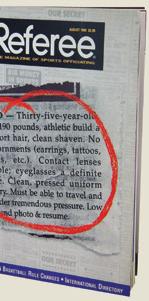

CAMPS/CLINICS/ SCHOOLS
ATTENTION ASSOCIATION LEADERS! Are you holding a camp or a clinic? Do you know of a camp or a clinic coming up? Referee can help get the word out! Call our sales department at 262-6328855 for more information.
LEADERSHIP RESOURCES
Association Advantage Membership to Association Advantage provides officials, associations and their leaders the tools to conduct wellrun meetings, education resources for officiating training and access to years of association management articles. Member associations
also receive 12 issues of Referee magazine, monthly Advisor newsletters, Click e-newsletters, massive discounts on training materials and optional insurance coverage exclusive to membership. For additional membership information, contact Ken Koester at 262-632-5448 or visit the Association Advantage website at nasoadvantage.com.
EQUIPMENT/APPAREL
Purchase Officials Supplies — Everything for Life Inside the Lines. Call 800-767-2233 or visit our website purchaseofficials. com for the best products and prices in the market.
Ump-Attire.com — The #1 website for officials’ sporting goods. Now serving
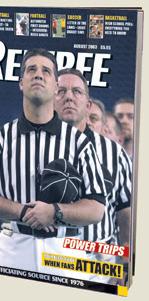

QUIZ ANSWERS
BASKETBALL
1 — NFHS – a (3-4-2d, 3-4-5,
3-6-1); NCAAM/W – d (1-22.5, 1-22.11, 1-23.1, 1-23.2, 1-24.1.d)
2 — All – d (NFHS 4-6-1, 4-6-2, 4-6-3, 9-11; NCAAM/W 9-15.2.a)
3 — NFHS – c (3-4-5); NCAAM/W
– a (1-22.4)
4 — All – c (NFHS 4-12-1, 4-12-
2a, 4-12-2d, 9-2; NCAAM 4-9-1.a, 4-9.2.a, 9-4.1; NCAAW 4-8.1.a,
4-8.2.a, 9-4.1)
5 — All – c (NFHS 4-1, 4.1.1; NCAAM/W 4-1)
FOOTBALL
1 — NFHS – a (6-2-4, 6-5-5, 6-56, 6.5.6 E); NCAA – b (6-3-6a, 6-5-1a)
2 — NFHS – b, e (7-5-7 Pen., 9-4-3j Pen., 10-2-1a); NCAA – d, e (7-3-8c Pen., 9-1-2a Pen., 10-1-6)
3 — NFHS – b (4-3-6d); NCAA – a (6-5-1d)
4 — Both – a (NFHS 9-4-5d; NCAA 9-1-16a-5)
SOFTBALL
1 — All – b (NFHS 8-6-10c and Pen.; NCAA 12.17.2.2 and Eff.; USA Softball 8-7J-2 and Eff.; USSSA 8-18F, Feb. 2018 Interp.)
2 — All – c (NFHS 8-4-3b and Pen., 8-8-3; NCAA 9.5.3.1 and Eff., 12.17.2.6.1; USA Softball 8-5B, 8-8C, R/S 36; USSSA 8-13, 8-18H Note 4)
SOCCER
1 — All – b (NFHS 13-1-5; NCAA 14.3.1; IFAB 14.2)
2 — All – c (NFHS 13-3; NCAA 13.2.2; IFAB 13.2)
3 — All – c (NFHS 12-8-1c; NCAA 12.4.3.3; IFAB 12.3)
4 — All – c (NFHS 12-3-1; NCAA 12.1.9; IFAB 12.1)
5 — All – a (NFHS 13-3-1; NCAA AR 13.2.2; IFAB 13.2)
VOLLEYBALL
1 — NFHS, NCAA – b (NFHS 10-4-3a-2; NCAA 12.3.1.1.2); USAV – a (19.4.2.2)
free returns to go along with more brands, product reviews, same-day shipping and world-class service.
Smitty Outlet Store
Visit the NEW Smitty Outlet Store featuring discontinued, factory seconds and individual slightly defective items at great prices. Go to smittyoutletstore.com to shop now!
TRAINING RESOURCES
Referee Training Center
— The largest library of officiating training materials in the world. Rules study, mechanics updates and materials on important topics can all be found in one location 24 hours a day, seven days a week, with sample chapters and video samples. Discover it all at store.referee.com.


FLASHBACK AUGUST
40 YEARS AGO … 1983
• NL umpire John Kibler, 54, suffers a mild heart attack. He spent four days in the intensive care unit of a New York City hospital before returning home to Oceanside, Calif., for the remainder of his recovery. He missed three months of the 1983 season before returning to the diamond.
30 YEARS AGO …

1993
2 — All – c (NFHS 5-5-3a and b, 5.5.3A; NCAA 19.3.7; USAV 24.3.2)
3 — NFHS – b (10-3-6c Note); NCAA, USAV – a (NCAA 11.3.2.2, 11.3.6.1.1; USAV 15.7a, S10.3.4)

4 — All – c (NFHS 8-2-1; NCAA 10.2.2, USAV 12.2.2.2)
5 — All – d (NFHS 9-5-1c-3; NCAA 14.6.1.3; USAV 14.1.4)
6 — All – c (NFHS 5-4-1d; NCAA 19.2.3.5; USAV 23.2.5)
BASEBALL
1 — All – a (NFHS 5-1-1i, 8-3-3d; NCAA 6-1d; pro 5.06b3C Cmt.)
2 — All – a (NFHS 6-1-3; NCAA 9-1b; pro 5.07a2)
3 — All – b (NFHS 8-3-3c, 8-3-5; NCAA 8-3o3 Note 1; pro 5.06b4G)
4 — All – a (NFHS 8-3-3c, 8-3-5; NCAA 8-3o3 Note 2, pro 5.06b4G)
MISSION
Referee is a magazine written from an officiating perspective, blending editorial credibility and business viability. It educates, challenges and inspires officials at the youth, recreational, high school, collegiate and professional levels in all sports, with an emphasis on baseball, basketball, football, soccer, softball and volleyball. Referee is the journal of record for officiating and takes informed positions on selected issues. The magazine provides a forum for its readers, facilitates the flow of information, raises public consciousness about officials’ roles and serves as a catalyst for improved officiating worldwide.
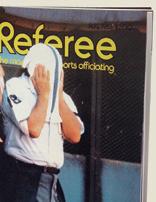
• Pac-10 football official Marty Herman, 40, drowns after a boating accident. Herman had been fishing with his mother, father and fiancée and was caught in 45-degree water after a storm blew through the area. The tragic event left the Arizona football officiating community devastated as Herman continued to work junior high, high school and junior college games while he was in the Pac-10.
20 YEARS AGO …
2003
• The National Labor Relations Board turns down a request by MLB umpires to file a complaint against baseball owners over the use of QuesTec. The computerized evaluation system was the subject of a no-confidence vote by 47 of 68 umpires in the union who said the system lacked accuracy to provide a sound and objective evaluation.
10 YEARS AGO …
2013
• NFL referee Al Riveron retires from the field and joins Dean Blandino in the officiating department. Side judge Don Carlsen and back judge Rich Reels also retired. Back judge Dale Shaw Jr., side judge Jeff Lamberth and referee Bill Vinovich, who all spent time as swing officials in 2012, were hired full time to fill crew vacancies.
REFEREE August 2023 | 81
STORY BY DANIEL BLOCK
‘Let Me Be Brave’
Some of you may know me, some of you may not, but my name is Daniel Block. I’m an umpire and a referee of multiple sports — baseball, softball, soccer, futsal and, one time, flag football.
I’m a sports official with a disability — autism spectrum disorder. It’s caused challenges for me during my work. I’ve had issues with assignments, ejections, game management and many others I’d rather not list.
But to be honest, it has also put me in the spotlight as an example for current and future officials like me, both positive and negative.
official. The challenges I face with communication, due to complications with assignments and training, happen because people — parents, spectators, fellow officials, coaches, league administrators, players and officiating associations — haven’t been clear and concise with me. This makes it difficult to work games and matches, which leads to more problems and challenges for me to work through to successfully complete the assignment.
Even though the training is built to help you succeed as an official, I feel I have been failed as an official with a disability and, more than likely, been ostracized by ableism within officiating associations. In short, they’re afraid of me failing.
As the Special Olympics Athlete Oath says, “Let me win. But if I cannot win, let me be brave in the attempt.”

To be honest, I’ve had to fight my way through obstacles I’ve faced in the past because no one has been willing to let me attempt matches and assignments at levels I’ve never done before. It hurts when, as an official who is dedicated to the craft and the players, you’re told you’ll ruin the game due to your disability.
But there are positives to being an official with a disability. For example, I was selected to officiate the Special Olympics USA Games at Disney World in 2022. As an athlete official (since I am a Special Olympian), it was a huge honor to set that example.
the athlete officials for the Unified Cup by attending the ringing of the NASDAQ bell in Times Square in New York.
I was lucky enough to meet honorary dignitaries from nations around the world at the Unified Cup. The Unified Cup is considered the World Cup of Special Olympics soccer (or, for those reading this overseas, football). Let’s say it was one of the biggest assignments I’ve ever had in my officiating career.
But recently, I had the opportunity to do something bigger than I thought I would ever have the honor to do. From June 17-25 of this year, I was one of two U.S. Soccer athlete officials invited to the Special Olympics World Games in Berlin. I had the pleasure to represent U.S. Soccer, the New Jersey Soccer Referee Committee and Special Olympics New York as I took the field to officiate games as a seven-a-side soccer official.
I officiate multiple sports and my local newspaper published an article about me. Now I’m here to tell you my story about the challenges I go through as an official with a disability and how those have made my career take shape.
Don’t let the naysayers stop you. Just because they say, “No,” that doesn’t mean they won’t consider you in the future.
For example, it’s been difficult for me to get assignments due to health issues, those being my weight — since autism can cause an overeating of carbohydrates, but that is a case-by-case basis — and disability. I also have issues with hand-eye coordination, another effect of my autism. This affects recognizing when I have to move to the next play, whether it’s close or far.
It’s hard for those like me to communicate with others, especially when I work as a sports
I was selected to officiate the softball tournament there, and I may have ended up on some TV report in the background, since umpires aren’t in the spotlight compared to the players. But it was encouraging to see the Special Olympics athletes there at the games thinking, “Yes, it is possible for someone like me to be an athlete official.” To take courage and step up and officiate them was really cool.
I was also selected to officiate the Special Olympics Unified Cup in 2022, which took place in Detroit. I was invited to represent
Once more, as the Special Olympics Athlete Oath says, “Let me win. But if I cannot win, let me be brave in the attempt.”
Think about that oath, and remember you can do it.
Never say can’t.
Daniel Block, Staten Island, N.Y., is a soccer, baseball and softball official working in New York and New Jersey. He is a member of the Staten Island Borough Umpire Associates, USA Softball of New Jersey Union County, an NJSIAA umpire and soccer referee and a USSF New Jersey soccer referee.
Do you have a personal officiating story to tell?
Send your story or queries to lastcall@referee.com
82 | REFEREE August 2023 SHUTTERSTOCK LAST CALL
A PERSONAL
To take courage and step up and officiate them was really cool.
Smitty Apparel is the #1 uniform worn on college football fields. The short sleeve shirts are available in standard mesh, or the popular Body Flex materials. The newest item to the line-up is the 126 single layer water resistant shirt. It featurres a stand-up collar and hook & loop sleeve closures.

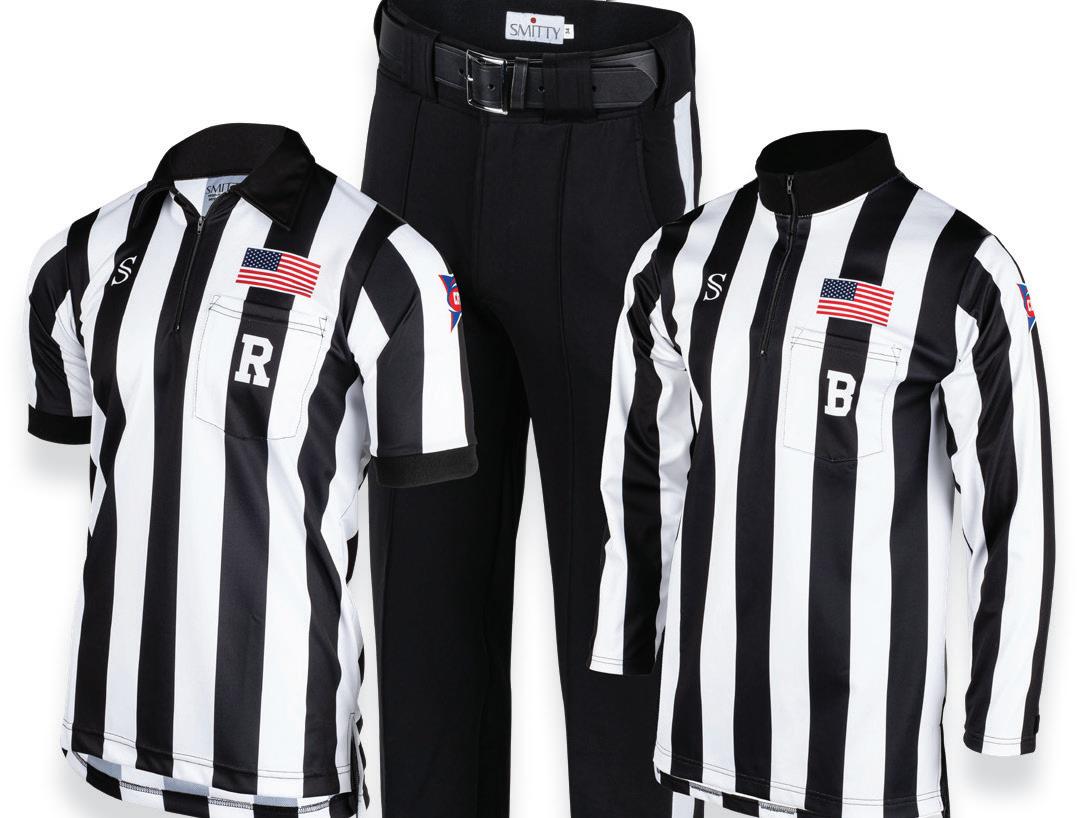
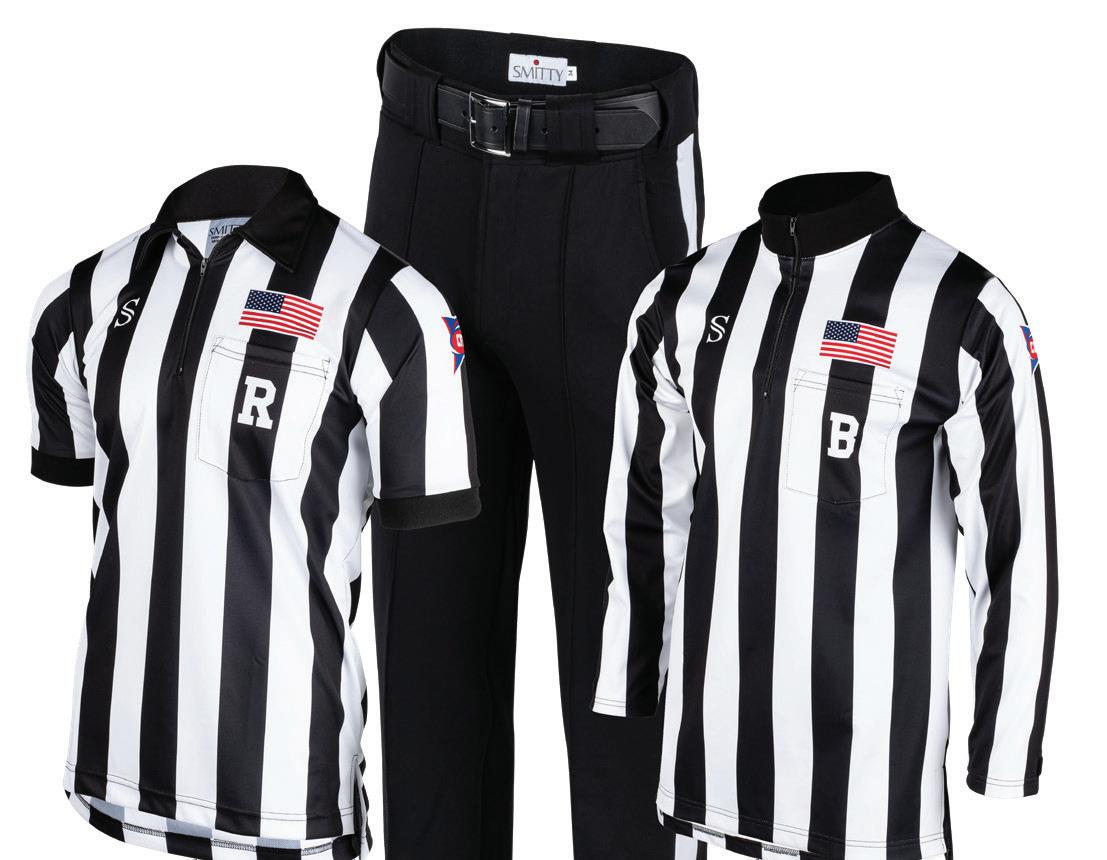
Our top selling pants are the premium 4-Way Stretch. The 4-Way Stretch material breathes for comfort and are designed to look good game after game.

800-767-2233 | www.purchaseofficials.com Join our loyalty rewards program and start saving today!
EVERYTHING FOR LIFE INSIDE THE LINES. EVERYTHING FOR LIFE INSIDE THE LINES. The Purchase Officials Website is #1 online. • Mobile Friendly • Advanced Tracking • Exclusive Ref Points Loyalty Rewards
Complete Order History • Free Returns Visit today and buy with confidence.
Smitty College Uniforms
•

IT’S OFFICIAL


Retention to Highlight 2024 Summit in Atlanta
After highlighting recruitment efforts and sportsmanship issues over the last two Summits, NASO is targeting retention for the 2024 Summit in Atlanta. Selecting the theme “Sustain Officials, Retain Officials,” NASO is looking to tackle the shortage crisis facing the sports officiating industry and looking to find creative ways to help solve the problem.




Building upon the lessons learned at the 2022 Summit in Denver, which looked at ways to recruit officials, the 2024 Summit will look at ways to help keep members and combat the attrition rates plaguing officiating. Stats show the majority of officials quit during the first three years, and NASO is determined to reverse that trend and find ways to help associations grow. Research also shows it costs organizations 10 times the money to recruit a new official than it does to retain an official.
“Every day it seems there are new articles published across the country highlighting the shortage of officials in our industry,” NASO president Bill Topp said. “We are committed to finding solutions to combat this issue and finding ways to help our members grow their ranks. While we recently highlighted ways to recruit new members,




we felt it was important to look at new ways to keep those members and make them feel wanted and appreciated so they stick around.”
Georgia is ready to host the 2024 Summit and join NASO in looking at new ways to retain officials.




“The elephant in the room with regard to retaining our contest officials is sportsmanship and safety,” he said. “A recent survey that I conducted with our registered officials shows overwhelmingly these two issues are not only hurting in the retention of our current officials, but also an obstacle in recruiting new ones.”
NASO recently concluded its 2023 NASO National Officiating Survey, powered by Referee.com, and the results of that survey will further drive the content for the 2024 Summit.






“We realize what an honor and privilege it is to be selected as a site for the Summit, and bring the best in the world of sports officiating to Georgia,” said Ernie Yarbrough, assistant executive director and coordinator of officiating for the Georgia High School Association (GHSA).
Yarbrough is excited to tackle this important issue and hopes the partnership can create ways to assist officials throughout the country.
“We are thrilled with the overwhelming response we got from officials who took the time and effort to complete the survey,” Topp said. “It gives us the ability to compare data from the 2017 survey and the results will help us provide content for the 2024 Summit and beyond. It will certainly help associations and state leaders combat an issue that is clearly at the top of the list of issues they are facing and gives us all a look into what officials are dealing with firsthand.”
Attendees at the 2024 Summit will have the opportunity to not only participate in generating ideas and listening to the brightest in the industry give their thoughts, they will also have the opportunity to take
NATIONAL ASSOCIATION OF SPORTS OFFICIALS
2023 1
august
advantage of all Georgia has to offer, something the GHSA and its staff is excited about.
“Atlanta is recognized as the ‘Capital of the South’ — a city that offers diversity in culture, business and entertainment,” Yarborough said. “Attendees and their families who attend the Summit will have the opportunity to explore a variety of fun experiences in close proximity to the Waverly/Cobb Gallery.”
In proximity to the Summit site are Braves Truist Park, Stone Mountain Park, Six Flags, Mercedez Benz Stadium, Atlantic Station and the CNN Center.
NASO and GHSA look forward to bringing the Summit back to the South and hope to see everyone in Atlanta.
6 Ways to Save Through NASO Membership



There’s nothing wrong with officials wanting to save some money when it comes to life and officiating. NASO understands that and has you covered. Here are some of the savings you can add up from your NASO membership:
3. Tack on travel savings. In addition to hotel discounts, NASO members can save on rental cars from AVIS every time they travel, whether on business or for personal pleasure. You can combine your exclusive NASO coupons with an already discounted group rate for extra savings.
Editor: Julie Sternberg
Sports Editor: Brent Killackey
Graphic Designer: Dustin Brown
Contributors: Don Collins, George Demetriou, Alan Goldberger, Joe Jarosz, Luke Modrovsky, Patrick Rosenow, Tim Sloan, Jeffrey Stern, Brad Tittrington, Scott Tittrington, Bill Topp
NASO BOARD OF DIRECTORS
Dana Pappas, Lebanon, Ind., Chair
Robert Smith, Waterloo, Iowa, Vice Chair
Bill Topp, Racine, Wis., President, Secretary
*Bill Carollo, Shorewood, Wis., Treasurer


*Ron Foxcroft, Burlington, Ontario, Special Adviser




Dean Blandino, Santa Monica, Calif.
Lisa Jones, Phoenix
Paul LaRosa, Metairie, La.
Pati Rolf, Pewaukee, Wis.
Sandra Serafini, Yachats, Ore.
Ron Torbert, Hanover, Md.
Mark Uyl, DeWitt, Mich.
Rob Wigod, Los Alamitos, Calif.
*Non-voting members
NASO MISSION STATEMENT








The mission of NASO is to:
• Serve members by providing benefits and services.
• Improve officiating performance through educational programs.
• Advocate opportunities for officials and engage in programs to recruit and retain officials.
• Create alliances with organizations that benefit from healthy officiating programs.
• Enhance the image of officials.
© 2023 NASO/Referee Enterprises, Inc. All rights reserved. It’s Official is published by the National Association of Sports Officials and Referee Enterprises, Inc.
Find NASO @ facebook.com/NASOofficiating
1. Avoid crippling court costs. Sure, it’s a savings we hope you’ll never need, but you never know. One of the greatest potential savings comes from NASO insurance. You have the luxury of knowing you have the most comprehensive Sports Officials Security (S.O.S.) Program available to sports officials: General Liability Insurance Coverage, $100,000 Game Call and Assigners Coverage, $15,500 Assault Protection Program and the Member Information & Consultation Program.
2. Get great rates on hotels. With the Marriott VIP card, NASO members may receive a room rate of up to 25 percent off the regular price at participating hotels where space is available. The discounted rate might not be offered if a hotel is sold out or anticipates being sold out. The Athletic VIP card must be shown at check-in. The card does not replace the Marriott Rewards card. It will help members continue collecting Marriott points.
4. Take advantage of book discounts. NASO members receive 20 percent off on educational materials from NASO and Referee. You can save money on some great publications and improve your officiating as a result. Win-win.
5. Dress for less. Ump-Attire. com offers an exclusive 10 percent discount to NASO members. You can use the email address listed in your NASO account when signed into Ump-Attire.com in order to access the Ump-Attire.com discount. Registered members will be able to access their discount without needing to remember a coupon code or having to call to place an order.
6. Deduct from taxes. Your NASO membership cost is fully deductible from your officiating income.
The savings add up with your NASO membership. Take advantage of your NASO benefits and tell others about them as well, so they can join in the savings.
2 IT’S OFFICIAL - august 2023 NATIONAL ASSOCIATION
2023 NASO Summit Support Organizations
The success of the NASO Sports Officiating Summit depends on the support of a number of sponsoring organizations. Here’s a brief description of each of the support organizations for 2023.
Alabama High School Athletic Association —
Founded in 1921, the AHSAA regulates athletic programs among its 414 senior high members and 287 junior high and middle school members, representing more than 100,000 students.
American Specialty Insurance-Risk Services Inc.










Founded in 1989, ASI specializes in insurance and risk services for the Sports and Entertainment industry. Over 50 niche programs are offered to the Professional Sports, Amateur Sports, Motorsports and Entertainment industries.
Big West Conference — Formed in 1969, the Big West is a NCAA Division I member with 11 nationally proclaimed institutions. Its goal is to empower every student-athlete in competition, in life and unite through championship experiences.
California Basketball Officials Association — More than 3,700 officials are members of the only statewide basketball officials association in the state, from youth to semi-pro competition.

Collegiate Officiating Consortium — The COC is a group organized to assist intercollegiate athletic conferences in all activities related to officiating. COC football officials work in the Big Ten, Missouri Valley, MAC, Pioneer League and various D-II and D-III leagues around the Midwest.
Colorado High School Activities Association
Serving 230,000 students in more than 360 member schools, the CHSAA was the host of the 2022 NASO Summit.
ArbiterSports — The company pioneered the use of sports-official-assigning software in 1984 and has been the industry leader ever since.
Arizona Interscholastic Association — AIA, started in 1913, is committed to the inclusion of equitable interscholastic opportunities for both boys and girls in all Arizona high schools.
Atlantic Coast Conference — The ACC, through its institutions, seeks to maximize the educational and athletic opportunities that shape the leaders of tomorrow — in the classroom, competition and life.
California Interscholastic Federation — A presenting sponsor of the 2023 Summit, CIF’s ideal of “Pursuing Victory with Honor,” provides the opportunity to dramatically influence the actions of the athletic community.
California Interscholastic Federation-Southern Section — Founded in 1913, the CIF-Southern Section is largest of the ten sections that comprise the California Interscholastic Federation. It is one of the presenting sponsors of the 2023 Summit.

Court Club Elite — Court Club Elite’s personalized basketball officiating training program includes all facets of becoming a successful high-level referee. The program covers training topics from basketball rules, to on-court mechanics and gamecalling, to effective game management strategies.
Division II Collegiate Commissioners Association
The mission of the CCA is to encourage and promote Division II athletics and high standards of sportsmanship as important elements of higher education. The CCA works as a communications channel to NCAA Division II members, and serves as a voice to the NCAA representing those schools.
Big 12 Conference — The Big 12, a Power Five conference headquartered in Irving, Texas, consists of 10 full-member universities.
Big East Conference — Founded in 1979, the league’s 11-member schools are committed to academic integrity, athletic excellence and community service. Reorganized in 2013, the Big East chose to return to its basketball-focused heritage.
Canadian Football League — The professional football league of Canada started in 1958. Currently nine teams battle each year for the Grey Cup.
DVSport Software Inc. — DVSport Inc. specializes in digital video acquisition, analysis, and playback software designed specifically for the sports market.




Capelli Sport — Capelli Sport is a multi-sports brand from Manhattan, N.Y. It creates products that enable athletes and communities to maximize their success on field and beyond. Providing diverse playing fields, which are safe for everyone, its best-in-class service empowers and unites people from all over the world.

Chief Zebra Enterprises — A consulting company founded by Mike Pereira, the former vice president of officiating for the NFL and current Fox Sports officiating analyst.
Eagle Tax Res — Eagle Tax Res Inc is a tax resolution firm specializing in fixing tax issues nationwide. It offers tax preparation for sports officials and knows the ins and outs of deductions for officials.
Big Sky Conference — The Big Sky, established in 1963, is one of three conferences in the western U.S. playing Division I football and is a national leader in the Football Championship Subdivision. It sponsors nine women’s and seven men’s sports.
Big Ten Conference — The Big Ten is the oldest Division I collegiate athletic conference in the U.S, and despite its name, consists of 14 member schools.
Cliff Keen Athletic — An officials apparel company, Cliff Keen Athletic is dedicated to the advancement of athletics through innovative products.
Collegiate Football Officiating LLC — CFO was formed in 2008 by the NCAA and the Collegiate Commissioners’ Association to ensure consistent application of football rules and officiating mechanics and to establish a leader for officiating.
Fox 40 International Inc. — Fox 40 is manufacturer of the world-famous Fox 40 Pealess Whistle. It developed an innovative and reliable product that revolutionized the whistle and changed the industry. Fox 40 products also include whistle attachments, gear, coaching boards, mouthguards and marine & outdoor products.
Fox40ShopUSA.com — Fox40shopUSA.com is the online retailer of Fox 40 products. Fox40shopUSA. com offers Fox 40’s complete product line and allows ease of purchase for all of Fox 40’s customers.
3 OF SPORTS OFFICIALS
National Football League Referee Association —
The group that represents all the NFL’s officials. The association is involved with charitable and educational efforts throughout the country.
Oregon School Activities Association — The OSAA serves 295 schools and more than 170,000 students in Oregon and served as co-sponsor and host for the NASO Summit in 2003 and 2013.
Reveal Media — Reveal Media is the market leader in body-worn camera solutions and digital evidence management software. Its advanced body worn camera technology has been adopted by multiple industries and organizations.













National Hockey League — Established in 1917 as the successor to the National Hockey Association the NHL is a professional hockey league with 32 member clubs: 25 in the U.S. and seven in Canada.
Pac-12 Conference — Upholding its tradition as the “Conference of Champions,” the Pac-12 has won more NCAA national team championships than any other conference in history.
South Dakota High School Activities Association
Organized in 1905, the SDHSAA directs the operation of the interscholastic programs of its member schools.
National Hockey League Officials Association —



The NHLOA was born in 1969 to improve working conditions, salaries and other benefits for NHL officials. All members are active officials working in the NHL and designated minor leagues.
Nevada Interscholastic Athletic Association —
The NIAA is the governing body of high school athletics in the Silver State. The NIAA has 119 member schools divided into five classifications.
New Mexico Officials Association — The NMOA is the officiating body for high school sports in the state, serving more than 46,000 student-athletes.
Pac-12 Football Officials Association — The group that represents all of the Pac-12 football officials. The association supports efforts to improve officiating throughout the Pac-12 Conference and the nation.
Professional Association of Volleyball Officials
For more than 20 years, PAVO has operated as an independent, non-profit organization working to train and certify volleyball referees in close partnership with USA Volleyball, NCAA, NAIA and NJCAA.
Southeastern Conference — A pioneer in the integration of higher education and athletic competition, the SEC is a leader on the national landscape for intercollegiate athletics.
Southern California Interscholastic Athletic Conference — SCIAC was formed in 1915 when five Southern California institutions joined to promote and govern competition in intercollegiate sports with the key principle of the conference being to encourage the highest ideals of amateur sports in an environment of high academic standards.

New York State Public High School Athletic Association — More than 389,000 athletes participated in one of the 27 sports sponsored by the governing body for New York State.
Officiating Collective — With more than 40 years of experience in the development and support of officials, the Australian-based organization provides support, education, training and professional development to all officials at various stages of their development pathway.
Professional Referee Organization — PRO is the organization responsible for managing the referee and assistant referee program in professional soccer leagues in the United States and Canada, working alongside U.S. Soccer and MLS, among others.
Sports Officials Care — Sports Officials Care is a non-profit organization dedicated to inspiring, educating, and uniting sports officials at all levels with the common goal of giving back and creating positive change in the world of sports and in the community.
Ohio High School Athletic Association — The OHSAA co-sponsored the 2008 Summit. There are approximately 15,000 officials, 70,000 coaches and 400,000 athletes affiliated with the OHSAA.

Purchase Officials Supplies — Purchase Officials Supplies is based in Ohio and offers officiating gear in nine sports. The company works with several states to provide officially licensed apparel.
Summit Well-Being Anonymous Team — A group of anonymous donors that contributes annually to the NASO Summit.

QwikRef — QwikRef is an online reporting tool used by coordinators of officials to evaluate, train, and analyze conference officiating staff. QwikRef integrates every part of the officiating program and can be modified to meet new initiatives.
Referee Magazine — As the original magazine for sports officiating and the industry’s best-known publication, Referee has set the journalistic standard for developing educational materials for officials.
Oklahoma Secondary School Activities Association — Dating back to 1911, the OSSAA organizes secondary school athletics and activities in the state. It currently serves 482 member schools.
Oregon Athletic Officials Association — The OAOA represents all high school officials in Oregon. The OAOA works to enhance the quality, consistency and perception of officiating throughout the state.
RefReps — Comprised of comprehensive officiating education courses and interactive training video packs the RefReps Officiating Education System™ will help you create a modernized educational experience. Equip your organization to teach the pillars of officiating with the standardized online course curriculum with instructor guides, support materials, assessments, example videos, and more.
Sun Belt Conference — Founded in 1976, the Sun Belt is one of 10 NCAA D-I FBS conferences. It offers 18 sports for more than 5,500 student-athletes.
Texas Association of Sports Officials — Formed in the 1930s, TASO is an independent organization of sports officials in Texas governed by sports officials.


Texas High School Basketball Officials Association — The association, in conjunction with the state governing body, aids in the education and development of basketball officials throughout the state.
Ultimate Fighting Championship — Started in 1993, UFC is a professional mixed martial arts organization offering the premier series of those events.
5 OF SPORTS OFFICIALS
Ump-Attire.com — The leading online retailer for sports officials’ gear and apparel.









USA Hockey — With a membership of more than 525,000 ice and inline hockey players, coaches and officials, USA Hockey’s main emphasis is on the support of grassroots hockey programs.
Washington Interscholastic Activities Association

Founded in 1905, the WIAA governs high school sports for nearly 800 schools in Washington.
UMPS CARE Charities — UMPS CARE Charities was founded by MLB umpires. UMPS CARE provides financial, in-kind and emotional support for America’s youth and families in need.
United States Polo Association — The governing body for the sport since 1890, it sponsors numerous programs for education and promotion of the sport in the U.S.
United States Tennis Association — The governing body for tennis, the USTA sponsors local leagues and tournaments and runs the U.S. Open, one of professional tennis’ four Grand Slam events.

USA Softball — Established in 1933, USA Softball, formerly the Amateur Softball Association, is the largest governing body for softball in the United States.
Washington Officials Association — Founded in 1946, WOA provides officials for WIAA-sanctioned events. The organization works to promote, recruit, educate and retain officials throughout the state of Washington. WOA officials are members of NASO through a partnership begun in 2018.


University Interscholastic League — Since 1910, the UIL has grown into the largest inter-school organization of its kind. More than 785,000 athletes participate in UIL sports.
USA Volleyball — USA Volleyball is the national governing body for the sport in the United States and is recognized as such by the Federation Internationale de Volleyball and the U.S. Olympic Committee.
West Coast Conference — First formed in 1952, the WCC has evolved and grown to become a nationally recognized and competitive force in intercollegiate athletics, with 15 league-sponsored sports.
USA Cheer/STUNT the Sport — USA Cheer is the United States governing body for sport cheering recognized by the International Cheer Union serving the cheer, dance team, and spirit community. USA Cheer program STUNT is a new female sport that incorporates skills derived from cheerleading.

U.S. Center for SafeSport — The nonprofit organization is responsible for responding to and preventing emotional, physical, and sexual misconduct and abuse in the U.S. Olympic and Paralympic Movement.


US Youth Soccer — The largest youth sport organization in the country provides support and resources to help members fulfill fulfill their goals on and off the field of play. US Youth Soccer registers nearly 2.5 million players annually.
VOKKERO
Vokkero USA by VOGO Sports — Vokkero USA by VOGO Sports is a company working to bring headset tech to officiating.

West Virginia Secondary Schools Activities Commission — WVSSAC seeks to present proper ideals of sportsmanship so that coaches, players, school authorities, game officials, and spectators may combine to make any activity enjoyable and productive of physical and social benefits to both sides involved in the contest, with partisanship and prejudice eliminated as far as possible.

Wisconsin Interscholastic Athletic Association WIAA serves more than 500 schools and more than 300,000 students by cultivating, developing and organizing high ideals of good citizenship and sportsmanship.
NASO Has No Age Restriction for Insurance
NASO has long been the leading advocate, educator and protector of sports officials at all levels and in all sports. The wide net cast by NASO and its insurance includes all age demographics. NASO has no minimum or maximum age restrictions on any members.

So, a 12-year-old Little League baseball umpire in his first year on the diamond? Covered. How about an 85-yearold track & field starter in her 50th year registered with the state association? Covered. Everyone older, younger or in
between, in any sport, at any level? Covered.
Some Sports Officials Security Program benefits of NASO membership are highlighted here with corresponding applicability to youth or senior officials.
General Liability Insurance
Protection — We live in a litigious society. No one, young or old, is immune to the possibility of being sued for an array of issues that might arise during an athletic contest. NASO provides members with the most comprehensive insurance

protections in the officiating industry with up to $6 million per occurrence and an overall aggregate of $14 million for claims of bodily injury or property damage.
Member Information & Consultation Program — No matter your experience level, questions arise. Whether this is your first season working
6 IT’S OFFICIAL - august 2023 NATIONAL ASSOCIATION
games or you have been through so many rule change cycles that your sport is barely recognizable, things “come up” in this industry. Lean on NASO staff for general inquiries and assistance or be paired with an individual in the NASO network for in-depth consultation on a specific topic.
Assault Protection Program
— Society seems less civil every passing day. Sports is life with the volume turned up and it has never been more dangerous to be a sports official. You may be a minor officiating a youth league or a senior citizen working adult league rec ball. Just know that NASO has your back no
matter the circumstance — up to $10,000 medical reimbursement; up to $4,500 attorney fee reimbursement; up to $1,000 for loss of game fees if you are a victim of assault.
For more information about NASO insurance benefits, please visit naso.org/member-benefits/ insurance.

How to Pick a Charity to Support
More and more associations are supporting charity or fundraiser efforts. Whether it’s raising money for cancer research, handing out college scholarships or participating in walk-a-thons, there are many options out there for groups. How should an association choose where its money goes? Here are some ideas to consider.
Consider a community cause. Maybe several schools in your area are getting together for a tournament to support military families and are looking for officials, or a children’s hospital is having a fundraiser. By supporting a community drive, you are giving back to friends and neighbors. Community efforts are worth considering.

Be careful about supporting an individual school fundraiser.
When asked to support a fundraising effort for Middletown High School, your group might want to think twice before participating. By supporting the cause of one school, you might be sending the message to others that you favor that school. It will
be tough to convince another school you will be fair and impartial when calling the next game.
Determine a cause near and dear to members.
Did a member recently lose his wife to breast cancer? Did a member’s family lose their house in wildfires? Check with members when choosing a cause to support. More will likely be willing to participate if the money is going to support one of their own in some way.
It’s OK to choose multiple charities.
If your group has a tough
ASSOCIATION




ADVANTAGE
Running a local officials association is demanding. You volunteer your time and effort to make it the best you can. But there’s no reason you have to do it alone. NASO Association Advantage exists to help you face any challenge and elevate your association in the process. Whatever challenges you have — training, insurance, legal issues, meeting help, bylaws and organization, membership issues and more — WE HAVE A SOLUTION TO MEET YOUR NEEDS.
PLATINUM & PLATINUM SHIELD
Association Advantage Platinum is the premier resource for maximizing the performance of your group, providing leadership and administrative resources to help you elevate your organization with a focus on training,
FROM OUR DATABASE
time deciding which charity to support, consider choosing two or three different causes. Or choose one for the current year and another for the following year. If several members are excited about a cause, you don’t want to alienate them by rejecting it and going with another one.
Share your charity efforts.
Let the media know what your group is doing. It’s good to share your efforts. It will shed positive light on your group and officiating and it might encourage others to support the same charity.
assigning, legal issues and best practices specific to local officials association management.
TITANIUM & TITANIUM SHIELD
The Titanium solution is ideal for officials associations that want to maximize their organization’s performance while fully protecting both their organization and individual members.







DIAMOND
The most comprehensive solution for officials associations that want to fully protect both their organization and individual members, as well as provide full training and testing solutions with an emphasis on video. Association Advantage Diamond is the ultimate answer to every challenge your association faces.



To learn more, go to NASO.org/Advantage or call us at 262-632-5448

7 OF SPORTS OFFICIALS
From the Chair The End of an Era
By Dana M. Pappas
ver the past year, I have had the profound honor of serving as chair of the NASO Board of Directors — a role that I could have only dreamed of holding over 25 years ago when I began working in the officiating industry. My four years on the board, two of which were served during the uncertainty of the pandemic, flew by and as I wind down my term as chair, it is bittersweet because it coincides with the end of an era in the NASO family.
When Barry Mano announced to us that he would be stepping away as president of NASO at our April Board meeting, I felt overcome with emotion. Barry is synonymous with officiating. In so many ways — and he would hate that I am writing this — Barry is Referee magazine. He is the backbone of NASO. He has tirelessly and selflessly advocated for officials in all sports and all levels since he first founded the magazine in 1976. He has been the voice of the industry and the most relied upon expert in all things officiating for almost 50 years. He had a passion-based vision when he founded the magazine and has held steadfast to it, with officials at the forefront of everything he does, and has inspired others to do the same.
Barry and his beautiful and brilliant wife, Jean, are officiating royalty. The two of them have dedicated their lives
Oto ensuring that officials are supported, protected, celebrated, respected, and that they have the necessary tools to perform their duties on game day. I have had the honor of knowing them for most of my professional career and they have been a continual source of inspiration and support over the years. I owe them a debt of gratitude, as do so many others in this industry.
As Barry steps away as President, it only makes sense that the person to carry on the rich traditions and legacy of NASO is none other than its current chief operating officer, Bill Topp. Bill has spent his entire career of more than 30 years with REI and NASO, starting as an intern and working his way up to the COO position. He has the historical knowledge of the organization, the relationships throughout the industry, and the passion and vision to carry us all into the next chapter. The baton being passed from Barry to Bill is the best handoff we could have hoped for, as it will be a seamless transition for the organization and the industry.
The NASO Board of Directors is excited for the opportunity to work with Bill in his new role and we will all keep Barry on speed dial, too, as there are some people who are invaluable to an industry, both professionally and personally. The Board has some exciting work ahead of us. We will assist NASO with the transition in leadership and are excited for the tasks before us.
One of the largest tasks will be dissecting the data from the recent officiating survey, wherein an unprecedented number of officials — more than


35,000 — wanted their voices heard. It is the task of the Board to really hear those voices to make actionable plans to address the needs of officials in all sports and at all levels. Using the survey data as a beacon for what we do and what we decide as a Board is exciting, and we are ready to get to work.














While roles change within NASO, one thing that will never change is the desire to serve officials. It is in our DNA. It is not just a job or an avocation for us, it is something we truly love and something that makes us whole. If you are reading this column, know you are what fuels all of us to always fight the good fight and to do the work to ensure that officials are seen as a priority to everyone in the sport setting. That is what Barry has done for over 50 years and, even as he steps away as president, that is what we all know he is wired to continue doing.

Best wishes to Barry and Jean on whatever this next chapter holds and thank you both for the indelible mark you have made on this industry and the positive impact you have made on the lives of so many, including mine. Bill — let’s keep on doing what we love. In the words of American novelist, John Irving, “You only grow by coming to the end of something and by beginning something else.” Here’s to growing together!
Dana M. Pappas of Lebanon, Ind., is the NFHS director of officiating services. Previously, she spent 24 years with the New Mexico Activities Association, most recently as deputy director and commissioner of officials from 2012-21.

8 IT’S OFFICIAL - august 2023 NATIONAL ASSOCIATION
sports section the Road to Recovery
By Judson Howard
What is universal about the experience of all sports officials? You may think it’s being nervous working your first contest. How about dealing with all the administrative tasks to become and stay qualified? Or balancing being an athletic competition arbiter and your career and family life. And another universality: the first and subsequent times we miss an obvious call and have to live with it.









This is when a ruling was clearly incorrect and everyone probably knows it. Perhaps it was caused by an error of judgment, lack of rules knowledge or inappropriate mechanics.
Unlike the players, where a substitution can be made to get the errant contestant removed from the game, officials have no option to be benched during play.
After an incorrect call, an official must face the consequences and continue to work. This is especially difficult if such a ruling is early in a competition, when there’s more time to think about it.

In addition to building back your composure, probably the most important thing is to win back the trust and confidence of the coach and other participants. You want to reestablish credibility as a competent official

and move on to finish the game. How do you do this? Here are a few suggestions:

• Do not seek opportunities to correct your mistake through other calls. You can’t fix the situation through a make-up call. If you try, you’ll only have both teams upset with you — and you will have lost all credibility as an official.
• Don’t give the aggrieved coach special attention or more face time as the game progresses. It is nearly impossible
permission to totally go off on you. After a reasonable amount of venting, it’s fine to let them know you’ve heard enough.




• It’s usually better not to admit to the coach that you erred. No need to validate their perceptions. This could expose you to other criticisms. If you need to redirect their energies, talk about moving on and perhaps promise a higher level of concentration.
to compensate for an error by trying to befriend a coach.
• Keep body language neutral. Do not let your physical demeanor or facial expression show your disappointment. Keep your head up and move at your normal pace.
• It’s OK to give a coach a longer leash in the face of an error. But this doesn’t give them

• Don’t dwell on the mistake. It will be hard to focus on the remainder of the game if you’re preoccupied with the previous error. You cannot be an effective and an attentive official if you are still worried about what previously happened. There will be a time later to examine the circumstances, but not during remaining play. To put the error in the back of your mind, work to get back into the flow of the game. Focus on your normal preplay routines and mechanics. For example, in football, change your down indicator, count players, etc. For baseball, what is the ball/ strike count, how many outs, etc. For basketball, time on the clock, the substitution process, etc.
• Wait until after the game ends to discuss the play with fellow officials — and do so in the locker room or parking lot far away from participants and spectators. Then you can get other perspectives. Be prepared for your peers to tell you what they saw. Do not try to justify
OF SPORTS OFFICIALS NATIONAL ASSOCIATION OF SPORTS OFFICIALS
9
Do not let your physical demeanor or facial expression show your disappointment.
your way out of culpability. Use this interaction as an opportunity to learn. Their input can help you avoid similar errors in the future. Or you will solidify the knowledge of a rule you didn’t know as well as you should have.
Don’t dwell on a possible downgrade or criticism from your supervisor or assigner. You cannot worry about the impact of your misstep on your upcoming schedule or future career. Typically, a single error won’t result in major repercussions.
All officials in every sport have made incorrect calls. And we all got past them and learned from what happened to make us better officials.
Judson Howard, Los Angeles, officiated more than 20 years, many at the NCAA Division I level.
BASEBALL
An Introduction to Arguments










 By the Referee editors
By the Referee editors

Umpires hear a lot of chatter, some of it even intelligent. One of the secrets to success as an umpire is knowing when to respond to what you hear. There are several times during a game when it can be a good time to have some positive communication with players and coaches and use the interaction to improve your credibility. Recognizing those times and knowing just what to say, however, can be an art form.
First, bear in mind that coaches are mentally juggling a lot of issues during the game. So for the coach to listen to what you have to say usually ranks last on their list. They
usually only need to hear from you when it helps them with things farther up the list. So don’t be eager to stand over them and force information on them whenever you think you might have some. Instead, wait until you’re spoken to and, if the coach really wants to know, be ready to supply the coach with a clear and concise explanation of what happened. Don’t say 50 words when 15 will be just fine. Often, they already know and sometimes they don’t care what happened but, when it’s your turn, offer an explanation but not an opinion and you should be off to a good start.
Sometimes they’ll thank you and sometimes they’ll give you their optometrist’s business card, but you’ve done your job. As umpires you might have to offer some more detail if they need a little more information, but it’s usually better to let them have their say without rebuttal.

Remember it takes two to have an argument, so the best thing you can do when someone is moaning is to keep your manner neutral. Make eye contact without appearing to posture and nod occasionally to make sure the coach or player understands you’re listening to them. Then move to your position once all points have been made.




Next comes a branch in the logic tree. If the coach lets it drop, you should let it drop. Unfortunately, if they want to carry on, try some psychology and get them to understand that they have been heard but that it’s time to move on.
Step one is to acknowledge what the coach said. “I understand your point, coach, but that’s the call and we’ve all still got work to do.”
Step two is explaining what’s going to happen next if things
don’t quiet down. “OK, coach, you think we got it wrong. Fine, but now you’re starting to interfere with me doing my job and then you and I might have something more serious to deal with. I don’t think you or I want that happening, so we’ve got to break it off, right here.”
Now, you’re giving the coach an opportunity to stop without anyone being embarrassed and you’re dropping a clear hint that, if he continues, there will be repercussions.
Any further carrying on just brings about step three: the official warning, which should be both verbal and written. “Coach, this is your official warning. If you continue to argue, you will leave me no choice but to eject you from the contest.” The critical thing is to promise what will happen and to give the coach the choice to comply or not.
If you get to step four, the rules of your competition dictate the penalty to apply. Don’t hesitate. If you’ve used some form of that methodology, you’ll then be able to construct a pretty good description in your postgame report to your assigner or coordinator of how the coach hung himself, not how you ambushed him.
If dealing with coaches and players were easy, officials would make about 55 cents per game; anyone could do the job. We start earning our pay when our authority begins to be challenged. That isn’t the end of the world, merely the way of the world and we need not take it personally.
Always take the high road when dealing with coaches, players and administrators and develop a good formula for saying and doing the right things to keep differences from escalating into something worse.
10 NATIONAL ASSOCIATION IT’S OFFICIAL - august 2023
FOOTBALL
Do You Read Me?
By the Referee editors




Signaling is the language of officiating. Use the proper signals and that language will be fluent. Use improvised or sloppy signals, and it will be Greek to those you are trying to inform.
In terms of signaling, you’ll probably want to emulate someone you admire. That’s a sensible policy of course, but you’ll also want to make the style your own. In other words, establish proper practices. Be conscious of your posture. Stand up straight. When signaling penalties, get away from players and execute the moves out in the open and remain stationary.
You run a game with your signaling, and the people you’ll want observing you will be fellow officials, the players, coaches and spectators. You have to demonstrate a preference for being on display. Act like you’re invigorated and somewhat enthusiastic, keeping your face with a neutral, unemotional image: no frowning, no smiling and no tension (such as clenched teeth).
First things first: the readyfor-play signal. It isn’t used as much as it used to be because of the play clock, but it merits mention anyway. It used to be called “pulling the chain.” It can still be characterized that way, although many referees today seem to give it an almost lackadaisical and abbreviated tug. Here’s a suggestion. Raise the arm about head high (so it is visible) and give it a pronounced downward pump to the waist while at the same time blowing a tweet on the whistle.
The ready whistle is more clipped than one that ends a
play. The ready should usually be signaled about three seconds after the ball has been placed on the surface so that you can maintain a steady rhythm in the flow of the game. That pause may be delayed to let receivers get back to their own side of the line after an incomplete pass, to let an injured player get off the field or after a change of possession, to permit both teams to exchange personnel.
The ready may be followed by winding the clock (if necessary). Watch the pro and college guys. They often spin the arm in an almost indolent fashion, facing downfield. Don’t ever pull the chain with your back to the ball. You may have forgotten to wind the clock, and a crewmate could remind you. Give at least two arm spins and look to be sure the clock has started. Remember, if you’re relying on a fellow official to time the 25-second count, the signal must be forceful and distinctive enough.
To signal the clock to stop, swing the arms overhead and cross them, with some impetus. It’s not a casual wave, but it has to be seen by the timer. The referee must flag every illegal presnap line movement and stop the clock. Toss the flag about head high and off to one side. You may have to wait for a wing official to tell you the nature of the foul, so you’ll get the clarifying message after the clock is stopped.
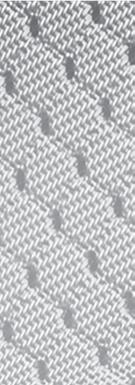
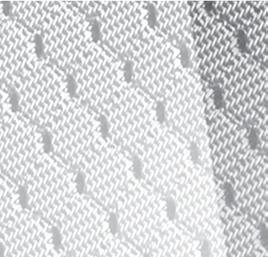
Raise your arm straight up to indicate the dead ball, open palm facing the sideline and give the signal with firm limbs, a tight clutch at the sides for encroachment, elbows out and strong arm rotation for false starts. (Note: In college ball the dead-ball signal is not used for presnap fouls). Have pliable limbs, not stiff and jerky; you
All NASO members get an exclusive 10% discount as a benefit of NASO membership. Members are able to use the discount on Ump-Attire.com’s 850+ o ciating gear and apparel and qualify for free shipping o ers and free returns. Registered NASO members will be able to access the discount automatically without using a coupon code or having to call to place an order.


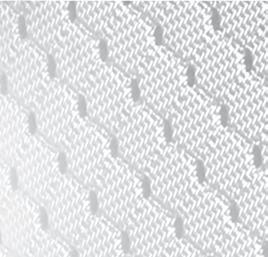


















11 OF SPORTS OFFICIALS
EXCLUSIVE 10% DISCOUNT AT UMP-ATTIRE.COM
want to look smooth, like an athlete. Point at the offending team with a straight arm parallel to the ground. A bent arm and an open hand (pointing) look amateurish.
There was a time when referees signaled first downs in a “charged” kind of way, almost throwing the arm forward, with a flip of the elbow. However, in recent years many referees have become almost lethargic, a casual chop move. You decide. Will it be a shoulder-exploding fling or more low-key?



To signal a touchdown, twopoint try or successful scoring kick, put your arms at your sides, thumbs against your palms, palms against your legs. Then lift your arms straight up over your shoulders, stretched out, hands about a foot and a half apart, and count slowly, “One thousand one, one thousand two.” Then drop them. Only about 50 percent of officials give that signal with class. Make yours be classy.
SOFTBALL
Postseason Communication







 By Brad Tittrington
By Brad Tittrington
When it comes to postseason assignments, the most crucial thing for umpires is communication. While some states have umpires work with the same crew throughout the tournament, this is not the case in most states. It is also not the case if you are working in the NCAA or if you are working a USA Softball or USSSA national tournament. Generally, in all codes, you are working with different partners each game.

So how do you function effectively as a crew when the crew is changing each game and you may be working
with unfamiliar partners?



Communication. Often, umpires show up to games and may not have a long pregame conference — if they have one at all — during the regular season. This is especially true if you are working with partners you know or if you are rushing to the field from work and get to the field just minutes before first pitch. But when it comes to the postseason, the pregame conference with the crew is especially important. It sets the tone for the game, familiarizes the umpires with each other and it makes sure the entire crew is on the same page.
And while you may be able to umpire in your sleep when it comes to two-person mechanics, postseason assignments often throw you into three- or fourperson systems with which you may not be as confident or familiar. This is why it is important to get to the field early, sit with your partners and have a thorough discussion on how you are going to handle situations that typically arise during games to make sure everything is covered.
After you’ve had a thorough pregame, take the field as a crew with confidence as you are now prepared to work whichever meaningful game you have been assigned. Trust your partners are going to be where they are supposed to be and trust yourself to know you are going to do the same. However, be aware communication, both verbal and non-verbal, is even more important in these games when the stakes are higher and you may be working with people you’ve never worked with before.
As a base umpire, be vocal when chasing so the rest of the crew knows you’ve vacated your position. As the plate umpire,


communicate to the remaining members on the infield that an umpire has chased. Sometimes, especially if umpires are new to working with multiple base umpires, the vocal cue helps to remind the remaining umpires a partner has chased as they may have “forgotten” to read their partner. That verbalization can quickly clue them in they need to cover for the partner who has chased.
It is also important to communicate in situations where there could potentially end up being multiple umpires in the same location. When working three- or four-person mechanics for the first few times, it isn’t going to be ingrained in your mind. You may have paralysis by analysis as you are running through every possible scenario in your head and thinking instead of reacting. You may forget which runners or bases you are responsible for and when you need to rotate or stay put. While pre-pitch preparation can assist, communicating with your partners is essential. When you rotate to a base, simply say, “I’m here,” or “I’ve got third,” and it will clue the umpire who may be standing there that said umpire needs to move. Don’t be afraid to overcommunicate if you are working with new partners or inexperienced partners who may need the verbalization to help cover these situations. The same thing goes for tag plays. Communicate, “I’ve got the tag at third,” or, “I’ve got the lead runner,” so your partners know that isn’t their responsibility and you don’t end up having multiple umpires watching the same bag and another runner goes unnoticed.
Don’t be afraid between innings as base umpires to get together and discuss coverages as well. If a particular play wasn’t
12 NATIONAL ASSOCIATION IT’S OFFICIAL - august 2023
handled right in a previous inning from a mechanics standpoint, briefly talk about it between innings with your partner so you can make sure you have it handled properly going forward.
Also, don’t forget about your non-verbal communication as well. While some codes, namely the NCAA, have signals prepitch in the four-person system so umpires can communicate rotations, others do not have prescribed mechanics. However, it is important you are still communicating pre-pitch when there are infield fly situations, two-out timing mechanics, when the infield fly is off, etc. Give your signals consistently and roughly at the same time each instance so your partners can be reliant on them.
Be vigilant in giving signals and communicating to make sure everyone is on the same page. Remember, it is better to overcommunicate than to remain silent and potentially allow a play to blow up on the crew because no one communicated before or during a play.
Brad Tittrington is an associate editor for Referee. He umpires D-I softball and officiates women’s college and high school basketball, college and high school volleyball and high school football.
VOLLEYBALL Seeing Through the Screen
By Referee editors
There are various difficult calls to make during a match. Some argue that ballhandling or back-row faults pose the greatest challenge, while others contend that plays at the top of the net are the most demanding. However, the often-overlooked
and arguably most difficult call to make is related to screening. This article explores the reasons why screening calls present significant challenges for referees and how they navigate the complexities.
Referee Perspective: Limited Viewing Angle
The primary reason why screening causes problems for officials is their positioning, which often hampers their ability to clearly observe a screen. The ideal view is from the endline, where the server, the flight path of the ball and the players affected by the screen are visible. Unfortunately, referees stationed at the top of the net have the worst view, making it challenging to accurately assess screens. Although the opposing team’s bench offers a relatively better perspective, it remains inferior to the endline view. Consequently, officials must adapt to this inherent limitation.
Differing Verbiage in Rule Codes

To further complicate matters, the three rule codes have slightly different definitions of what constitutes a screen. NCAA and USAV rules state that players on the serving team must not take actions that prevent opponents from seeing the server and the flight path of the ball. In contrast, NFHS rules use the word “or” instead of “and,” meaning that players on the serving team cannot take actions that prevent receivers from seeing either the contact of the serve or the path of the served ball.
This subtle variation in verbiage significantly impacts the decisions made by officials. In NCAA and USAV competition, both criteria must be met to call a screen, resulting in potentially fewer screening
calls. Conversely, NFHS rules require only one of the two criteria to be met for a fault to be called. However, even with these differences, screening calls remain infrequent across all rule codes.
Defining Screening and Its Limitations
















All three rule codes provide examples of actions that may constitute screening, which are generally consistent. Examples include players jumping, moving sideways or waving their arms when a serve is executed. Screens can be committed by individual players or groups, regardless of whether they are in the front or back row. However, the examples provided do not cover every possible scenario. It is important to note that there is no rule prohibiting players on the serving team from extending their hands or arms above their heads. However, when such gestures occur, they serve as a cue that a screen may be possible. In these situations, referees often instruct players to lower their hands or spread out if they are standing too close together. This preventive measure aims to address potential screens when the ball is served over the player(s).
The Role of Adaptation and Positioning
While preventive measures are necessary, it is crucial for officials to exercise appropriate judgment. Referees cannot demand that players move to specific spots on the court, as players are entitled to position themselves as they see fit within the requirements of position and service order rules. Additionally, receiving team players do not have a guaranteed location on the court and may need to make minor adjustments to their
13 OF SPORTS OFFICIALS
position to overcome screening challenges. When a receiver needs to move significantly or when a serving team player deliberately obstructs their view, the likelihood of a screen increases.
Referee Techniques and Communication











As referees prepare to authorize the serve, a quick glance at the receiving team can indicate if they are facing any difficulties in seeing the server. Often, the receivers themselves will convey their struggle by expressing their inability to see clearly. In such cases, a proactive approach often resolves the issue. Reminding the serving team that they may be at fault for a screen if the ball is served over them and allowing them to make adjustments usually proves effective. Before beckoning the serve, referees should quickly assess the positions of the serving team players to identify any potential obstructions to the receivers’ view. In these instances, a brief verbal reminder can be appropriate.
Screening calls in volleyball present a significant challenge for referees due to their limited viewing angles. Despite having defined rules and examples, the difficulty lies in accurately assessing screens from the elevated referee stand. Verbal reminders and preventive officiating techniques serve as the best options for referees to navigate this challenging aspect of the game. While there may be occasions when a screening fault must be called, these instances are likely to be rare. Ultimately, striking a balance between fair judgment and maintaining the flow of the game is crucial for officials handling screening calls in volleyball.
ASK US

BASKETBALL
Pass or Dribble?
Play: A1 is holding the ball inbounds and has not yet dribbled. A1 sees that teammate A2 is open for a pass and releases the ball while attempting to pass it to A2. A2, however, does not realize A1 is trying to pass the ball to A2 and runs to some other position on the floor. The thrown ball bounces on the floor near the position A2 formerly occupied, and A1 quickly runs to retrieve the ball. A1 is the first to the basketball and (a) grabs it, or (b) pushes the ball to the floor and dribbles it. Does this play result in a violation? Ruling: A pass is only a pass if it touches another player, so A1’s throwing of the ball was not a pass. As soon as A1’s throw hit the ground, but was not touched by another player, it began a dribble as a dribble is ball movement caused by a player in control who bats, pushes, or taps the ball to the playing court one or more times. In (a), when A1 grabbed the ball, it ended the dribble. In (b), when A1 pushed the ball to the floor again, it was simply the continuation of A1’s dribble. Therefore, this play is the legal start of a dribble in both (a) and (b) (NFHS 4-15-1, 4-31; NCAAM 4-13.1, 4-25; NCAAW 4-12.1, 4-19).

BASEBALL
umpire he would like to elect to take the catcher’s interference instead of the play. Ruling: Not allowed; the batter and all other runners advanced at least one base. The interference is ignored and the play stands (NFHS 8-1-1e; NCAA 8-2e1; pro 5.05b3).


No Escape
Play: The starting pitcher is removed from the game as the pitcher in the fifth inning and is sitting in the dugout. A couple of innings later, he shouts an offensive comment to the plate umpire after a play at home plate and is ejected. Ruling: In NFHS and pro, it is treated the same as any other ejection unless there are special circumstances. In NCAA, there is also a four-game suspension (NFHS 3-3-1f; NCAA 2-26e; pro 6.04).
Shoulder Turn
Play: The pitcher, before having made his stretch and having his hands come together, turns his shoulders to check the runner at first base. Ruling: That is a legal move (NFHS 6-1-1; NCAA 9-1b; pro 5.07a2).
FOOTBALL
Roughing Foul?
No Option


Play: With R1 on first and no outs, B2 is interfered with by F2 but hits a single to right field. R1 is thrown out attempting to advance to third. The offensive head coach informs the plate
Play: R1 dives in an attempt to block a field goal. He deflects the ball and contacts the kicker. Ruling: A player who touches the kick is exempt from being called for roughing the kicker or holder. Touching of the kick by the defense is generally an excuse for contacting the kicker or holder. However, the ball must be touched near the spot of the kick and the contact must be a result of an honest endeavor to block the kick. If the player who contacts the kicker is not the player who touched the kick, there is a difference. In NFHS,
14 NATIONAL ASSOCIATION IT’S OFFICIAL - august 2023
the contact may be excused. In NCAA, the contact is a foul (NFHS 9-4-5b; NCAA 9-1-16a-6, 7).
Substitution


Play: First and 10 for team A at team B’s 12 yardline. Substitute B1 comes onto the field and replaced player B2 leaves the field via the back of the end zone. Ruling: In NFHS, that is illegal substitution, a dead-ball foul. A replaced player must leave via his own sideline. In NCAA, that’s legal. A departing player must immediately leave the field of play, including the end zones. (NFHS 3-7-2; NCAA 3-5-2c-2).
SOFTBALL
Obstruction at First
Play: B1 hits a sharp ground ball through the infield into left field. As B1 rounds first base, F3 is standing on top of the bag. B1 bumps into F3, not maliciously, as she rounds first base. B1 returns to first base safely. Ruling: In all codes, this is obstruction on F3. The umpire should give the delayed dead ball signal and allow play to continue. At the end of the play, if the umpire determines B1 would have reached second had F3 not obstructed, then B1 would be awarded second base. If the umpire determines B1 would not have attained second had the obstruction not occurred, the ball remains live and there is no additional penalty. However, NCAA rules go one step further and require the umpire to warn F3 for committing obstruction while a runner is rounding a base. The head coach shall be notified of the warning and a subsequent violation of this rule by the same player shall result in a one-base award to the obstructed runner and each
other runner forced to advance. That award shall be to the base beyond the base where the obstruction occurred unless the runner safely advances farther, in which case no award is given (NFHS 2-36, 8-4-3b and Pen.; NCAA 9.5.3.7 and Eff.; USA Softball 1-Obstruction, 8-5B and Eff., R/S 36; USSSA 3-Obstruction, 8-13 and Eff.).







SOCCER
Unintended Arm
Play: A2 kicks the ball toward the opponents’ goal. B3 heads the ball in team B’s own penalty area and the ball accidentally hits the arm of A2. Immediately after that, the ball goes to A3 who scores a goal. Ruling: Goal. An accidental hand ball by a teammate prior to a goal being scored is not an offense. The referee awards the goal provided that the arm did not make the body unnaturally bigger (NFHS 12-2-1; NCAA 12.1.7; IFAB 12.1).
Don’t Encroach
Play: The referee has awarded a free kick to team A. A2 feints to kick the ball, and an B2 moves closer than the required distance (10 yards) and interferes with the kick before the ball is in play. Ruling: A2 is allowed to feint a kick. Since B2 encroached, a caution should be issued (NFHS 13-3-1; NCAA 13.2.1; IFAB 13.3).
Free to Clear Play: Team B is awarded a direct free kick in its own penalty area. B2 is going to take the kick. A3 remains inside the penalty area. B2 does not take a quick kick and when the ball is kicked, A3 runs forward and intercepts the ball prior to it leaving the penalty area. Ruling: The kick is to be retaken.
TO PLACE YOUR ORDER AND SAVE 20%

In addition to the most comprehensive liability insurance coverage, a full subscription to Referee magazine and special discounts at hotels and uniform suppliers, NASO members receive the best possible individual price on most books, DVDs and other training products from the Referee Training Center.* Visit store.referee.com today or call 1-800-733-6100











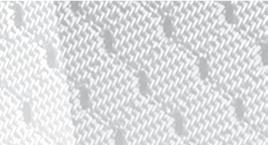













15 OF SPORTS OFFICIALS
20% OFF TRAINING MATERIALS* EXCLUSIVELY FOR NASO MEMBERS
* NASO discounts DO NOT apply to NFHS, CCA and IAABO products.
There is no caution unless this is persistent and a clear attempt to delay the match (NFHS 13-3-1; NCAA 13.2.3; IFAB 13.2).
VOLLEYBALL
Correcting Server
Play: After the first referee has authorized service, A1, who is in the service area with the ball, recognizes A2 should be the correct server. A1 tosses the ball to the correct server, A2, who enters the service zone and serves the ball; this action all occurs within the time allowed for service (five/eight seconds). The served ball lands on team B’s court. Ruling: Legal in all codes and team A wins the point, provided A1 is in proper alignment prior to A2 contacting the serve. The action which resulted in the correct player
serving occurred within the allowed time, and no other fault occurred (NFHS 8-1-1; NCAA 13.1.3.3; USAV 12.4.4).
Horn Sounds During Play
Play: A timeout ends early, and both teams return to the court, ready to play. The ball is served, and team A’s errant pass sends the ball toward team A’s bench. As the ball is over team A’s bench and clearly headed out of bounds, the timer’s horn sounds, because the clock operator failed to turn it off when the timeout ended early. Ruling: The ball is ruled out of bounds, and team B wins the rally. Although the ball was still in the air when the horn sounded, it was clearly not reachable, so the horn did not interfere with team A’s opportunity to play the ball. If the horn had interfered with
team A’s ability to play the ball in the opinion of the referees, then a replay would be issued (NFHS 9-8-1a; NCAA 16.1.2; USAV 8.2).
Simultaneous Contact
Play: A1, a front-row player, and B2, also a front-row player, legally and simultaneously contact a ball above the top of the net. The ball then lands out of bounds on team A’s side of the net. The first referee rules a replay. Ruling: Incorrect procedure in all codes. The first referee should blow the whistle and award the point and the serve to team A. By rule, when opposing players simultaneously contact the ball and the ball goes out of bounds, the player on the opposite side of the net from which the ball falls is considered the player to have touched the ball last (NFHS 9-4-6d; NCAA 14.3.2.2; USAV 9.1.2.2).
The National Association of Sports Officials (NASO) is a nonprofit, educational association providing services and benefits for sports officials. It is run by officials, for officials. If you know a good candidate for membership, please send us his or her name and address. We will forward an invitation to join. For more information contact 262-632-5448 or www.naso.org/membership
Your Company Can Help Improve the Quality of Officiating Become an NASO Education Partner Today!
NASO EDUCATION PARTNER PROGRAM MEMBERS:









Alabama High School Athletic Association
American Specialty Insurance & Risk Services Inc.
ArbiterSports

Arizona Interscholastic Association
Atlantic Coast Conference
Big 12 Conference
Big East Conference
Big Sky Conference
Big Ten Conference
Big West Conference
California Basketball Officials Association
California Interscholastic Federation
CIF-Southern Section
Canadian Football League
Capelli Sport
Chief Zebra Enterprises
Cliff Keen Athletic College Football Officiating LLC
Collegiate Officiating Consortium
Colorado High School Activities Association
Court Club Elite
D-II - Collegiate Commissioners Association
DVSport Software Inc.





Eagle Tax Res
Fox 40 International
Fox40Shop.com
Gamekeepers
Georgia Athletic Officials Association
Georgia High School Association
Gulf Coast Conference
Honig’s
IAABO Inc.
Illinois High School Association
Indiana High School Athletic Association
Iowa High School Athletic Association
Kansas State High School Activities Association
Kentucky High School Athletic Association
Louisiana High School Athletic Association
Louisiana High School Officials Association
Major League Baseball
MIBT Media
Michigan High School Athletic Association
Mid-American Conference
Minnesota State High School League
Missouri State High School Activities Association
Missouri Valley Football Conference
National Association of Intercollegiate Athletics
NBA
NCAA Nevada Interscholastic Activities Association

New Mexico Officials Association
N.Y. State Public High School Athletic Association
NFHS
NFL Foundation
NFL Officiating Department
NFL Referees Association
NHL NHL Officials Association
Officiating Collective
Ohio High School Athletic Association
Oklahoma Secondary School Activities Association
Oregon Athletic Officials Association
Oregon School Activities Association
Pac-12 Conference
Pac 12 Football Officials Association
Professional Association of Volleyball Officials
Professional Referee Organization
Purchase Officials Supplies
QwikRef Inc.
Referee Enterprises Inc.
RefReps
Reveal Media
South Dakota High School Activities Association
Southern California Intercollegiate Athletic
Conference
Southeastern Conference
Sports Officials Care
Sun Belt Conference
Texas Association of Sports Officials
Texas High School Basketball Officials Association
U.S. Center for Safe Sport
Ultimate Fighting Championship
Ump-attire.com
UMPS CARE Charities
United States Polo Association
United States Tennis Association

University Interscholastic League - Texas
USA Cheer/STUNT the Sport
USA Hockey
USA Softball
USA Volleyball
US Youth Soccer
Vokkero by Adeunis
Washington Interscholastic Activities Association
Washington Officials Association
West Coast Conference
W.Va. Secondary Schools Activities Commission
Wisconsin Interscholastic Athletic Association
16 IT’S OFFICIAL - august 2023

























































 By George Demetriou
By George Demetriou






















































































































 BRIAN SPURLOCK (VIOLET PALMER AND MICHAEL JORDAN); CHRIS HUMPHREYS-USA TODAY SPORTS
BRIAN SPURLOCK (VIOLET PALMER AND MICHAEL JORDAN); CHRIS HUMPHREYS-USA TODAY SPORTS













































































































































 BY DR. MAGGIE TIEMAN
BY DR. MAGGIE TIEMAN


 KEITH JOHNSTON (MATT PRUITT, GRAHAM, TEXAS; AMBER MILLER, ARLINGTON, TEXAS)
KEITH JOHNSTON (MATT PRUITT, GRAHAM, TEXAS; AMBER MILLER, ARLINGTON, TEXAS)










 United States Youth Soccer Association Senior Manager of Referees discusses recruiting and retention.
United States Youth Soccer Association Senior Manager of Referees discusses recruiting and retention.











































































































 Adapted from “5 Stages of Officiating” by George Hammond published in the
For most officials, work in officiating involves moving through five stages. At left, Parker Anderson, San Diego; Crystal Sobers of Trinidad and Tobago.
Adapted from “5 Stages of Officiating” by George Hammond published in the
For most officials, work in officiating involves moving through five stages. At left, Parker Anderson, San Diego; Crystal Sobers of Trinidad and Tobago.



























































































































